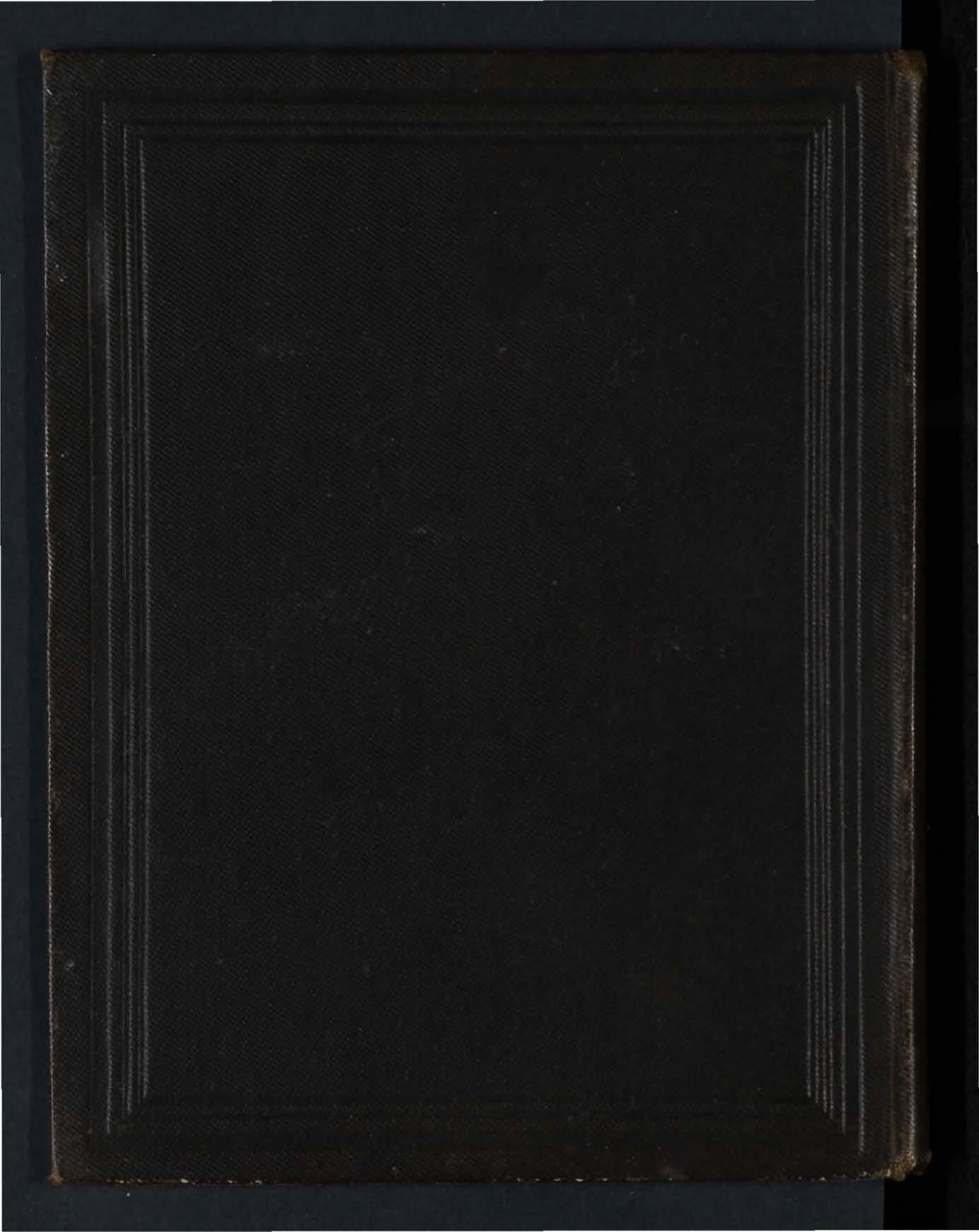




ARRANGED ACOORDING TO THE REVISED SYLLABUS OF THE FIRST AID COURSE OF THE
JOHN AMBULANCE
BY JA"ME CANTLIE, l\I.A., l.I.B., F.R.C.S.,
IIonol'ary Associate of the O,'d,B,' of t. John. HOltOfal'y ::IIembel' OJ; Clnd Lectlo'el' and E.caminer to, the Associalion.
With a GHAPTER. on " Stretcher Transport," revised from that originally written by Sir JORN FURLEY, Knight of J1Lstice of the Orde,' of St. John, in accordance with the Army Stretcher Exercises. Also a GRAPTJ", (being the Fifth Lecture, [or Females only), by E. COSGRAVE, M.D., F.R.C.P.I., Kniyht 0./ Grace of the Urder of st. John, Honorary Life Melll,ter of, and L ecturer and Eraminer to, the Association. EIGHTH EDITION, 290,000 to 330,000. THIS EDITION IS THE AilIE AS THE UTH . Price Is. net; by post, Is. 2d. TO BE OBTAINED AT ST. JOHN'" GATE, CLERKE "WELL, LONDON, E.C. w. H. & L. C. 50 ,000-12/05.
Wbe
' {ijranb Wrioi!! of tbe ®rber of tbe
of cSt. Jobn of Jerusalem in J C tt .b' an.b' :ma:tw.tt .O'f ®rhr.
His Most Gracious :-3ty King Edward VII . ®nm.b'
His Royal Highness the Prince of Wales, K.G. VACANT. .O'f
His Royal Highness the Duke of Connaught , K.G. @ffiUr ll .
Prelate-His Grace the Archbishop of YORK.
C/tancellor-The Right Hon. Earl EGERTO:-1 OF TATTON.
Secretary -General-Colonel Sir HERBERT JEKYLL, K.C .M.G . , R.E . Rcceiver-Ge1zeral-EDWIN FRESHFIELD, Esq., LL.D.
Almoner-The Rev . Canon DUCKWORTH, C.Y.O., D . D.
Reglstrar - M ajor -General The Right Hon. Lord CHEYLESMORE. Gmealo{{ist-Sir ALFRED SCOTT SCOTT-GATTY (Garler)
Director of tlte Ambulance Dcpa?-tment- The Most Hon. the :\Iarquess of K.G.
Libra rian-Lieut .- Colonel RICHARD HOLBECHE.
Secretary-Colonel Sir HERBERT C. PERROTT, Bart., C.B.
Chainnan of the B ritish Op/ztlzalmic Hospital , Jerusalem-The Right Hon . Earl EGERTON OF TATTON .
Cllie/ Secreta ry of the A mbulance Department-Colonel Sir HERBERT C. PERROTT, Bart., C.B.
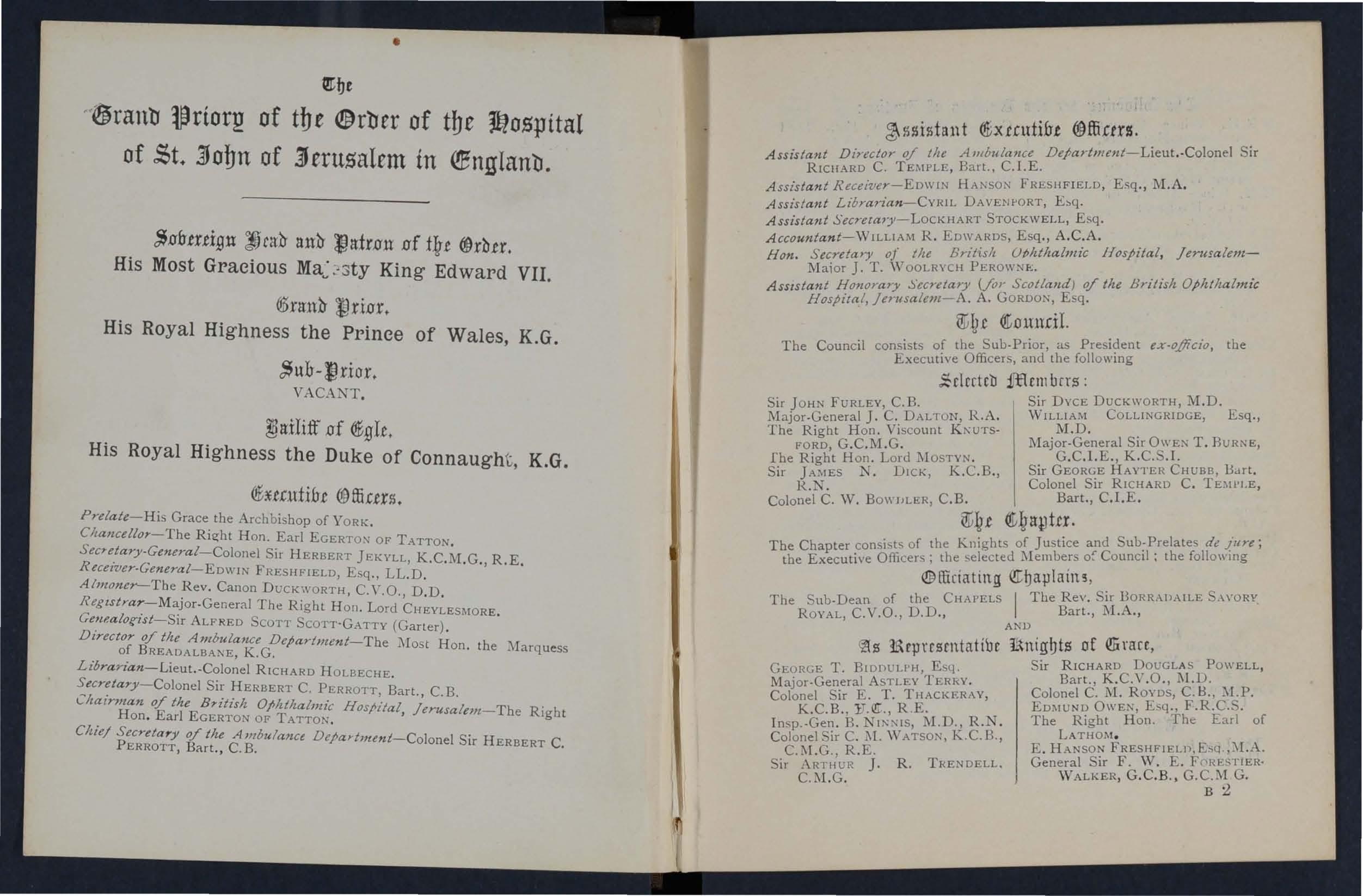
(ft,Xt.Cuti£rt ®ffi.ctrss.
Assistant DZ"ector of tlze .rllllbula1lce Departlllent-Lieut. -C oionel Sir RICHARD C. TEMPLE, Bart., C.LE.
Assistant Receiver-EDwIN HANSON FRESH FIELD, Esq., M.A.
Assistant Libra?-ian -CYRIL DAVENPORT,
Assistant Secrela?J'-LoCKHART STOCKWELL, Esq.
Accountan t-WILLIAM R. EDWARDS, Esq . , A .C.A .
Hon. Secretary of tlte Brit-isll UNttlzalmic Hospital , JentralemMaior J. T. \ VOOLRYCH PEROWNJ;;.
AsS/statzt Honora?,,)! Sec? -etary (fo,: Scotland) of tlte Britislt O/>Ittltalml c Hos/>ital, Jerusalem-A. A. GORDON, Esq.
t!V Q t
The Council consists of the Sub-Prior, as Presi?ent ex-officio, the Executive Officers, and the followmg .%dcrt c'JJ j'£lcmbrrs :
Sir JOHN FURLEY, C.B. Sir DYCE DUCKWORTH, M.D.
Major-General J C,. DALTON, R A WILLIAM COLLINGRIDGE, Esq.,
The Right Hon. Viscount KI\UTS- M.D FORD, G.C . M.G. Major-General Sir OWEN T. BURNE,
fhe Right Hon. Lord MOSTYN . S ir Bart.
Sir J N. DICK, K C B , Colonel Sir RICHARD C TEMPLE, R.N. B CIE
Colonel C. \ Y. Bo\\ IlLER, C.B . art., . . .
Th Ch ter consists of the Knights of Justice and Sub:Prelates de Jure; the Officers; the ;\Iembers 0: Councd : the following @fficia ting ([ba pl ailB ,
The Sub-Dean of the CHAPELS I The Rev. Sir llORRAIlAILE S ,\\'ORl'. ROYAL C. V.O., D.D., Bart., 1\l. A . , , AND
larprcsmtn tine iit ltigbts of Qli nm ,
GEORGE T. BIDDULI' H, Esq.
Major-General ASTLEY TERRY.
Colonel Sir E. T. THACKERAY, K.C.B , R.E.
I nsp.-Gen B. II\NIS, M.D., R.N.
Colonel Sir C . i\l. W ATSON, !Z.C.B., c.:-' l. G., R.E.
Sir ARTHUR J . R . Tf<ENDELL . C.M .G .
Sir RI CHARD DOUGLAS POWELL , Bart., K . C.Y .O., 11.D.
Colonel C. 1\1. Roy OS, C.H., :\I.P.
EmlUND OWEN, Esq., F .R.C.S.
The Right Hon The Earl of LATHOM . E. HANSON FRESHFIEL}), ESQ ,:\I.A.
General Sir F. W . E . F ORESTIER· W ALKER , G .C.B , G.C.M G. B ;2
folloming are tl)e 1ltnignts of ]usticc:
H . R .H. Prince CHRISTIAN OF K .G., G.C .B.
H .R .H. Prince CHARLES OF DENMARK. G.C.B., G.C.V.O.
H.H. Prince ALBERT OF :-CHLESWIG-HOLSTEIN, G.C B., G .C'.V.O.
H.S.H. TheDlIkeofTEcK,G.C.V.O.
H. S .H. Prince FRANCIS OF TECK, K.C.V.O. , D.S.O.
C apta in H.S.H. Prince LOUIS OF BATTENBERG,G.C.B.,G.C. V.O., R.N.
H.S.H. Prince ALEXANDER OF TECK, K.C.V.O., D.S.O.
Lieut.-Col. TREVENEN JAMES HOI.LAND, C.B
Sir J. FURLEV, C.B. (Holt Bailiff)
The Right Hon. Lord G.C.M.G.
FRANCIS ROBERT DAVIES, Esq.
Sir BROOK KAY, Bart.
Sir T. NORTH DICK·LAUDER, Barl.
Major Sir ARCI!1BALD LAMB, Bart.
Col. Sir HERBERT C. PElmoTT, Bart., C.B.
The Right HOIl. Earl FERRERS.
Colonel Sir JAS. GILDEA, C.V.O., c.B.
HE!'IRV JOHN LOFTUS, Esq.
Colonel BETHEL £.IARTI!'I DAWES.
The Right Hon. Lord AillHERST 0F HACKNEY.
Gen. Sir CHARLES \VARREN, G.C.£' LG. , K C.B., R.E.
Major General JAMES CECIL DALTON, R.A.
Lieut.-Colonel AVUIER GOUI D HUNTER - \VESTON, D S O , R.E.
The Right Hon. Earl EGERTON OF TATTO'l .
,-olone! The Right Hon. Lord CECIL, M.V.O.
EDWIN FRESIIFIELD, Esq .• LL.D (Hollol"ary COllmlaJldt:r.)
His Grace the Duke of K.T., G.C.V.O.
The Right Hon. Lortl IlRAS5Ev, K.C.B.
The Right Hon. Viscount TE'IPLETO\\·;';.
The Right Hon. Earl AtoIHERSr.
The Hon. Vi,colmt K :-;UTSFORD, G.c.£. I. G. (HOJl·,JJ"M·Y Baili,ff).
R. i\T AcLEAN, Esq.
ARTIIUR FRA;';CIS LEVE· sO:-.:·GowER, ESf].
Colonel F . A. HEV(;\TE LAMBEln.
Col. CIL'\RLES \V VNDHAM
c.n., 1\ [ P.
The Rieht Hon. the Earl of RAN· FLdlLV, G.C .J\l. G.
The 1{lght Hon. Lord SANDHURST.
C.C.S.I., G.C.I. E.
Sir HE:-;RV 1\. BLAKE, r. .C.J\LG .
Caotain NATHANIEl. (;1£0 PHILIPS.
Th'e Right H on. the Earl ofJ\IEATH.
A. ED'ltJ.'1D FRASER, I!;sq.
The Right H on Lortl :\IOSTVN.
Colonel CHARLES H UGHES·HuNTER.
The i\Iost Hon. the J\Iarquess of BREADALBANE, K.G.
His Grace the Duke of PORTLAND, K.G., G.C. V.O.
Field-J\[ar<;hal the Right Hon. Earl ROrlERTS, K.G., K. P., ROBERT BllUDENEI.L C AlnER , Esq., F.R .C .S. HAY FORIIES, 1-<'f·j., F .R.C. S. (Edill.)
Colonel JOHN i\IAN STUART, C.B . , C.M.G.
I Co!onel C. \\' BO\\,DI.ER, C .l)'
QIbe folIoming Rte tbe
The Lord Bishop of ELY . I The Bishop in Tbe Lord Bisbop "f SALISBURV. The Bishop of GIBRALTAR . The Bishop of BRITISH HO:-<DURAS.
BEING THE AlIlllULA:-.CE DEPARTMENT 01"
QJirnna .@tiory: (If 1be ®rl:ler at tbe Jl;lof5pltal of .st. ]Dbn (If ]eruf;Sal£m ill QCnglani.r.
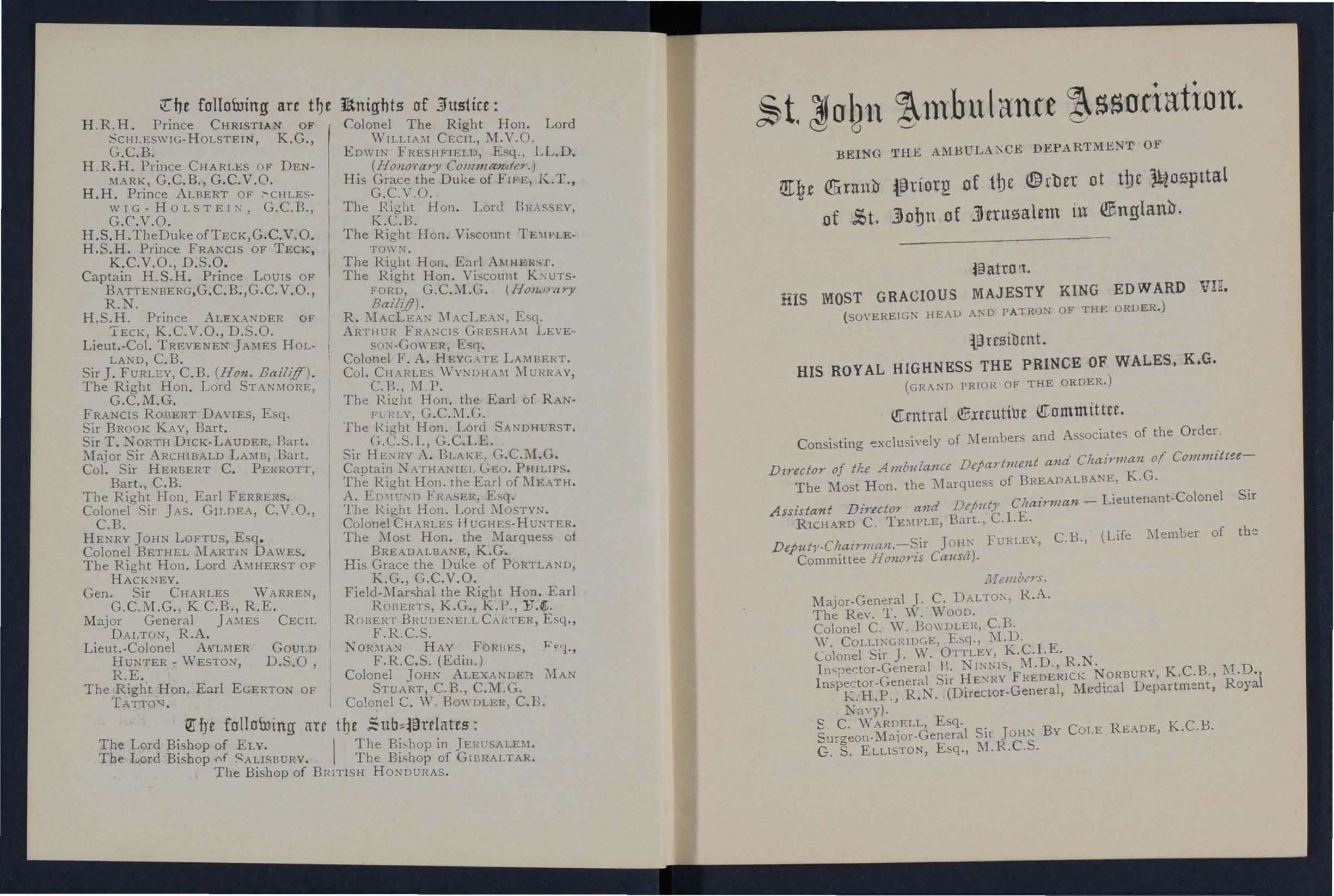
HIS MOST GRACIOUS MAJESTY KING ED WARD VIH. (SOVEREIG:-': HEAD AND PATRON OF THI': ORUER.)
HIS ROYAL HIGHNESS THE PRINCE OF WALES, K.G. (GRAND PRIOR OF THE ORDER.)
\[rntral QCrrcutiue Q1ommittce.
Consisting of l\ I elllbers and of the Order .
D1rector of the A 1Il1mlaJlce DLjal·tlllcld a1Ld Chairman of COllllILitt!e-
The Most Hon. the l\larqlless of BREADALBANE, K.G. . Assistant Di1'l'ci01 and Dl!j!1lty CJ!ail'nzalJ - Lieutenant.Colonel Sir RICHARD C. TEMPLE, Bart., C.l.E.
1:' C 13 (Life .1Ilember of the J OB:' r URI.EY, .. , Committee /1olLons Causa).
1IIemb.,·s.
Major-General J. C. DALTO:-':, lZ.A.
The Rev. T. \\' \Voou.
Colonel C. \\'. BO\\'DLEI{, C.B.
\V. COLLI:-':vRIDGF;, Esq., 11.l?
Colonel Sir J. W. OTTLEY, K.C.I.E. T
I Il,ne<:tor·Gencral I I. ' K C B l\T.D I ns I ector-General Sir HE:-':HV F HE DERICk .ORBUR\, . . . , R ai PK. H.P . , R .N. (Director-General, MedIcal Department, oy Navy).
S C. \V ARDELL, Esq. . - I' C 13
Sur<Teon.Major-Gen eral Sir J OB:-: By C OLE READE, "...
G. S. ELLISTON, Esq., IIl.H.C .S.
<!ten traI Il1!rtcutibe Q[ ommi ttee -conti11Ztcd.
C HRISTOPHER CHILDS, Esq., M.D.
Surgeon. General Sir JOSEPH FAYRER, Bart., K.C.S.I., M.D.
CHARLES J. Esq., C.M.G., L.R.C.P.
Surgeon-General Sir \VI LLIAM R . HOOPER, K.C.S.I.
Colonel CLEMENT MOLYNEUX Roy os, C.B , l\I.P.
Captain J. W. NOTT BOWER.
Surgeol}-General Sir WILLIAM TAYLOR, K.C.B., MD ., K.H.P. (Director-General Army Medical Service).
EDMUND OWEN, Esq_, F .R.C.S.
The Right Hon. Lord CLAUD l\lost Hon. the Marquess of NORTHAl\(PTON.
Lieut.-Colonel A. C. Y_HE.
Sir WILLIAM BENNETT, K.C.V.O., F.RC.S.
REGINALD HARRISON, Esq., F.R.C.S.
Lieut.-Colonel E. l\I. WILSON, C.B., C.M.G., D.S.O , R.A :\I.C
Surgeon-General A. KEOGH, C B., M.D.
L.ieut.-Colonel W. BABTIE, C M G., lJ.Qi;., R.A.M.C.
Sir EDWARD L. O'MALLEY.
Colonel GEORGE H. O':'IIALLEY, RA.
Surgeon-Major G. A . HUTTON.
Deputy- I nspector-General M. COATES, M.D., R.N.
JOHN ASTLEY BLOXAM, Esq., F.R.C.S.
Ex-Officio lI-Tembers oj' Committee.
Colonel Sir HERBERT JEKYLL, K.C.:'II.G., RE. (SecretarY-General of the Order).
.FRESHF'IE1.D, Esq., LL.D. (Receiver-General of the Order).
1 he Right !Ion EGERTON OF' T ATTON (Chairman British OphthalmiC Hospital). '
QI;hirf :: ccretar,!!
Colonel Sir HERBERT C. PERROTT, Bart., C.B. (Se-:retary of the Order).
anlJ
WILLIAM R. EDWARDS, Esq ., A . C.A. (Acc07mta1It 0./ tILe OrderJ.
®fficrs.
ST. JOHN'S GATE, CLERKENWELL, LO:-JDON E.C.
Tc/cgrnjJllic Address-I( Firstaid, London." Tele;5itolle -Holborn, 861.
LONDON AND WESTMINSTER BANK, LIMITED, (LotJ.bury, E.C.)
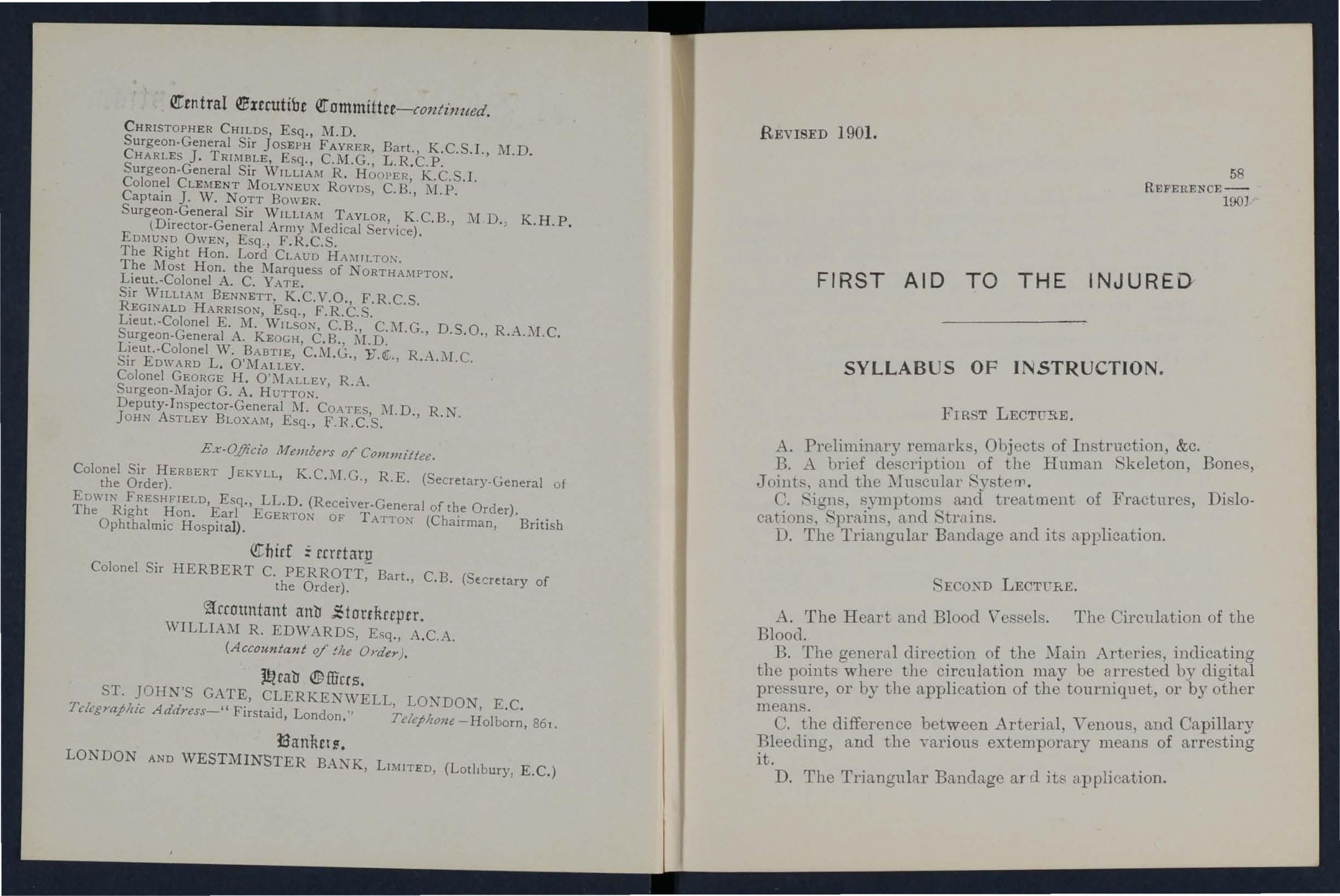
REVISED 1901. 58 REFERENCE1901
.
FI RST LECTU:g,E.
A. Preliminary remarks, Objects of Instruction, &c.
B. A brief de criptioll of the H uman Bones, Joints, and the :Jlusculal' Rystefl1.
C. :-lign , symptoms treatment of Fractures, Dislocations, .,'pr11.ins, and Rtrilllls. . ..
D. The Triangular Bandage and ItS applIcatIOn.
LECTt'"RE.
A. The Heart and Blood Vessels. The Circulation of the Blood. . . l' t'
B. The general direction of the ArterIes, me .mg the points where the may be by chgltal pressure, or by the applIcatIOn of the toUrl1lqllet, or by other means.
C .
C. the difference between Arterial, Venous, and Bleeding, and the yarions extemporary means of arrestmg U. .
D. The Triangular Bandage aT d its appjicatlOn.
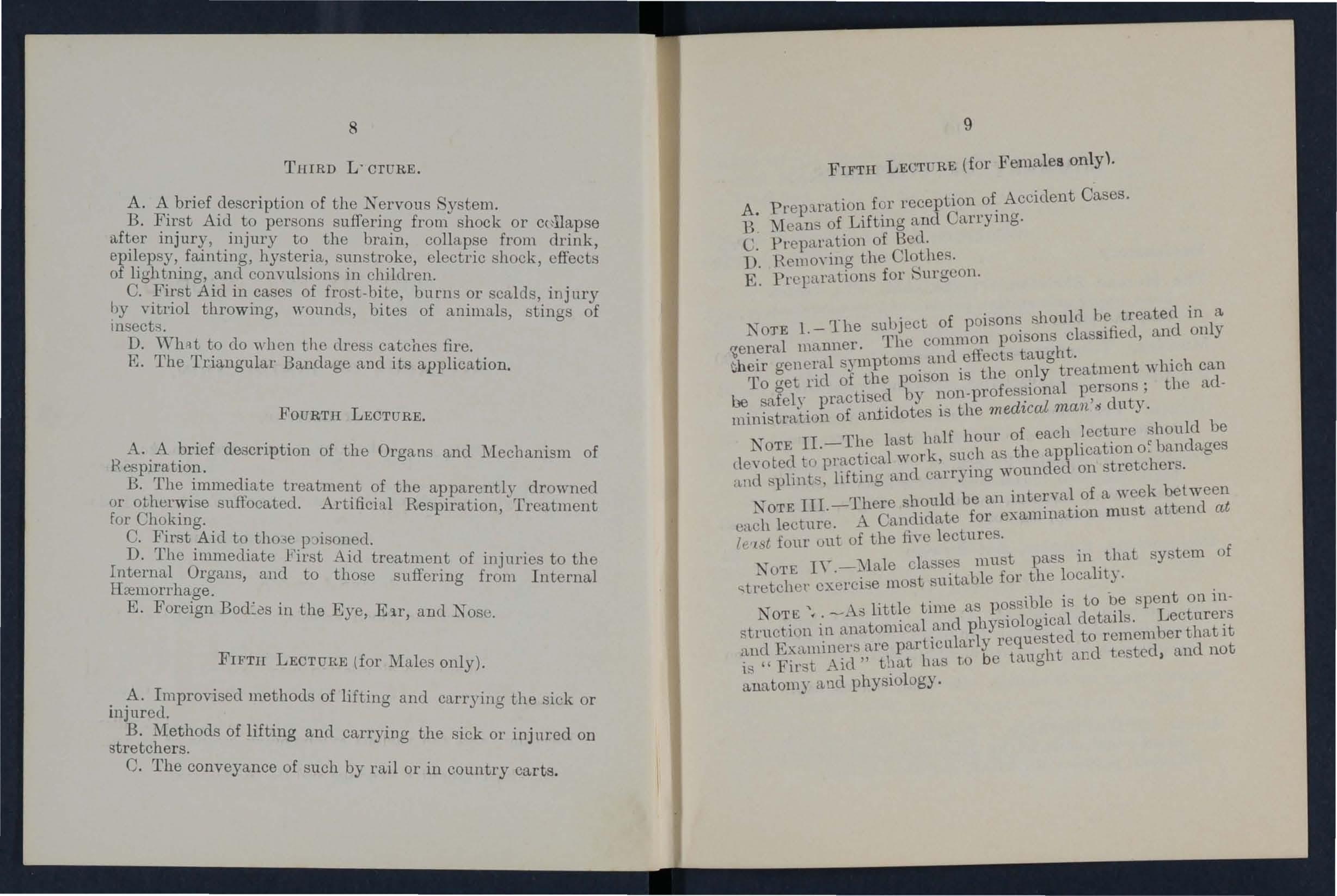
8
THIRD L' CTURE.
:. of the Nervous System.
. IC to persons sufferin a f' 1 mJ ary, injury to the b .0 10m s lOck or ct1ilapse epIlepsy, faintin h rster' ram, from drink, of lightning, electl'lc shock, effects
C F' t A'd ' In c 11 (ren , ,1:S 1 m cases of frost-b't b' , by vItrIol throwin a wounds b\e, scalds, mjury Insects. 0' , 1 es 0 ammals, stings of
do when the dress catches fire. uangular Bandage and its application.
FOURTII LECTURE.
A .. A ?rief description of th 0 ResplratlOn. e rgans and Mechanism of
B. The immediate treatment of 1 or otherwise suffocated At' fi ' 1t Ie apparentl v drowned for Choking. . r 1 Cia Respiration, "Treatment
C. F,irst ,Aid to, tho,e p Jisoned.
D. The llmnedlate First Aid Internal Organs, and to th of injuries to the Hremorrhage. ose suffellng from Internal
E. Foreign in the Eye, Eu, and Jose.
FIFTH LECTUI-tE (for Males only).
. Improvised methods of liftina a 1 111Jured. 0 nc carrying the sick or
B. Methods of lifting a 1 . stretchers. ll( carrylDg the sick or injured on
C. The conveyance of such by ra'l . 1 or III country carts. 9
FIFTH LECT URE (for Females only).
A. 'Prep :.tration for reception of Accident Cases.
13 Means of Lifting and Carrying,
C. }>repara.tion of Bed.
D, Remoying the ClotheR. E. Prerarations for Surgeon.
N'OTE 1.- The sahject of poisons should he treated in a f{eneral manner . The com111on poisons classified, and only their general symptoms and effects taught.
To get rid of the poison is the only treatment which can be safely practised by non-professional persons; the administration of antidotes is the medical man' duty.
TOTE n.-The last hn.lf hour of each lecture should be (levoted to practical work, such as the application 0: handages Rplints, lifting auel carrying wounded on stretchers.
NOTE IlL-There should be an interval of a ,yeek between each lecture. A Candi.date for exmnination mnst attend at hlSl four I)ut of the five lectures.
NOTE IY,-},lale classes must pass in that system of c.tretcher exercise most suitable for the locality,
NOTE'. . -As little time as possi.ble is to be spent on i.nstruction in anatomical and physiological details. Lecturers il.nd EX(1.minel's are parti.cularly requested to rcmcmberthatit is "Fi.rst Aid" that Ims to be taught ar,d tested, and not ann.tomy and physiology.
SUMMARY OF C HAPTER 1.
Explanatory
The Human Skeleton .. .' ... b . . . pme, sku ll , nLs, lJreast etxtremltJes, pelvis and lower extren;i<.nr JOIn s ...
Muscles. Voluntary and involun tary
Fractures. Causes, varieties, signs and symptoms
Gener<l:l Treatment of Frac t ures A . . splmts and bandages. General for
Treatment of Special Fractu . S . . lower j aw, ribs, breast-b Les i1 , bP111e , cra.llIUl11 , blade arm f one, co ar- one, shoulclcl'thigl' k ' orearm , metacarpus, fincfer pelds 1, nee-cap, leg, foot "'"
Dislocations, Sprains, and Strains ... CHAPTER II.
Circulation of the Blood 0' anclliver circu l a.tiol1' .. th lranS ; goneyal, lung, capilla,ries blood cour'so fe veins, , , 0 Clrcu atlOn
H:emorrhage or Bleeding ... . .. lary , Arterial, venous. ca.pil-
Arrest of H h .......... .. r . remarr age. Pressure r . ( lrect; lllstrumental (b t ,. ,C lrect a.n(l 111flexion, position of c p tOUIll1lqU?t), and digita.l ; a len , e evatIOn of limb
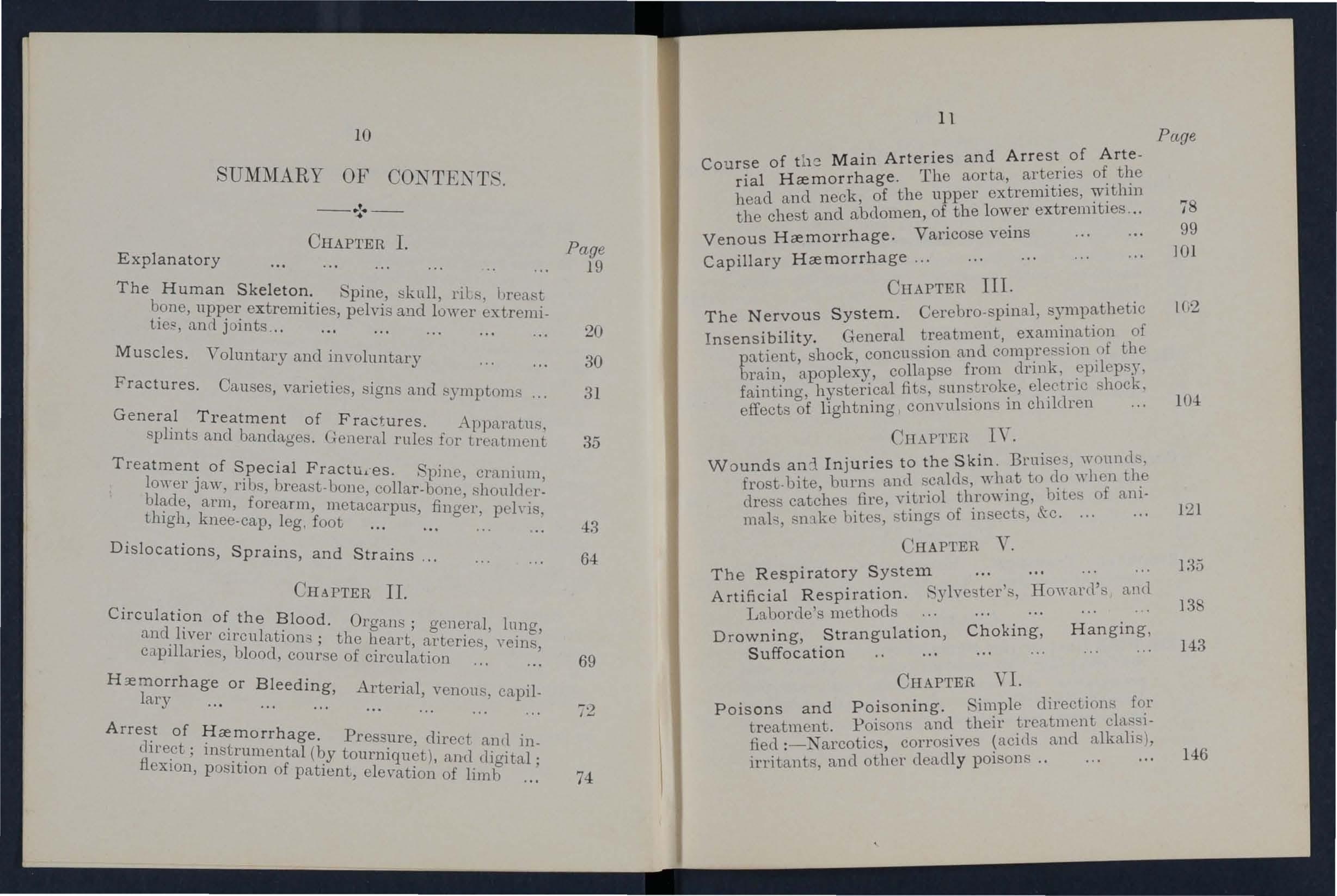
Course of the Main Arteries and Arrest of Arterial Hremorrhage. The ao rta, arterie:;; of the head and n eck, of the upp er extremities, within the chest and a.bdomen, of the lower extremities ...
VenouS Hremorrhage. Varicose veins
Capillary Hremorrhage ...
CUAPTER III.
The Nervous System. Cerebro-spinal, sympathetic
Insensibility. General treatment, examina.tion of pn.tient, shock, concussion and compression of the brain, apopl exy, collapse from drink, epilepsy, fainting, hysterical fits, sunstroke, electril.! ,' hock, effects of lightning cOllYu l sions in children
W o unds an :l Injuries to the Skin. Bruises, ,youl1l1s, frost-bite, burns and sca.hls, what to do ,,-hen the dress catches fire, vitriol throwing, bites of animals, sn 'tke bites, stings of insects, &c.
CH APTER V.
The Respiratory System
Artificial Respiration. Rylve ter's, Ho,,-arc1'::; , antI Laborde's methods
Drowning, Strangulation, Choking, Suffocation
CUAPTER VI. Hanging ,
Poisons and Poisoning. imple directions for t r eatment . Poisons and their treatment C1<"I$ ified :-Narcotics, corrosives (acills and a.lkalis), irritants, and other deadly poisons.,
12
C HAP TER VII .
In j uries of Special Or g ans. Foreign bodies in the eye, ear-passage and nose. Tbe chest (thon.x) and organs c()ntained in it (hc1rt and lungs), wounds of the lungs. '1'he abdo m en and the organs contained in it (liver, spleen, intestines kidneys, bladder), with treatment of injury to them. Rupture ...
CHAPTER VIII.
Bandaging . Application of the triangular bandage to the scalp, forehead, &c., shoulder, hip, band, foot, chest, back, knee, elbow
CHAPTER IX.
Carrying Patients . Four, two, and three-handed seats, fireman ' s lift, temporary stretchers, to cross a ditch or wall, to load and unload a wagon
CHAPT ER X .
Stretcher T ra nsport . stretcher exercises. Introductory . b'etchers, The Ashford litter
CHAPTER XI.
The Fifth L e cture ( for Females onl y) . Preparation for reception of accident cases. Choice and preparation of a room . Lifting and carrying. Preparation of bed. Removing the clothes. Preparation for surgeon

showing po
The hip joint ...
b"
Diagram showing rectus muscle of tlllg " vein and nerve ._. ... . .. ...
Bimple fracture of leg .-.
Compound fracture of leg ...
Triangular bandage, spread out ...
Triangula,r banclao-e, once fo lded. . . ..,
Tri'lngular bandage, folde(l a,s broad bandage ... bandage, folded as narrow bandage
Reef knot. ..
Another method of securing splmt. ... ....
Third method of securing splint, wlth knot ll1comp
The same, with knot completed ... .... ..
Large arm-sling arm-sling
Co<"\,t tail turned up to form. slmg
Nling formed from sl eeyo sb l u,P .:.
Ba,ll(l H!O for fracture of lowor Jet'"
B-1nd'l CYo for fracture of ribs .,. .... b-' 1 c; .. of fracture of collar-bone, wlth two am al::)0s
Alternative method of Jitto ... . :..
rrreatment of fracture of collar-bono WIth 0 , g
Treatment of fracture of a.nn
Treatment of fracture of metarcarpus
Treatment of fracture of thigh (man)
Treatment of fracture of thigh (woman)
Fracture of knee-cap
Treatment of fracture of knee-cap
Treatment of fracture of leg
Ditto , single handed ... . ..
One form of dislocated shoulder ...
Principal blood vcssels and organs of respiration
Diagram of circulation of the blood '" ...
Field tourniquet
I 'crew tourniquet ... ... ...
Digital compression of carotid artery
Arrest of hcemorrhage from temporal artery
Arrest of hcemorrhage from forehead
Arrest of hcemorrhage from palmar arches ...
Digital compression of radial and ulnar arteries
Flexion of elbow
Digital compression of brachial artery from below
The same from auove
Compression of axillary artery ...
Digital compression of subclavian artery
Flexion of knee-joint
Digital pressure on femoral artery
Application of tourniquet to femoral artery
Brain and spinal cord, and nerves proceeding from it ...
The lungs and bronchial tubes
Artificial respiration: inspiratiol1
Artificial respiration: expiration
The organs of the chest and abdomen
Bandage for head ...
Banrlage for shoulder
Bandage for hip
Bandage for hand
Bandage for foot

Bandage for chest (front)
Bandage for chest (back)
Bandage for knee
Four-handed seat
Two-handed seat .,. ... . ..
Alternati ve grip seat
Another alternatIve gnp fOl same
Three-handed seat ..: ...
Fireman's lift
Fireman'" lift (lowenng).. ... . ..
Seat impl"Ovised with P?les and coat .. ,
Stretcher improYi'ecl poles and coats
Stretcher improYised WIth poles and sack
FurIey orc1in'lTY tretcher (cIosell) ...
Flll'Iey telescopic-handled (oP1n ) 1
Stretcher exercise No. I., preparmg to oal
Ditto placing on stretcher .. ,
Ditto: placing on slretcher
Di tto cel.rrying stretcher ". ": "i 1 exercise No. II., preparIng to oac ".
Ditto , on
Stretcher .... ,0. ':' fic, t <:> ition ", ", exen.:lse !'\o. n., IS pos ",
Secoml position ". ",
Ashford Ii tter
Bed rest, three forms
AT the request of the Central Executive Committee, I have "Titten this manual as the official handbook of the St. John Ambulance Association.
The strides made in the teaching of "First Aid," and the requirements of the St. John Ambulance Brigade, have necessitated an enlargement of previous works on the subject published by the Association.
I have endeavoured to include only a.' much anatomical and physiological detail as is absolutely necessary to enable students to grasp intelligently the prim il?les of treatment.
The greater part of the directions for the application of the triangular bandage and for lifting an(l earrying patients, is adapted almost verbatim from the \Yor II of the late Surgeon-:JIajor Shepherd, as re-written hy Dr. Robert Bruce.
I wish to express my thanks to Colonel C. Bowdler, Drs. J. Brown, C. Childs, M. Coates, \V. Collingridge, J. R. Crease, G. H. Darwin, and H. A. Latimer, who hc:l.Ye, as a sub-committee of the Association, assisted me in my work.
June, 1901.
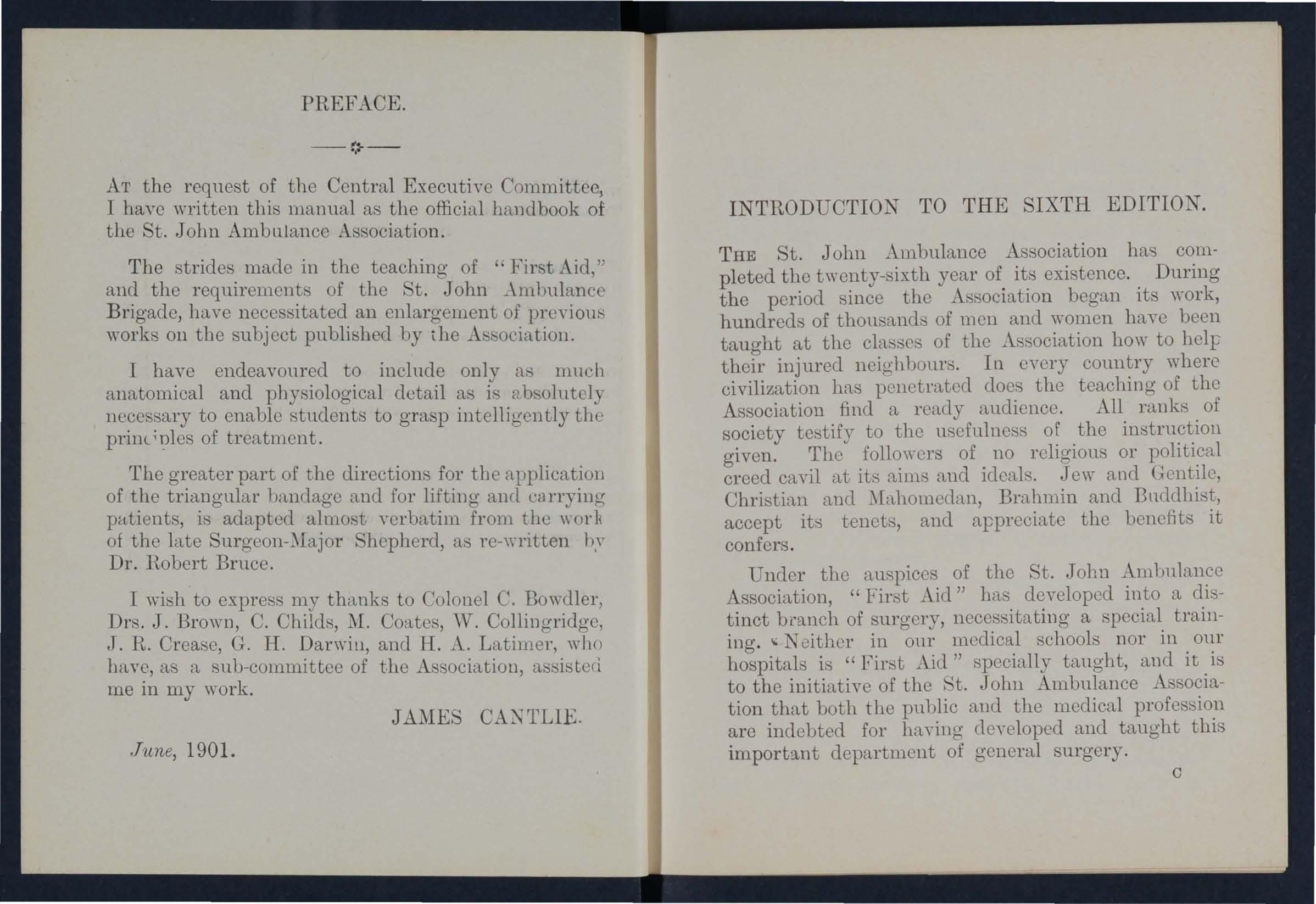
THE St. John Ambulance Association has completed the twenty-sixth year of it::> existence. During the period since the Association began its work, hundreds of thou::>ands of men and ,\'Omen have been taught at the cla,sses of the Association how to helF their injured neighbours. In every country where civilization has pcnetl'H,ted docs the teaching of the Association find a roady audience. All ranks of society testify to the usefulness of the instruction given. The followers of no religious 01' political creed cayil at its aims and ideals. Jew and Gentile, Christi::m alld Mahollleda,n, Brahmin and Bl1ddhist, accept its tenets, and appreciate the benefits it confers.
Under the auspices of the St. John Ambnlance Association, "Fir::>t Aid" h<1,s developed into a distinct branch of surgery, necessitating a special training ... N in our medical schools nor in our hospitals is "First .lUd" specially taught, and it is to the initiative of the St. John Ambulance A sociation that both the public and the medical profession are indebted for having developed and taught this important department of general surgery.
c
18
The instruction begins and ends with "First Aid" a!1L1 the subject is taught thoroughly and tl \'ely. The duty of the ambulance pupil ends where the a.nd there ought to be no oyel:lappmg 0 1' clashmg of duty or interests. No more lIberal or useful instruction has ever been given to the public, a.nd the work of the St . J oh n Amh:llance AssC)ciation nm8t continue ,yhibt charity rem,UllS to us. and sympathy fOi' suffering humanity endures.

August, 1904.
By "First Aid " is meant tllat form of ati i tance ,rIlich persons bailled in amlmlance work can afford instantaneoul:ily to the sick 01' injured. " First Aid to the Injured 1) i. ' a un-mcll of practical surgery demanding specinl trainil1g [InrI education. The principal aim and ohject of the ,'t. John Ambulance Association is to teat:h in simple language how to help a sick 01' injured person until the services of a doctor obtained . ...:\.. further [lnd important branch of '1.mlmlance ,york is the caniage of 8iuk 01' injured 1 CHons by stretcher, l)y ambulance \\'(1gon, oy rail, 01' l)y improyised means of transport . Before proceeding to give in detail the ,ar' ous steps to be ta.kcn in the eyent of a.cciclent 01' suddcll ilhless it is necessary to know :::'olllething of the structure of th c body (elementary anatomy): [l1lC1 the fUl1<:Lons of some of the mOl'e :mport[lnt organs (1nd systerns (elementary physiology) A short description of nece::; ary anatomical and phy8:010gicnl roints of importance is therefore giyen as the Fcycml ubjects are discussed in detail. It is essential to remember when studying anatomy that the human Lody is
20
to be sta.nding erect, with the palms of the hands directed forwards a.ncl the thumbs outwa,rd :::: , or .from the body. Tho" middle lin e" of the boay IS a Ime drawn vertically from the top of the head to n, point between tho foet . THE ,KELETON.
The body is mouldod upon a. bony frame,York wIuch servos: (1) To givo shape and firmness to the body j (2) to afford attachment to the muscles' and (3) to protect tho more vital organs in the skull' in tho chest, and in the abdomen . '
THE R\.CK SPINE. OR VERTEBRA.L COLUuIN.
Co lumn.-Each segment of \vhlCh the spIlle IS composed is tormed a Vortebra. A (1) of a contral body or illass j (2) of processes, two of which join behind to form a canal for the spinal cord-the Spinal Canal· behind, bony projections-tho spines of the -can be felt beneath tho 1:lkin for tho whole lonoth of the back (Fig . 1). 0
The vertebrro, 33 in .all, are grouped into regions :1. The Neck or Cer vlcal vel' tel ,rre are 7 in number' the first or atlas forms a joint with the base of the skull, at which the nodding movoment of t h e head tak.es place j the second or axis, by the joint between It and the atlas, allows of the side to s ide
21
movements of the head. II. Th e Back or Dorsal vertp.bne, 12 in number, hav e the 12 pairs of ribs atta:.:iled on ei·ther side. III. The Loin 01' L urn bar

SURFACES SUPPORTING HEADS OF RIBS
vortcone, 5 in uumoer, arc the large t of all the vertebrce. IV. The Rump Bone 01' Sacrum con sists of five Yertebrm, united in adults as a solid ma'3S, \vhich with the two haunch bones, forms the pelvis. V. The Tail Bone or Coccyx consists of four vertebrce \vhich a r e joined together to form a single group. The vortebrce in each regloll are known by numbers, counting downwards-1st, 2nd, 3rd, etc .
Between the bodies of the ,ertebrce thiek pieces of gristle or cartilage discs) are intol'poed, which, whilst they bind the bones together, allo,,' of free moyement to the column as a \\'hole, and erye to break the shock of any sudden force applied to
CC>DY of VeR TEBRA EIG.I.spine. The whole length of the spine is together by ligaments reaching from end to end of the column.
THE SKULL.
The bones of the skull are arranged in two group" those of the brain case, or cranium, and those of the face.
The boundaries of the Cranium are the Yarut or dome, the I\.:Llllded portion forming the top of the head j the front or brow j the back of the head, where the greatest extent of brain exists, and where, therefore,
FIG. 2.
SKULL A1"D VERTEBRAL COLUMN,
Showing l(It ?-ibs and portion of breast-bone. The ?'ight 1'ios are 1'emoved,.

the cranium is \\'iLle:st and deepest j the sides or \\'here the openings into the cal' are seen, and to which the em' is attcwhed. The base of the cranium i::; hiddcn from view by the bones of the fn ,r-A and the ycrtelm1.1 column j in it are numerous perforatIons tor the pas "'<ge of the blood YeBscl::; going to and from the brain j through the large::;t opening the brain andpillal cord are continuons.
The bones of the Face, with the exception of the lower jaw, are fil'lllly juinted together, ,'0 that 1ll0ye· lllent between thcm is illlpo ··::;ible.
The cayities of the no::;e and of the eye socket (orbit) are funned lJY the bon('s of the lIlll and face conjointly.
rrhe mouth en "ity is fOl'llled hct\\'een the upper and lo\\'er j,l \\':3, the pn.ln,te ueillg the bony roof of the mouth, \\'hich ::scpamtcs it from the nasal cayity above.
'l'liJ£ nms.
The Ribs cun:sist of t\\'clYe pail'l) of cm'ycd bones extending frolll the ycrtebral (;OlUllill hehind to the front of the body, alld arc known by number::;, 1st, 2nd, 3rd, ete., commencing from aboye. They form joints with the (lor 'al Yertebr::c, and their moyelllent resemble ' that of the handle of c.\, bu(;ket. ThE' ribs are not, ho\\, oyer, bony throughout their entire length. At a ::shurt di ·tance from the breast-bono the bony material emlt5, <1.lld gl'i:::;tle (em'Wage) takes its
place. The upp er seven pairs, named the t1"ue ribs, are attached by their cartilages to the breast-bone; the lower fiye pairs are termed the false ribs, as their cartilages fall short of the middle line. Of the false ribs the 11th and 12th pairs are termed the floating or \"inged ribs, as their ende are free in front. The ribs enclose the chest, and serve to protect the lungs, heart, liYer, stomach, spleen, etc. (see Thorax and Abdomen).
THE BREAST-BONE.
The Breast-bone (sternum) is a dagger-shaped. bone with the point below, just over the pit of the stomach; it supports the inner ends of the collarbones above, and the seven true ribs are connected with it on either side.
THE U PP Ell EXTREMITIES.
The Shoulder bones are the collar-bone (clavicle) and the sholllder-blade (scapula), and they together constitute an imperfect gi.rdle-the shoulder girdle. rrhe Collar-bone can be felt beneath the skin at thE; lower and front part of the neck as a narrow curved rod of bone, about the thickness of a finger. Its inner end rests on the npper part 01 the breastbone; the outer end joins with the should er-blade at the top of the shoulder; at either end a joint exists. The collar-bone is endowed with extra elasticity, owing to its being possessed of a double curve, the
25
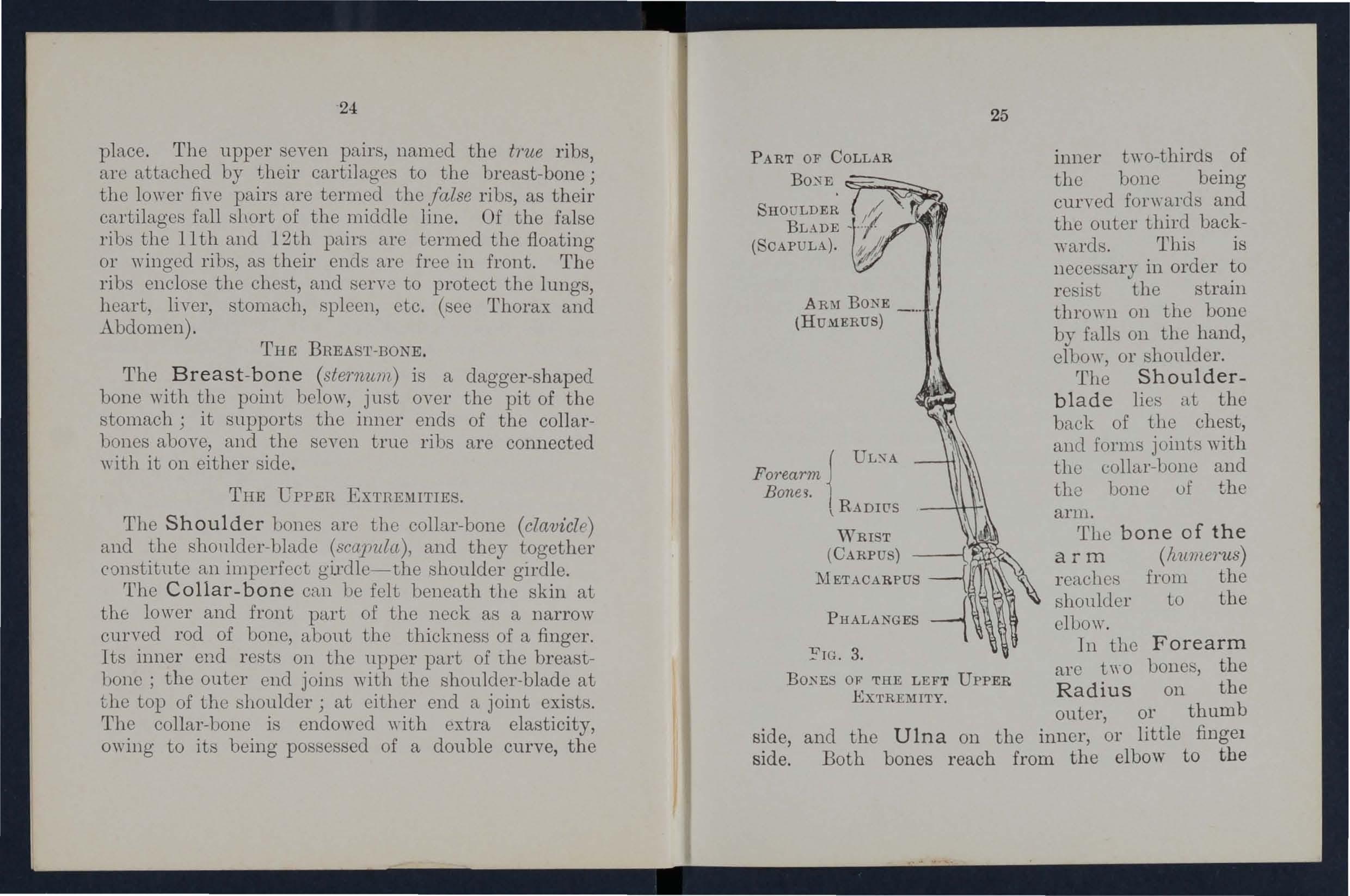
inner two-thirds of the bone being curyed forwards and the outer third back\yards. This is necessary in order to resist the strain thrown on the bone by fall::; on the hand, elbow, or shoulder.
The Shoulderblade lies nt the back of the chest, and forms joints with the collar-bone and the bone uf the ann.
The bone of the 3 r m (hwne7'us) reaches from the shoulder to the elbo\\'.
In the Forearm are t\yO bOlle::;, the Radius on the outer, or thumb side, side. and the Ulna on the inner, or little fingeI Both bones reach from the elbow to the
B01\ES OF TilE LEFT UPPER EXTREMITY.

wrist, and they change their relative position with every turn of the hancl.
'rIle Han d is composed of: (1) the bones of the wrist or ca1pua, eight in numuer, anangrd in two rows of four; (2) the metacu7')JtlS (the fri;1.mework of the palm), presenting five bones, which form the knuck l es and support the bones of the fingers; (3) the phal(tn}e" or finger bones, three in each finger, and two in the thumb.
The Pelvi s.-The large basin-like mass of bone attached to the luwer part of the spine is composed of three bones, tho two haunch bones and the sacrum (or rump bone). '1'11e hauneh bones meet (at the in the middle line in front, only a small piece of gristle intervening, but, behind, the sacrum is placed between them. The pelYis seryes to l:mpport the audomen and its contents, to proted the organs within the pelYic C"tlvity, to give attachment on its outer surface to the muscles of the hip and thigh, and presents the deep socket for the head of the thigh bone-the hip joint.
The Thigh bone (jemu1') reaches from the hip to the knee joint. The shaft of tho bone is stont, rounded, and arched forwards . The npper end present::; a rounded head, supported 011 a neck which proj ects in wards at an allgle fr om the shaft of the
28
bone to f..t into the socket of the hip joint. The lower end expands to form two projections at the knee joint.
. The Knee (patella) is a thick triangular pIece of \nth Its b:1se upwards lying in front of the knee Jomt and the lower end of the thigh bone. It can be felt immediately beneath the skin.
The bones of the leg are the Shin bone (tibia) the Brooch bone (jiuula;' The Shin bone (hbia) is triangular in shape . It extends from the knee to the ankle, into both of which joints it enters and plays an important part. The sharp edge or skin can be felt immediately beneath the skin of the front of the leg; at the inner side of the ankle a stout piece of bOlle projects downwardt:> from the tibia. The Brooch bone (fibltla) parallel to, and on the outer side of, the tibia. This bone does not enter into the formation of the knee joint, but its lower end forms the outer boundary of the ankle joint.
The Faa t.-(l) The group of irregular bones at the instep constitutes the tar sus . There ' are seven bones in the tarsus, of which the largest is the heel bone, and the uppermost (the ankle bone) forms the lower part of the ankle joint. (2) The five long bones in front of the tarsus coustitute the metataJ SllS, and each bone supports a toe. (3) Each toe, except the big toe, possesses three bones, named the 1st, 2nd, and 3rd phalanges. 'rhe big toe has two phalanges only.

A Joint is formed the junction of two or more bones. In joints such as the hip, knee, elbow, etc., the surfaces of the bones are covered by gl'iBtle or ca?·tilage, a hard, dense, semi-translucent covering which lessens friction and the violence and shock of a fall. Lubricating the joint is a clear, rather stickyorsyrupyfiuid, the "joint oil," or synovia, enclosed withiu acapsule . Tyin g the bones firmly together, but yet allowing of movemeut, are a number of bands 01' l£gaments. Bones, cartilage, synovia, cap::mle, and ligaments arc therefore the component parts of FIG. 5.-THE HIP JOINT.
Section oj a Ball and Socket Joint. the limb joints.
To explain the formation of limb joints, the fonowing examples are given :-
l. The Shoulder, a ball-and-socket joint, consists of a shallo,) saucer-like surface on the outer angle of the shoulder-blade (scap1da), and of the l'Ounded head of the anll-bone (hum eJ'u15). Owing to
N N ERVE
A RTE R Y

VEIN
MUSCULA R TISS UE
P ATEL L A 3J
the . hallowncss of the slwulrler-blac1e ::lurfn,ce, t h e ronnd end of the a1'1n-1)011e is ycry prone to from its 'ock et (c1i::sloca te).
2. The Elbow , a binge joint, is composed of the arm-1JOlle above, and of the two fore-arm hones llelow (the radius and 111m1). The upper end of the ulna forms a stout projection behind-the tip of the elbow-which sen"es to emhrace the ann-bone and maintain tho of the elLow joint i n position. T HE
The muscles of the body are cIa.. 'ified into
two g r oups, t h e 1.'o l un f a1'Y and the inrolunta r y nwsr7es
T he Voluntary muscles constitute tho ma'n bulk of m u scles met with in the limbs, the head and neck, and the sur face of the trunk. Thel';e mu ,'cles are attached to the l)OlleR, and a') they pass from one bono to another they cross a jJint, and being endowed with the pO\',' el: of contraction and relaxation, canse the moyel1lents of the body . A ' a mu.-cle cro .. 'os a joint, it loses its red, fle . by appearance and becomes a tendon (leader) . Blood yessels tl'n.:'er::se and suppl,>, the muscles, and tho nenes entonng tho ll:m;c!es brin o' them under the direct control of the brnm and b spinal cord.
, .
The Involuntary muscles are met .\nth 111 \yalls of the stomach and intestine", III the all' passages, and in most of organs and hlood ye sels al 'o in a specw.l for111 III the heart . They are not under the influence of the will, but continue their \york during the hours of sleep j they are supplied by a. separate set of nerveb (see en-ons System) .
By a Fracture is meant a broken hone.
CA.USES OF FRACTURE.
A bone may be broken hy :-
1. Direct Violence . ' Yhen from a seyer e bl ow,
TENDOimpact of a bullet, or crush of a wheel, etc ., a bone breaks at the spot where the force is applied, the fracture is termed direct.
2. Indirect Violence. "When the bone breaks at some distance from the seat of injury, the fraeture is term ed indirect. Alighting on the feet and fracturing the thigh-bone or the b0nes of the leg, or falling on the hand and breaking the radius or the collar-bone, are familiar exam pIes.
3. Muscular Action. The knee cap and the arm bone are occasionally broken by a violent contraction of the muscles attached to them .
VARIETIES OF FRACTURES.
1. Simple. The bone is broken in two, with but slight injury to surrounding parts.
2. Complicated. The bone is broken and other important adjacent structm'es injm'ed either by the violence which caused the fr acture, or by the sharp ends of the bone wounding a blood Yessel, nerve, or any of the orga,ns within the skull, ehcst, or abdomen.
3. Compound. The bone is broken and the skin and tissues punctured or torn, allowing the air to communicate ,yith the seat of the fracture. Th e fractured ends may protrude through the skin, or the ,,"OlIDd may lead down to the fracture, 'fhe yiolence that broke the bone, or the jagged ends of the bone
33
themselves, especially during careless movement may cause a fracture to become compound. ' Passing reference may also be made to three m :.re
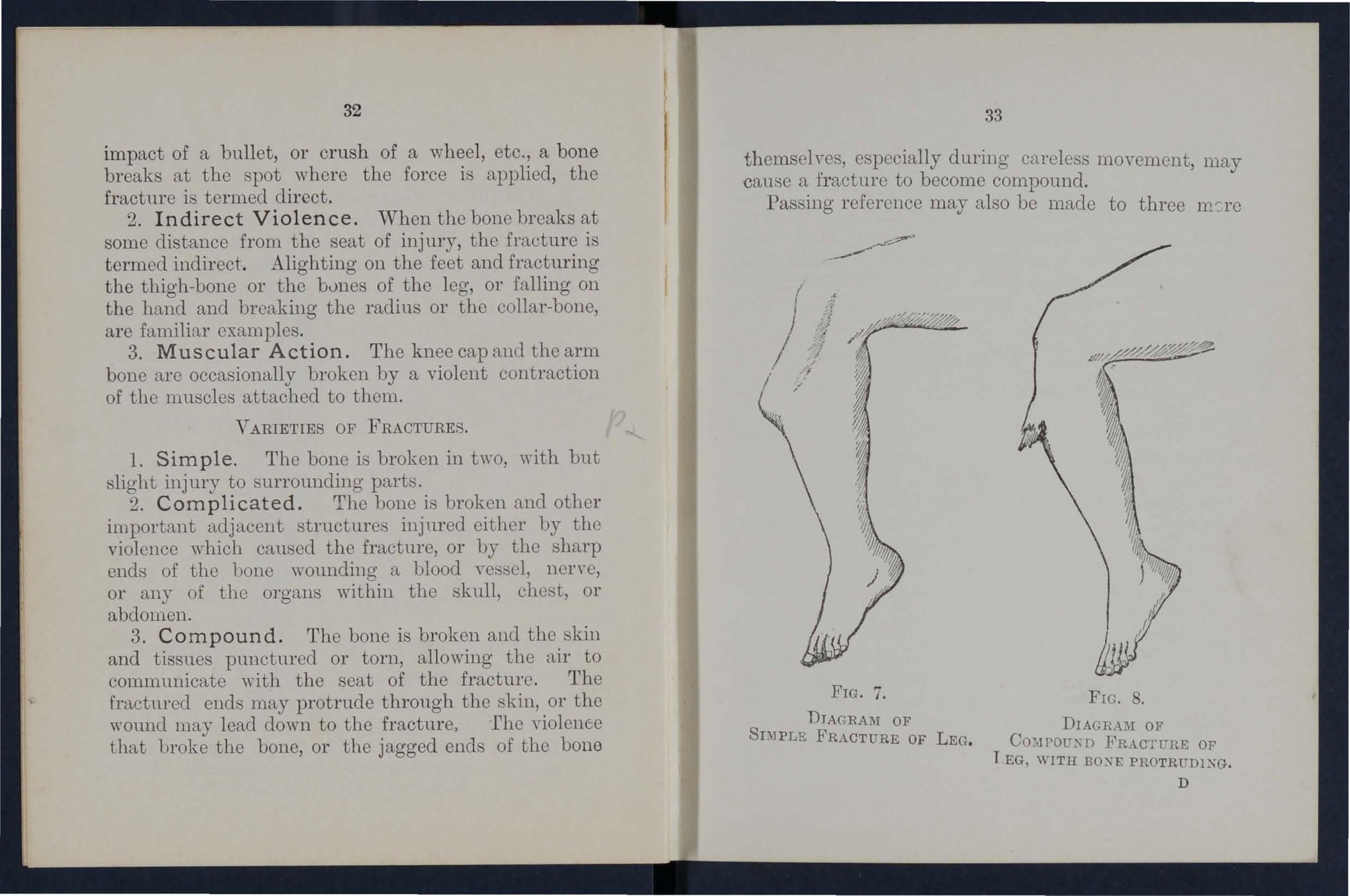
DIAGRAM OF SnJPLE FRACTURE OF LEG.
DIA GRAM OF CO:\lPOU _' D PRACTURE OF T EG, WITH BOXE PROTRUDING . D
3 -1
varieties .. Comminuted :- The bone is smashed into several pIeces. Green-stick :-In child r en owinO' to the softer state. of the bony tiss ues, a b;ne ma; bend and crack breaki ng completely across . Impacted :-'When,.ll1stead of overrid ing, t h e b r oken ends of a. a r e drIven the one into the oth er t h e f:'acture IS SaId to be impacted . Several of t h e SIgll3 al:d symptoms of fracture mentioned below are absent 111 green-stick and impacted fractures.
SIGKS AND SYMPTOMS OF FRACTURE.
1. Loss of Power in the li mb
Pain at or neal' the seat of
3. The injured lin..L libe in an unnatura: . posItIOn, and is mis-shapen at the seat of the 111Jury.
4 . S hor t en i n g. Owing to the contraction of the muscles! the ends of the bone override causinO' shortemng of the injured limb . '0
5. Swe llin g. . The overr iding ends of the broken bone, the . contl'a.::t'on of the muscles and effusion of blood, wIll. the parts l,round the seat of the frfLcturc to 111crefLSO in bulk.
o. I rre g u la r it y. If the fractured hone is clm;e t he skin as in case of the j,1,W, collar-bone, 8hm-bone, etc ., the gap 111 the bono or the ends of the 111ny be felt by finger.
,. Unn a t u r a l M ob i lity. Moyemont may he

made out at t h e scat of t h e break in the bone as well as n,t a joint . 8. Crepitus or bony gr ating may be felt or heard when t h e b r oken en ds move one upon the oth er . Th e last two signs sh ould only be sought by a sUl'geon.
Splints and Bandages are the apparatus by wh ich b r oken bones are to b r treatcd. In hospitab, . plints and bandages appropriate to every variety of fracture are at hand, but for (( Aid" trcatment t h ey freq u entl y haye to be improvised.
Splints may be improYiscd from walking . ticks, u mb r ellas, billiard cue::;, broom or bru::;11 h andles, a policeman's truncheon, a mnsket, n, l)ayonet, 01' a sword in its scal)bard, a folded coat, any piece of wood, firmly folded newspaper or any other paper, a rolled-up map, 01', in fact, anvthinu that is finn and long {?tougli to keep t he joz'nts iml1whately above and belO1c the fmctuTed bon e at 1·e::5f. 'Y h ether any of the aboye appliances are cwailable 01' not, the upper limb may be tied to tho trunk 01' C J lower limb to its fo lloW' .
Bandages may be impl'oYised from handkerchiefs, bdts, straps, brace::;, neckties, 01' any piece of linen or cotton t h at comes to h and.
Esmarch ' s Triangular Bandages (F ig . 9) are made by cutting 11 piece of linen or calico about forty D '?
POIKT.

LOWER nORDER.
FIG. 9. BANDAGE SPREAD OUT.
FIG. 10. LOWER BORDER. BANDAGE OXCE FOLDED.
LOWE BORDl<:R.
FIG. 11. BROAD BANDAGE. C'-=--"'- END
LOWER BORDER.
FIG. 12. NARROW BANDAGE.
inches square mto two pieces crossways. The bandage may be used either as a broad or narrow bandage.
The broad is made by spreading the bandage out,
13.
FIG. 14.
then bringing the point down to the lower border (Fig 10), and then folding into two (Fig. 11).
The narrow is made by folding the broad bandage again in two (Fig. 12).
'Yhen not in use, the triangular bandage should be folded as a narrow bandage, the two ends should be turned to the centre, and the bandage then folded into fonr, redncing it to a packet about 6t inches by inches. \Vh en the bandage is folded in this manner it is only necessary to extend it lengthwise to form a narrow bandage, and to unfold the narrow bandage and so double its width to make a broad bandage.
38
. The should al w.ays be fastened either by a pill 01' by tymg the ends with a reef knot (Fig. 13).
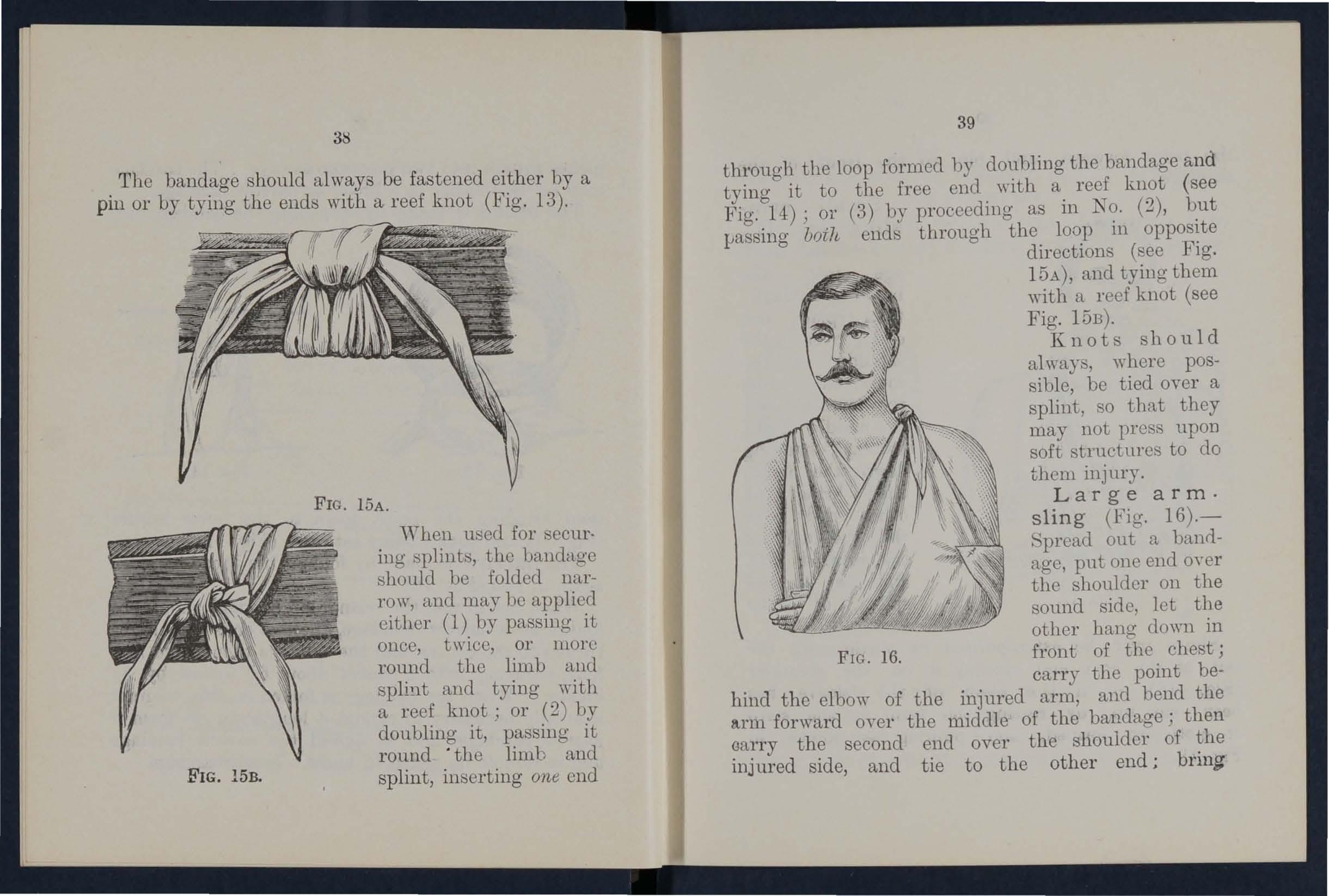
FIG. 15B.
FIG. 15A.
,Yhen used for secur· ing :::;plints, the Landage should be folded 1}(1.rrow, and may be applicd either (1) by passing it once, twice, 01' morc round the limb and spli!1t and tying with a reef knot .: or (2) by doubling it, passing it round . the limb and splint, inserting one end
39
through the loop formed by doubling the bandage and tying it to the free end with a reef knot (see Fig. 14) ; or (3) by proceeding as in No. (2), but {Jassing uoth ends through the loop in opposite directions (see Fig. 15A), and tying them with a re ef knot (see Fig. 15B).
Knots should al ways, where possible, be tied over a splint, so that they may not press UpOD soft structures to do them injury.
Large arm· sling (Fig. 16).-
Spread out a bannage, put one end oyer the shoulder on the sound side, let the other hang down in
FIG. 16. front of the chest j carry the point be-
hind the elbow of the injured arm, and bend the !trm forward oyer the middle of the bandage; then Garry the second end over the shoulder of the injured side, and tie to the other end; bring
the point forward, and pin to the front of the bandage.
Small armsling (Fig. 17).

FIG. 17.
-Fold the bandage into the broad bandage; then place one end oYer the shoulder on the sound side; cross the forearm over the middle of the bandage ha llging down the chest; then bring the other end over the shoulder on the injured side, and tie at the side of the neck .
.Slings may be extemporised by turning up the tall of the coat and pinning it on the shoulder (Fig. 18), or if the seam of the sleeve has beell slit up, by resting the arm in the strip of cloth so formed, and pinning as shown in Fig. 19.
RULES TO BE OBSERVF.D IN TilE OF FRACTURES.
The object of first aid of fra?tures is to guard again t further mIschIef, and espeCIally to pre-
FIG. 18. FIG. 19.
yent a simple fracture from becoming complicated or compound. To attain this end :-
1. Attend to the Fracture on the spot where the accident occurred. Ko matter how
cr owded the t h orou ghfare, or hO\\T sh ort the distance to a mo r e convenient or comfortabl e p lace, no attempt must be made to move the patient until the bone been rende r ed n.s. as possibl e by a spl mt or otb .: r r estrallllllg apparatus. "With this great p r inciple established, the treatment of snecial fractures is a que tiOll of detail. J.
2. Steady and support the injured li m b at so that . its movement on the part of elther the patlent or tile b:rstander s is prevented .
3. When a bone of the extremity is broken gently pull u pon the foot until the li mb regai:ls a. m?re normal shape. When the position of the lunb lS lmproved, on no account l et 0'0 of the limb until it is secured in position by splints,Ootherwise the muscles will be allowed to contract, and the rough of the broken bone may penetrate the skin, pIerce a blood-vessel, or do further damage . It is not well to attempt extension (i.e., stretching) in case of a fracture of the upper limb . This should be left to the surgeon .
4. When .the fractur e is co m pound and further complIcated by severe hroillorrhn,ge , arrest the hcemorrhage before further steps are taken. ! n a ll cases of compound fracture apply cl ean dresmgs to the wound .
,5 . Apply splints and bandages to secure th e limb in position, and t o prevent movement wh ilst t h e

4:3
patie nt is bei ng carr ied to h is home, to a hlJspital, or to tempora r y shelter. The splints should be long enough to keep t h e joints immediately above and below the fractured bone at rest.
6. In every ea 'e of fracture, it is neces::;ary to k eep the patient warm , so as to les::;en the effects of the HOCK of the aecident; this is done by placing a cloak, ::;h<\,wl, or coat over the patient until he reaches shelter.
Fracture of the Spine. - T he ve r tebral column may be b r oke n either by direct violence or by indirect vioience . Fall ing from tL height on the back acro::;s a bar, cr Up 8 l1. all uneven surface, is an example. of direct violence. 011 the head, or a crnshmg force applied to the are examples or indil:c:ct violence, causiuO' usually a broken neck. "What l commonly a ' a broken back consi::;t::; of a fracture of proces!::)es connecting the bones with displacement of Lhe vertebrm, thereby endangering the spinal cord and the nel'VeB i!::)suing from it, leading to complete or partial paralysis of the parts below the ::;eat of injury.
Tr eatment.-Preyent all movement on the part of the patient. If a doctor is "within cc1.ll, keep the patient quiet until he arrives. If the seryices of a doctor cannot be obtained within reasollc1.ble time,
44
pass a blanket, sheet, stout plaid, piece of sailor canvas, etc., beneath the patient. Do not roll the patient over in doing so, but pass the blanket or sheet, etc., careflllly first beneath the head, then lmder the body and lower extremities ns he lies on his back.
Poles are then to be rolled in the blanket one on each side. The patient may now be lifted by four persons) two on either side, grasping the (each person using both hands), laid on a stretcher or shutter, and carried to shelter. No further treatment is called for until the doctor arrives, except to giye the patient water, tea, etc., if he is conscious.
Fracture of the Skul1.-Fractures of the cranium are dangerons in proportion to the extent of the inj nry to the brain contained within its boundaries. Usually there are symptoms of injury to the brain (see Compression and Concussion, pages 108 and 109).
Fractures of the vault are less dangerous than fractures of the base of the cranium. 'Vhen any part of the vault is fractured and a scalp wound reveals inj ured bone, the fracture may be seen or felt; thIS mayor may not be associated with evidence of brain injury.
)iVh:m the base of the cranium is fractured, blood or clear fluid may issue from the ear; or the blood may escape from the nose, or may pass clown to the stomach whence it may be 'i' omited. The fracture may involve the orbit, when blood will escape into

45
the sockets of oue or l.>oth eyes. 'When the fracture is far back, there may Le indications of a bruise at the back of the head.
T 'reatment .--Arre f:t any kClllorrhage from n bloodvessel in t.he scalp (see page 80). l'lace the in an easy pOSItIOn to Lreatlle; uudo all tight clothiug; carry the patient indoors or under slleltcl'; apply a clean hallclkerchief, a piece of lillt or linen dipped ill co ld \Yater, or, if (1.Y'lilahle, an iceLug, to the h ead. Do not giYe all),L'hing by the month if the patient is insensible, and get a doctor speedily.
Fracture of the Lower Jaw. There are the uS11al signs ::>f fracture, with imd)ility
FJG. 20. to speak or moye the jaw freely, irregularity of the teeth [md bleeding from the 1'1·eatm ent.-Plcwe the palm of the hand below the inj ured bone, press it gently up"'ards against the
upper jaw, and maintain it in that position by a narrow To apply the bandage, place the to one sIde of the chin, carry the ends up the sIde of the head, crossing them just above one ear, and the ends round the head, tying them on tIle swe of the ite to t h e crossing (Fig. 20) . Another method IS to tIe the ends on th r.:: top of the head, and pass a second bandage in front of the chin, fa. 'ten the ends at the back of the neck, and tie all four ends on the crown of the head .
Fractured ribs usually fractured are those occupymg a central position in the chest, name ly, the ?th, 7th, 8th, and 91,11. The higher and the lower are seldoln fractured . A. rib may be broken by a dIrect blow or by a s111eeze or crush. It mn,y he hroken in any part of its cour e, but it ii'l n . nally fractured halhmy between the hreast-bone al?d the bn,ck-bone. The danger of a broken rib varies wIth the of injury to the lung . Pl'Rctically, wherever a nb IS to b? felt there is lu ng beneath; t herefore any force whICh te nd s t o drive the ends of the ?roken bene inwards may tear t h e lu ng. and Symptoms. -When a rib is broken t he patient comp lains of a severe pain, on atte mpting t o tak e a d eep the breathing is short and shallow, crepItus may fe l t on placing the han d over t he InJured p art. Should the rib penetrate th e lung blood may be coughed up and expectorated
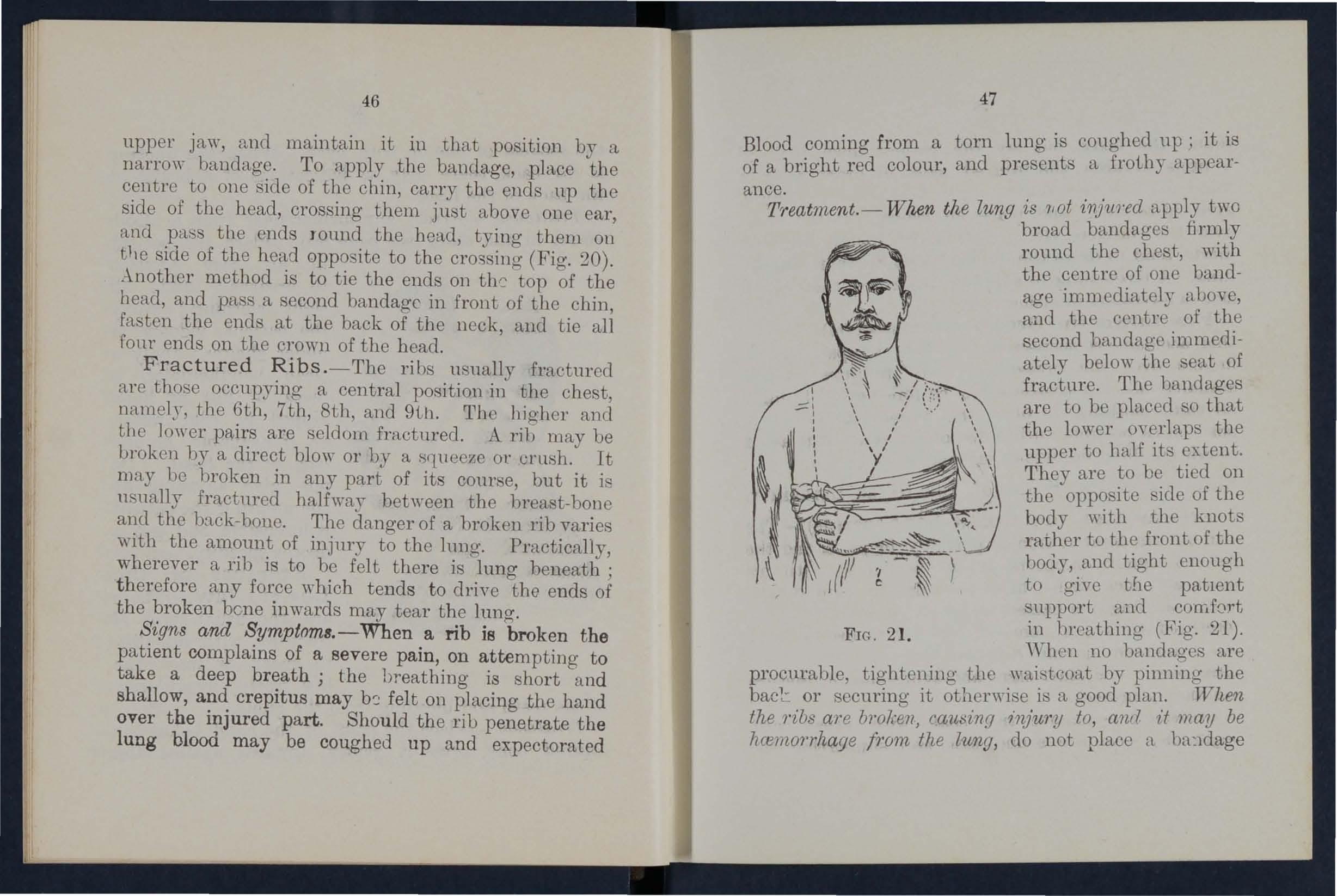
47
Blood corning from a torn lung is coughed up; it is of a bright red colour, and p r esents a froihy appearance .
Trea t ment . - W hen the lung is ?Iot apply two broad bandages firmly r ound the chest, with the centre of one bandage immediately above, and the centre of the second bandage immediately below the seat of fracture . The bandages are to be ph-wed so that the lower overlaps the upper to half its extent. They are to be tied on the opposite side of the body "ith the knots ra"ther to the front of the hoely, and tight enough to give the patlCnt support aad comfort
FIG. 21. in bl'cctthing (Fig. 21). ,\Yh en no bandages are procurable, tightcning thc wnistcoat by pinning the bacl: or securing it otherwise is a good plan. When the ?'ibs ar e broken, causing injury to, and d may be hcemorrhaqe !?'om th e lung, do not place a bn:ldage
round the body, but lay the patient dovm inclined a littie towards the injured side, in orde;' t ::- giYe play to the sound lung; loosen the clothing, g Ive ICe to suck, and p lace an ice-bag on the ehest over the broken rib . A. bandage round the chest might tend to drive the broken bone further into the l ung. A large, ling to Support the arm of the inj Llred side is advisable in either case.
. o.fthe Breast-bone (steTnum).-"When thIs accIdent IS suspected, or ,-;-hen by passing the fingers over the breast-bone th frauture can be actually felt, the treatment to be followed is, to undo all tight clothing, to place the patient in a easy a position as possible Lll1til a doctor arrives, and to avoid rough handling or sudden movement.
FRACTURE OF THE BONES OF THE UPPER EXTREMITY.
F r a cture of the Co ll ar- bo ne (clavicle).-The on the injured side is partially helples , and the patIent usually Support it at the elbow with his hand, and inclines his head towards the inj med cide. When the finger is passed along the inj med bone the fractured ends can generally be felt to overlap, the outer fragment having dropped below the level of the inner one. The other signs and symptoms of fracture a r e mostly present.
T.l·ea,tment ..-Remove the coat with grea.t care, begmnlllg WIth the sound side and supporting the

injured limb during the removal of the sleeve therefrom; also take off as much more of the clothing a.s is expedient. Place pad the size of a Bath bun in the armpIt of the Il1Jured side. Gently bend the forearm well up, keeping F IG. 22.
the elbow as far back as practIcable, and support in a large arm sling. Instead of. the large a1'm sling in the usual method, It IS advl 'a1Jle to pass the end, that in the ordinary way would go over
bone, beneath the armpit of the injured and tIe th.e ends behind (Fig. 2). An alternatIve form of slm g, preferred by some, is put on as follows: flex the forearm as aboye; place one end of

FIG. :23A.
(Bandago round body, olllitted to show <lett.jls of sling)
'(,he bandage on the shoulder of the uninjlued side , keeping the point towards the injnre(l side; pa s the base between the flexed forearm and the body, then under the armpit and acros:::; the back, and tie
5l
the two endb 011 the shoulder of the sound side. l'he point and part of the sides of the bandage al:e now to be folded to support the elbow and fixed wIth one 01' two pins (Figs. 23A and 2313); by either of these plans the broken bone is not pressed upon by the bandage.
Finally, tightly secure the limb to the side of the hoc1y by a broad bandao'e applied over and Ul)On the elbm... of the'" injured lim b, as shown in outline (Fig ' . and carry the end.' horizonbllly round the che·t co as to leyer out the anll at the . houlder joint, tlw pad forming the fllicrum.
,Yh en Ol1e balldag e Fig. 2-1:.
on)y is available a pad in the armpit, ,the forearm. a' lll. (hagnun (Fig. ::4), apply a uallOW bandage lllllnedw,te ly auo\'o the elbo" brin o' d . , b one en the front of the chest; carry the othar end behllld the al'lll, and then bring it forward
52 between the limb and the body; pass it so as to em brace the portion of the bandage on the front of the chest, and finally carry it round the back; pull tight and tie off as in diagram (Fig. 2-1:).
Fracture of the Shoulder-blade (scapula) is to be treated, after the clothing is by applying a broad triangula,r bandage firmly round the body, over the seat of injury, and therefore close up to the armpits; the limb is then supported by a large arm sling.
Fracture of the Arm (lzum,e?'us).-The bone may be broken close up to the shoulder, in the middle of its shaft, or in the immediate lleighbourhood of the elbow joint. The usual signs and symptoms are present.
T1·eatment.- 'When the Hume1'us is /'J'aciU1'ul at its upper' end close to the shmblde1' joint :- Apply a broad bandage with its centre above the middle of the arm, and carry the ends round the arm and body, tying them on the opposite side; Sl !pport the forearm by a small arm sling. When the shaft of the is broken :-Bend the forearm at right angles to the arm; apply foul' splints of wood or folded newspapers, covers of books, etc., to reach from shoulder to elbow, to the front, back, outer, and inner sides of the arm (Fig. 25). The splint in front (over the biceps muscle) must on no account be so long as to press upon the fold of the elbow joint, otherwise the blood-
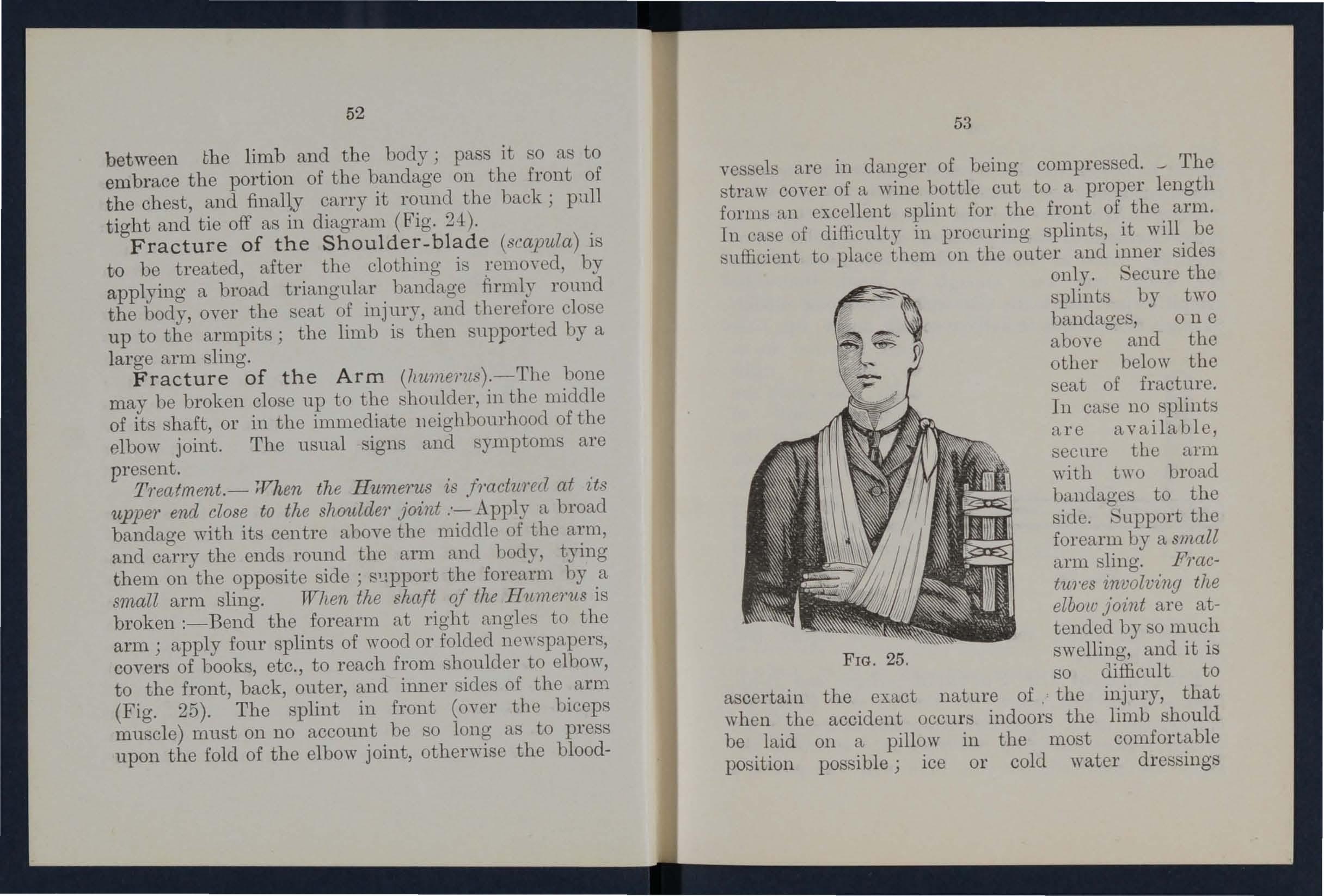
vessels are in danger of being compressed. The straw cover of a wine bottle cut to a propel' length forllls [\,n excellent splint for the front of the arm.
In case of difficulty in procuring splints, it will be sufficient to place them on the outer and inner sides only. Secure the splints by t,yO bandages, 0 n e above and the other below the seat of fracture. In case no splints are available, sec nre the arm with two broad banchges to the side. upport the forearm by a small arm sling. F1'actU?'es involv£ng the elboll-' joint are attended by so much
FIG. 25. swelling, and it is so difficult to ascertain the exact nature of .' the injury, that when the accident occu rs indoors the limb should be laid on a pillow in the most comfortable position possible j ice or cold water dressings
54
should be appli ed to the injured part, but no furt h er treatment should be attem pted pending the a r rival of a docto r . When the accident occurs out of doors, it is to be treated by the application of an angular splint (Fig. 26) made as follows :-Take two pieces of thin fiat wood, one long enough to reach fr om the armpit to just below the elbow, the other long enough to reach fr om above the elbow to the finger tips; tie
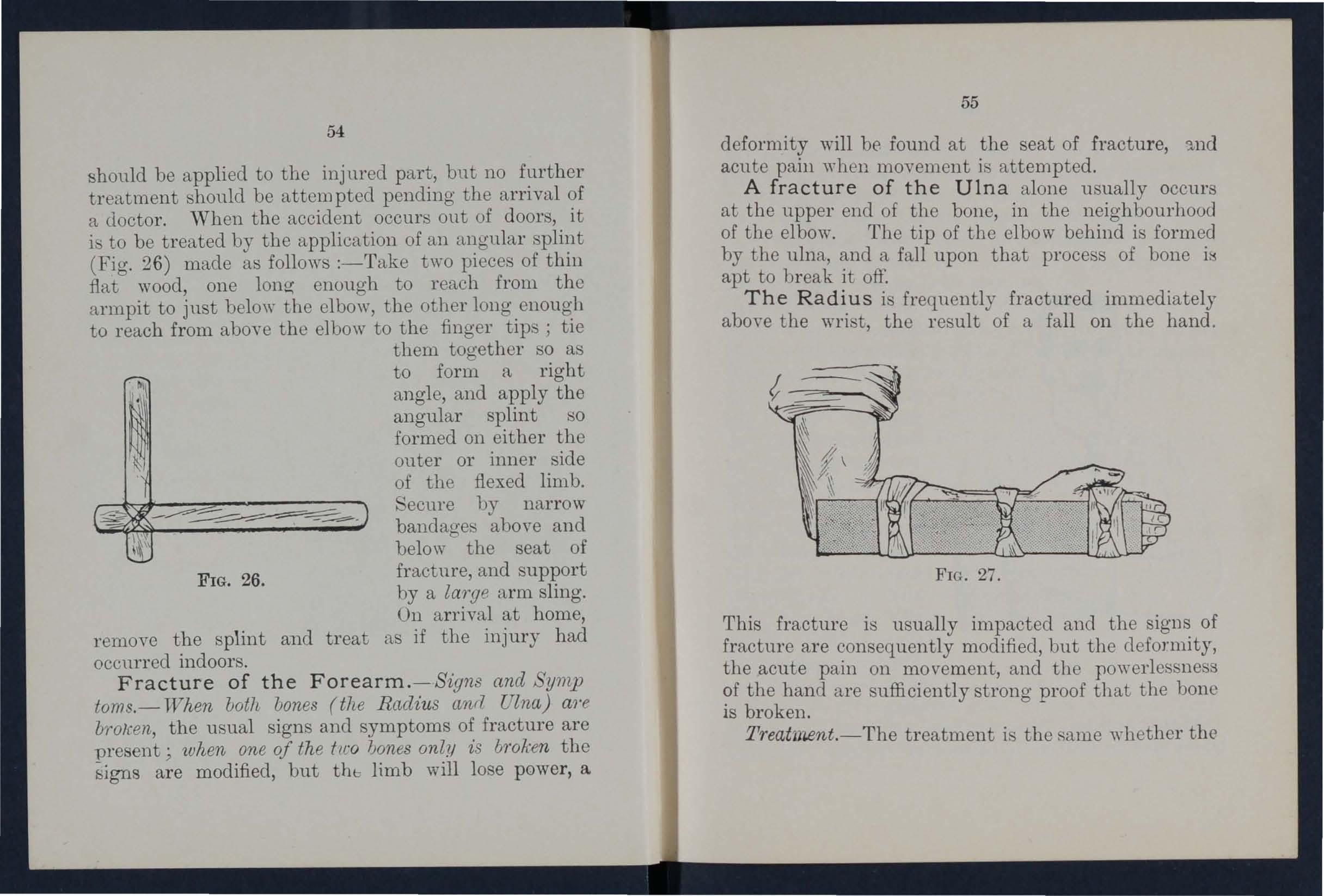
55
deformity will be. found at the seat of fractu r e '1nd . ' acute pam "'hen movement is attempted. A fracture of the Ulna al one usually occurs at the upper end of the bone, in the neighbourhood of the elbow. The tip of the elbow behind is formed by the ulna, and a fall upon that process of bone apt to b r eak it off'.
The Radius is frequently fractured immediately above the wrist, the result of a fa ll on the hand.
F IG. 26 .
remove the splint and treat occurred indoors. them together so as to form a righ t angle, and apply t h e angular spli nt so formed on either the outer or inner side of the flexed limb. Secure by narrow bandages above and below the seat of fracture, and support by a la1"ge ar m sling.
FIG . 27.
On a r rival at home, as if the injury had
toms.- When voth vanes (the Radi'us and Ulna) a1'e brolfen, the usual signs and symptoms of fracture are -present.; when one of the fico bones only is b1'oken the signs ar e modified, but thb limb will lose power, a
This fracture is usually impacted and the signs of fracture are consequently modified, but the deformity, the acute pain on movement, and the po,Yerles ness ?f the hand are sufficiently strong p r oof that the bone IS broken . T'l'ea t m,ent . - The treatment is the Rume whether the
56
fracture is of one or both of the bones. Bend the forearm at right angles to the arm, keeping the thumb npwards and the pal m of the hand toward::; the body; apply two broad splints whi l e the forearm is maintained in thc bent po::;ition, 011e along the iuner, the other along the outer side of the limb. The inner splint should bel l.ong enough to rea.ch from the elbow to the fingers, and the outer from the elbo\\' to the ba.ck of the hane1. , ecure the splints by lJandages, one abol'e, and another below the sea t of fracture, and a third to fix the hand in posit ion (Fig. 27) .
Fig . 28. F inally, suppor t the limb by a large arm sling.
Metacarpus .-One or l1'ore of the metacarpal bon es may be broken by direct or indi r ect violence.

57
'iVhen a metacarpal bone is fractured, place a round pad, sllch as a tennis ball, in the palm of the hand, bend the finge r s round the ball, and secure the whole by a bandage, and apply a large arm sling (Fig. 28).
of a Bone of the Finger (phalanx) .
-The nature of the injury is readily recognizable as the deformity can be both seen and felt. ' the injured finger gently into posItlOn, apply a narrow splint along the front of the finger, and secure it by a piece of linen, ta,pe, 01' plaster. \Vhen several fingers are injured apply a splint large enough to support the whole hanc1. Support thc hand and forearlll by a large arm sling.
Fracture of the Pe l v i s .-Signs and Symptoms.
- 'When, after severe injury in the neighbourhood of the haunch bone: there is no sign of inj ury to the lower extremIty, but the patient is unable to stand, or walk, or eyen to move the lower limb::; ,rithout grecLt difficulty and pain, a fracture of the 'pehis may. be assllmed to hale occurred. Deformity, crepltn, ctc ., cannot u 'nally be made out. The and organs, more especially the bla.dder, wltlun the pel,is, are in great danger of being \votmded.
. T reatment . -Lay the patient in whate,er position
I S fOUild to gi,c greatest ease. . Bind a broad band age round the hips tight enough to support the par t, but not so tight as to press the broken bone
58
further inwards towards the cavity of the pelvis, and thereby more damage to the internal organs. Flex or straIghten the lower limbs accordinO" as the patient wishes, and lay him carefully on a °blanket, shutter, or stretcher before moving him to a plar.e of shelter.
FRACTURE OF THE BONES OF THE LOWER EXTRE)HTY.
,Fracture of the Thigh bone (jemur).-The thIgh bone may, be broken at the neck (the upper end) j anywhere 111 the length of its shaft; or at the lo"wer end close to the knee. Fracture of the neck of the thigh is apt to occur in old people, !rom very slIght lllJury. A severe bruise of the hlp IS apt to be mistaken for a fracture. It may be a safe guide, however, that when, after 111Jury 111 the neighbourhood of the hip joint the 111J ured person call, whilst lying on the back, raise the heel off the ground, the bone is not broken j but if the heel cannot be raised it is safe to assume that bone is broken. Fracture of the lower end of the is to involve the knee in the injury, wIth. serIOUS detnment to the joint. and Symptoms .-The usual sio'ns of fracture. of the injured limb will lie in °some abnormal posItIOn, usually on its outer side. The shortening on the injured side may vary from one-half to three inches. 59
Treatrnent.-( l ) Steady the injured limb by holding the foot . (2) Gently dra"w down the foot of the injured side, and bring it into line with the foot of the sound limb. When two 01' three assistants are at hand, it is one person's duty to attend to the holding it in position and not letting go until the splints and bandages are applied. (3) Apply a splint on the outer side of the broken limb, long enough to reach from the armpit to beyond the foot . A broom handle, a, mL"Lsket (butt end in arm-

pit), a school map rolled up, a couple of billiard cues tied together, or any piece of wood cut to length may be used as a splint. (-!) Apply a splint on the inside of the broken thigh, long enough to reach from the inside of the top of the thigh (the fork) to the knee. (5) Secure the splints in position by bandages. Pass one rOlmd chest just below the armpits; another round the pelvis; a third and fourth bandage, embracing both splints, are placed on the thigh, one above and the other below the seat of
FIG. 29.60
fracture j a fifth bandage round the leg; a sixth is to to be passed behind both ankles, the end crossed over the front of the feet, embrac ing the splint, and tied off below the feet . F inally, apply a seyenth hlndage round both knees (Fig . ?9) . . Do not apply a bandage over. the abdomen, as It mIght cause the patient to vomIt, and, moreover, would not keep the splint firm. (6) shock by keeping the patient warm . When a is single-handed, it is expedient, after extenSIOn of the limb, to tie the feet together to p r event. the bones from again overlapping j and under these as well as when the patient is a woman, It . IS well to pass all the limb bandages round both lImbs, dispensing with the inside splint (Fig 30) .

F IG. 30.
Fracture of the kneecap (patella).- T he kneemay be broken by fall ing on the knee (direct MO.re it is broken by muscular actIOn, an aCCIdent WhICh may arise as fo ll ows:
(1
'Yhen the foot slips and an attempt is made to prevent a fall, the muscles in the front of the thigh act with such force in the pttempt to maintain the halance that the knee cap may be snapped in two.
f31'gns and Sym,ptoms . - The limb will be quite hclple, s; a gap may be felt between the broken ends of the kneecap; the kncc joint will speedily swell.
Tr ea tm en t.-Lay the patient on h is back j raise well and
FIG 31. FRACTURE support the head and shoulders. OF KNEECAP. traightcn and raise the limb. Apply a splint along the back of the limb reaching from the hip to beyond the heel; apply a narrow bandage ,,-ith its centre placed immediately above the broken kneecap, cross the ends behind oyer the splint, and tie off in front belo\'>- the broken bonc (Fig. 32 ).
To ensnre firmness a second bandage may be appli0d in a similar way to tho flrst, but commenced below, and tied above the broken bone. The splint is to be further secured by bandages round the thigh and leg.
The foot is then to be su ppOlted well off the ground by a pillow, roll of clothing, etc. j or if none of these can be had, by resting the foot of the injured limb on the top of the foot of the sound limb. An ice-bag or
62
cold-water dressing should be applied on the frout of the injured kneecap as soon as possible.
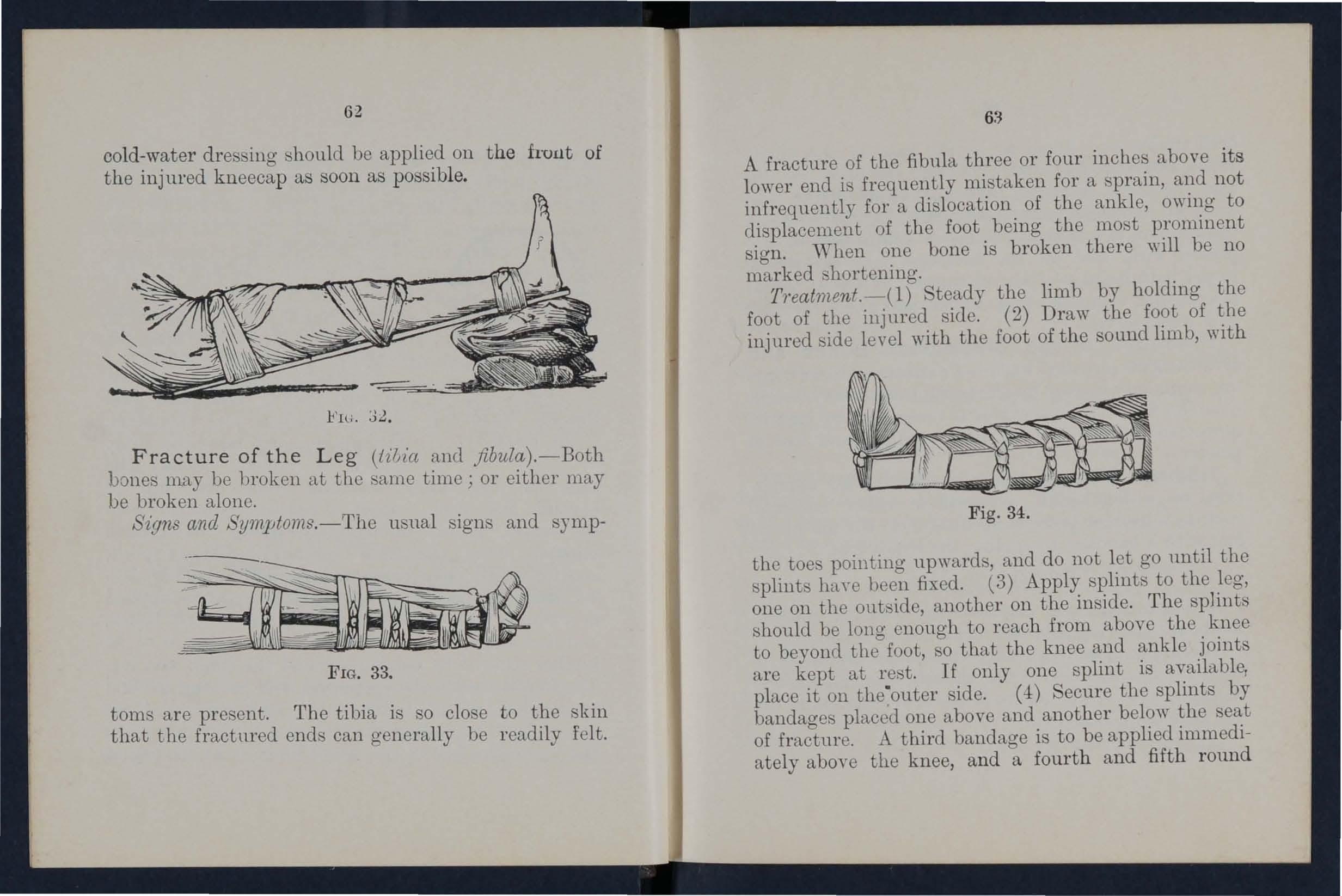
Fw.32.
Fracture of the Leg (iiuia and fibula).-Both bones may be broken at tho same time; or either may be broken alono.
Signs and Symptoms.-The usual signs and symp-
FIG. 33.
toms are present. The tibia is so close to the skin that the fractured ends can generally be readily felt.
63
A fracture of the fibula three or four inchos above its lower end i frequently mistaken for a sprain, and not infrequently for a dislocation of the ankle, owing to displacement of tho foot being the most prominent sign. 'When ono bone is broken there will be no marked shortening.
Treatrnenf.-( 1) Steady the limb by holding tho foot of the injured side. (2) Draw the foot of the injured side level with the foot of the sound limb, with
Fig. 34.
the toes pointing upward', and do not let go until the splints hcwe been fixed. (3) Apply splints to the leg, one on the outside, another on the inside. The splints should be long enough to reach from above the knee to beyond the foot, 0 that the knee and anklo joints are kept at rest. If only splint is availabl8r place it on side. (4) Secure tho splints by bandages placed ono abovo and another below the seat of fracture. A third bandage is to be applied immediately above the knee, and a fourth and fifth round
64
both and knees as in th.e case of the thigh.
TVhen after e:s:tendll1g the limb, tie the feet together, dIspense with the inside splint, and carry round both limbs (Fig ..34). When the IS a woman the in ide splint may be dispensed wIth,. and all the bandages may be carried both hrr:bs over the clothing. ,\'"hen no splint 1 avmlable, tyll1g the legs, ankles and knees too-ether is of great service.
0
Fractures of the Metatarsal Bones and Phalanges (crushed foot).-Fractures of these bones are commonly caused by. the passage of a heavy weight over the foot. The accIdent is recognised by pain on movement of the foot or toes, swelling and loss of power.
. 1'1·eatment.-The consists in the applicatIOn of a fiat splll1t of wood or other material such as a book or piece of cardboard to the sole of foot with a bandage to enclose the w'hole foot.
A dislocation is the displacement of one or more of the entering into the formation of a joint. The Jomts most frequently dislocated are those of the shoulder, the elbow, the thumb the fino-ers and the lower jaw. The joints of the 10'we1' are but seldom dislocated.

SIGNS AND YMPTOMS OF DISLOCATION.
(1) Unnatural position of the limb.
(2) Pain of a severe sickening character.
(3) Deformity in the neighbourhood of the injured joint.
(4) Fixity of the joint. Unlike a fracture, the limb cannot be moved at the joint by either the patient or others.
(5) Swelling and numbness of the parts below tho seat of dislocation.
(6) Absence of the crepitus characteristic of ordinary fracture.
OF DISLOOATIONS.
No attempt should be made by anyone except a doctor to reduce a disloca,tion. The following treatment, hmyever, peucling the arrival of the doctor, should be carried out :-
When the Accident occurs out of doors .-
(1) In the case of dislocation of the shoulder, the upper extremity in "\"hatever position 11lO::,t ease by a large arm sling; preyent all joltinu of tile limb by tying a bandage round the limb and buody or by pinning the sling to the clothing. ,Yb en no means of applying a sling are at hand, fasten or pin the cout sleeve to the clothing. (2) ,Yh en the elbow is dislocated, tie or fasten the upper extremity to th0 ::.ide
66
of the body ill the ll10st comfortable positi,on l?ossi,blC'. (3) ,Vh en any joint of the IS dl,slocated, place the limb in the eaSle t posItIOn possIb1e Rnd carry the paticnt on a stretche r to houf:)e or home.
When the patient is indoors.
1) R emoye the clothing from the injnred joint and li mb . (2) Place the patient on a couch or bed . (3) Rest the limb on cushion' or pillows in the po. ition which afford , most comfort. (-t) Apply cold (ice, or towels wrullg out of cold wetter) to the dislocated joint. (5) :Fw . 35. ,Yh en cold ceases to FORM OF DISLOCATED SHOULDER. gl\Te comfo r t apply ,mrmth (flannels or towcls wrung out of hot water), (6) ,Vh en ,the shock is severe keep the patient 'warm by appropnate r emedies. (See 'hock.)
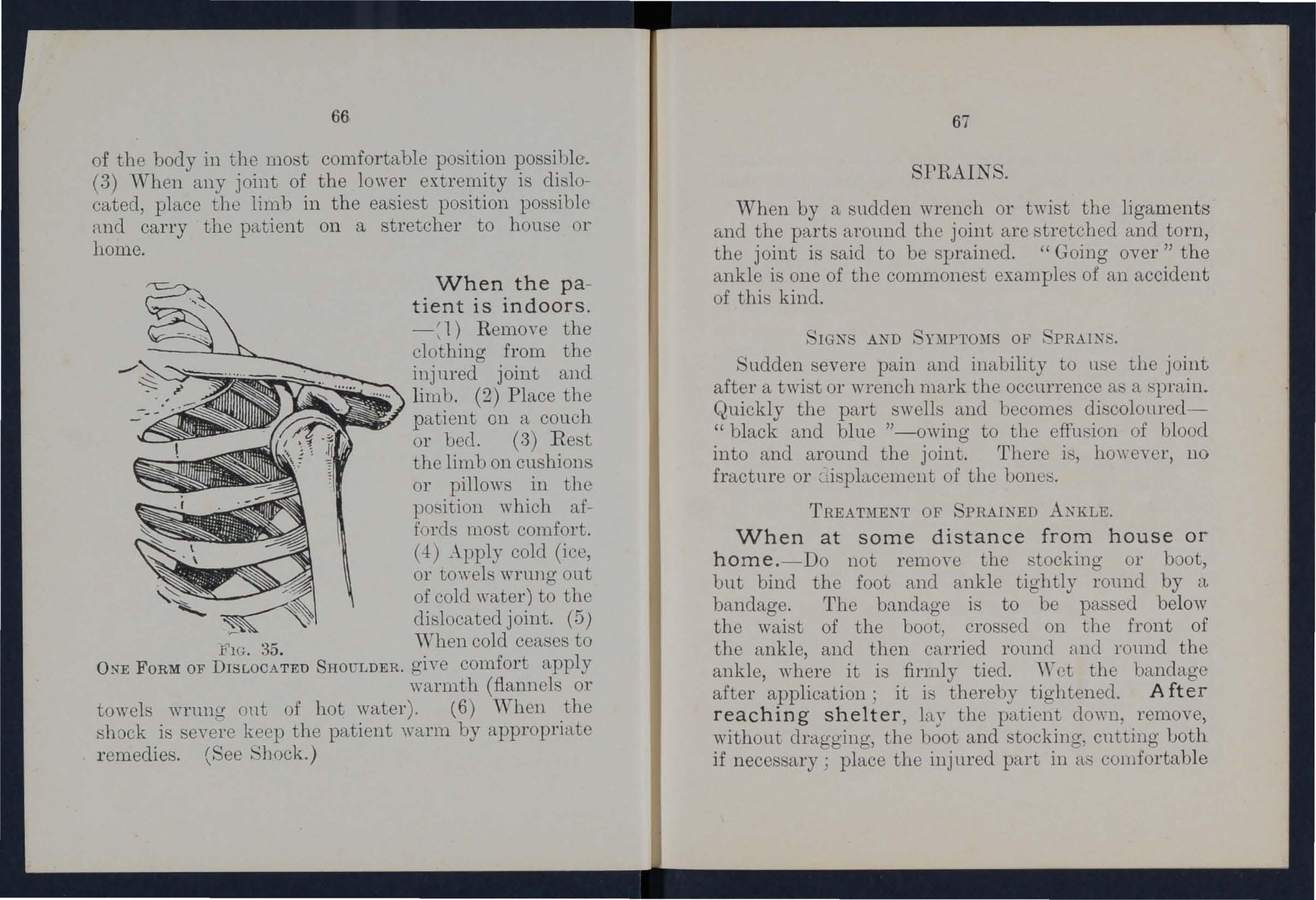
67 srRAINS.
When by a sudden wrench or twist the ligaments and the parts around the joint are stretched and torn, the joint is said to be sprained. cc Going over" the ankle is one of the commonest examples of an accident of this kind.
Sudden severe pain and inability to II ' C the joint after a twist or wrench mark the occurrence as a sprain. Quickly the part swells and becomes discolonred"black and blue " - owing to the effusion of blood into and around the joint. rrherc is, hmrever, no fracture or of the bones.
TREAT:\IE TT OF AXKLE.
When at some distance from house or home. -Do not remoye the ·tocking 01' boot, but bind the foot and ankle tightly round by n, bandage. The bandage is to be passed below the waist of the boot, crossed on the front of the ankle, and then carried round Hml ronnd the ankle, where it is firmly tied. ,y rt the bandage after application; it is thereby tightened. After reaching shelter, lay the patient down, remove, without dragging, the hoot and stocking, cutting Loth if necesf:)ary; place the injured part in a' comfortabl e
a position as possible, apply ice 01' cold-water drc::;::;ings to the joint as long as they relieve pain, and when they cease to give relief, apply hot fomentations or <\, bran poultice .
When other joint::; are spmined they rcq (lire much the same immediate treatment as "when thoy are dis located.
, Yhen, during severe exertion, as lifting and pulling heu.vy weights, mHscles 01' tendons are over-::;tretchcd, they are said to be "strained."
SIGNS AND SYMPTOMS OF STRAINS.
, Yhen a part is strained a sudden sharp ml,in o(;curs, rendering further exertion painful, difficult, or impossible. If the stmin has occurred in the back, the pu.tient lllay be lmable to stand upright or take a deep breath without pain. ,Yhen in a limb, the strained muscle may swell, causing severe cramp-like pains.
TREATA-IEN'l' OF STRAINS.
"place the patient in as comfortable a position a ' possible, and apply hot-"watel' bottle ' or hot fomentations when the pain is very severe.
A so-called strain in the groin 01' hernia), is an injury of a totally different nature (::;ee page 160).
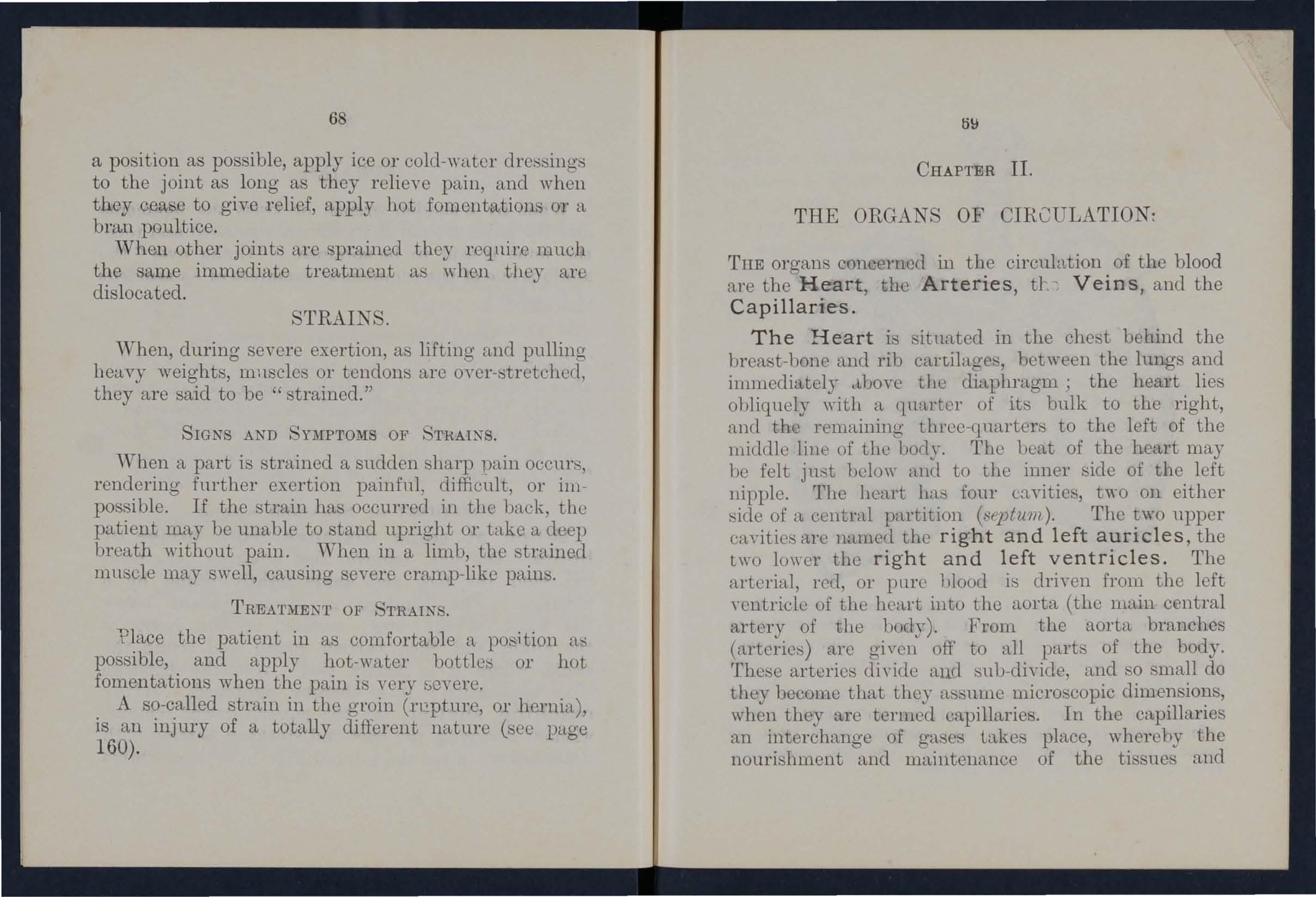
TilE oraans coneerned in the circulation of the blood are the b Hea r t 1 the A r teries , tl' -: Vei n s , and the Capillaries.
The Heart is situated in the chest behind the breast-bone <.l,nd rib cartilage ' , between the lungs and immedia,tely J,bove the dia,phragm; the heart. lies ol)liquely with a (lnnrtcr of its bulk to the rIght, and the remaining three-quarters to the left of the middle line of the body. Tho beat of the hea,rt may be felt jW:lt below to the side of the. left nipple . The hec1.rt !In.::! four cavItIes, two on eIther ::;ide of n, central p,-utition (s eptum). The upper c,wities are nallled the ri ght and l eft au n cles , the two lower the r ig h t an d left v entricles . The al'teric1.1, red, or pmc blood is driven fron: the left ventricle of the hoart into the aorta (the mam central artery of the body). From the aorta branches (arteries) are gi \'011 off to all. parts of the body. These arterie::; divide aud ::;ub-dIYIde, and so small do they become tlul,t they assume micro copic when thcy are termed capillaries. In the caplllanes an interchange of ga8e' takes place, wl:crcby the nourishment and maintenance of the tIS ucs and
L. Larynx (voice box); T. Trachea (wind-pipe); R.L. Right Lung; L.L. Left Lung (the lungs are drawn back to expose the heart and blood vessels); R.A. Right Auricle; L.A. Left Auricle j R.V. Right Ventricle; L.V. Left Ventricle; P.A. Pulmonary Artery; Ao. Aorta; S.V.C. Superior vena cava (the large veih blood from the upper part of the body to the heart) i LV.C. Inferior vena cava (the hrge vein carrying blood from the lower part of the body to the heart). The four pulmonary veins cannot be shonn in the diagram.

organs of the 1Jodyare provided for, and the red blood a purple colotn' ; the purple (yenous) blood now passes from tho capillaries to the veins, which convey it towards tho heart, getting larger and larger <l,S they proceed, by being joined by neighbouring veins until they finally as two large vessels reach the right auricle of the heart. The veins, e pecin.lly in the limbs, are provided with valYes at frequent intervals, which prevent the backward flow of tho blood. A special system of blood vessels, called the pulmonary, concerned in carrying the blood through the lungs. From the right auricle the blood passes to the right vontricle, and is then co carried to the lungs, where it is purified by conta.ct with a.ir, and becomes red in colour; it is then convoyed to the left auricle oE the heart and passes into the left ventricle, thus completing the circula.tioll.
The heart contracts in adults at all aye rage rate of seventy-two times a minuto, but the ra.te varies, increasing as the position is changed from the lying to the sitting or to the standing position. About two ounces (a wineglassEul) of blood arc discharged into the aorta at every contraction of the left Yentricle, and the blood is sent into the arteries in jets or ""aYes, cansing the pulse, which may be felt along the course of all the main arteries wherever the finger can be placed on an artery as it passes over a bone. In the yeins no pulse is to be found, as the
FIG.- 37. 72
Explanation. I n the middle of the diagram is the heart with its four chambers. Above the hea.rt is shown the lung (pulmoDary) circulation. The lower part represents the general (systemic) circulation. Vessels containing impure (venous) blood are shown black, those containing pure r (arterial) blood are shown white. t 1The connecting vessels represent the capillaries. The arrows show the direction of the flow of blood.
DIAGRAM OF THE CIRCULA TION OF THE BLOOD.
heart wave is expended during the passage of the hlood through the capillaries and reduced to a regular and even flow.
HlEMORRHAGE.
Hremorrhage or bleeding signIfies the escap e of blood from an iniured 01' diseased
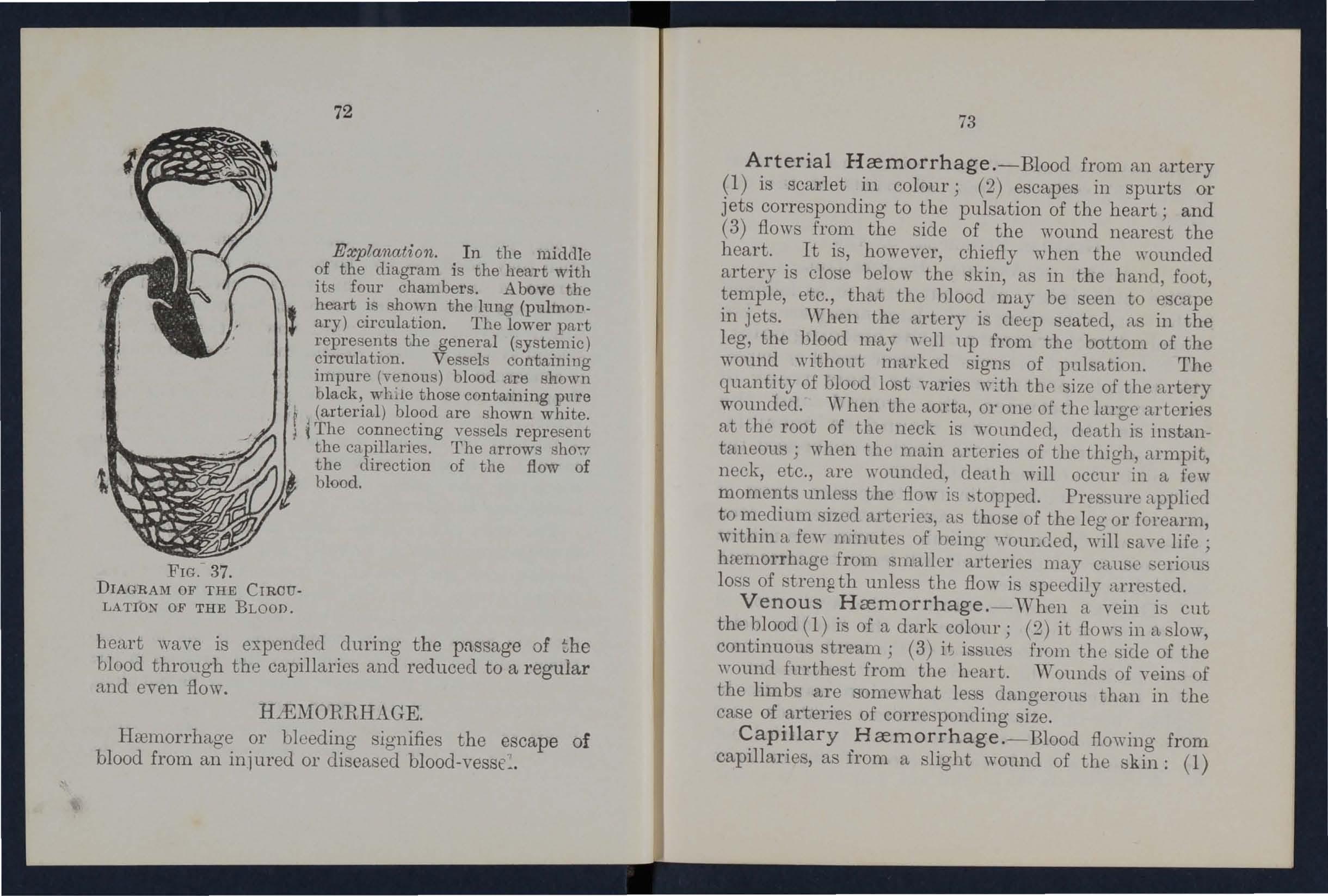
73
Arter ial Hremorrhage. -Blood from an artery (1) is scarlet in colour; (2) escapes in spurts or jets corresponding to the pulsation of the heart; and (3) flows from the side of the wound nearest the heart. It is, however, chiefly when the wounded artery is close below the skin, as in the band, foot, temple, etc., that the blood may be seen to escape in jets. "'When the artery is deep seated, as in the leg, the blood may wen up from the bottom of the wound without marked signs of pulsation. The quantity of blood lost varies with the size of the artery wounded. "'\Vhen the aorta, or one of the large arteries at the root of the neck is wounded, death is instantaneous; when the main arteries of the thigh, armpit, neck, etc., are wounded, death will occur in a few moments unless the flow is Pressure applied to medium sized arterie3, a ' those of the leg or forearm, within a few minutes of being 'Yom:cied, ,,,ill saye life; hromorrhagc from smaller arteries may ea,use 'crious loss of streng th unless the flow is speedily ;(,l'rel:lted.
V eno u s H remorr h ag e . - 'When a vein is cut the blood (1) is of a dark colon I' ; (2) it flows in a slow, continuous stream; (3) it issues from the side of the wound furthest from the heart. 'Vounds of veins of the limbs are somewhat less dangerous than in the case of arteries of corresponding size .
C apill ar y H rem or rhag e. -Blood flowing from capillaries, as from a slight wound of the skin: (1)
i lio'ht-red in colour; p) flow' briskly in 11 continuolls (3) wells up from all points of the cut surface.
The p ri n ciple s of treat m ent to be followed in the eyent of bleeding from a large artery are: ,1 t, to apply di r ect p r essure o.n the bleedlng and if direct pressure lS or lmpossible, to n.ppl.r pressure on the ma l n tr u n k of t h e arter y between ,the wound and the hea rt as close to the wound a s po s sib le. The closer to the wOlllJd the artery is compressed, the les will be the damage to the limb.
The means employed in the temporary arrest of hremorrhage are digital and instrumental compression and flexion of the limb. Laying the down and elevating the limb will lessen the force With which tbe blood escapes.
1. Digita l compression is the application of the thumb or filJgers either on the bleeding itself-dir e(.t comp?'ession-0r on the trunk of the mam artery leading to the wound-incli?'ect compression.
II. Instrumental compression may also be applied by the direct and ilJdireet (a) Direct instrumenfal ('o?np1'essi()n may be earned out by applying a handkerchief, piece of lint or linen

75
foT?ed.into a hard pad, and placed on the bleeding pomt, where it IS secured by a bandage firmly tied round the part. To fold the handkerchief as a pad, proceed as follows :-Lay the handkerchief out on a flat surface; bring the four corners to the centre of the handkerchief; again bring the corners to the centre, and continue folding the corners towards the centre until the handkerchief becomes a hard pad. The round, smooth surface is placed Oll the skin oyer the artery, and to prevent the pad unfolding, the pl:ckered .surface may be fixed by a safety pin, or stitched With a needle and thread, if such appliances are at IJand. A hard substance such as a stone cork nut, marble, etc., may, if necessary, be enclosed' in centre of the pad. Should occasion permit, a gmduated compress may be made and applied as follows: Place a small folded riece of linen or lint, or cotton, upon the bleeding point; oyer this place a second and larger piece of the same material; a third and a fourth or more pads, each larger than its predecessor, are superimposed, until a regular cone is formed, with its point or apex resting on the wound, and it· base pressed down by a tightly applied bandage. (b)
Ir:direct insf';'U?1U'l1 tal compression consists in toppmg the flow of blood through the main artery by a tourniquet. A tourniquet is an instrument whereby pres nre can be made on the trunk of an artery so as to stop the flow of blood th r ough it. A
tou r niquet may consist of a pad to be placed on the trunk of an a r tery, a st1 'ap or bandage app li ed so as to encircle the limb and pad, and a bu ckle, screw, 01' twisting appam tus ( uch as a stick) whereby to tighten the strap 01' bandage. The three principal toun:..iquets are the improvised, the field, and the

FIG. 38. F IG . 39 . FIELD TOURNIQUET. SCR EW TOURNIQUET.
screw tourniquets . Tourniquets ar e seldom applied except to the brachial and femo r al arteries. An im provised tourniquet is made and applied as follows :-On the trunk of the main artery, say the femoral or the brachial, apply a firmly folded pad, about 77
the size of a tennis ball cut in two for the thig h, and of a walnut fo r the a r m; over tlJis pad placo the centre of a narrow triangubr (or other) bandage, and tie t be ends on the side of the limb opposite to the pad.
After the half-knot of the bandage i,' made, place a stick, pencil, walking-stick, poker, policeman's truncheon, or some such instrument, upon it, and then compl ete the knot, adding yet another half-knot for security . T he" stick" i ' now to be twisted, when the bandage will bo tightened, and the pad pressed firmly upon the trunk of the artery with sufficient force to arrest the fiow of blood. Shm"ud a suitable pad not be at hanel, a knot may be made ill the centre of the bandage, and when available, a stone, cork, otc., enclosed in it to give it firmness and bulk. See that the bulging, and not the fiat, side of the knot is next the skin. The" ·tick" if:) finally "locked" in position by the end of the bandage used for the to'J.rniquet, or by another bandage passed round the limb and mB,de t o enclo e and fix the stiek.
The field tou rniq u e t consist of a pad and strap. The pad ii:l placed on the course of the artery and fixed there by tho stmp, which is pulled tight and buckled off. Tho sc rew to u r n i q u e t (by 'ome considered obsolete) acts on the same principle the strap, howeyer, being tightened by a 8crcw apparatus .
An elastic b an dage pas 'cd round the limb immediately above the seat of an arterial hcemol'rhage and
pulled tight will arrest bleeding. The simplest prepared form of this bandage is a strip of elastic webbing twenty-five or thirty inches long and t\\"o inches wide, with a piece of tape sewn at each end. An ela'tic brace or belt will, however, answer the purpose. It is not advisable to usc a cord or elastie bandage unless no other apparatus can be had, i\,S the pressu r e of the cord cuts off all circulation in the limb .
III . Flexion of the Limb .-The arteries of the back of the k n ee and t h e front of the bend of the elbow may be compressed by placing a pad upon the trunk of the main artery at the knee or elbow, and, after fully ilexing the limu. securing the limb ill a iiexed position by a bandage.
D1'BSS wound. After the hffimorrhage has been arrested by the indirect method, the wound must be covered over by a clean dressing. (See 'Vounds.)
In all cases, especially when the patient has to be moved some distance, the injured limb or part should be raised, if possible, and mai n tained at rest by splints and bandages, if need be.
OF
(See F1'ontisr;i ce)
The Aorta is the main artery of the body . Com· mencing at the l eft ventricle, it forms an arch beh ind
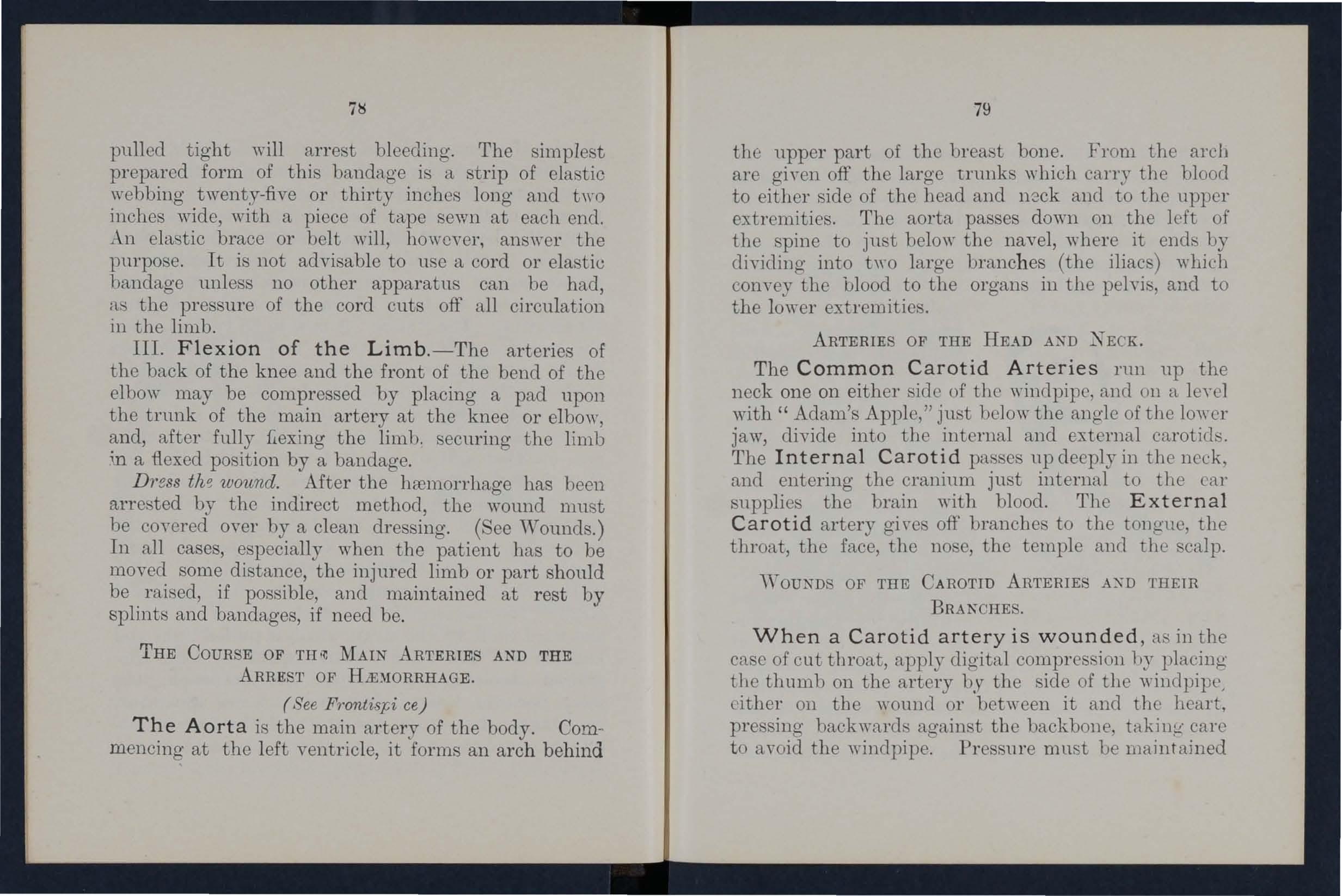
the upper part of the breast bone. From the arch are given off the large trunks \"hich carry the blood to either side or the head and neck and to the upper extremities. The aorta passes down on the left of the spine to just below the navel, where it ends by dividing into two large branch es (the iliac) which convey the blood to the organs in the pelYi. · , and to the 10\yer extremitie .
ARTERIES OF THE HEAD NECK.
The Common Carotid Arteries run up the neck one on either side of the windpipe, and on a level 'with " Adam's Apple," just below the angle of the lower jaw, divide into the internal and external carotid ' . The Internal Carotid pas es up deeply in the neck, and entering the cranium just internal to the car supplies the brain with blood . The E x ternal Carot i d artery gi \Tes oft' branches to the tongue, the throat, the face, the no e, the temple and the calp.
When a Caro t id artery is wounded , a' in the case of cut throat, apply digital compression hy placing' the thumb on the artery by the side of the windpipe, either on the ,Y0lll1cl or bet'Yeen it and the heart, pressing backward. ' again t the backbone takin!-( care to avoid the 'Yindpipe. Pressu r e must be maintained
80 by thumb (by r elay of assistants if neces 'ary), untIl the doctor arriYes; no other method beinO' applicable in this situa,tion. Bleedin o' from Temple is readily arrested by the thumb on the wound, 01' by placing a firm pad on the wound, and mn,king pressure by a bandage applied as follows: -Apply a small pad on the bleeding point, then place the centro of a narrow bandage on the opposite side of the head to the wonnd, carry the bandage horizontally round the head just above the leyel of the eyebrows, make a twist oyer the pad, pass the end. ' round the head again, or carry one end over the top of the head and the other FIG. 4!). under the chin, and tie firmly (Fig. 41) . Hcemorrhage from the Forehead , or from any part of the Sca l p , can be arrested on the same principle. Hremorrhage from the Tongue is usually controlled by ::lucking ice; should ice be unsucc e::lsful or unand the wound far forward, the bleeding POll1t maT be grasped between the finger and thumb .
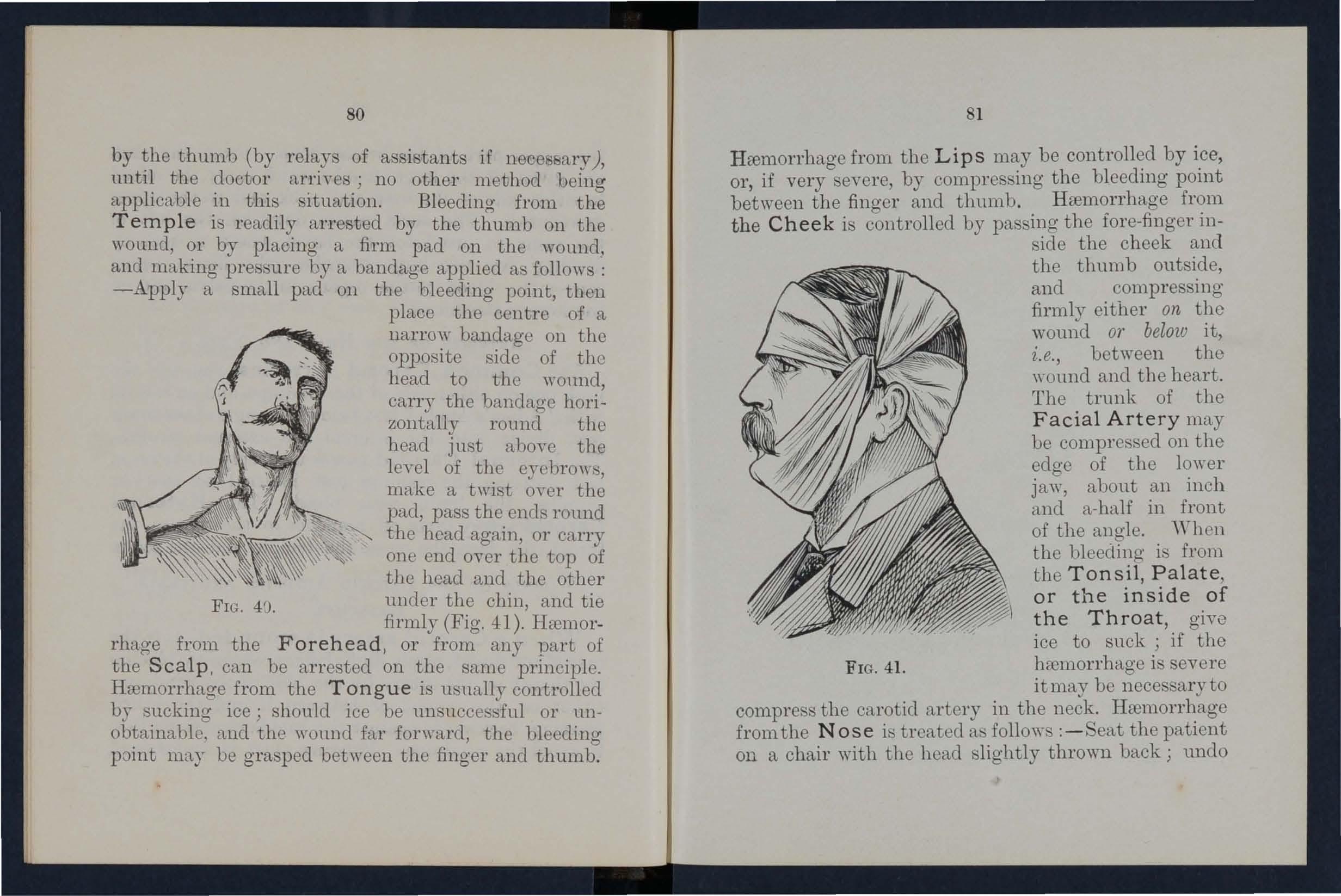
H remorrhage from tho Lips may be controlled by ice, or, if very severe, by compres ing t h e b l eeding point between t h e fi nger and thumb. H remorrhage from t he Cheek is controlled by passing the fo r e-finger inside the cheek and the thumb outside, and compressing firmly either on the wound or below it, i .e., between the ,yolmd and the heart. The trunk of the Facial Artery mn,y be compressed on the edge of the lower jaw, about an inch and a-half in front of the angle. , Yhen the bleeding is from the Tonsil, Palate, or the inside of the Throat , give ice to suck; if the F IG. 41. hremorrhage i severe itmav be necessarvto compress the carotid artery in the from the Nose i::l treated as follows :- Seat the patient on a chair with the head slightly thrown back; undo
all tio'ht clothin o' round the chest and neck; raise the aboye head, apply cold (ice, a cold sponge, or a bunch of keys) over the spine at the level ,of the collar; keep the patient in a cmrent of fresh all', and
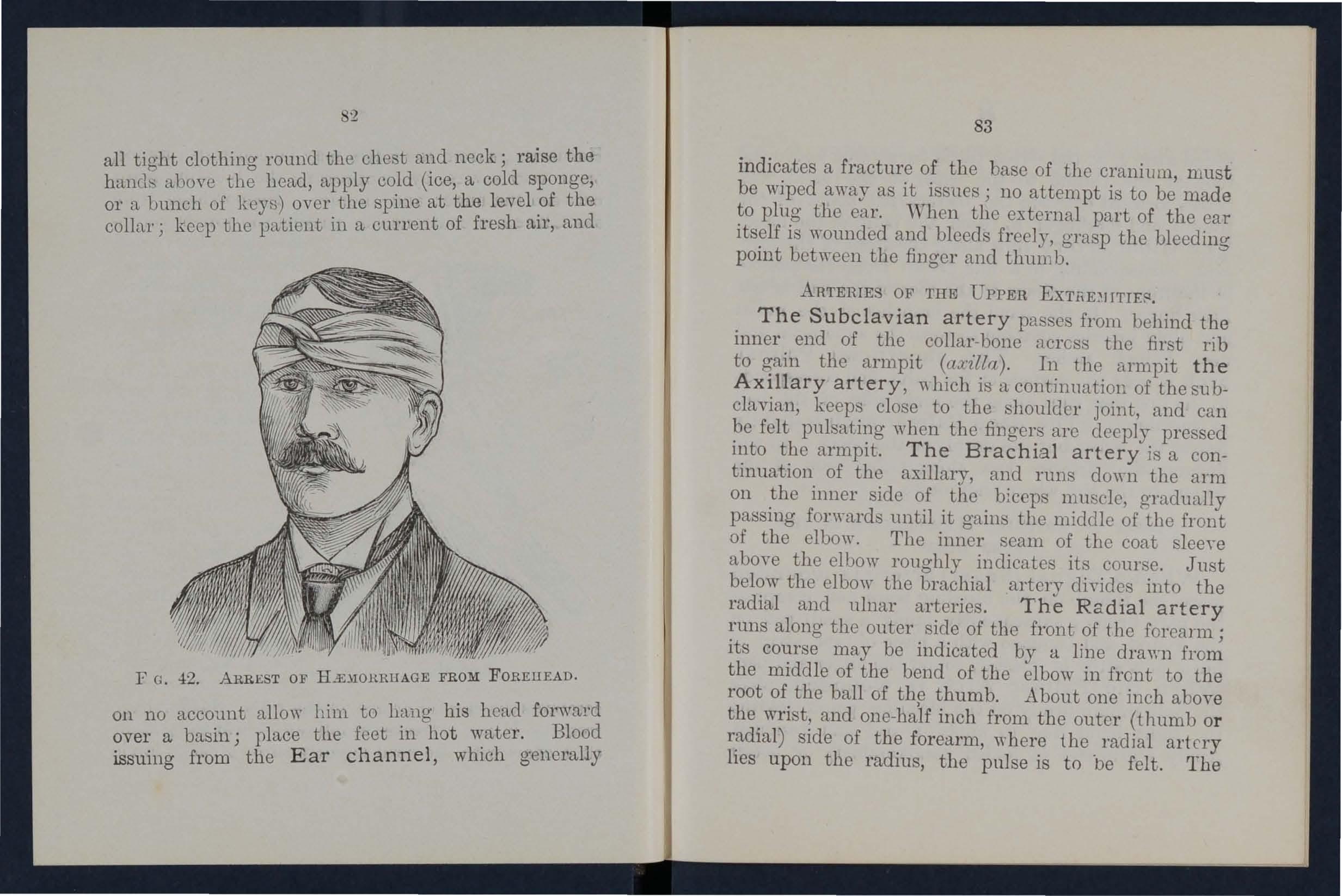
F G. 42. ARREST OF H..£MOHRIIAGE FROM FOREIlEAD.
011 no account allow him to hang his head forward over a basin j place the feet in hot ,,:ater. Blood issuing from the Ear channel, whICh generally
83
indicates a fracture of the base of the Cl'anillm, must be wiped away as it issues; no attempt is to be made to plug the ear. When the external part of the ear itself is ,,'ollllded and bleeds freely, grasp the bleeding point between the finger and thUl1 lb.
The Subclavian artery passes fro111 behind the inner end of the collar-bone acrcss the first rib to gain the armpit (axdlfl). In the armpit the Axillary artery, "hich is a continuation of the subclavian, keeps close to the shoulder joint, and can be felt pulsating when the fingers are deeply pressed into the armpit. The Brachial artery is a continuation of the axillary, and runs dOlYl1 the arm on the inner side of the biceps muscle, gradually passing forwards until it gains the middl e of the front of the elbow. The inner seam of the coat sleeye above the elbow roughly indicates its course. Just below the elbow the brachial artery divides into the radial and ulnar arteries. The Radial artery runs along the outer side of the front of the forearm; its course may be indicated by Ii line dra'Yl1 from the middle of the bend of the elbow in front to the root of the ball of the thumb. About one iuch above the wrist, and one-ha'lf inch from the outer (thumb or radial) side of the forearm, " 'here the radial artery lies upon the radius, the pulse is to be felt. The
84
radial artery, at the wrist, turns backwards above the root of the thumb to the back of the hand, and forward between the metacarpal bones of the thumb and forefinger to reach the palm of the hand. The Ulnar artery runs along the front of the forearm, corresponding to a line drawn from the centre of the front of the elbow to the root of the ball of the little fino·er. In the hand the branches of the radial and arteries combine to form the superficial and deep Palmar arches. The superficial Palmar arch is near the surface of the palm, and corresponds to the line that runs along the inner ide of the ball of the thumb. The deep Palmar arch is slightly nearer the wrist, but lies deeply on the bones. In the tingers, the arter ies run along either ,' ide of the fingeri3 to the tip, where they unite.
ARREST' OF ARTERIAL H..EMORRHAGE IX THE UPPER Lnms.
When a Digital (finger) artery is wounded place the thumb on the bleeding point and compress the part firmly; subsequently, apply a small pad on the wound, and bandage with a piece of tape, strip of linen, or a strip of plaster, round the finger and pad. When the Palmar Arch is wounded, place the left thumb firmly on the hleeding point, leaving the right hand free to apply a pad and bandage. Apply a firm pad. (a folded handkerchief), or better
85
still, a graduated compress on the bleedinO' point make the patient grasp the pad firmly, and bapply bandage as follows :-Spread out a triangular bandage , turn up the lower border about four inches lay the back of the patient's hand on the centre of the bandage, fold the point over the knuckles and wri ,t pass the two ends round the wrist, make the patient
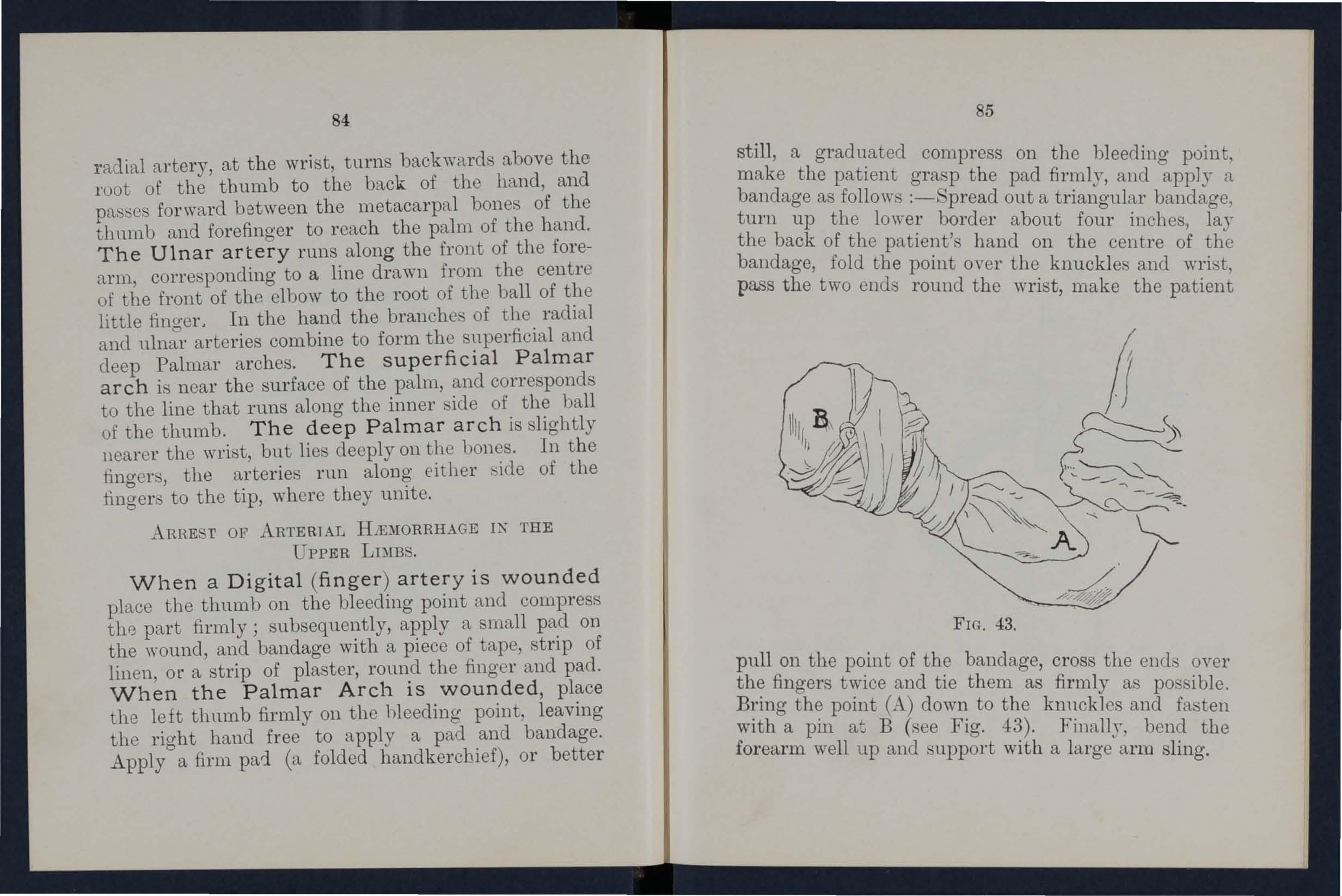
FIG. 43, pull on the point of the bandage, cross the ends over the fingers twice and tie them as firmly as po 'ible. Bring the point (A) down to the knnckies and fasten with a pin at B C, ee Fig. 43). Finally, bend the forearm well up and support with a large arm sling.
The Radial and Ulnar arteries may be compressed by placing the thumbs on the arteries one inch above the wrist (Fig. 4:4:). This may be necessary when the wound in the palm is too hrge to be covered by the thumb; instead of the thumbs, the cork of a pint or quart bottle may bc cut in two

FIG. 44. lengthwise, and one half laid on t,he radial, and the other on the ulnar artery a little above the wrist; -place the rounded sides of the cut cork next the skin a.nd secure them by a tight bandage. See also next paragraph.
87
Hremorrhcge from a wound of the Radial or Ulnar artery in the front of the forearm may be cl,rrested by a pad placed in front of the middle of
FIG. 45. being fii'mly flexed on the arm, <md mamtamed 111 the flexed Dosition
88
The pad may be made of a folded han ; with a small stone or cork ·wrapped up in it ; but when no pad is ayai lablo the coat sl eeye rolled (; 1' gathered up as far as the elb ow will serve as a pad. Bend the forearm up on the arm and tie a narrow bandage round the wrist and then round the upper part of the arm, crossing the ends between the forearm and arm so as to better prevent the bandage slipping off. Finally, tie the limb to the side- by a bandage encircling the limb and the trunk.
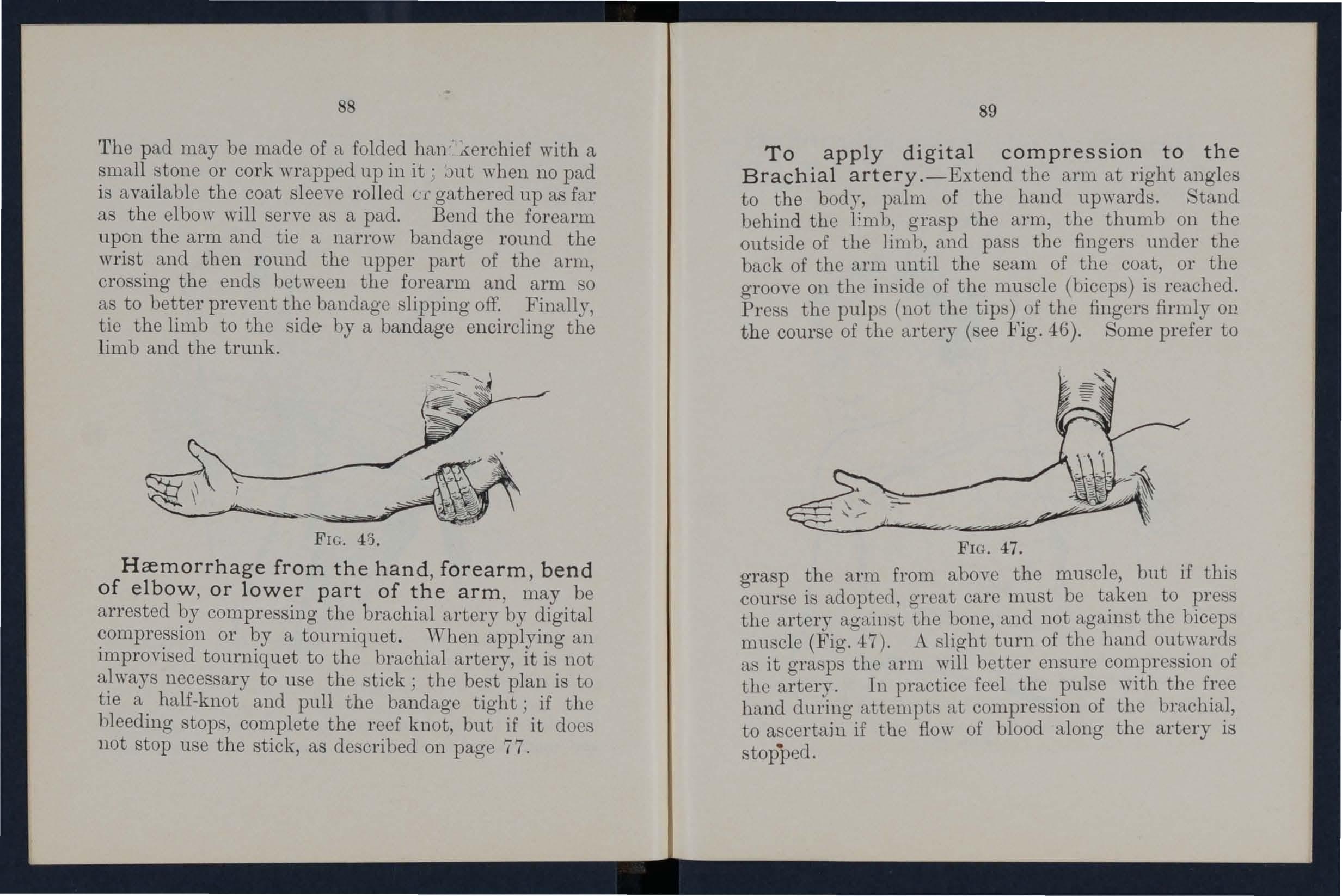
FIG. 43.
Hremorrhage from the hand, forearm, bend of elbow, or lower part of the arm , lllay be arrested by comp r essing the brachial artery by digital compression or by a tourniquet. ·When applying an improvised tourniquet to the brachial artery, it is not al ways necessary to use the stick; the be , t plan is to tie a half-knot and pull the bandage tight; if the bleeding stops, complete the reef knot, but if it doe::; not stop use the stick, as described on page 77.
89
To apply digital compression to the Brachial artery.-E xtend the ann at right angles to the body, palm of the hand upwards. Stand behind the Emh, gra p the arm, the thumb on the outside of the limb, and pass the fingers under the back of the ann until the seam of the coat, or the groove on the inside of the muscle (biceps) is reached. Press the pulp ' (not the tips) of the fingers firmly on the course of the artery (see Fig. -:1:6). SOllle prefer to
FIG. 47.
grasp the arm from aboyo the muscle, bnt if thi course is adopted, groat care must be to the artery aga,illst the bone, and not agamst the blCeps muscle (Fig. 4:7). A slight turn of the hand out:vards as it grasps the ann will better ensure cou:pre SlO11 of tho artery . In practice fool the ,Pulse WIth the hand during attempts :ott compresslOll of tho to ascertain if the flow of blood along the artery IS stopped .
Hccmorrbage from the armpit or arm may be ar rested by compression of the axill ary arter y. Roll up a har d pad the size of a billiard ball in a tr iangular

91 bandage; place the pad in the armpit: cra. s the ba,ndage on the shoulder, pull the cnds tight, and tie off under the opposite armpit, taking care that neithpl' the pad nor l.ms slipped. :'ecnre the injured arm to the patIent's SIde, as shown in Fig. 4:8.
FIG. 49.
Digital compression of the Subclav i an art ery ma'J be made ,yhen the ,,,ound in the main u.rtery is high up in tho arm or in the a r mpit. Procccel as follows :-Bare tho neck to below tho collar hone. place the injured limb close ao·ain. t the side of the patient's body so u.s to depre s the shoulder} and
take your stand opposite the shoulder, use the left hand for the right arte r y, and vice versa.; grasp the neck low down, placing the fingers behmd and the thumb immediately above the centre of the collarbone in the hollow between the muscles attached . to the bone (the bird's nest) ; compress firmly, the thumb deeply downwards and ,t the first rib, which is beneath the clavIcle at thIs spot. (Fig. 4:9 .) In the pulse. may be felt at the same time to ascertam If the flow IS stopped .
' YO"GNDS OF THE LARGE ARTERIES WITHIN THE CHEST OR ABDO MEN.
(INTERNAL HlEMORRHAGE.)
¥,T ounds of the large arteries within the trunk cause hremorrhage into the cavity the chest or of abdomen, and give rise to SIgns and symptoms of internal hremorrhage .
Signs and Syrnptoms o f Internal Hfemo1 'rhage a?·e. :-
A rapid loss of strength; pallor of the face lIps; coldness of the extremities, giddiness and famtness, more especially whe n the upright position is ; the breathing becomes hurr ied and laboured, and .IS accompanied by yawning and sig?ing ; the pulse f?,lls gradually and may altogether dIsappear at the Wl'l.st; the patient throws h is arms about, tugs at the round the neck and calls fo r ail'. Finally, the patIent may becon: e totally unconscious .

T reatment of I nternal H cemon'·h age.-Keep the patient flat; undo all ronnel the n.eck .; provide for free circulatIOn of all'; fan the patIent; sprinkle col d water on the face; apply r:;mellmg alts to the nostrils; give ice to suck 01' cold wiLter to drink. Raise the feet a foot or two from the ground, and bandage the limbs firmly from the feet to hips, and from the hands to the ·houlc1ertl . Avoul stimulants in all ca es of hremorrhage, at all events until bleeding ha been controlled.
The Femoral artery , a continuation of the iliac enters the thio'h in the centre of the fold of the where it be felt pul ating below the skin. The course of the artery may be llldicated by a line drawn from the centre of the groin to the back part of the inner side of knee.. artery occupie8 only the upper t,vo-thlrds of thIS lIne, as at the lower part of the thigh the femoral artery passes to the back of the knee joint under the name of the popliteal.
The Popliteal ar t ery-the artery of the hamoccupies the centre of the space at the back of the knee (the ham). It is placed deeply between the projections of bone at the lo\yer end of the fernur, and is further protected hy the mn cle.' and tendons
94 around the ham. Just below and behind the knee joint the popliteal artery divides into the anterior (front) and posterior (back) tibial arteries.
The Po st er io r Tibial artery passes down the centre of the back of the leg to the inner side of the ankle, where, bebrcen the heel and the lower end of the tibia, it enter' ' the sole of the foot as the Pla n ta r a rt er ies . In the upper part of the leg the posterior tibial <lrtery is deeply placed beneath the muscles of the calf, but towi.1.rds the ankle it comes nearer the surface, and can be felt pulsating in the hollow on the inner side of the ankl e. In the sole of the foot the plantar arteries run for ward amongst the muscles to supply the foot and the toes.
The An t erior Tibial artery comes from the popliteal and at once passes fon-yards between the leg bone . The artery runs clown the front of the leg, cleeply placed a.lllongst the m1.u;cles, to the front of the C\.nkle . A line ell-a wn from the front of the upper end (head) of the fibula. to the centre of the front of the ankle indicates the course of the artery.
The Dorsal a rt ery of the foot is the continuation of the anterior tibial artery: it passes along a line drawn from the middle of the front of the ankle to the interyal between the metatarsal bones of the big toe and the next, \\"here it passes downwards to the sole of the foot, to form an arch \vith the arteries of the sole.
95
ARREST OF ARTEHIAL HlEMORBHAG'l: IN THE LOWER EXTREMITIES.
1. W he n the ar ter ie s i n t h e Sol e or B a ck o f t he Foo t are w ou nde d , remoye the boot and stocking; apply the left thumb firmly on the bleeding point; and, with the right hand, prepare and place a pad on the wound and bandage tightly . An experienced per 'on might be able to further secure the arrest of luclllorrhage Ly means of pad, tightly bandaged, placed on the at the points indicated ill the frontispiece.

],'11' . .")0.
2. When the ar te ri es o f the H am o r of the Leg are wounded , or whe n a pad is i nsufficient t o arr e st h ce morrh ag e f r om the foot or ankle , p lace a pad the size of an orange
behind the knee of the inj ured limb' flex thc leg upon the thigh until the heel almost the ::;eCUl'e the limb in the flexed posItIOn by passmg a narrow bandage (or a strap) round the l eg immediately above the ankle; cross the ·ends between ,the lcg and thigh, and, can-yinl? the?l round the 11mb close to the top of the thIgh, tIe them off firmly. 'When no pad is to be had, roll up the trouser leg as far as the knee, and flex the leg on that as a pad . It is not necessary to take off the to compress the popliteal artery by a pad, fleXIOn. Ex.cept at the lower third of the leg, It IS seldom possIble by direct pressure on the bleeding point to a r rest hffiillorrhage from the arteries of the
3. When the femoral artery In the lower half of its course is wounded , and when a pad and flexion fail to c,ox;trol hreJ?orrhage f rom the popliteal or tl blal artenes , apply digital compression to the femoral at the groin, until a tourniquet can be apph,ed.
To apply D i gital Com}?reSSlOn t.o
Femoral artery at the GrOIn. -Supposmg It IS the right femo r al that is to be compressed, proceed as fo llows :-Lay the patient down flat on .the back; .'tand or kneel as convenient on the left SIde of the patient's body; to fi nd the groin, r aise the h igh so as to flex the thigh on the body (the fold In the clothing at the top of the thigh ,,·ill indicate the
groin); 'Pass the fingers of the right hand over the onter of the right hip just below the edge of the front part of the haunch bone, and lay the fleshy part of the thumb flat on the centre of the groin . Pass the fingers of the left hand to the inneT side of the right thigh close up to the fork, I.mel lay th e left thumb on the top of the right thumb

all't'u.Qy in position over the artery. Prel:)s firmly back\"arel::; against the brim of the pelYis, when the flo\\' of will ?c complctely ancstecl (Fig. 51) As death ie III hiOelllorrhage from so large an artery, it is 1:11:JOl'tant )1nt to waste time remoyi116' the clothing; tnc femoral 8:tery at the groin can in mell be compressed as a temporary measure oyer the clothing.
To apply a Tourniquet to the Femoral a r tery. --In practice it is good plan the course of the artery by clra;\yll1g a Ime flom the centre of the grom t o tbe back part of the inner side of the knee; the artery can be compressed by a tom:niquet any point on the mlddle of the liue thus indicated or a lIttle higher. An improvi ed, a field, or a screw may be used . The pad of t h e improvised tourniq llet should be as large af) half an a narrow hand,l,ge i to be placed with its centre oyer the .LJad, and the knot tied on the Qut::;ide of the thigh; the " stick)) is to be placed between the "hal of knot, '0 as to ayOlc1 injurillg the skin when it twisted. Finany, the "stick" FIG . 52 . is to be " l ocked," and th e limb put in a splint or t ied to its fellow ( Fig. .
4. When the arte r y is wounded In the upper third of the thigh the femo r al must be compressed by the thumb:::; at the g70 m , Il1stead of applying a tourniquet. HeL1.Yl::> of assls t an ts m u st
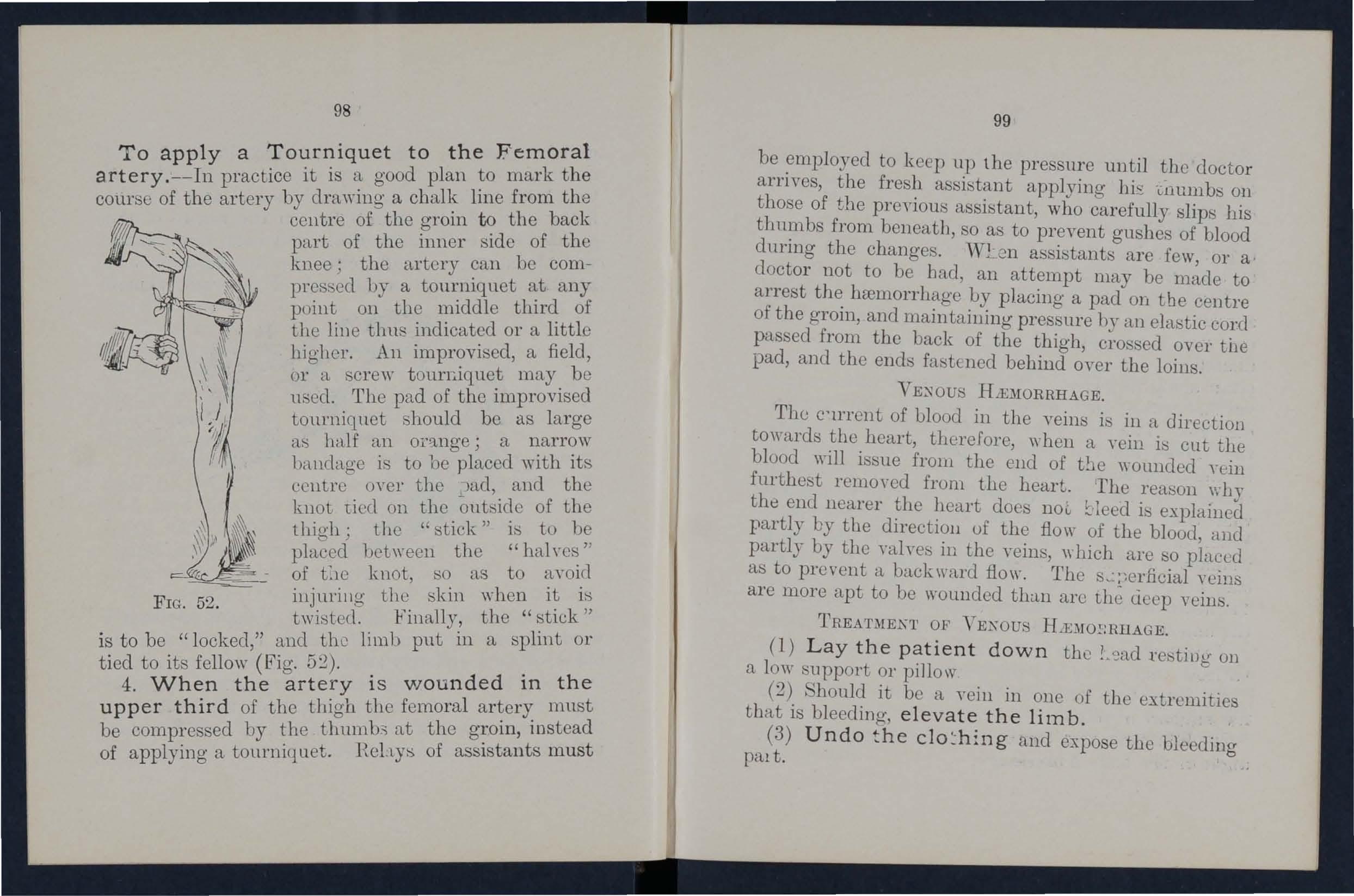
99
be employed to keep up t he pressure until the doctor arrives, the fresh assistant applying hi::: 'cllUlllbs 011 those of the previous assistant, who carefully slips his thumbs from beneath, so as to prevent gushes of blood during the changes. 'V1 en assi::;tants are few, or a doctor not to be bad, an attempt may be made to arrest the hmmorrhage by placing a pad on tbe centre of the groin, and maintaining pressure by an ela::;tic cord passed from tbe back of the thigb, cro sed over tile pad, and tbe ends fa::;tcned behind over the loins.
HiE:illORRHAGE.
The C'UTcmt of blood in the veins i::; in [I, direction towards the heart, therefore, " 'hen a Yeill i::; cut the blood will issue from the end of the wounded yein furthest remoyed from the heart. 'The rea.::;on wIlT thtl end nearer the heart does Ueed is explained partly by the directioll of the fiow of the blood, and partly by the yal yes in the veins, which are so placed as to prevent a backwa.rd fiow . The s...:;.erficial yeins are more apt to be wounded theUl arc the ciccp veins,
(1) Lay the patient down the L,::ad :resting on a lo\\' support or pillow
(2) Should it be a. vein in one of the extremities tha.t is bleeding, elevate the limb.
(3) Undo t he and expose the bleeding palt.

100
(4) A pply direct pressure on the wound by thCil thumo, ;:'-ld maintain the by a pad :1ID.d bi1,lldage.
(5) Should dired pressure prove insufficient, apply a pad and bandage on t he trunk of the vein, on the side of wound furthest from the heart.
Varicose Veins. -The veins of the legs a,re specially apt to become varicose . ,Yh en a Yc1.ricose vein is examined, it will be seen not onl.r to be dilated and tortuou ' , but bead-like (,z;al'icose) projections occur along its couniC. A vein becomes varicosc from various causes, such as long standing, tight garters, etc., etc. The firl:lt effect is to throw extra WGl'k upon the va!Yes, and the bead-like p roj ections are caused by the blood accumulating in the pocket::; behind the val In tim8, channel of the ve in becomes so wide that the valves call no longer span the yessel Whcn one of these dilated veins, say, in the leg, is \rounded or blood flows from the lower end of the cut "Vein, but from the end nearer the heart it flows in llluch larger amoun t, owing to the imperfect of the valv es in the veins.
'I'?'eatm,ent.- WLen hmmorrhage occurs from a varicose vein ill the leg', the treatment is to-
(1) Lay the patient flat, the head resting on :1. low support or pillow.
(2) Elevate the limb . raisiug it high, at a right angle to the body if llece 101
(3) Remove the clothing so as to expose the bleeding part.
(4) Apply direct pressure on the wound by the thumb, and subsequently by a pad and bandage .
(5) Apply bandages , first, on the side of the wound further frem the hen.rt; s':' condly, on the side . the heart, should the c..rect pressure prove ll1S1.rffiClent.
TRE.A.TMEKT OF CAPILLARY H.ElIfORTIHAGE.
See also Treatment of "T ollmls.
To arrest hmmJrrhage from capillaries, a slight ?egree of pressure suffices. Pressure mn.y be applied mstantaneously by the thumb, and maintained subsequently by n. pad or pledget of linen or lint. Pressure may also be exerci::;ed by applying n. piece of strapping (plaster) to the wound oyer a pad. Any medicamen t 'which aid::; in the arre::st of hmmorrhaae is termed a S . b typtIc. Cold, n. cold air or ice, arl'e&t: hmmolThage by contracting the blood yesseli:l. ,Yater as hot n.s can be borne, by causing the blood to clot, may check capillary hccmorrhage.
Such remedic ' as fine strand::; of wool, or cotton wool, con.rsc blotting paper, etc., etc., lmye, if clean) omething to rccommend them. Collodion applied on a fine web of cotton wool i ' an efficient and provides an artificial Q\in, helping to exclude air from the ·wound.
CHAPTER III.
Two systems of nerves, the Cerebro spinal anct the Sympathetic, preside over the moyements and functions of the body.
The system is made up of the Brain, the Spinal Cord, and the N ,;""he Brain is situated within the cranium, and is divided in the middle line, so that, with the exception of a fC\v connecting ba.nds, the righ t a.nd left sides are separate.
The Spinal Cord is the long cord of nervous matter lying within the spinal canal in the bony arch formed by the vertebrre (see Vertebral Colunm). It leaves the brain case through the base of the skull, and reaches as low as the upper lumbar vertebrro.
The Nerves proceed from the brain and spinal cord in pairs j the former are termed the cranial, and the latter the spinal nerves. A pair of spinal nerves emerges between each of the yertebne. The neryes cross the brain about its base, and in the spinal cord, so that the right half of the brain presides over the left half of the body and limbs, and the left half over the right side of the body and limbs. In the limbs and trunk the nerves are met " ' ith as large pearly white trunks, and can be traced to the muscles amI skin When the nones a.r8 torn through there is

103 paralysis of motion and sen ation in the regions in wbic;h they are distributed.
The Sympathetic System of nerves consists of a double chain of nerves and small nelTons masses (termed ganglia ) on either side of the front of the spinal column. The chain extend ., from the h . l se of the skull to the coccyx. 'The nenes of the ympathetic system send branches to all the organs of the chest and abdomen. It is this system that control ' the involuntary muscl es of the body j it regulates all our vital functions as \yell as adjusts the supply of bl00d to th e secreting and excreting 01'FIG. 33.
DIAGRAM snOWI 'G THE BRAIX AXD THE PIXAL CORD, "ITH THE NER,E OF THE LEFT SIDE OF THE BODY.
gans. The sympathetic ystem differs from the cerebo -spinal system, inasmuch as it acts during sleep, and knows no prolonged rest.
IN SENSIBILITY.
Unconsciousness or Insensibility arises when the functions of the brain are in abeyance, either directly from injury or eli ease of the brain itself, or indir ectly from disturbance of the action of the lungs or heart.
GENERAL OF IXSEXSIBILITY.
'YHEK A PERSOX IS FOU:-iD IX A STATE OF L"SEXSTl3ILITY :
1. Arrest hremorrhage, if present.
2. Lay the person on the back, or in the position in which breathing is most easy.
3. Undo all tight clothing round the neck, chest, and waist, lmfastening the braces and top button of the trousers in men, and the corsets in women.
4. Provide for a sufficiency of fresh air by keeping the erowd away if in the street, or by opening the doors and windows if the accident has occurred indoors
5. Obtain a doctor's help at once; a.s <), general rule until he a.rrives keep the head low if the face pale: and raise it if the face is flushed.
6 Never leave the patient until you have placed him in charge of a. person.
N.B. GiYe 11D food or fluids (neither stimulants, tea,

water, nor medicines ) by the mouth while the patient is insensible.
THEK PROCEED TO EXAMINE THE PERSON AS INDICATED BELOW, TO LEARN THE NATURE OF THE IKSE TSTBILITY : -
1. Feel if the pulse beats at the w1'i t (radial artery ), at the temple (temporal artery), or in the neck (carotid artery). The pulse may be or it may be unnaturally slow, quick, or feebl e ; it may miss a beat occasionally (intermittent pulse); or, th e pulse may beat quickly and slowly a.lternately (irregular pulse). All the..;e conditions indicate some mischief wben associated with insensibility. A fecule pulse indicates that the use of stimulants (t:>al volatile, 10 drops in water, or a teaspoonfnl of brandy in a winegla 'sfnl of water) is achisablc, proyided that the patient is able to swall ow. ,Yith a. r::;trong pnhe withhold , timnla.nts.
:2. If the pulse cannot 1e felt place the hand OY C )' the heart, or apply the ear to the chest, to ascertain if the heart beats.
3. Obscryc if the person breathes, and note the odour of the breath. The breathing may be slow, hlJourecl, nccompa.nied l)y 1011<1 . noring and puffing of the check during expiration (l J"ent hing).
4. Examine the calp, temples [In(1 1J:lck of the head for injury; the ea,rs and the no . e for Rign . of
lU6 hremorrhage; and the mout:l for blood, froth, stain::! uy acids, etc., and for foreign bodies .
v 5. Raise the eyelids, and examine the state of the pllpils.
The pupils are the dark round spots in the centre of the blne, bro\',n, or grey iris. Under ordinary conditions in shaded light the pupils dilate; in bright light they cm1tract to sma1l dimensions. In seyeral diseased condition ' the pupils are altered, they may be botk 1cid(:ly dz'lated, or botk minutely contmcted, or, on the other hand, they may be unequal or irregularthat is, one may be 7a?-ge and Ute otker small. Eyeryone of ,' uch altered conditions denotes a serious state. The pupils are said to be fixed when in either a shaded or a bright light no alteration takes place in their size.
6. Examine the body and extremities for signs of fractures, di 'location" wounds-the neck for signs of strangulation or hanging-and compare the two sides of the body as to limpness or helplessness.
7. the temperature of the skin, whether it be natural, hot, or cold. The quickest way of doing this is to place the back of the hand on the naked chest of the patient.
SHOCK (smIETI:MES LEADING TO COLLAPS E FROM INJURY).
After eyery accident of any severity the patient suffers from shock. It is not so much a mental con.
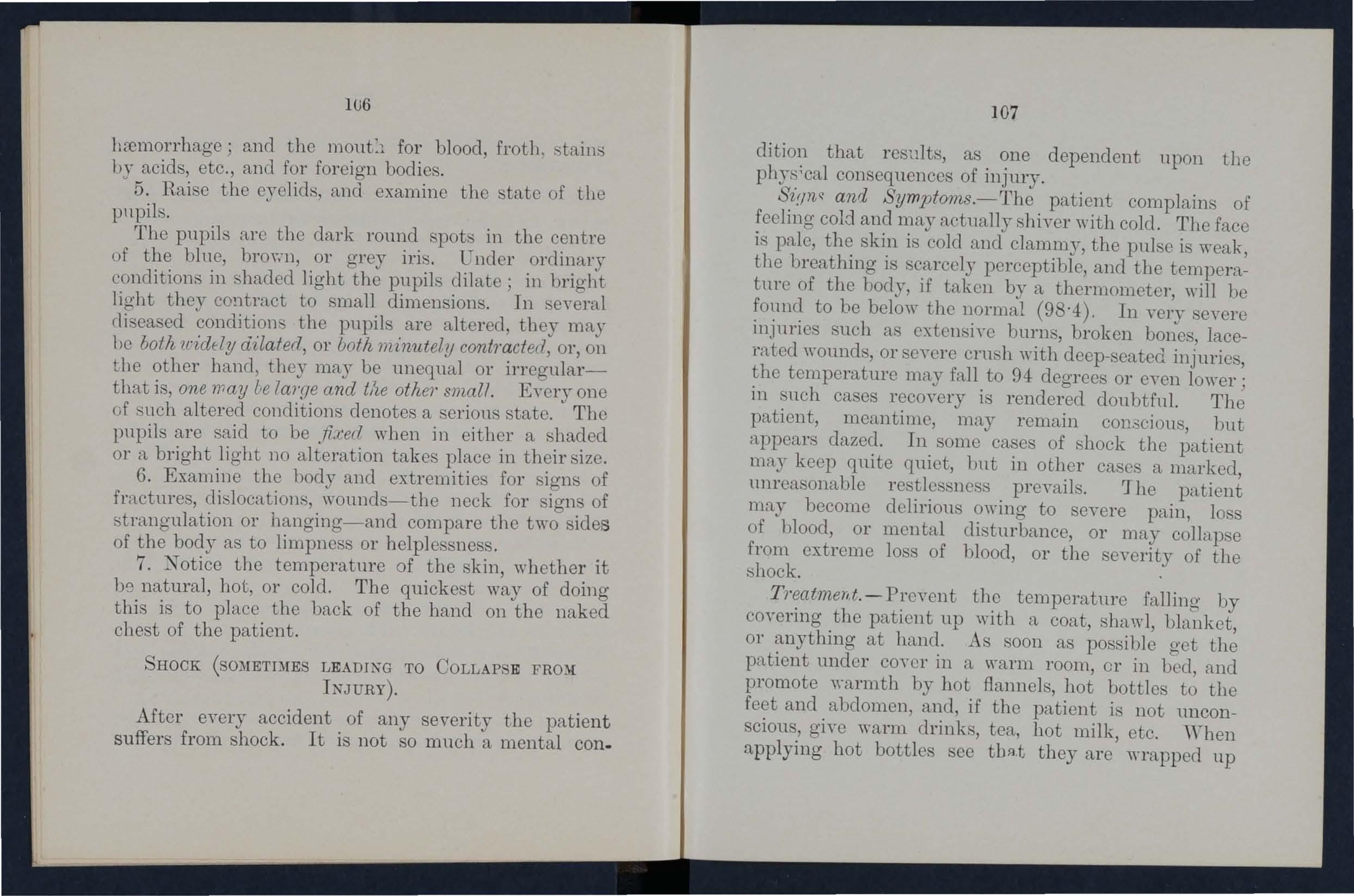
107
clition that results, as one dependent upon the phys;cal consequences of injury.
and Symptoms.-The patient complains of feeling cold and may actually shiyer with cold . The race is pale, the skin is cold and clammy, the pul.·e i weak, the breathing is scarcely perceptible, and the temperature of the body, if taken by a thermometer, will be found to be below the normal (98'4). In yery seyere injuries such as extell 'iye burns, broken bones, lacerated wounds, or seyere crush \"ith deep-seated injuries, the temperature may fall to 94 degrees or eyen lower; in such cases recoyery is rendered doubtful. The patient, meantime, mn,y remain con.:lcions, but appears dazed. In some cases of shock the patient mny keep quite quiet, but in other cases a marked, nnreason(;1,ble restlessness prevails. 'Ihe patient may become delirious owing to seyere pain, loss of blood, or mental disturbance, or may colbp e from extrcme loss of blood, or the seyerity of the :shock.
T7·eatment. - Preycnt the temperature falling by coyering the patient up with a coat, shawl, blanket, or anything at hancl. As soon as po sible get the patient under coyer in a warm 1'00111, or in bcd, and promote ,yarmth by hot flannels, hot bottles to the feet and abdomen, and, if the patient is not unconscious, giye warm chinks, tea, hot milk, etc . ,Yh en applying hot bottles see tb::l.t they are wrapped up
in a piece of fl,lnnd or cloth of some kind to prevent injury to the skin.
OF TilE B!lAI:'>.
'When the cranium i::, struck a se'.-e1'e 1low, or injured during a fall, the brain may be concussedthat i::;, the person may be stunned . There may be no wound of the scalp or injury to the hone, but th e brain is so shaken that for the time being it is functionless or paralysed.
• 'igns anrl - Insensibility, a feeble pulse, shallow bre::l.thing, the pupili'< fixed, <I,nel generally equal in size. Hi::;tory of a fall or a se\'ere blow may be obtn.ined ; or injury to the head may be evidenced by wounds, bruises, etc.
T,eafmenl.-See Apoplexy (page 109).
COMPTIES, OF THE BRAIK.
"\Yhcn from a fnll or blow the eraniulll is frachu ed, and a piece of hone driyen inwards, the brain be compressed. On the other hand, the broken bone may injure a blood-vessel within the cranium, and compression may result from pressure of blood on th E brain. In the former case the insen,' ilJility come on immediately; in the latter, after some minutes. possibly 15 or 20, that is, \.-hen the hlood has accuDulated in sufficient quantity to exer (i.e pre snre 011 the brain.
Si.gns and Symptoms.-Insensibility; evidence of a
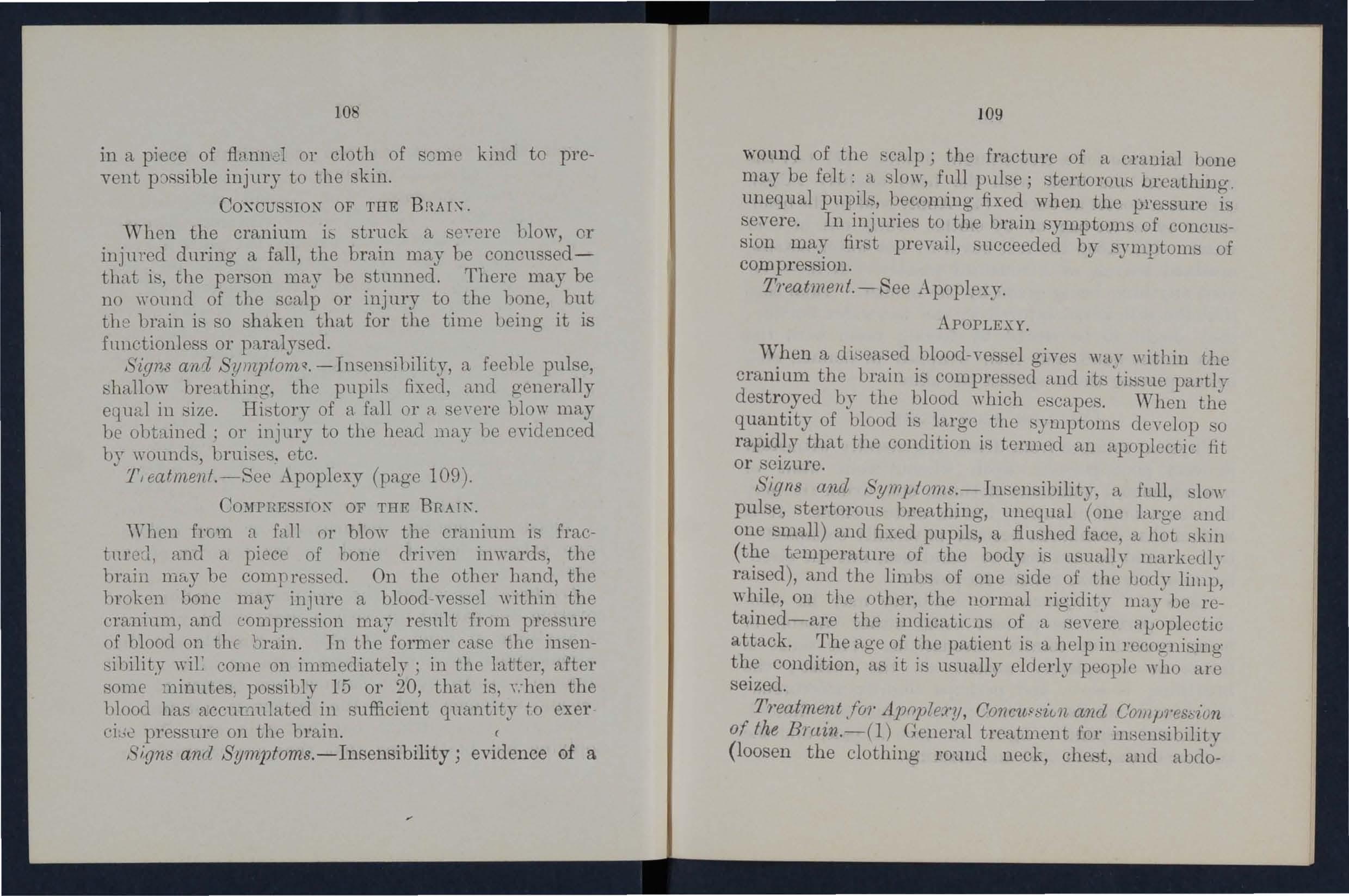
wound of the f'calp; the fracture of a cranial bone may be felt:. it 1::>1 0 \\', pulse; 'tertorou& Lrcathing. unequal b.econung fixed when the pressure is severe. In Il1JlU'leS to the brain symptoms of concussion may fin;t prevail, succeeded by ,'YlllptOlllS of co,mpressioll. -
T1·eatmellt. -See .A poplexy.
'When a di::;eased blood-yessel gives 'va.\' " 'ithin the cranium the brain is cOlllpres 'eel and it, tisr:;uc partly destroyed by the blood '" hich escapes. When the qua.ntity of blood is the s,Ymptolllr:; develop '0 that the COnc.htlOll 18 termed an apoplOdic fit or SClzure.
Signs and SymjJto171c.-Inr:;cnsibility, a full, slow pulse, stertorous breathing, uncqual (one large and Olle small) and fixed pupil, a flushed face, a hot f'kin (the temperature of the body is usually markcdl\' and the limbs of on8 side of the lJOd)' liml;, wl:ule, Oll the other, the llormal rigidity may be retamed-are the inelicaticns of a seycre HlJoplcctic attack. The age of the patient is a help in l'ccoQ,ni1::>ing th.e condition, as it is usually elderly people 'rho are seIzed.
T?'eatment for ApnpleJ'Y, C071C'lM'8 ivn and of the Brain.-(1) General treatment for 'illility (loosen the clothing roulld neck, che't, and abdo-
men; provide for a free draught of air). (2) Lay the' patient on the back with the head slightly raised. (3) Get a doctor at once. (4) Apply cold to the head, either by an ice-bag or by cloths wrung out of cold lYater. (5) Keep the feet warm by hot water bottles, mustard leaves, or a mustard plaster. N.B.-Prevent anything being given by the mouth. Take care th,l,t the skin is not injured by the hot-water bottles; they ought to be tested by feeling them with the back of the hanel, and then wrapped in flannel, etc., before placing them against the skin.
OOLLAPSE FROM DRINK.
Physical collapse from drink is gener;>Jly witnessed in yery poor persons, Llpon whom, from want of nourishment, lsnfficient clothing, etc ., drink (it may be even a small quantity) has an undue effect. It is seldom that drunkards become physically collapsedtheir mental powers may be paralysed, but the circulation of the blood retains its power.
Signs alle[ Sy,nptoms.-In , cmsibility may be complete or partial, the patient being either capa,ble of being roused, or totally unconscic L1S. The pulse is feeble or completely absent a-;' the wrist; the breathing is slow, and perhaps slightly stertorous; the breath smells of drink; the pupils are dilated, equal, and respond to light; the face is pale, and the surface of the cold and clammy.

N.B.-It must not be assumed that a pel' on has collapsed from drink merely because the breath smell.' of drink; frequently, when people arc feelina ill, they take or are given stimulants, after which the; may become insensible, not from the drink but from the cause which induced them to take it, e.g., apoplexy coming on, effects of poi Olllng, etc., etc.
T1'eatmerzt.-(I) Gener,).1 treatmeM for in 'cnsibility (loosen clothing, proyide free of ail', plu.ce in position in Ivhich breathing i:::; possiblc), (2) Keep thc patient 'rarm by coycring him over or taking him indoors, and applying hot-water bottles and friction to the surface, lUore especially to the limb8. (3) 'When the patient can Lo ro).;sed o'iyc warm tea or coffee. (4 ,1 When the pul 'e i:::; give an emetic of a dessert-spoonful of mustard in a tumblcrful of luke-warm water. ( 5) When the emetic has effectcd its purpose, support the patient's strength by giving tea, beef tea, brandy in small quantity, or by an}' of the prepared foods, [Oups, or es 'ences.
The apoplectic state and collapse from drink are not nnfrequently mistaken the oue for the The more prominent means of diEtingni::lhing thClll are as follows :-
1. In apoplexY' the patient is usually getting on 1Il years; collapse Trom drink may occur in a per 011 or any age.
2. The of the of drink wOllld indicate apoplexy. '.
3. Pupils gonerally unequal. and 111 apoplexy) equal and responding to lIght III collapse from drink. .
4. The pul::;e at the wrist in IS usually ::;trong and full; in collapse from drlllk It IS feeble or altogether
5. The features in apoplexy are usually congested. ..tnd suffused.; in collapse from drink they are pale pinched. . '.
6. Should means of ascertamlllg the tem1?eratllle be at hand it will be found in apoplexy conslderably above, and in collapse from drink considerably below the normal (98'4).
EPILEPSY.
disease is frequently ternled the " falling sickness." It occurs in persons of 3.ny age, but most frequently it is seen in young; a.dults. It is a ':orm of "fit," and as It occ':lrs with but little if any warning, the seizure may take place by night or day, at in the at public medings., in a. publIc conveyance-lll fact, anywhere. OWlllg to ltt) sudden de:velopment the patient may incur serious daD ... _, espeCIally when the attack comes on near a fir6, machmery, a steep bank or precipice, or where traffic is great.

Sig??,sandSympt07ns.-Sometimes with, but gencrally without, a scream the paticnt falls to the ground, insensible . . The muscles of the body are in a state of spasm, so that thc fcatures are distortcd, and the hands are tightly clenched with the thumbs inwards. Yery quickly, the rigid spasm by ,vhich all these parts hayc been fixed is exchanged for a state of con vul&ion, during which the face, limbs and body are violently
The eyes may squint, the pupils are equal, dilated and fixed. The face at first pale, becomes dusky, and froth frequcntly appears at the mouth and occa ionally at the nostrils. The tongue is apt to be bitten, and "when it is the froth from the mouth may be tinged with 1>loor1.
The duration cf an epileptic fit is uncertain; it may continue for but a minute or two, or for five to fifteen minutes. "Vhcn the fit ceases the patient may recoyer completely> may fall into a deep sleep, 01' may have a succession of similar fits.
Treatment.-(l) General treatment for ins en 'ibility (loosen clothing, allow frcc circulation of ail', attend to position) . (2) Prevent the patient from hurting himself as he fall::; and after he has fallen. (3) During the fit drag him away from a wall, heavy piece of furniture, or other source of da.nger not el'lRily moyed; push lighter fnrniture out of the way. (4) Kneel down beside the patient and support his head. (5) \Vrap a piece of wood or any hard material (handle
Ot pocket knife, india,rnbber, pencil, etc.) in handkerchief, and hold it between the teeth to prevent the tongue being bitten. N.B. The movement of the limbs must be restrained, but not altogether prevented or completely as the spasms the muscles might be torn. GIve nothmg by the (6) After the fit see thn,t the patient is cared for by frIends, 01' conyeyed to shelter, and allowed to rest and sleep. (SYNCOPE).
Causes.-A close or crowded room, tight clothing, fright, sudden bad news, fatigue, want of food, 10s8 of blood, heart failure, etc.
Sig ns and Symptoms-Pallor, feeling of a feeble pulse, shallow breathl11g, blurred VISIOn, followed by insensibility more 01' less complete.
T?· eatmen t.-(l) General treatment of .insensibility (loosen clothing, provide circulation of all', attend to position) . (2) Lay the patient down flat on the floor, Oll a couch, or on the ground, or, if possible, as when the patient is on a form, let the head drop over the edge Ot the form a little below the level of the body. (3) Haise the feet a little. Get as much ail' to play on the patient as possible by creating a draught, 1.?y fanning, etc. (4) Smelling salts to nostrIls will aiel recovery. (5) ,Vhen sensIblhty IS restored remoye the patient into the open air, but should recovery be delayed for several minutes after the flat
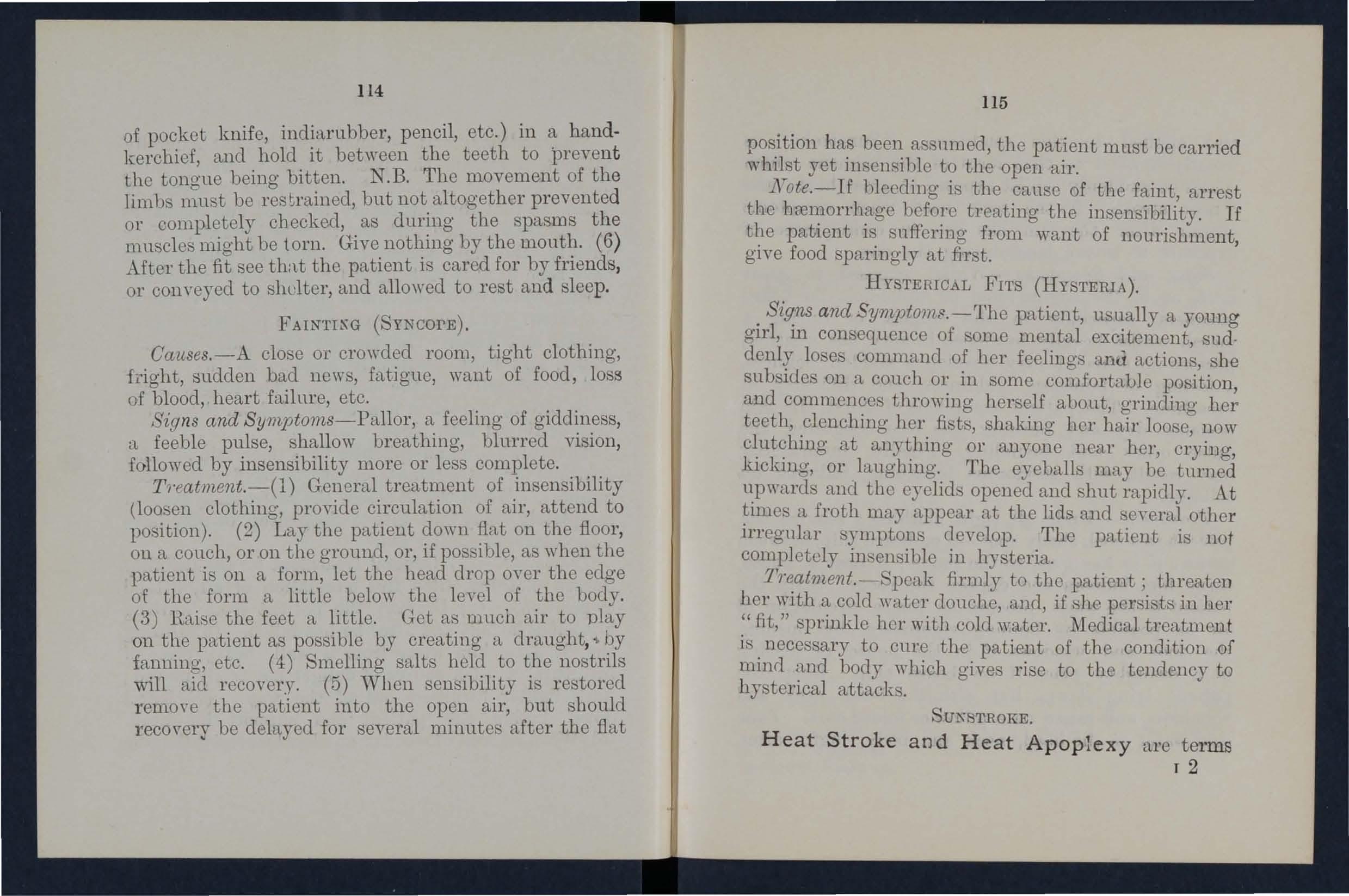
115
position has been assnmed, the patient mnst bo carried whilst yet insensible to the open ail'.
.No te.-If bleeding is the cause of the faint, arrest the bremorrhage befo1'o trcating the insensibility. If the patient is suffering from want of nourishment, give food sparingly at first.
HYSTERICAL FITS (HYSTERIA).
Signs and SyrnptoJn3.-The patient, usually a yOlmg girl, in consequence of somo mental excitement, suddenly loses command of her feeling.· and actions, she subsides on a couch or in some comfortable position, and commences thrmYing herself about, grinding her teeth, clenching her fists, shaking her hail' loose, now clutching at anything or anyone near her, crying, kicking, or laughing. The eyeballs may be turned upwards ancl the eyelids opened and shut rapidly. At times a froth may appeal' at the lids and 'everal other incglllar syll1ptons develop. The paticnt is not completely il1'ensible in hysteria.
T1'ealment.-Spcak firmly to the patient; threaten her with a cold "'n.ter douche, and, if she persists in her "fit," sprinkle hoI' with cold ,vater. Medical treatment is necessary to cure the patient of the condition of mind and body which gives rise to the tendency to hysterical attacks.
SUNSTROKE.
Heat Stroke and Heat Apoplexy are terms r 2
also applied to this condition. "Sunstroke" is usually applied to that form of the ailment which com0S on suddenly whilst exposed to great heat; and "heat stroke" is the term used when symptoms appear after the sun has set, ill conse<;.'lOnce of exposure to severe heat during the day.
Signs and Symptoms.- ,Vhilst exposed to great heat, as in the engine-room or stoke-hole on board steamers, especially in the tropics, or during a march whilst heavily burdened in very hot weather, persons so situated may develop a sudden sickness, a feeling of faintness, giddines, and difficulty in breathing. The patient complains of thirst, the skin becomes dry and burning, the face congested, the pulse quick and bounding. Finally, insensibility may result, with stertorous breathing, followed by collapse.
T,.eatment. -Undo all tight clothing; remove the patient to a cool, shady spot-if on board ship, betweon decks; if in the open, to the shade; if near a house, carry him indoors and darken the room. Strip the patient to the waist, procure as free a circulation of air as possible by fanning vigorously, by opening the door and windows if in the house, or placing in a draughty place if on board ship. Keep the patient lying down, but with the head, neck and shoulders well raised on a pillow or folded coat. Pour cold water on the head, neck and body, jugful after

jugful, until consciou ness returns. .An. ice-bag to the head and spine or cold ,vater should be continued for some hours. The patIent may have cold water to drink when conscious, bnt no stimulant.
Through contact with an electric cable, wire, or other electric medium the shock may be so severe as to cause insensibility, and the sufferer will be unable to extricate himself . Immediate steps must be taken to remove him from contact, but an attempt to do this is attended with risk, as anyone touching the sufl'e 7"er without proper precautions is liable to receIve a shock. The risk can how eyer be matenally reduced, if not entirely obviated, by ava,iling oneself ?f the safeguards which are apparent to possessmg an elementary knowledge of the laws ",hlOh govern an electric current. Some bodies, known as "conductors," are particularly suited for the of electricity and are instantly seized, when poss:ble, by a current as its path. As instances of such bodIes may be mentioned iron brass, water or moisture, and one's , , " own body. Other bodies, called" non-conductors or " insulators," resist the curren t, and amongst these are indiarubber, glass, dry silk, dry cloth, dry wood and dry hay or straw. An electric CLllTent always chooses the
* This article has been kindly revised by Mr: S. B. Cottrell, Engineer and General Manager of the LIverpool 'i)verhead Railway.
11 8
b est conductor and the shortest way to the earth, bnt it will not pass into a body, no matter how good a conductor that body may be, if its egress is prevented by an insulator through which the current cannot pass.
No doubt the simplest way to free a sufferer from contact with an electric CUlTent woulrl be to s"\vitch off the current, but this cour.se "ould often be quite impossible, and even if possible, so mnch inconvenience and perhaps danger to the lives of other::; might arise that some other usually to be adopted.
,Vhenliberating the::mff'erer from contact remember1st. Do not touch with naked hands the sufferer or his clothing if it is clcunp . 2nd. Keep yourself insulitted from the cable or apparatus, from the sufferer, and from the earth as weU. 3rd. Although indiarubber is probably the best insulator do not 'vaste time in runnillg for indiarubbcr gloves or mat, but use dry articles of clothing; an indiarubber tobacco pouch or pouches, or cap, would serve to protect the hands in an emergency.
To d£vert the cU1-reni j rmn the sllffe1·er.-HaYing insulated your o",vn hands and bony, get an iron rod or any other form of conductor that lllay be at hand, and connecting one end to the earth and the other end "ith the cable or whatever may be the medium of the current; or if the sufferer is obtaining the shock from two cabl es or conductors neither of which is

" earthed" place the rod in connection with both and the current will then be diverted from him. If the sufferer is not rel eased by the above means insulate your own person by stru1ding on a dry board,. dry clothing, a bundle of dry hay or straw,. glass, bncks, slates or an indiarubber mat or sheetmg. -, "Protect your hands by placing as many thicknesses a possibl e of dry clothing between them and the sufferer, endeavour to raise and insulate him from contact wlth the earth and the conductor. ,Yhen the sufT'rrer is insulated the current ceases to pass through him. The cable may then be withdrawn, but care must be taken in withdrawing tbe cable that the persoll sadoino', himself remains insulated, otherwise he "'ill a shock. \Yhen the sufferer is removed from contact :-
l. Apply the general treatm.ent (loosen clothing, procure free cll'culatlOn of all' and place in a reclining position) .
2. Dip a towel in cold water and attempt to arvuse him by sharply flicking the face and chest.
3. Commence artificial respiration if other methods fail to restore animation. (C Laborde's» method. (see page 142) has been found to be vcry succe -fuI.
4. 'Treat burns, if there are any (see page 1
EFFECTS OF LlGHTl\Il\G.
A p er son struck by lightning is usuall y more or less
.([epriyed of consciousness. The treatment is the same that electric shock, except, of course, that the II1.strnctlOl13 for removing the patient from contact wIth the electric medium do not apply.
COXVULSroNS IN CarLDREN.
Teething or troubles are the commonest c[\,U::le::l of conyulsions in infants.
Sir;na and Symptom '.-Spasm of the muscles of the ll.mbs and lividity of the face, insensibility, Occi:1.slOn1.11y squmtmg, suspended respiration, and frequently froth at the mouth.
Treatment.-Put the child in a warm bath about the normal tempemture of the body (98 degrees Fahr.), that the water reaches as high as the middle of the trunk; [\,nd place a sponge dipped in cold water on the top of the head.
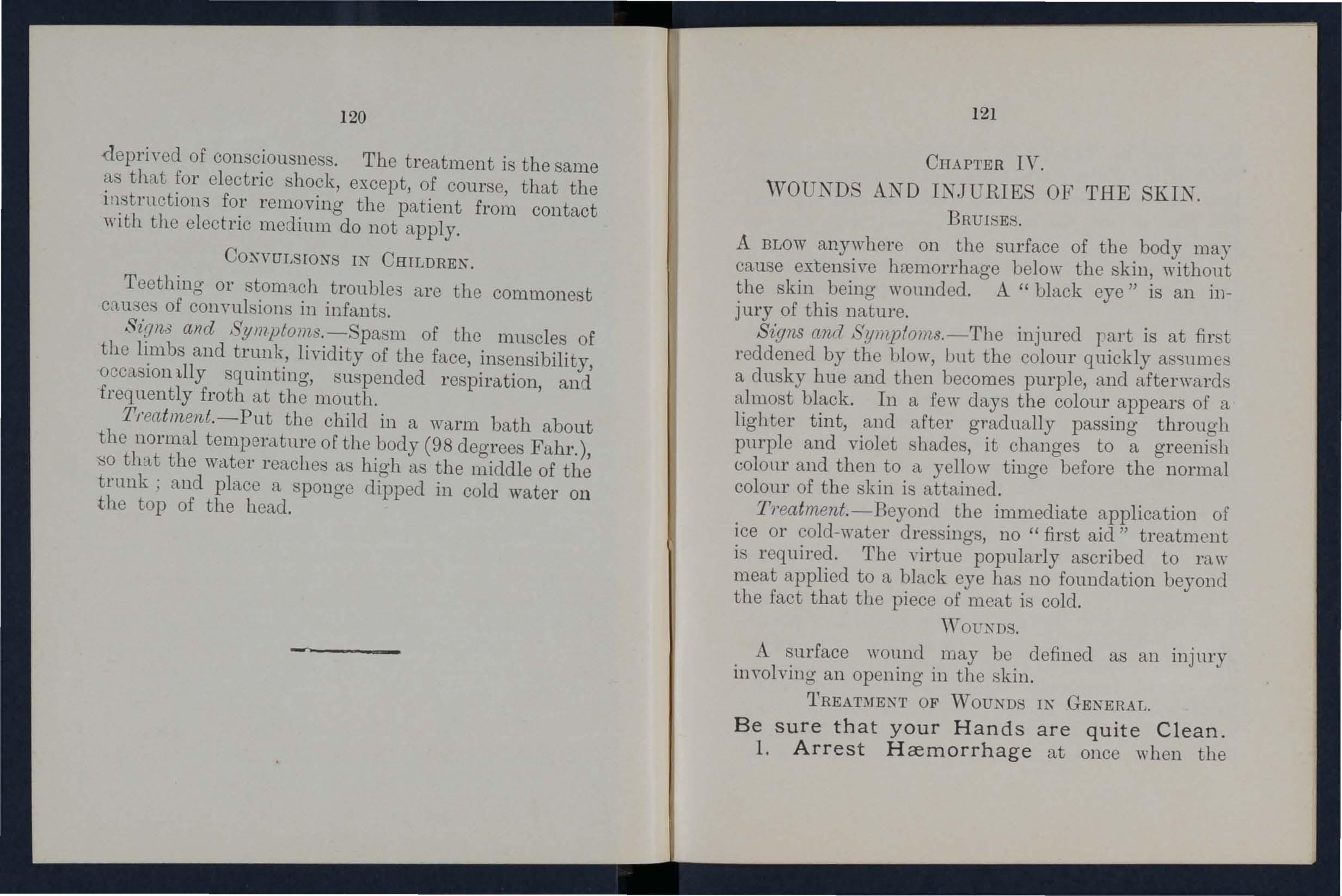
121
CIIAPTER IV.
WOUND AND INJURIES OF THE SKIN. BRUISES.
A BLOW anywhere on the surface of the body may cause extensive hrnmorrhage below the skin, ·without the skin being wounded. A" black eye" is an injury of this nature.
Signs anrl Symptoms.-The injured part is at first reddened by the blow, but the colour quickly as<;ume a dusky hue and then becomes purple, and afterwards almost black. In a few days the colour appears of a lighter tint, and after gradually passing through purple and violet shades, it changes to a greenish 00lonr and then to a yellow tinge before the normal colour of the skin is attained.
Treatment.-Beyond the immediate application of ice or cold-w'ater dres ings, no" first aid" treatment is required. The yirtue popularly ascribed to r[\, \y meat applied to a black eye has no foundation beyond the fact that the piece of meat is cold.
'Y omms.
A surface wound may be defined as an injury inyolving an opening in the skin.
OF VVOUNDS I' GENERAL. Be sure that your Hands are quite Clean.
1. Arrest Hcemorrhage at once when the
122 source can be ascertaiued. 'Yhen internal hromor l'hage is suspected the measures to be adopt.Jd are:Rest, free circulation of air, loosening clothing, and free uso of ice to suck; an ice-bag may al::;o be applied externally in the neighbourhood of the wound.
2. Cleanse and DreSS the Wound-(A.) TVhen Olbt-of-dooI'3 it is but seldom that appropriate means of cleaning a wound are at hane1. (a) If no water is l1.t hand, and but one clean handkerchief is to be had, wi the wound, if it is dirty, with a cornel' of the bandker, chief, t!len fold the handkerchief and tie it oyer the wound. If the handkerchief is soaed apply a piece of clean (unprinted) pJ.per, as the inside of an envelope, on the won.nd ) and tie a handkerchief, necktie, or brace over It (b) If clean water is near by, and the wound is dirty, but not otherwise, wash the wound freely, dip (or wash if necessary) the handkerchief in the water and apply over the wound.
(B.) When in-eloora the wound with water that has been boiled and allo\ycd to cool. To the water might be added, in the following proportions if at hand, a few crystals of permangann.te of potash to a half-tumbler of water; boracic-acid (a teaspoonful of the powder to a half-tumblerful of " 'ater) : 01' any of the disinfectant lotions ill common 11.'e..... The parts..b (lTO'U7ul the wounn. are to be cleallsed by washing with soap and water. Wben the part has been dried, absolute eleanliness will be ensured by

123
mopping the skin around the wound with spirits of wine or 'with whisky. Dress the 1co'lmcl.-TLc wound may now be dressed by one of the following methods: -(a) .A piece of dry lint, linen, or calico of several thicknesses, and bandaged. (b) The dressing may be soaked in ,Yater: boiled and cooled, or in allY of the antiseptic lotions, or in Friars balsam. (c) Cotton wool, lint, or gauze (medicated) may app1ied wet or dry, next the wound, instead of the above dressing, or applied over the dressing. (d) Antiseptic powder, such as boracic acid, may be dusted oyer the wound, and then covered ,yith lint oj' cotton wool and bandaged. N.B.-Carbolic acid, although yalllable as an antiseptic, on account of many accidents haviDg occurred in recent years through its misapplication is not a safe lotion to be kept in the home as a dressing for wounds. Yesscls containing carbolic acid lotion .'honld not be left about.
The cleanliness of dressings of lint, coUon '\\001, 01' gauze can be guaranteed only after they hale been subjected to great heat. This can be accomplif:ihed by placing the quantity to be used in a closed tin in a hot oven for half an hour. It is adyisable not to touch clean dressings with the hand, but "ith cleem forcep , pincers, sugm tongs, &c.
'Vhen the blood has crusted over a "'ound do not disturb it unless the wound is known to be dirty.
3. Rest. The wounded part, when dressed, should be kept quiet by splints, slings, or by rest in bed.
"\YOUNDS AND THEIR SPECIAL TREATMENT.
The treatment of wounds in general applies to these wound :-
Wounds.-\Yhen the skin is cut by a kl1lfe, a 'p1ece of or other sharp instrument, the wound IS termed lllCIsed. The edges are clean cut and the wound gapes.
The edges a large incised wound may be held together! after It has. been cleansed, by narrow strips ?f adhesIve plaster laId across the wound with a slight mterval between each strip.
Punctured wound caused by the stab of a kmfe, dagger, bayonet, etc., is termed .punctured. The wound is usually small, rounded, 01' Jagged, and driven inwards by the weapon. The danger ansmg from the injury depends upon the .situation of the wound, or the depth to which the mstrument has penetrated.
wounds must not be probed. Foreign bodIes 111 wounds, when hidden from view, are not to be searched for by probing, they are to be left till the doctor arrives: (See also Intern11 Hmmorrhage.)
. Lacerated a part of the body IS .torn off by machinery, by the bite or claw of an u,lllmal, by an artillery shell. etc., a lacerated wound
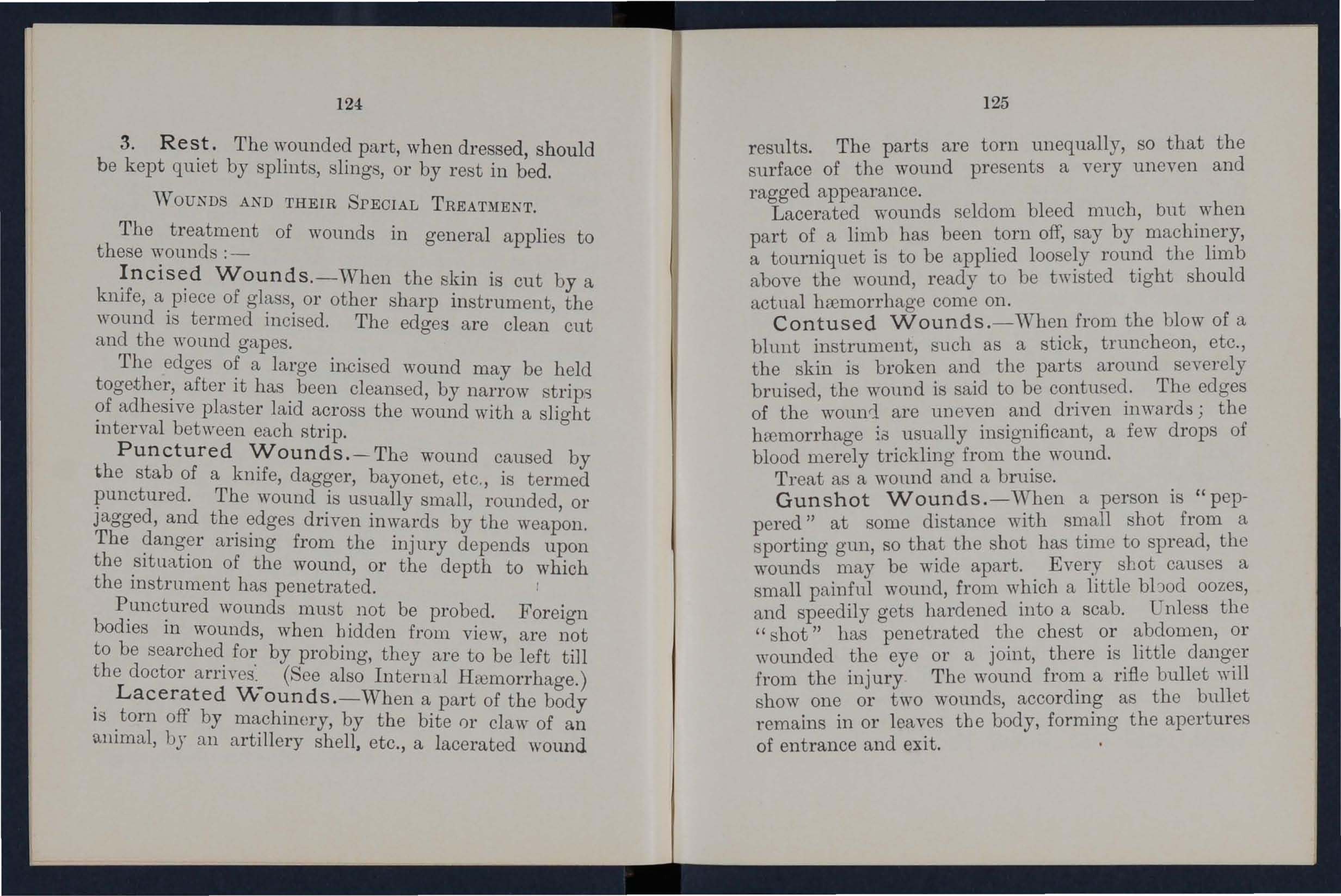
125
results. The parts are torn unequally, so that the surface of the wound presents a very uneven and ragged appearance.
Lacerated wounds seldom bleed much, but when part of a limb has been torn off, say by a tourniquet is to be applied loosely round the 11mb above the wound, ready to be twisted tight should actual hremorrhage come on.
Contused Wounds. -\Yhen from the blow of a blunt instrument, such as a stick, truncheon, etc., the skin is broken and the parts arolmd severely bruised the wound is said to be contused. The edges of the 'wounrl are uneven and driven inwards) the hreffiorl'hage ia usually insignificant, a few drops of blood merely trickling from the wound.
Treat as a wound and a bruise.
Gunshot Wounds.-\Vh en a person is "peppered" at some distance with shot from a sporting gun, so that the shot has tim e to spread, the wounds may be wide apart. Every shot causes a small painful wound, from which a little bhod oozes, and speedily gets hardened into a scab. Unless the " shot" has penetrated the chest or abdomen, or wounded the eye or a joint, there is. little from the injury Th e wound from a nfle bullet wIll show one or two wounds, according as the bullet remains in or leaves the body, forming the apertures of entrance and exit.
Gunshot wOlllnds are to be oovered over by lint gauze, or cotton wool (medicated), if either is to be had, or if not, by some other clean dressing. When the surfa,ce of the body has been "peppered" by a number of small shots, do not attempt to remove them, ?ut wrap the parts wounded (a whole limb it may be)
III a sheet 01' towel wrung out of h ot or cold whichever is the more comfortable. '
Poisoned Wounds.-Wounds may be poisoned at the time of the injury, or may become so afterward::; by the nature of the discharges. Under this headinO' :rught be the bites of animals, the stings of Insects, the pOlsoned w01.mds caused bJ native weapons purposely poisoned by some drug, etc. j these will be considered in detail later. 'Vhen wounds become poisoned by neglect, surroundings, etc., they are saId to be" sept10," The word septic means putrid, and antiseptic materials and substances are tl:R.t pr event a wound becoming putrid or septIC: WIth the treatment of these eonditions "first aid" has little to do, but all that is possible to prevent a w01.md becoming septic when it is first seen should be attempted.
) ') For see .Bites, Stings, etc.
. When a JOint IS wounded, say by a bullet or other foreign body, or by a stab, the part is to be up in cotton wool and the limb put in a splmt. The limb should be maintained in the

position best calculated to prevent gaping of the "vonnel.
When a needle breaks off after pcnetratilw the skin and disappears, take the patient to a at once. If the wound iH near a joint keep the joint at rest on a splint. When a fish-hook is embedded in the skin, do not attempt to withdraw it hy retractionthat is, by the \\ay it went in-but cut off the "dressing" of the hook, so that only the metal is left, and then force the point thr;ugh the sk in, making the hook to trayel onwards until it can U8 withdrawn.
During exposure to seyere cold, parts 01 tne body, usually the feet, fingers, nose, or eaTS, lose sen,'ation, and become first "U\,xy ",hite, and then congested and of a purple appearance. Sensation heing lost in the part, it is often only by the bystanders drawing attention to the alteration in colo ur of the ear, nos e, etc, that the frost-bitten per 'on is made a-ware of the fact.
Treatment.-Do not bring the pati ent into a warm room until by friction by the hand, or by rubbing with soft snow, the sensation and circulation in the frostbitten parts are restored. Neglect of this precantion may lead to death of the tissues affected _ 'Yhen ?irculation is restored the patient ought to be kept III a room at a temperature at 60 deg. Fahr.
BURNS AND SCALDS.
A burn is caused by dry heat, sl1ch as flames, hot metals, etc.; a scald is caused by moist heat, such as boiling water, hot oil, tar, etc.
Signs and Symptoms.- The effect of on the body may be a mere reddenillg of the skm; If more severe it may cause blebs or cc blister " form. \Yh en the burn is very severe, the deeper tl ' '1.1es of the limbs or trunk may be charred and blackened. The clothing may adhere to the burned ren:lering it impossible to separate them. The ImmedIate danaer to life is SHOCK, caused by the extent of to the skin; the more remote. dangers exhaustion, severe reaotionary inflammatlOn, defo rmIty from scars, etc.
.
TJ'eatm,ent.-(l) The clothing over the Injured part must be carefully. removed. If I:tuck to the r::kin, the adherent clothmg m1.1 -t be cut aroLlnd with scissors and left to come away subsoq L1ently. If the foot is scalded, the boot n:ust be carefully removed, undoing the lace and cuttmg the ba.ck seam of the boot, so that the boot may fall off instead of being pulled off'; the stocking must also be cut all along, so that it falls away from the scalded part. It is the duty of the by:::tanders to prepare the dressing while the clothing is being removed.
(2) I!I1mediately cover up the wound from

the air. ( (a) 'When the skin is merely reddened th&air may be "excluded by dusting it with flour, whiting, powdered chalk, &c. The part is then to be covered by a thick layer of cotton wool, lightly bandaged and maintained in the most comfortable position possible. (b) When blisters are formed, or when the surface is charred, soak or smear pieces of lint or linen, with olive, salad, linseed, almond, or cod-liver oils, or with vaseline, lanoline, or cold cream. Carron oil, a favourite remedy, is made by mixing equal parts of linseed oil and lime water j olive oil may be used instead of the linseed oil. When the burnt surface is extensive, do not cover thepart with one large sheet of lint, but with strips about the breadth of the hand j this is advisabl€1 as, during subsequent dressings, one strip can be removed at a time and a fresh dressing applied before the adjacent strip is taken off. The shock tathe system is thereby less than would be the case were the whole of the burnt surface laid bare to the a.ir by removal of all the dressing at one time. When covered by the oily dressing, envelop the part in cotton wool, or if that cannot be obtained, with a piece of flannel. When the face is burnt, cut a c, mask" for the face cut of lint or linen, leaving holes for the eyes, the r0se, and the mouth. Dip the mask in the oil or vaseline, apply it to the face, and cover over with cotton wool, leaYing apertures for thS' R
130 eyes, nose and mouth. ,Yhen the hand or foot is burnt or scalded, warm "\"ater - that is, water at the temperat-tU'e oT tne Jedy (98'-1) is at hand, pbce the injured limb in the water until suitH.hle dressings can be got; and if a dessert- pooninl of lJaking soda (bicarbonate of soda) be added to a ba. 'inful of the warm water, a soothing alkaline lotion prepared. Do Hot prick the blebs or bli tel's; lern"e that to the doctor to do if he think::; it right.
(3) Treat Shock.-The se'"ere shock, which accompanies every burn of any siz e, l1lLl t be dealt with by applying "warmth to the of tho body generally, and by \Tiug warm chinks. (See Shock.) Be very apprehensive of t he clanger of even slight burns of the neck.
When a Woman's Dress catches fire, proas follows :-Lay the per. on flat on the floor at once. Place her so that the flames are uppermo ·t ; that is to say, if the front of the dress is on fire, lay her on her back, and if the back of the dres::; is on fire, place her faoe downwards . ., The reason for this po 'ition is readily understood when it is remembered that flames ascend vertically; so that if the upright position is a sumed, the flani. es quickly ascend and envelop the body, neck, and face; or if the person is thrown down with the flames und ermost, they will, if unextinguished, pass oyer and burn the limb and set fire to the rest of the dress. As soon as the per

son is placed flat, smother the flames with anything at hand, such as a rug, coat, blanket, table coyer, etc. If made wet so much the better. A ,yoman rendering assistance, should hold a rug or blanket in front of herself when approaching the flames. If a woman's dress catch fire when no one is by, she should lie flat, flames uppermost, smother the flames with anything handy, as a table-coyer, mat, &c., and call for assistance; on no account should she rush into the open air.
Vitriol is frequelJi1y u 'ed as a weapon for deadly injury. If it is dashed in the face it is a yery serious matter. If it, touches the eye it would generally mean 10. s of sight; whateyer part of the skill is touched by the acid is furrowed and burnt.
Tnatment.-Carefully wash all the yitriol possible from the skin, by squeezing a sponge dipped in tepid ,rater, to which some washing or baking soda has been added, allowing the water to run gently oyer the injured part, then treat as an ordinary burn.
Hydrophobia is caused by the bite of an animal suffering from rabies. Seyeral animals, such as dogs, cats, foxes, \'\oh' e. deer, &c., become rabid. The poison is contained in the animal's saliYa, and I1H\'y he cOllyeyed on the teeth henea th the skin and I{ 'J
]32 thus into the blood of human being's. vVhen the bite is through the clothil1g there is lcs8 dallgCl' of hydrophobia, as the mli"a is wiped off the teeth 1y the clothing. It is therefore by \yay of the exposed parts (the hands and face) that the poison usua11y enters the body.
Treatment.-In case of a bite by a dog or other an imal, do not 10. e time in the attempt to asCel'taill whether the animal has or has not rabies, but proceed immediately as fo110'\'s :-( 1) Prevent the yellOUS blood from carrying the poisun through the body by immediately placing a cOllstl'ic tion bet\\' een the wound and the heart. Suppose, for example, a finger is bitten, it should 1e encircled above the seat of the 1itc (that is, on the side of the wound nearest the heart) with the fore-finger and thumb. As soon R,S possible place a ligature (that is, a. string, a piece of tape, a strip of handkerchief, etc.) tightly round the root of the finger; do not ceas e to com pre s y:ith the finger and thumb until th e ligature has been applied. (2) Suck the wound vigorously, provided that your lips are sound, spitting out the saliva; or (3) wash in water water by preference, as it encourages bleeding). (4) As soon as possible the wound should be burned by a fluid caustic, such as caustic potash, pure carbolic acid, nitric acid, or if these are not at hand, by a red-hot wire, fusee, etc. It is not sufficient to apply a solid caustic, such as lunar
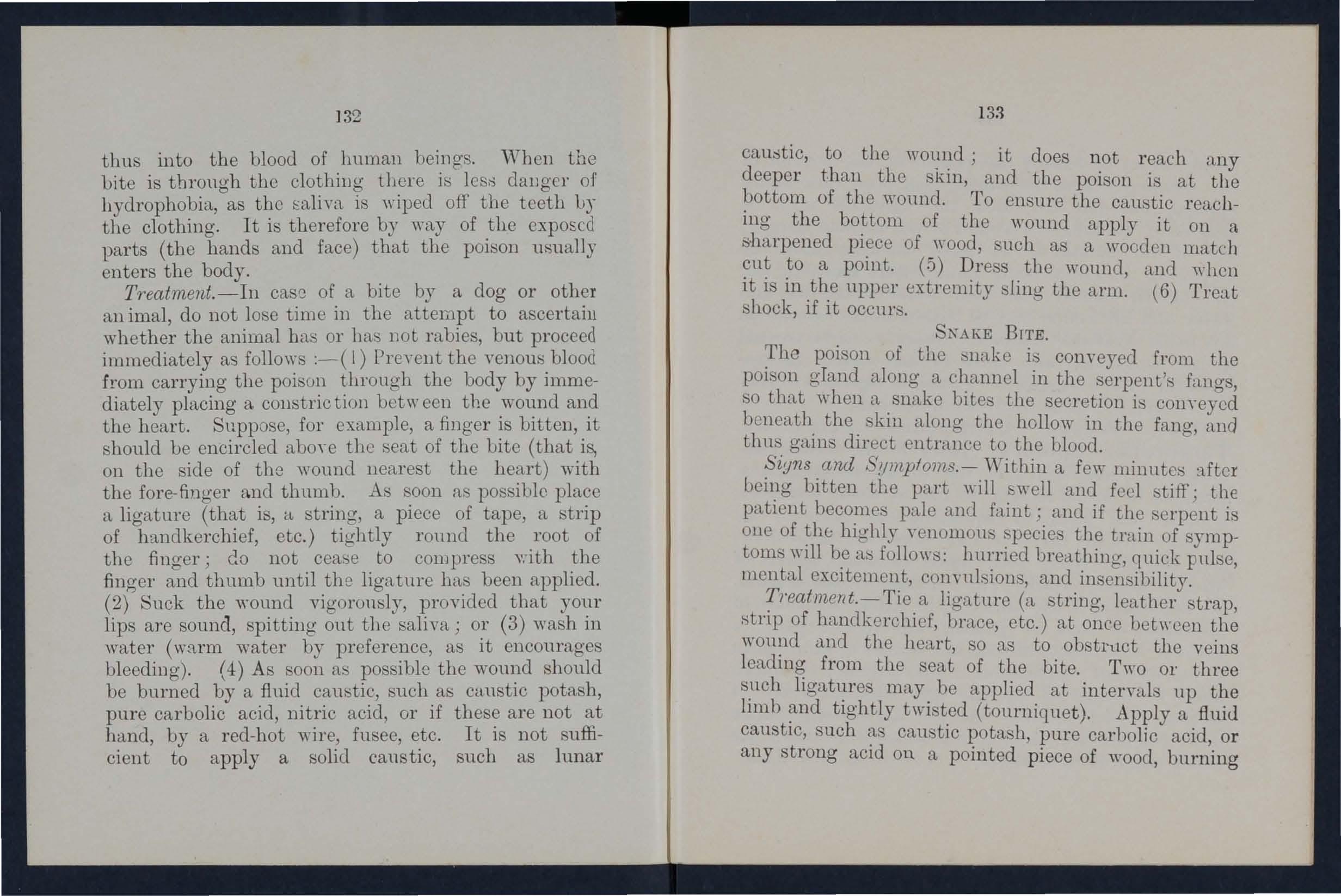
13:{
cau::;tic, to the it does not reach any deeper t·hall the S1\:111, and the poison is at the ?ottom of the wound. To ensure the caustic reachlllg the of the wound apply it on a ;:;harpened pIece of wood, 'uch as a wo oden match a point. (5) Dress the wound, and when It IS 111 upp er extremity sling the arm. (6) shock, If It occurs.
:r he poison of the blln,1\.e i::; com' eyed from the pOlson gland along a in the serpent's fangs, so that when a .snake bi tes the secretion is conveyed beneath. the. skm along the hollow in the fang, and tIm::; galll du ect entrance to the blood.
Si[Jns and S!lmpfo?ns.- 'Within a fe\, minutes ::tfter being bitten the part will s,,-e11 and feel stiff· the patient pale and faint; and if the is one of hIghly yenumou ' • pecie the train of symptom WIll b.e a::; follo,,'S: lnu.'ried breathing, quick pulse, mental convnlslOlls, and insensibility.
!reatment_- TIe. a lig<'ltul'e (a string, leather strap, stnp of handk ercillef, brace, etc_) at once between the wou:ld and the heart, so [)'s to obstl'l.lct the "eins lcadmg from the seat of the bite. Two 01' three s.uch may. be applied at intermls up the Illnb tIghtly tWIst,ed (tourniquet). Apply a fluid caustlc, cau ' tIC potash, pure carbolic acid, or any strong aCld on. a pointed piece of ,yood, burning
deeply so as to destroy the poison at the bottom of the wound. When the caustic has been thoroughly applied, but not till then, the ligatures may be removed. Sucking the 'YOlU1d is not without danger, but if no caustic is at hand sucking must be employed, the saliva being immediately spat out, and the mouth washed out with water or spirits and water, and the wound may be burned 'with a fusee or in any other available manner. Shock is to be treated in the usual way, ano. spirit of sal Tolatilc (a teaspoonful in a wincglass of 'Yfltel') , or spirits (whisky or brandy), are to be freely administered . Bees, Wasps, Centipedes, Scorpions, Tarantulas, Spiders, Jelly-Fish , HarvestBugs, etc., may each give rise to severe symptoms, attended by actual dc1.ngep to life in some instances. Remoye the sting by squeezing the part, or by pressure with the barrel of a key ,,,hen that is po 'sible; mop the part freely with liquid ammonia, spirits of wine, or brandy, whisky, etc. ; if these are not at hand, the application of the blue-bag, or strong solutions of carbonate of soda or potash, will relieve pain; a paste of bicarbonate of soda and spirits of sal volatile is an efficient application, The patient's strength must be supported by the free administration of alcohol or sal volatile. As the harvest-bug buries itself beneath the kin, it is necessary to have the insect removed by a doctnr.
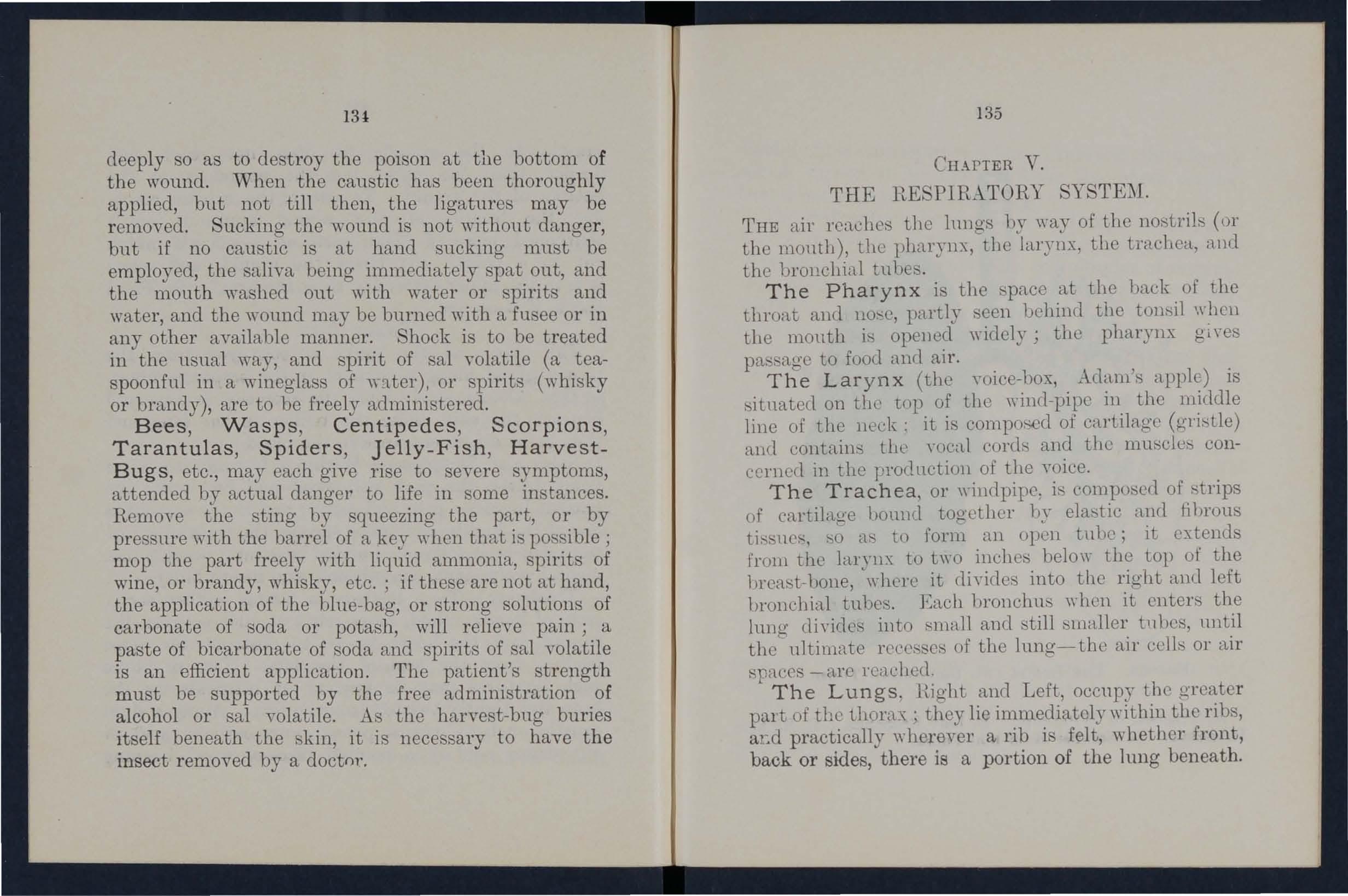
135 CHArTER V.
THE HESPIRATORY SYSTEM,
THE ail' reaches the lungs hy way of the n08trihl (or the mouth), the pharynx, the larynx, the tracllca, and the bronchial tul)es.
The Pharynx is the 8pace at the lxwk of the throa.t and 1l0!-'C, partly seen bchind the tOll!';il the mouth i8 opelled ,"idely; the pharynx gi \' es pal';, age to food and air.
The Larynx (the yoice-box, Adam's appl) is situated on the top of tho \\ incl-pipc in the middle line of the neck; it is compo:-;.cd of cartilage (gTiHtle) and contains tlll\ YO(5,1,l corel ,' and the concerncd in tho production of the yoice.
The Trachea, 01' \\illclpipo. is composed of ,- trips of cartilage hound together by ela::;tic and fihrous tis,-ue!';, ,0 as to form an open tuhc; it extends from the brYllx to t\yO indlcs belo\\' the top of the In'oa::;t-bolle, 'where it cliyide, into the right anel left 1>1'01H.:h1<11 tuhes . Each hronchu::; \\'hen it cnters the Imw cliyic1cs i11to Hlllall and -till i:illlaller tll hcs, until th/'ultimate reGe,-ses of the lung-the ail' cells or <til' spaGes - arc 1'0,1(; heel. <-
The Lungs. Hight and Left, occupy tho greater part of the thorax; they lie immediately within thc ribs, ar.d practically wherever a rib is felt, whether front, back or sides, there is a portion of the lung beneath.
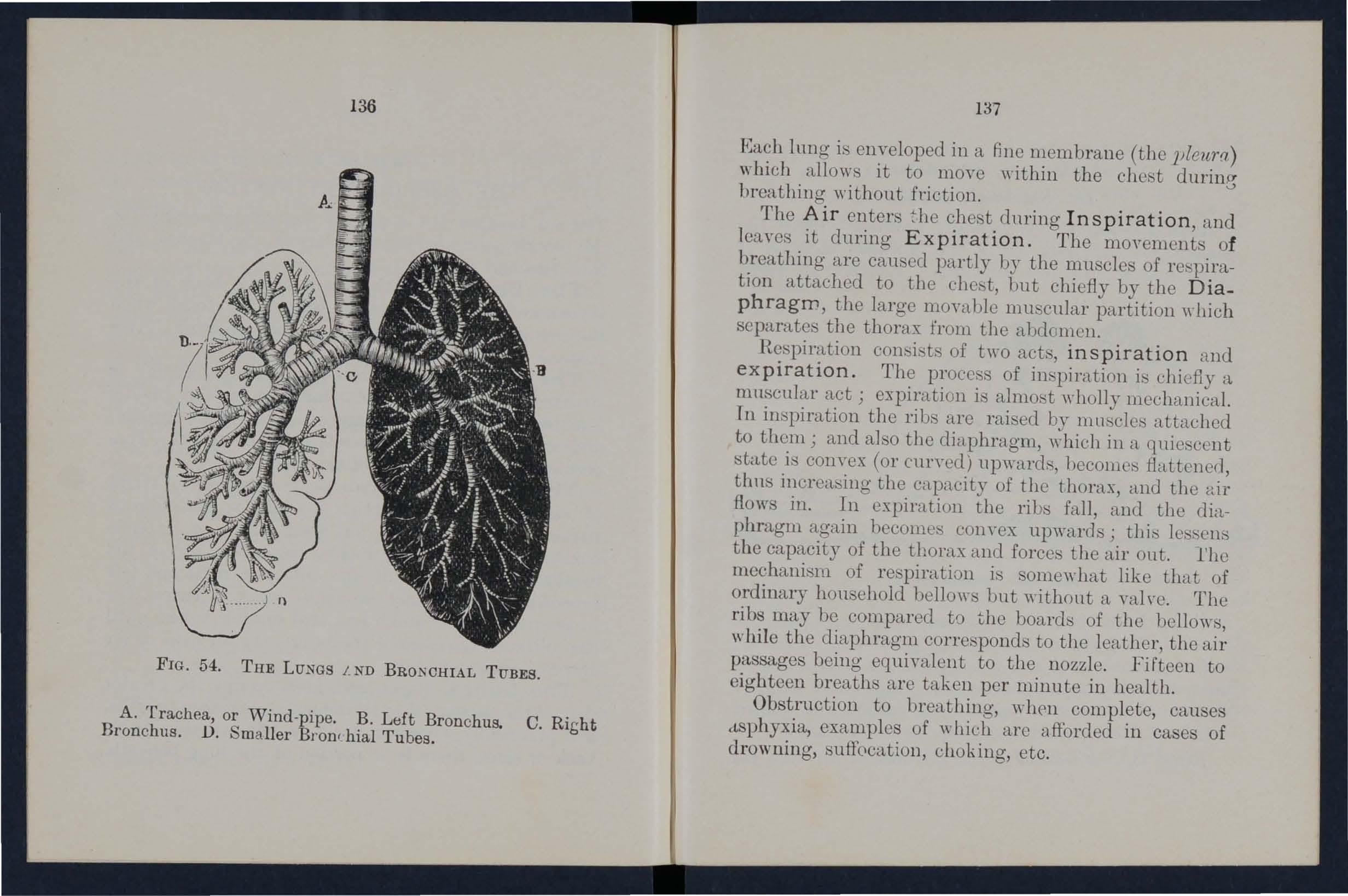
Ea.ch lung i:::; enveloped in a fine membrane (the plenrl'f) which allows it to move "within the che,'t dllrine breathing "without friction.
The A ir enters chest dnring Inspiration, and Ic£wes it during Expiration. The movemcnt:::; of breathing are cau 'cd partly by the muscles of re 'pirabon attached to the che t, but chiefly by the Diaphragm, the large movable mu 'cular partition ,,-hich separates the thorax from the ahdomen.
Respiration con 'i ,ts of two acts, inspiration a nd expiration. The process of in 'piration i:::; chi efly C1. mnscuJar act; expirati on is almo,' t wholly mcchanical. III in:::;piration the ribs are rai 'ed by mLl cle:::; attached to them; and also the diaphragm, which in a quiescent :::;tate is convex (or eUlTcd) upwards, become:::; flattcn ed, thns incren,:::;ing the capacity of the thorax, and the air flows in. In expiration the ribs fall, and the diaphragm again become' com-ex upwards; this lessells the capacity of the tborax amI forces the air out. 1'he mechani ' 111 of respirati on is some,yhat like that of ordinary household bellow:::; hut without a vah·e. The ribs may be compared to the board:::; of the bellows, while the diaphragm cOlTesponds to the leather, the air passages being equivalent to the nozzle. Fifteen to eighteen breaths are taken pcr minute in health.
Obstruction to breathing, IV Iwn complete, cau es cLsphyxia, examples of which are afforded in cases of drowning, suffocation, clioking, etc.
138
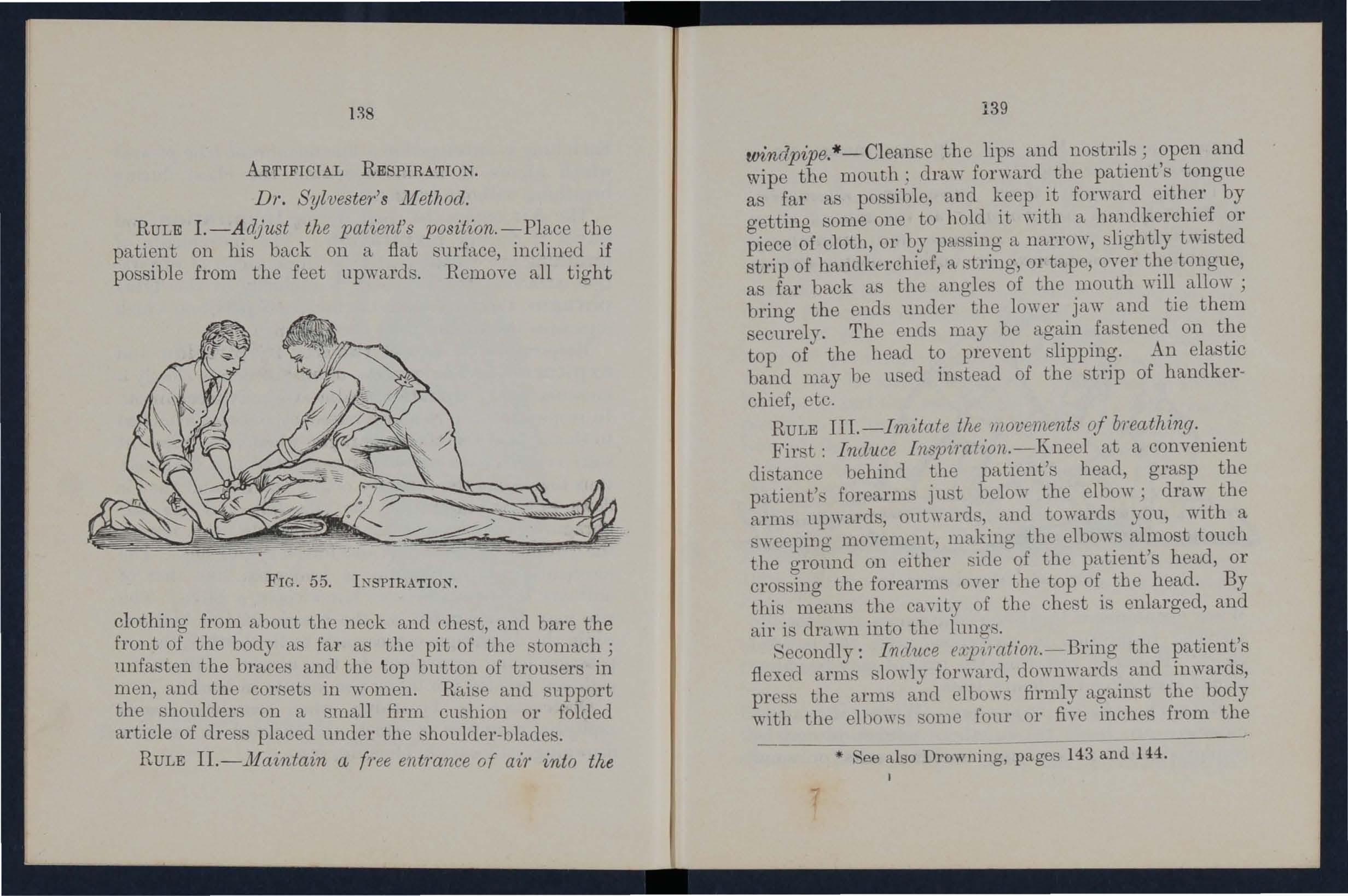
ARTIFICIAL RESPIRATION.
Dr. Sylvester's 1.1fethod.
RULE I.-Acijust the patient's position.-Place tbe patient on his back on a flat surface inclined if possible from the feet upwards. all tight FIG. 55.
from about the neck and chest, and bare the front of the body as far as the pit of the stomach; unfasten the braces and the top button of trousers in men, and the corsets in women. Raise and support the. shoulders on a small firm cu ,'hion or folded artIcle of dress placed under the shoulder-blades.
RULE II.-Jlfaintain a fr ee entrance of ai1' into the
139
wintlpipe.*-Cleanse the lip.' and nostrils; open and wipe the mouth; draw forward the patient's tongue as far as possible, and keep it forward either by getting some one to hold it with a handkerchief or piece of cloth, or by pa .. ing a nano\", slightly twisted strip of handkerchief, a string, or tape, oyer the tongue, as far back as the angles of the mouth will allow; bring the ends under the lower jaw and tie them securely. The ends may be again fa tened on the top of the head to preyent slipping, An elastic band may be used instead of the strip of handkerchief, etc.
RULE III.-Imitcde the IllOv ements of breathing. Fir t: Induce InRpiratt'on.-Kneel at a convenient distance behind the patient's head, grasp the patient" forearm ' jUHt below the elbow; draw the arm up'Yttrds, o"utwards, and toward you, with a sweeping movement, making the elbo\ys almost touch the ground on either ",ide of the patient's head, or crossing the forearms oyer the top of th e head. By this means the cayity of the chest i, enlarged, and air is drawn into the lung.
Secondly: e,l:pl·ratiol1.-Bring the patient's flexed arms slowly fonnu'd, dmYllWards and inwards, pre s the arms and elbows firmly again t the body with the elhows ,ome four or fiye inches from the---
* , ee also Drowning, pages 143 and 114. I
LJreast bone Fig. 56). By mean::; aIr is expelled from the lungs.
Thirdly: Repeat these movement, alternately, (l eliberately, and at the rate of about fifteen time' a minute. Continue until spontaneous breathing is 0 1' until a doctor arri,es. FlG. 56. EXPIRATION.
When spontaneous breathing commences, regulate the artificial r espiration to correspond ,vi tIl the natural effort. Hopes of restoring the patient may be entertctined even after two hours' time.
RULE IV.-EJ:cite l'eSpiTatz'on . - ,Yh ilst the above measures are being tak"l1, other u efnl steps may he employed, such as applying meIling salts or slluff

141
to the nostril, amI da,shing hot and cold water alternately oyer the head and neck.
RULE Y.-lntlu"e r'irCJfla l ion and warmth afte l' natural breathing has been restored. ,y rap the pn,tient in dry blankl:ts or other covering, and rub the limbs energetically towards the heart. Promote warmth by hot flannels, hot-water bottles, or hot bricks (wrapped ill flannel) applied to the feet, to the limbs and body. ,Yh cn the power of swallowing has returned giye sips of hot water, tea or coffee, or of wine, brandy and water, etc. The patient should be kept in bed [tnd encouraged to go to sleep. Large poultioes or fomentation applied to the front and back of the chest ,,,ill sene to assist breathing .
' Yatch the patient carefully for some time to see th[tt the breathing does not fail; should any signs of fn.ilure appeal ' , at once begin artificial respiration.
lluward's Ll1etlwx .-'l'his method is especialiy applicable to casea when the patient's a rm is broken. Deal with the clothing and tongue, etc., as described Imdcl' the ylvester method.
Tm'n the patient on the back. Place a roll of clothing beneath the body, so as to rai. e the region of the stomach above the level of any other part of the boely. Pla.ce the patient's hands above his head. Kneel astride the patient's hips, and with the balls of the thumbs resting on either side of the pit of the stomach, let the fingers grasp the adjacent part of
142
the chest. using the knees a pivot, throw all yo:rr weIght forward on your hands, and at the tIlne squeeze the waist between them as if you wIshed to force everything in the chest upward toward the mouth; deepon the pressure while YOU count slowly 1, 2, 3; then suddenly let U go a which you back to your kneelmg posItIOn. Remam erect 011 your knees whil.e you can count 1, 2, 3. Then repeat the same motIOns as before, at a rate gradually increased from 4 or 5 to 15 times in a minute, and continue the with regularity. Induce circu lation and warmth III the manner d escribed under Rnle V Sylvester's method. .,
''Yh en a number of assistants are present, Howard's and Sylvester's methods may be combined the pressure on the chest being made simultaneously:
When from any cause, as fractured ribs, neither of the abo\'e methods can be carried out Lau o1 'de's of artificial re "piration should be tried. It is espeCIally useful in suffocated children. It is carried out as follow :-The patient is placed on his back' the cleared; tongue is seized-u.'ing handkerchIef or sometlung to prevent it slipping from fingers--the lower jaw depressed; the tongue pulled forward and held for two seconds in that pOSitIOn, then allowed to recede into the mouth. ThesE.' movements should be a.bout fifteen

143 times a minute. After treatment is the same as in Sylvester's and HO'ward's methods.
Persons completely immersed ill water for even ten or fifteen minntes have been restored by artificial means. If, therefore, the hody i · recovered within a reasonable time, flbsence of signs of life is not to deter immediate attempts to restore animation.
Drowning persons attempt to hreathe \yhilst submerged, and, in water i ' inhaled into their air pa sages and they become asphyxiated and insensible. The first thing to do when the body is recovered IS to get rid of the water and froth obstructing the air pa 'sages, and then to artificially restore breathing. This it) best accompli 'hed by loosening the clothing and opening the mouth, Hnd cleHring both it and the back of the throat. 'rhe p p. tient should then he turnod face dO\Yll\Y<lrds, \yith a pad below tho and with the forehead upon the right forearm. ,\Yhilst in this position apply pre 'sure by the hands to the patient't) back oyer the lowor rills, and keep the pressure np for three seconds. Turn the patient on tho right side, maintaining that position al '0 for three seconds.
Hepeat these movements alternately, as long as froth and 'rater issue from the mouth. Thc,'e operation ' in themselYe tend to promote re piration, hut it is usual, when the n,ir passages are clear of froth
144
and \Yater, to adopt Sylvester's or one of the other methods of artificial respiration alrcady described. While performing these operations send someone to the nearest house to procure blankets anrl dry clothing, hot-water bottles, etc., and to fetch a doctor.
8TRAXGULATIOX.
Owing to con t:!:iction of the wiudpipe by a cord, a rope, or tightened necktie, etc., round the neck, the breathing mn,y be arrested and asphyxia caused.
-Cut the constricting band and commence artificial respiration.
CHOKING.
'Yh en a foreign body, as a coin or piece of meat obstruds the air pas a,ge, suffocation may ensue.
-Open the mouth, forcibly if need be; pas the forefinger right to the back of the throat and attempt to dislodge the obstructing body; if vomiting re 'nIts from this 'tep so much the better. If un , uccessful, thump the back hard between the should ers whilst the head is bent forward, 'Vhen the foreign body is removed, but breathing is suspended, commence artificial respiration.
Grasp the lower limbs and raise the body to take the tension off the rop e. Cut the rope, free the neck, and commence artificial respiration.
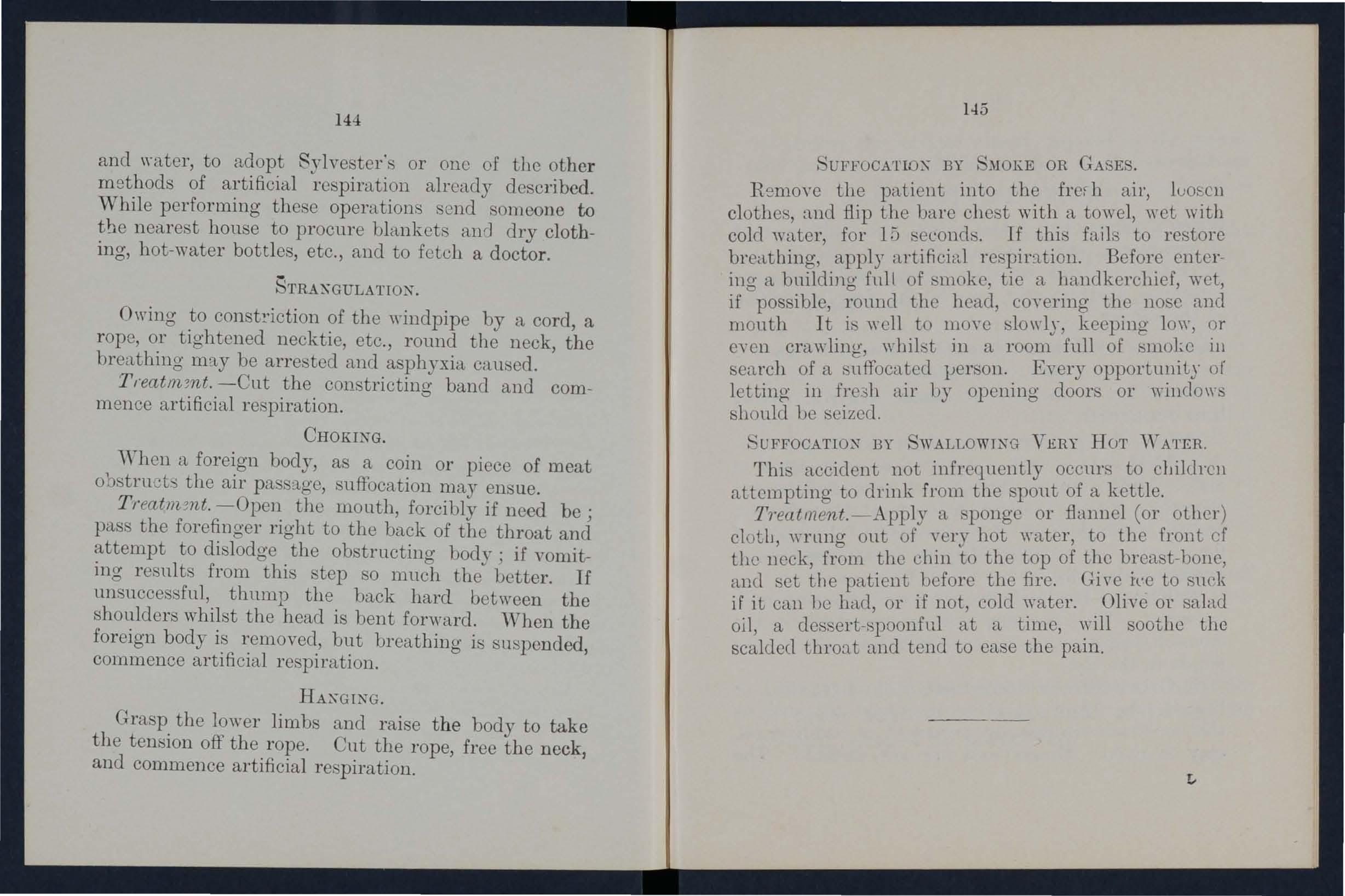
145
SUFFOCATlOX BY S)lOKE OR GASES.
R eIDOye the patient into the frer hail', 1U0 1::C 11 clothes, :1nd flip the bare chest ·with a towel, wet with cold water, for 15 setonds. If thi::) fails to restore brcc\'thing, apply artificin.l respir::ttion. Before cutcr· ing a building full of ::)1110ke, tie a l:wlldkerchief, wet, if possible, round the head, coyermg tb.c nose and mouth It is ,,'ell to moye slowly, keepmg.' low, or eyen crtnrlin u', whilst in a room full of B1lloLe ill search of a 1Jer::)on. Eyery opportunity or letting in fre311 air by opening doors or ,Yllldo\ys should be eize(1.
BY WALLOWING VERY HOT "rATER.
This accident not infrequently occnrs to cllilllrcll attcmpting to drink from the pout of a kettle.
T7·eatment. - Apply a ,'ponge or flannel (or other) cl Otil, lYl'llng out of very hot ,rater, to the front cf th e neck from the chin to the top of the breast-bolle, ancl set the patient before the fire. Gi ,'e h'e to ,' nell: if it can l)c hetel, or if not, cold water. Olive or salad oil, a dessert-t) poonful at a time, ,:·ill soothe the scaldecl throat and tend to case the pam.
CHAPTER VI.
WHEN a person has taken poison, the sudden onset of symptoms, their appearance soon after havinO' taken food or drink, or aftor havino' swallowed substance inadvertently, may be first intimation of the danger.
SUlI-mARY OF SIMPLE DLRECTWNS FOR THE TREATMENT OF POISONfNG.
Send for a doctor at once, stating what has occurred.
Whe.n the p3.tient is not insensible, give :-
.1. i safe to give copiou' draughts of mIlk .. Mllk, when swallowed, clots or coagulates, and pOlson may be thereby enclosed in the milk clot, and the whole got rid of hy an emetic. Cream and beaten up together may be given as well as or mstead of the milk.
2. Eggs.-Beat up a couple of raw eggs with milk or water. The raw egg sets or coagulates in the stomach, and as in the case of milk may include the poison in the clot .
. 3. Oils.-Give se\Teral spoonfuls of oliYe, sala,d, 01' Imseed oils Any vegetable 01' animal oil, such as that in which sardines are preserved 01' cod-liver oil, may be given. Mineral oils are not suitable . The
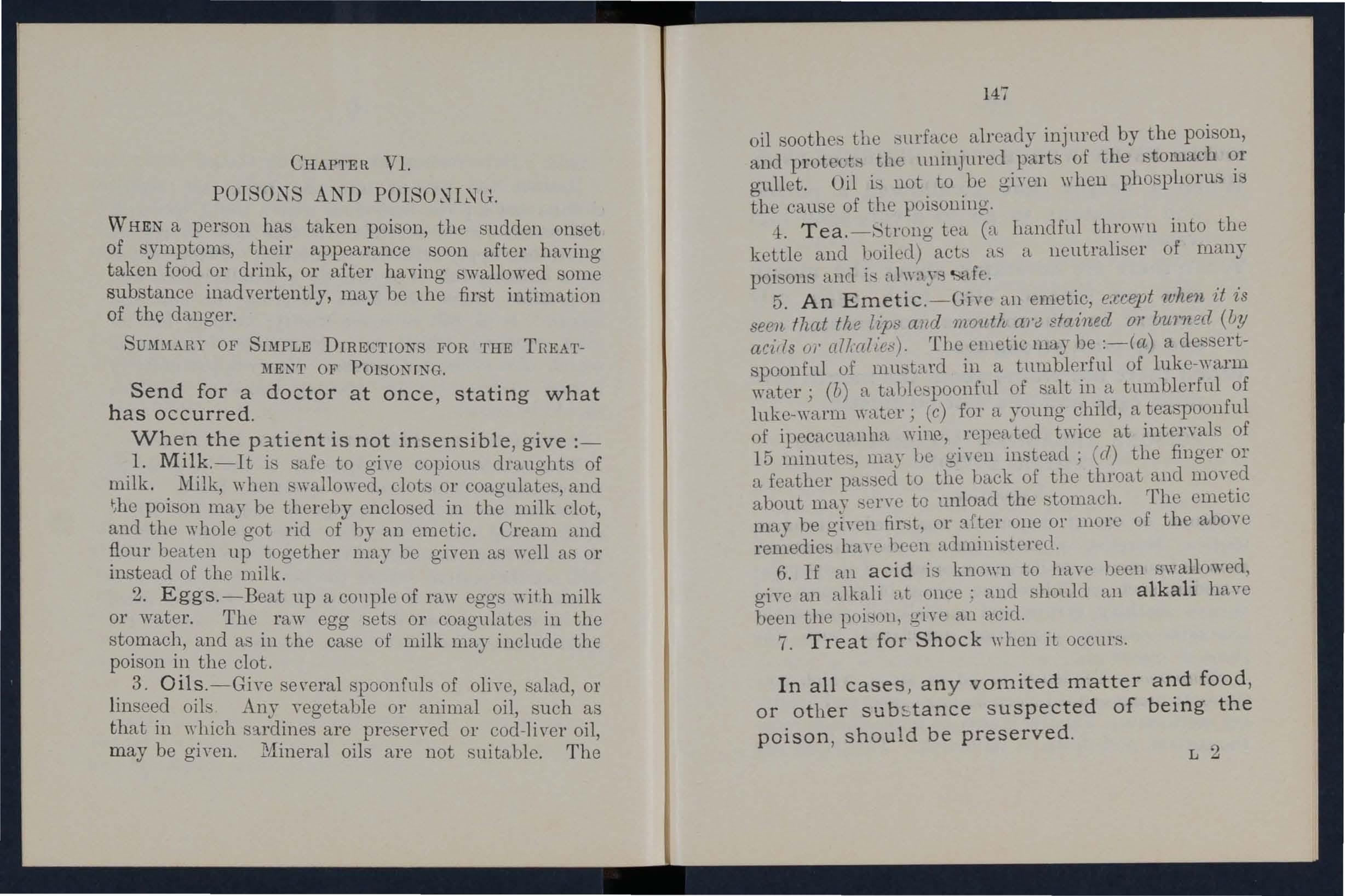
147
oil soothe the t)urfacc already injured by the poison, and protect:-; the uninjured part. ' of the stomach gullet. Oil is not to be giyen \\'hen phospllorus IS the cause of the poisoning.
1. Tea, -Strong teet (a handful thrown into the kettle and uoiled) actt:) as a neutralise!' of many poit:)ons and i ' n,l \\' nyf:l ';-3afe.
5. An Emetic. -Give all emetic, except when d is seen that the lips and mouth ar& stained 01' uU1'?lf?d (uy acirls or allm7ie:·;). 'file cllletiG may be :-(a) a dessertspoonful of mLU;tard in a tllmblerful of luke-warm water; (b) a ta.blebpoonfnl of salt in a tumblerful of luke-wa,rm \later; (c) for a young child, a teaspoonful of ipecacuanh,,l, \\'ine, repeated twice at interval,' of 15 minutes, may be giyen instead; (d) the finger or a feather pa 'sed to the lJack of the throat and moyed about may to mloac1 the stomach. The emetic may be giyen fir:)t, or after one or more of the above remedies ha YO hCOll admini::;tercl1.
6. If an acid is knO\\'D to hayc been swallowed, give an alkali (It OllGe ; and should an alkali haye been the an acid.
7. Treat for Shock when it occur '.
In a11 cases , any vomited matter and food , or other sub t.t ance suspected of being the poison, should be preserved .

FACTIJ 'VORTHY OF REMEMbRANCE
When a person has swallowed a poison and threatens to go to sleep , keep him awake.
Wnen there are no stains about the mouth give an emetic, also milk, eggs, oils (except in phosphorus poisoning), and end up with strong tea.
When there are stains about the mouth give milk, eggs and oils, but no emetic.
POISONS ARRANGED ACCORDING TO THEIR ACTION.
NARCOTICS.
Opium, or one of the derived from it, such as Morphia" 01' some one of its preparations, such as Laudanum, or Paregoric, or some of the popular remedies, such as Chl orodyne, syrup of poppies, and various soothin g syrups and cordials, a ll possess the poisonous narcotic properties associated with the name of opium.
Symp '0171S.- T endency to go to sleep, which continues to increase until sl eep becomef3 deep and breathing stertorous. Finally, it may be impossible to rouse the patient, and death is imminent. Th e pupils are H9
contracted to the utmo 't extent (pin-point pupils) ; th ey do not re.' pond to light. The face is pale, the :-;kin clammy, and a smell like that of poppyheads may be detected in the breath. .
T1·eatment.-Give an emetic and keep the patIent H\yake . Never giye an emetic when the patient i.' im:emible. Keep the patient awake by walking him about, slapping his face and neck or chc;:;t with a wet t r)we l, and by giying strong black coffee to drink. Slaptjng the E'oles of the feet with. a slipper may be tried when other means of rousmg fall. Employ nrti6cia,1 re.'piration if the breathing has ceased.
Acids and Alkalies are the chief examples of this class of poisons.
A cids. -The acid::; most commonly taken as poison. arc, Oxali c (tlle of ?f sorrel ) ; Carbolic; (oil of . ; . (aqua fortis); Hydro chloric or :Jlunatlc (pInt of salt).
Symptoms.-Burning pains in the mouth .throat, and stomach; acid t aste; staining of the lIps and mouth of a \"hite, yellow, or clar1c-bro\yn colour; retching and Yomiting; T shock; ..... an.d collapse, or suffocation. "hell the pOlson. 1S carbolIc acid the smell of the breath help,:; to dIsclose the fn,ct.
150
T?'eatment.-First wash the mouth ont free1y with lime wate r or othe r alkal ine mixture, such as chalk whit ing, mag n esi.a, 01' \Yall plast,er, in water, m ilk, olive oil, and afterwar ds let the patient sip some of it. Demulce nt drinks such a,s barley water milk etc., may be given subsequently, anel eggs up ,yith water or milk. Treat shock.
. Alkal i es. -Caustic Potash, Caustic Quick LIme, and strong Ammonia are the pl';ncipal examples of alkaline corro'ives . 'l'hey cause symptoms res€rr:bling those set 11p by acids, and it is only by seemg the bottle labe l that uDskilled persons can be sure of distinguishi ng between acid and alkaline poisons ,
Treatment . - ,Vash the mouth out with an acid mixture, as lemon j nice or vinegar, diluted with an equal quantity of wate r. Afterwards give milk, olive, salad, linseed, or cod liver oil, or eggs beaten up in water or milk. Treat shock.
Do not give an emetic when the lips and are seen to be stained by a corros iv e flUid , whether acid or alkaline , as vomiting is likely to further injure the co rr oded surfaces of the stomach , etc.
IRRITANTS POISON ).
The chief substances contained in this group are:
- Arsenic (Fo'wlel'\; solution); :JIercnry (co1'1'osive sub-
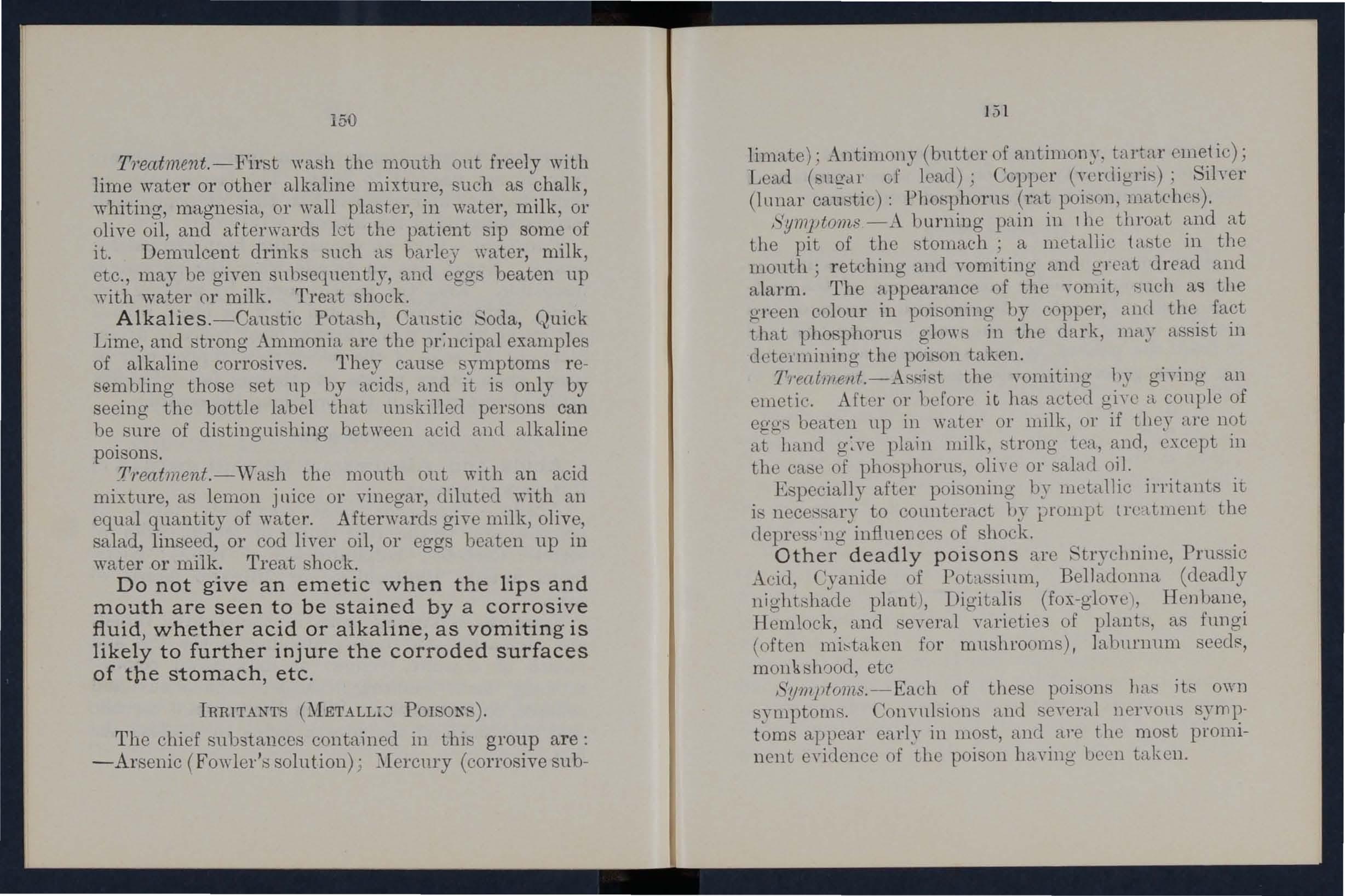
13 1
limate); Antimony (butter of antimony. tartar emetic); Lead (Ug'dl' of leac1); Copper (Yerc1igril'); Siher (lunar caustic): Phofiphorus (mt matches), Symptom,s -A hurning pain in the thl'O;-1,t and at the pit of the stomach; a metallic taste in the mouth; retching and vomiting and grCctt dread and a larm. The appearance of the Yomit, l')1l(;h as the green colour in poisoning by copper, ancl the fact that phosphorus glows in the dark, lllHy assist in detennillillg the poison taken .
T'J'eatlllent.-A ,·p,ist the vomiting hy giving an ellletic. After 01' hefore it has a<.:ted give tt couple of eggi'3 beaten up in wetter or milk, or if they are not at hand g:ye plain milk, strong tea, and, except in the case of phosphorw, oli ye or salad oil.
Especially after poi ' oning by metallic initants it is ncc6l';sary to cOllnteract oy prompt tl'C ltlllent the clepress'ng influences of shock.
Ot her deadly po is ons are Strychnine, Prussic Acid, Cyanide of Potassium, Belladonna (deadly night 'hade plant), Digitalis (fox-gloye), Henbane, Hemlock, and eyeral yetrietie3 of plants, as fungi (often mi:-taken for mushrooms), lahurnum seedE1, monkshood, etc
I yml)foms.-Each of these poisons 11a. itR O\Yl1 symptoms. COllYuli:;ion ' and eyeml llerYOWl symptoms appeal' in most, and are the most prominent evidence of the poison haying been taken.
. an emetic before convul-
SIOllS 0: insensibility come on , and '\\"hen cessation of breatlnng threatet1s app ly artificial respiration
GEK H:RAL NOTE.
.Many poisons have a double action, and technically :U1ght .be grouped nnder more than one of the hcad111gS gi ven. The rule in dealinO' with a poison of this c )01plex nature i.s to note the of symptoms, and treat the patIcnt, as the symptoms arise accordmg to the general directions given on 146 to 14t\ ,/ 0
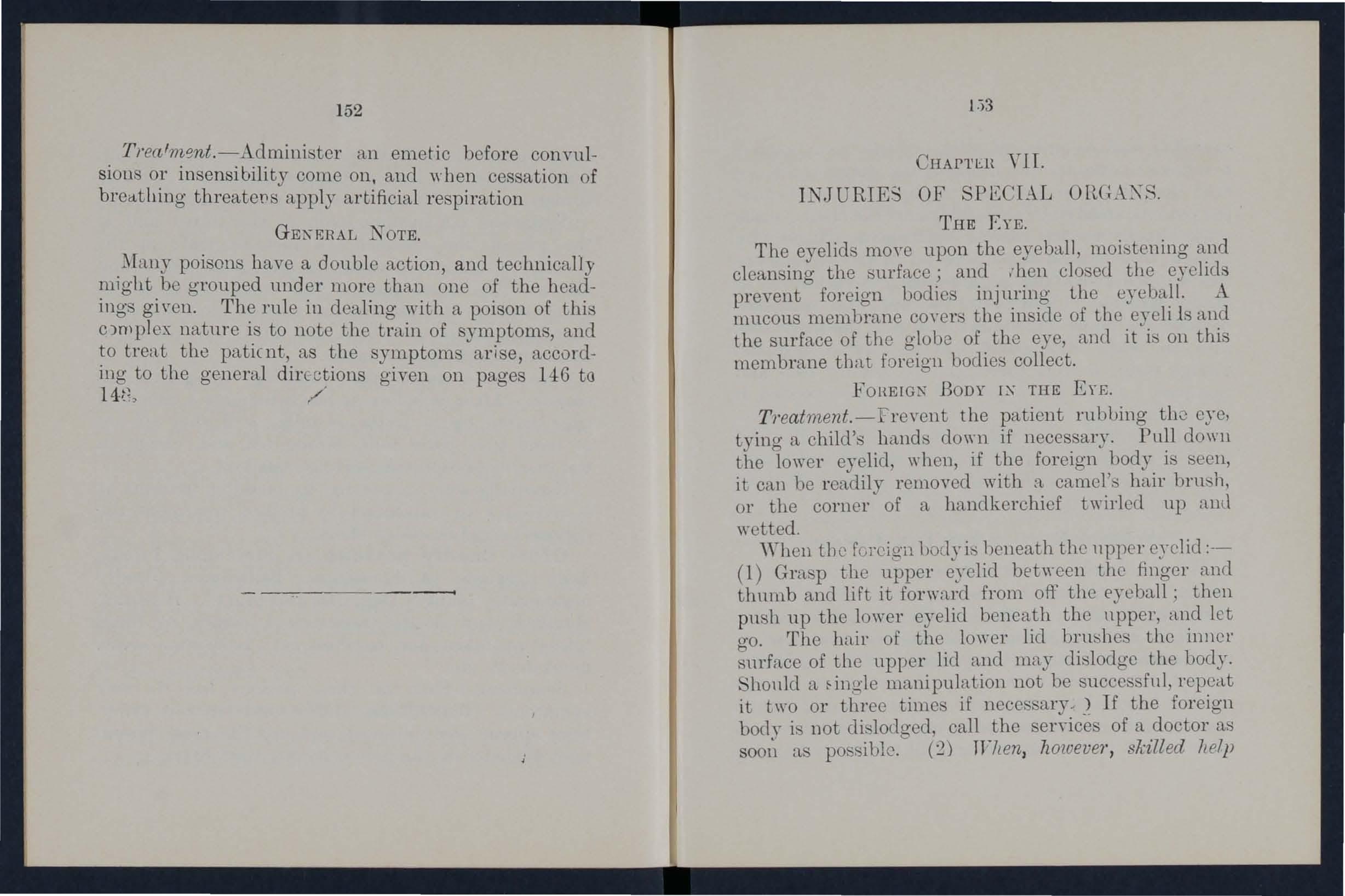 CHAI'l'l:.H YH.
CHAI'l'l:.H YH.
INJURIES OF SPECIAL OIlGAXS.
THE EYE.
The. eyelids moye upon the eyeball, moil:ltening and cleansmg the surface j and ,hen closecl the eyelids prevent foreign bodies injuring the eyeball. A mucous membrane eoyers the inside of the eyeli is and the surface of the globe of tho eye, and it it:) on this membrane that foreign bodies collect.
BODY [X THE ErE.
Tl'eatrnent.-frevent the patient rublJing tho eye, tying a child's hands down if necessary. Pull the lower eyelid, \\'hen, if the foreign body is seen, it can be readily removed with a camel'::; hair brn h, or the corner of a handkerchief twirlecl up nnLl wetted.
"Then tIl e fCl' eign IJodyi::; heneath the 11ppor (1) Grasp the upper eyelid bet,,'een t.he finger and thumb and lift it forward from off the eyeball; then push up the lower eyelid beneath the llpper, and let go. The hn,il' of the lo\\'er lid brut:)hel:l the inncr surface of the upper lid and may dislodge the body. Sho111d a manipulation not be succe sfnl, rCpC1:Lt it two or three times if neccs ary .. 2 If the foreign body is not di 'lodged, call the sen'ices of a doctor as soon as po sible. (2) Trhen, howeve1', skilled h elp
cannot ue had, as on board ship, or elsewhere, proceed as follows to examine the inside of the upper eyelid :, -' eat the patient so as to face the light; behind the patient, steadying the head against the chest; place a tooth-pick, -wooden match, knitting needle, or any naITO''', firm rod, 011 the upper lid of the injured eye half an inch above the edge, pressing it baclnyards as far as possible . X O\Y . eize the upper-lid eyelashes between the finger and thumb, and pull them upwards oyer the rod . The eyelid will be eYerted, and the foreign body, if it is there, can be rcadily seen and remoyed. (3) -When a piece of steel is emuedded in the eyeball, drop a little oJiye 01' castor oil on the eyeball 1.dter pulling down the lower eyelid, clo, e the lids, apply a soft pad of cotton wool on the lid, and secure by a bandage tied sufficiently firmly to kecp the eyeball steady, and take the patient to a doctor.
BODY THE EAR PASSAGE.
,Yhen a doctor can be had, even within twcnty-fOllr hours, never attempt to treat a patient with a foreign body in the ear. A pea in the car is <l. seriolls accident, and any attempts at removal may lead to fatal consequences . If the patient, a child especially, cannot be induced to keep the fingers from the ear tie the hands down, or cover up the ears hy tying a handkerchief round the head and over the ear' . If an insect is in the ear-paS] age, fill the ear ,,,ith olive
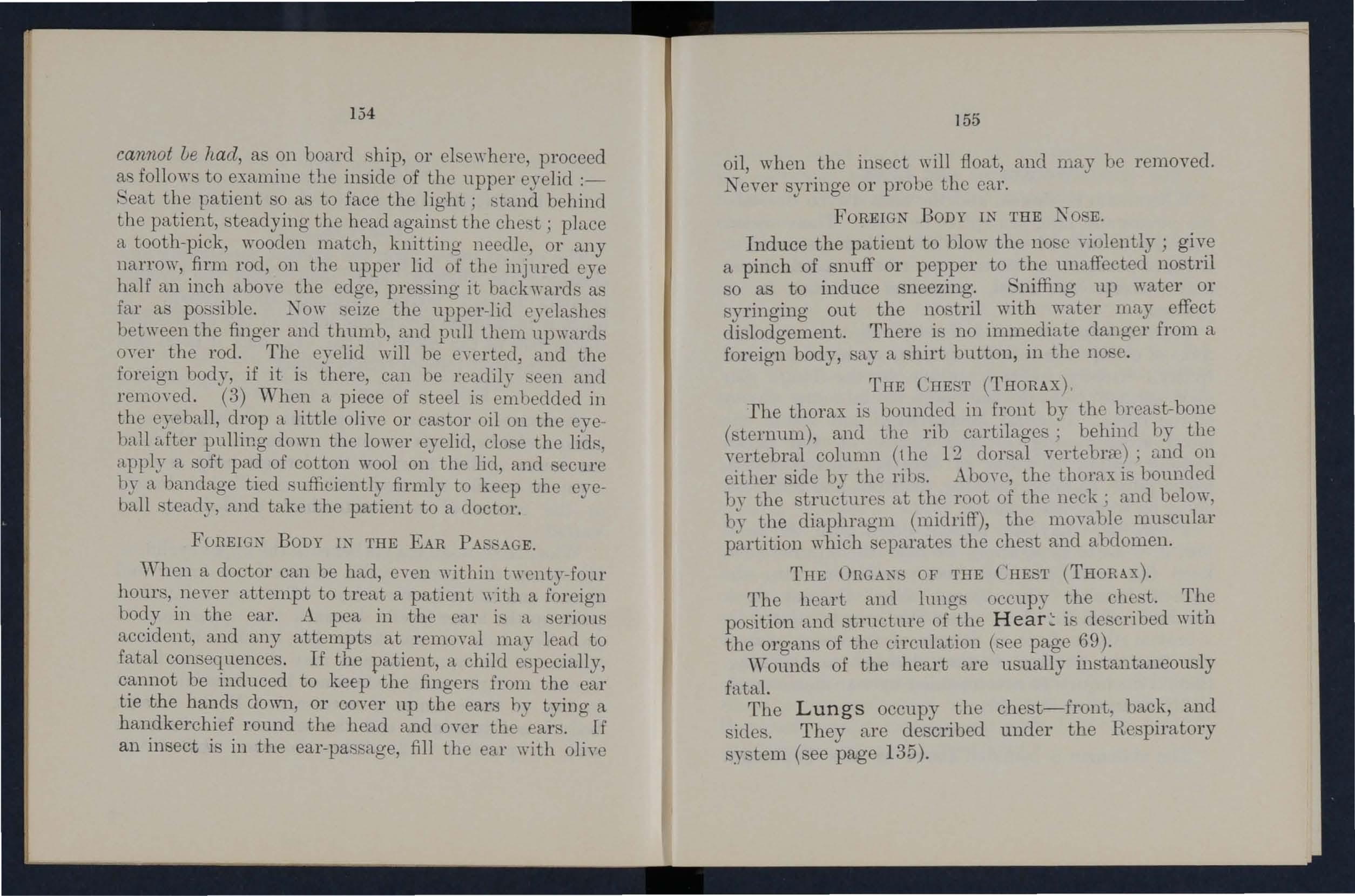
155
oil, when the in cct will float, and may be removed. N ever syringe or probe the car.
FOREIGN BODY IN THE NOSE.
Indu ce the patient to blow the nose violently j gi".e a pinch of snuff or pepper to unaffected nostnl so as to induce sneezmg. Smffing up water or syringing out the no tril. with .water may effect dislodgement. There is no ImmedIate danger from a foreign body, say a shirt button, in the nOS8.
TIm CIIEST (THORAX )
The thorax is bounded in front by th e hreast-bone (sternum), and the rib cartilages; behin d by th e vertebral column (t ho 12 dol' al vertebrm) ; 1. uel on either side by the ribs. Aboye, th e th orax i bounded hI the structure ' at tho root of th e neck ; and b elow, b'\' the diaphra u ll1 (midriff), the moyable muscular partition which the chest and abdomen .
(THORAX).
The heart and 1111lO'S occupy the chest. The pO 'ition and structure otthe i, ' de cribed with the organs of tho circulation (see page .69).
' Vounds of the heart are usually lllstantaneously fatal.
The Lungs occupy the chest-front, back, and side. They are described under the Respiratory sy tem (see page 135).
OF THE
' Yhen a rib i::; hroken, and the ends (ll'i \'ell ill\\','tl'Cl , the plenl'a and l ung are apt to he torll. These lIS Jll,ty al.o be injured hy a. \yith ,t knife, or ha,mllet penetrating between the rih·. .\. rifle lnlllL't IlUlY trtlYcr.e the che ·t, wounding' thc lUll!.!,' ill its p" ",lge.
8/!/n8 and SYlIIldom.'!, - Difficulty of 111'L'nt II ill!.!" ..nupton.'; of colhpse, faintne s, Hpitting or blood (rvd awl rrothy), n ually indicate injury to the lilt I!.!,'. .\'i! lW1Y ecape beneath the 'kin or into tile eH\ it,' uf the I nternal Ju:cmorrhage lllay result, the ) lood acnullulating in the ea \'ity of till' chc,·t, c 111::::;i1lO" p,'tllor, ::::;lowne.·:-:; of breath, J)I IllTc(l feehle pulse, sighin!2,', y.'t\\lling, delirium, and g'OillO' 011 to unCOll eion:-:;ne.·.·.
T ,catn ud.-Lay the patient c1(mll "ith thl' hl'all low, giyc icc to 'uek, apply icc oYer the illjun'l! part, keep the room cool hy free Ycntiiatioll. tUJ'll tIll' patient to\\ard' the injur cl ·iele. Do Ilot til' a lJandagc round the che .. t \\ hen the lung is illjlll'l'(l h,\' n. broken rih, a .. chere is danger of t.he )'ollg'h end Ill' the fractlll'e causing further damn!.!,' to the , 'hould the injury he accompanied II,)' a . llrfaee wUlllld apply clean dre' ·ing., &c.
The ubclomen is bouncletl above by tho cliaplll'ilO'lll
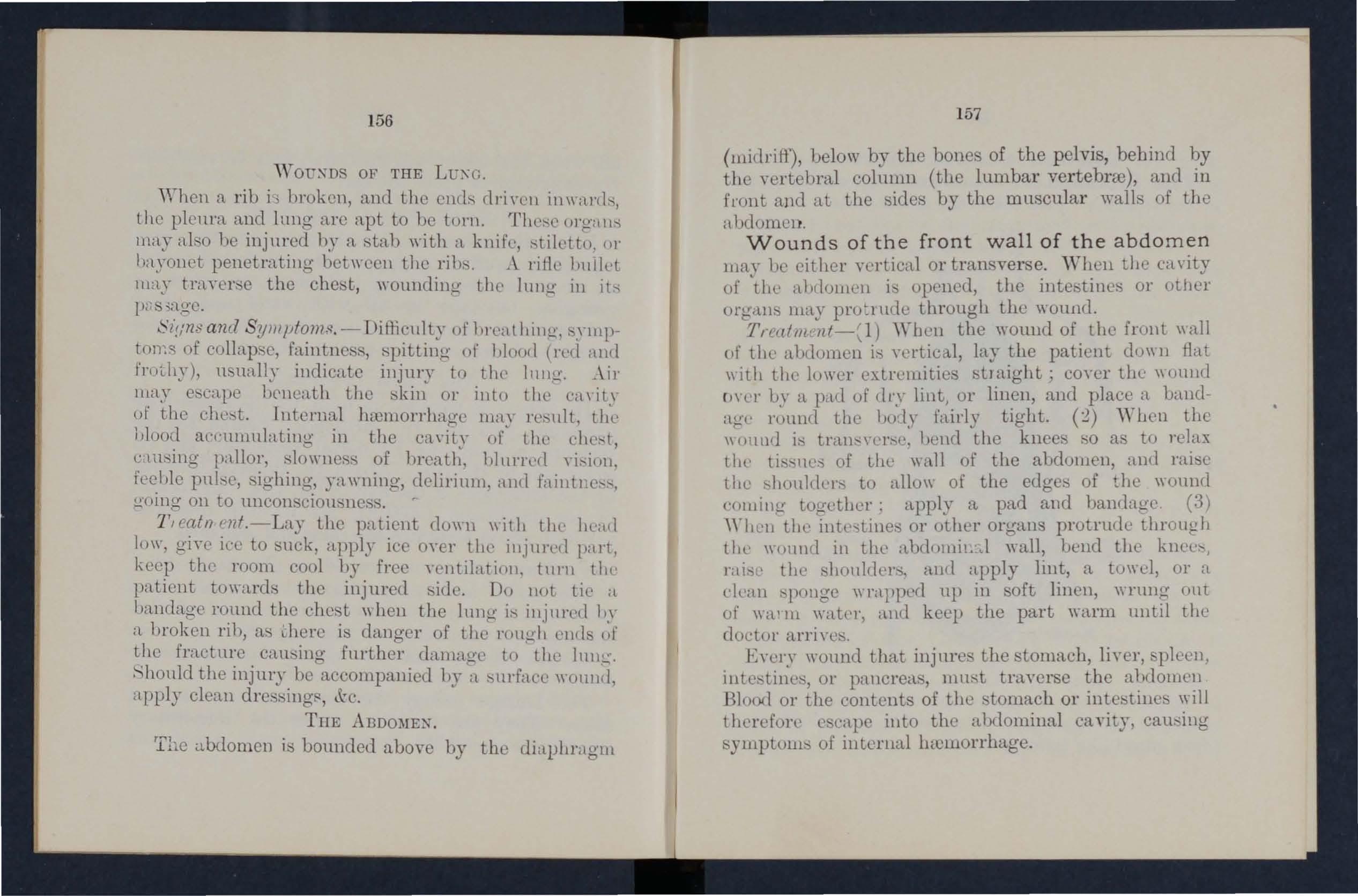
157
( lllidritf), IJelow by the bOlle of the p elvis , behind by t h e YCl'tehral colmnn (the lumbar ver tebrre), anel in front a)1d al the sides by the muscula r wall., of th0 nl)domen.
Wounds of the front wall of the abdomen may 1)e eithe r "crtieal or tran ve r se, 'V hell the en \'ity of 'tbe a],(101lICIl i· opcned, the inte tinl's or otiler urg<ll! BW..)' pro:l mle through the \\'0lll1C1.
Tt'I.:atlll'l1t- 1) the wound of the frunt " '£111 or t.he allllol1len i:-; Ycrtiual, lay the paticnt dl)\\n flat with the lower extremities tJaight; COYer the" ullIHl ()\'L'r uy a. p<td of dry lint, or linen, and place a banclruuuel the 1Jo t) fairly tight. 0) 'Y Ll'll the \\() 1ud is tmn.\'er.l', llenel the knee "0 a. to relax tlll' t.i of the \\all of the abdomcn, and rai 'e the .... holllder.. to aHo\\ of the edgc. of the wounel too-ether; a.pply n. pad and han(lage (:3)
'YII 'IJ the or other organ protrude throug It tlte w(Jullcl in the \\all, lJcnd the r"i.'L' the .llouldl'l's. and apply lint, a tuwel, or a cleall . pnugc "mppec1 up in oft linen, \\Ttlllg nnt of \\ n' III "'<ttl'!', ;\Illl keep the part \yl:tl'lll until the doctor arriye·.
Eyery wound that injure' the tonmch, liycr, plcen, illte:-,tine', or pnncren.', mn.. t tr<'tYerse the ahdolllell BJo()(l or the l:ontents of the stomach or intci)tiue will t herefol'l' e cHpe illto the al)domillal ca Yity, ea1.ving ''ylllptullL of internal lHclllorrhage ,
THE URGANS OF THE ABDOMEN.
The Stomach lie' iIl11nedi,ltely benea.th the" pit of the stomach" ju t belo\y the b r ea t -l)Olle.

Fin 5-;.
Iuj urie.s of the stomach nrc attended hy extreme collapse, and sometimes by retdlillg, atHl YOllliting, of dark blood like cotfee grouncb.
159
TJ'patlIIPlit. Lay Lhe palient do\\,11 011 hi, be ck, apply all Ice-La!.!' oyer the pit of the ,tmuach . K othillg :-:;houl(l l'l' !.(iYCIl l)r the month.
The Liver lie L in the uppcr part of the ah:10111en .. \\ here it 1110 th' coyerecl In' the right 10\\'e1' rih."
lll .imic'l of thc L liH!l' llwT 'b cawed by u l)low 0\' 01' the oru:nn, 1,.' fractured ri]" lJenetratillg it, or by the tab of a :--hnl'U ,,'capoll, or .1)Y a 11ll1let. The "Teat rl ' ll1!!er or a " "Ollll' ] of the liYer i' 1nelllOrl'lwgc, the: 1,Ioocl CtiCapill [': i1lt o th ' c!lyity of the alJ(lol1ll'n. Th e illj1ll'Y i ' cLttcncle<l II..\' pain auel s\\"cllil1!..(· in the region of the 1iH: r, ancl 1,." the s it!' 11 , allll l'-i),lUptUll1S of illt e rnal liceillorrhagc.
'}'!'lulllzellt.- - Lay th " patient dU\\'ll, gin' il'{ to slIl·k , HPl }l), iee (\\"C1' tIll' regioll of till' Ii \'l'L turn thc pati ellt to\\ ,ml" tltL' l'l!.!.llt ide .
The Spleen lil' , l'l'llCath tbe rib.- at th e Uppl.' l' part flf the lL'l't iel, of tlte al,dOllll'lI .
Thc CHll"l'''' (If illj !ln' Clwl tbe nre :--lInibr tn tllO ..,e of tIll' !i,' cr, all;l the i, silllilill'. only tlwt patient ,' bllujfl l)e tUl'necl tU\\<1nl , thc left i<1t:. Ill.illl'il''' (If the ,'pIcen art: lluallypeedily fatal.
Injuries of the Intestines cause (If l'ollap.-e, all.] intl'rnal hrel110rrhagc may oe(m!'. Pi' thc l'Olltcnt llla,\ l' npe into the of the alxlomell.
Tr{'atment.-Kcl'p thl' patient down and as ftllict it--> po,.,. il,lL . \ ppl." a large pad of fhlll1cl or cotton "'001 to the ;tlxlollleu, kept in place oy a to\\el
160
applied fair ly tightly rouud the abdomen and pinned in three o r fuUl' p lnce " Ui"e nothing by the mouth.
The Kidneys lie at thc uack in the region of the loi n. They may ue injured whon tho 10wc t r ibs (the I t th and 1 a r e fractured by a crull, ulo\\' , or by a uullet or . orne ,ha r p wenpon, Blood would e cape with the nr;nc, anrl thee would be pain and perhap· welling oyer t lie injured kiclne.),
The Bladder lic ' ill the pel \' i", an(l may be "onnc1ed by a fracture of , orne 0 " the pehic bone. 1 he signs . Yll1ptOlll \\'ollld lIe \..' i t llL'l' ina l)ili ty to p it' \Yater, 01' if a little i pas eel iL i. tinged with uloocl , 1'1'eatment , - \Y hcl1 either the kidney or hladder is \younc1ecl, keep the patient (iuiet m;til the doctor an'ins, nncl lIJ1' al1tillle apply hot fomentations oyer the pa.inful or inj lued part,
Rupture (lI CI'lIiu ) eon , i. t of a protrl1.ioll of an internal organ, 11.'lHI.lly the lJowel, throlll.!,'h the wall of the abclom 11. It lllO ' t frequelltly occnrs at the groin. a . ' ndden , ' \Yelling, al'C olllp1l1ied by pain and , ickne " tak e plnce, HOllll for a doctor inctanOy, alld lllcanwhile put the patil'llt in nll ea y p"o ' ition, and place iee ur <.:old \\Hter applientioll Oll the affected part.
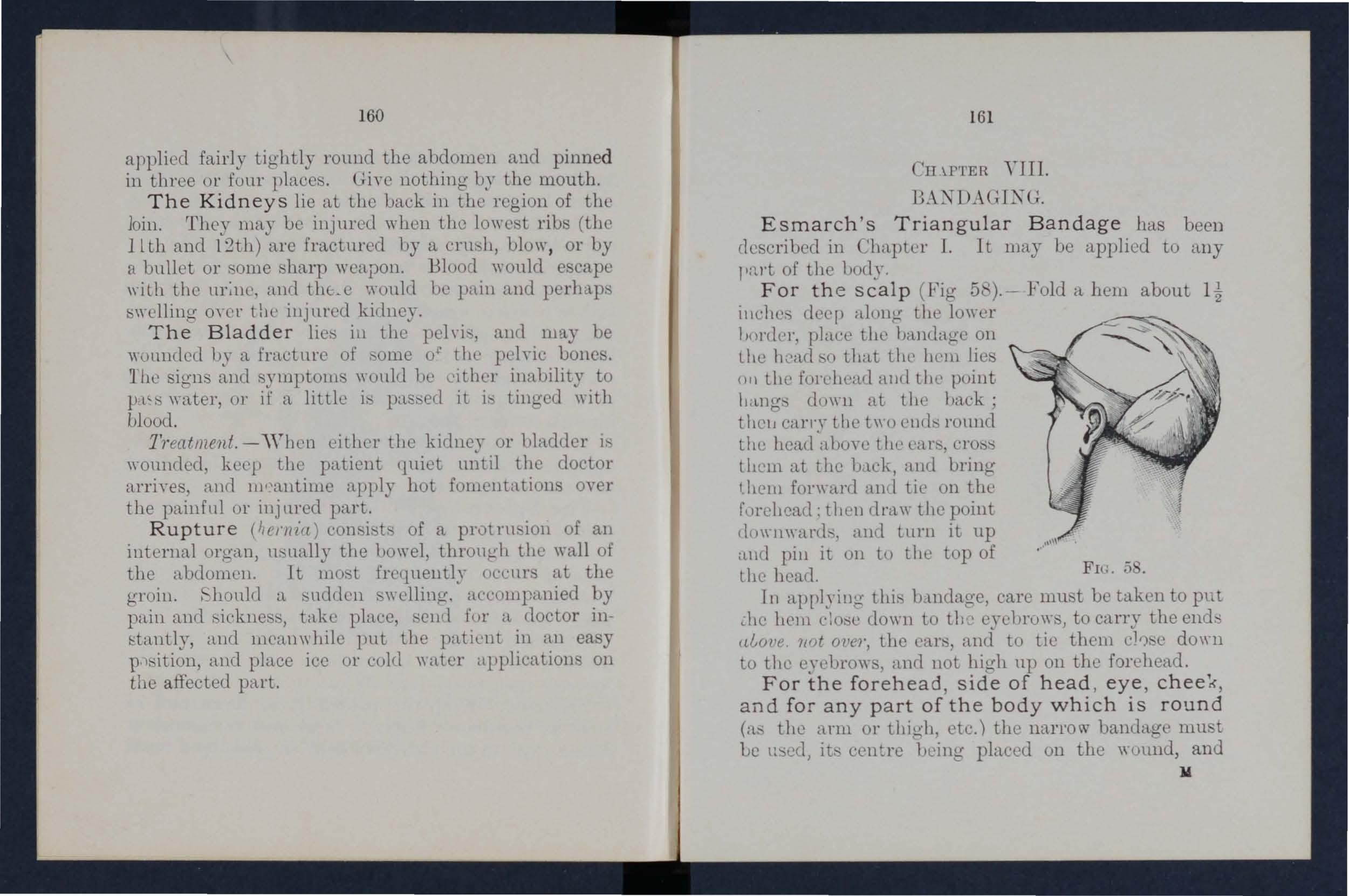
l61 ('II \rTER YIl l. DAGIXU.
Esmarch ' s Triangular Bandage has been described in Chn.pter 1. It may be appli ed to any part of the body .
For th e scalp ( Fig 5 -' ), - fold Cl hem about deep along- lhe 10\\ er
1)(mh' !', place the lJandal!:e on Lhe h "ac1 . (l that the h l' 1ll lies
Oil th e furehead cllld th e point Il ,mg.' cl()\\"u at tll ' llUck; t he ll carrr the 1\\'0 CUcll'Ollllcl Lh e h eac1'aboye th c <':1'0::; t h elll at thc hH': k, nucl bring th ClIl forward <lll ll tie on the I'llreh cacl : th en (1m,\\' thc point dO\\·Il\\'ard.', and turn it up allel pill it 011 tu the top of th o head. FIb, .;
In applyiu1,!: thi. ' b .mclage, care must be taken to pl t .: h c hel1l <.:lo::;e clowll to tll 0 eyelJru\\, ) to carry the end , al.,ol 'e No t Ol'cr , the ar.' , nncl tu tic them e"ll). e do\\' n to the o\"(: 1>1'o,,"s, and not high up on the for e head .
For the forehead , sict""e of head , eye , a nd for any part of the body which is round (a:, the arm 01' thigh de.) th e narrow bandage mu t Le It 'c d, cen t re u cing plac ed on the " ound, and 14
the ends beine.:: cnl'l'iell ronnel the limb a.nel tied over the wound.
For the s h ou l der (Fig. 59).-Place the centrc of a bandage 011 the inj med shoulder, with the point up the , i(le of tbe ncd, : turn up a hem; I'iG. E9.
car'J the ends round the middle of the arm ,l1lrl tie them j take Hl'c c)l1(l l>nllclagc, fold it illto it hro.tu place one 'llti oycr the point of the fir.'t hlllrlag'l', the anll 1),Y carrying the other e,),l of lh" ballCLtg'(' un:r the sound I:>lwulder, ;ud t\ ill!!' nt the :iidc 'If Bcd; bring the p oi nt or tbe Il:llldage
uurler that part of the sling n;::;ting rlll Ull llljl1l'cd slhlnlcler, (ha\\" it ti!.!ht. tllm it r1(l\\'11, Hnrl pill it.
For th e hip (Fi!.!,'. (iO).- Tie a llalTO\\' h<lllclnge rounel the boil)' ahow the hmll1ch -1Jo:ne , tying the kll')t on the ,'mIle .'iell' a' tIle ill.iur,": t,lkt, flllother Intl1rlagr, turn l p a helll tlcl'(mliug tfJ tIll' il.'· of the pla(; e its centre all tIte \\"(JUL'l, car!'y tbe cnds
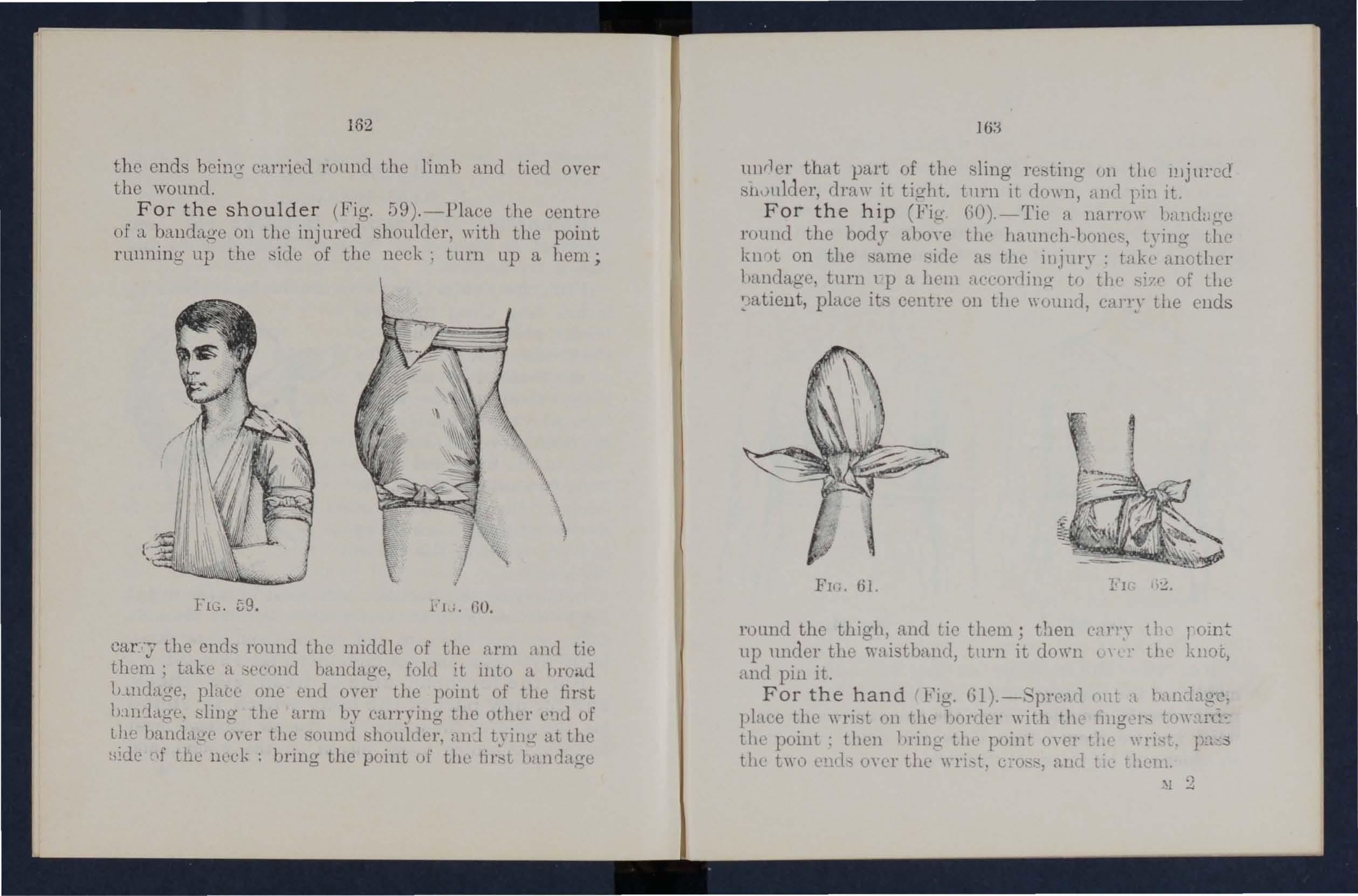
runnel the thigh, and lie them; then C:ll'l'Y th 10m: up nncler tho tnrn it down \ r tbe JdlOt, and pin 1t.
For the hand Fig. Gl),-. Fcnd (I,li. Ll phce the "ri on the lllw<lL,l' \\ith the tf)\\ ll'll:. tlte poillt : then Ll'illQ' tilL' point uyer tl.r wri.'t. P:l-5 tltl' two L'llfl' o,'L'r thL' \\l'l ... t, (111 1 t:l: thell,. ,\1
164
For the foot (Fig, prcm1 ont a ban plc:we t h e foot on it:) with thc, toc tL.e poin t, clrll \\' up the POlllt oyo r , the lll, brmg t h e two encl, , fonY,m1 (.;1'0", and tIe thetll eIther on the sole (if to keep II Lplint 011) or round the ankle .
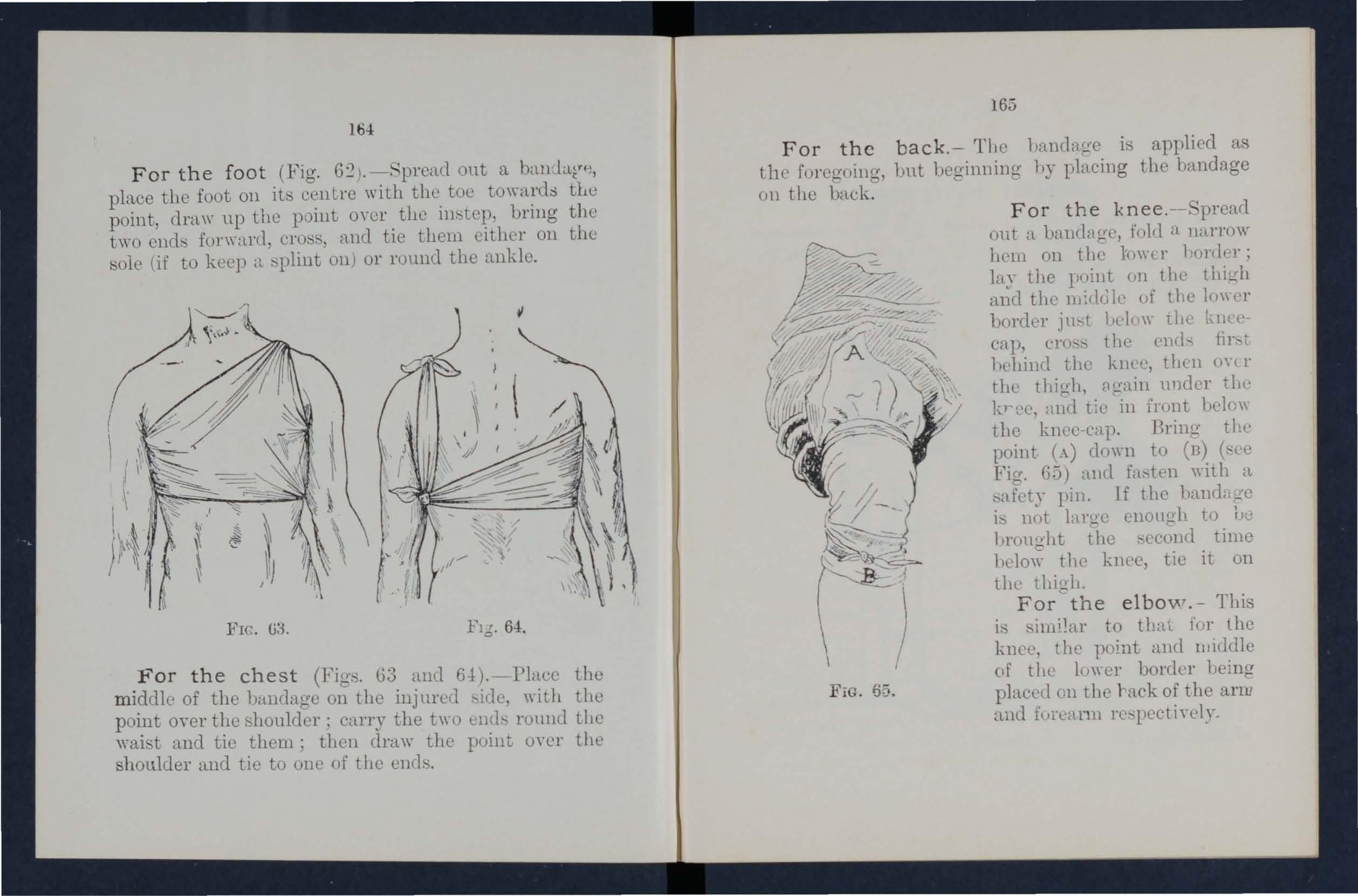
165
For the back. - The h"lnc1a£:,'e applied as t,he fo r eo'oillCf hut beo'inning l)y IJl;cing the bandage r 0' - e J 011 the bade
For th e k nee .--. 'pread
Ollt a lmlldag'e, folc1 a 11;11'1'0\\' hClll on the rO\\TI' honh r ; lay the Pl)illt on tltL' thi.2;h and the l11:r1c.;ll' of the lc)\\'l'l' border .ill. t Lt;ll w tlle kllLecap, crn." the end til', llchinc1 tile knc'.!, tilCll (In!' the thit.?;lI, !I!..!'ain under tIll.': Hnrl tie ill iront 11e10\\ the kllCC-Cilp. Bring tltc point (A) cloWll to (n) (f'(:0 FiC(, 63) :\11(1 fasten with a :--nfcty pin. If the htmc1n:!e i ' not lar!!u enollgh to 1)i,; l,rull cht the ::,ecullc1 time h L·low the knee, tie it 011 the thidl.
For the che s t 03 <lnd 64:).- P!at;C the m iddle of the bandage on the injured \\ ith the point oyer the shoulder; ctlrry the t\\'O round the wai t and tie them; then chaw the point oyer the sholtldel' and tie to 011e of the end ...
F o r '- th e elbo w . - This to that for the l:;n L', the point <lnd 1Ilic1cllc of tbe 10\\ er border lleillO placeL1 on tbe 1 :lck of the :lllll fUi'C,U111 l'epectin·ly-
l'n.HTER IX, C.\.HHYL ({ r . \'TIEXT, ',
In accident:-:; \rhcre the patient ha. rcnclcrt,c1 unable to walk <lInne, he may he carried hy the j 'y_ ' tandcr ' lllakill!.?,' either uf tIle f'1l11o\\'in!,!' '('at::(1) The four-handed seat i::; llwde by t\\'o
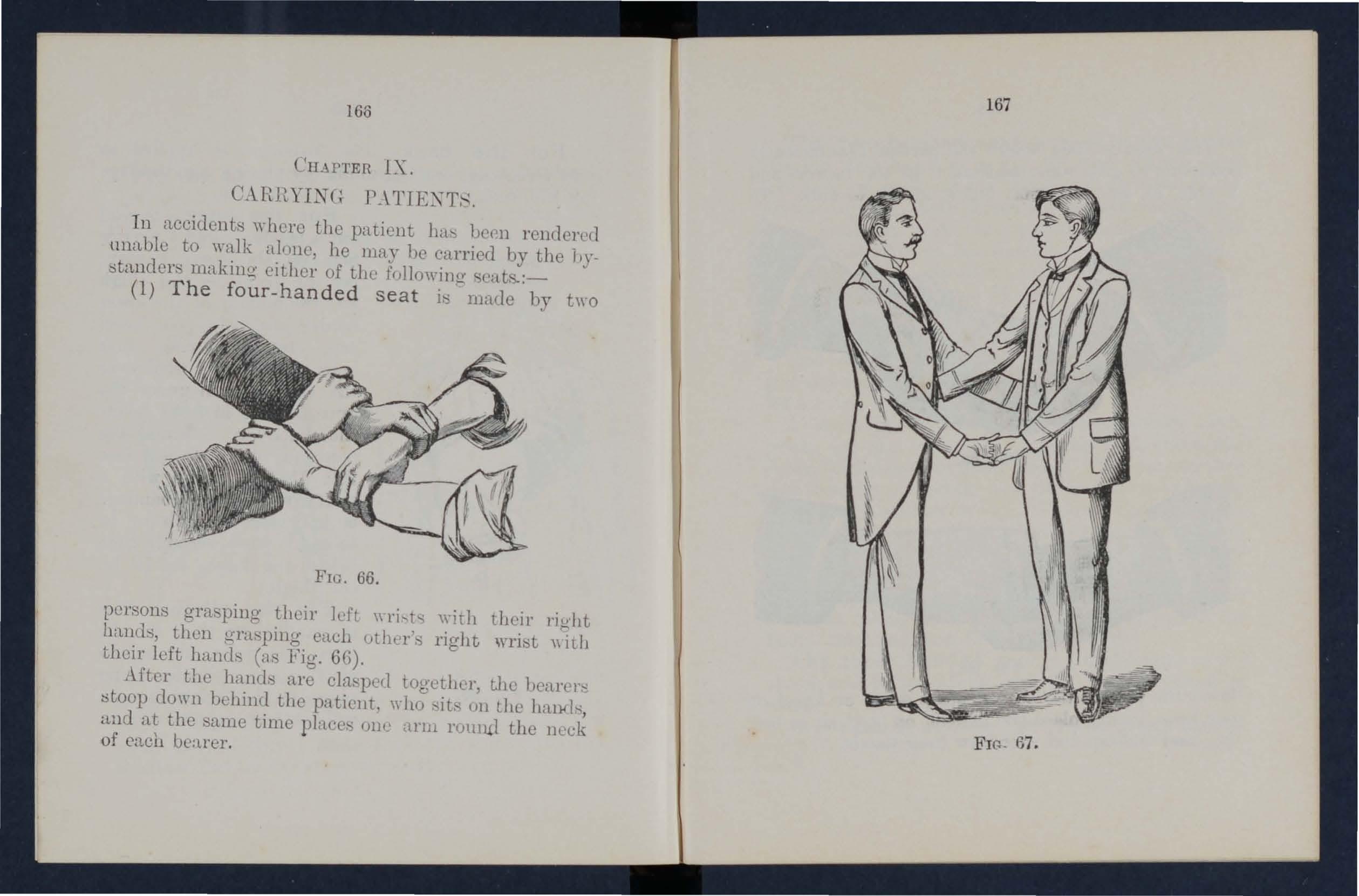
FILl. 66.
persons gra.·pillg their lerl \\'l'i"t-; with their rig'ht bnuds, then each uther':) right wri·t with their left hauel. (n. Fig. 60).
After the hawl.' are cla"pul tOtl'L,thel', t.he hearer:::' titoop clown lJehillcl the patient) \\'ho (Ill the hand", and at the same time ph<.:l'. (JllI; [trIll 1'lJtlll!l the lle<.:k of caul! UC;ll'Cr. 167 FIG . 67.
This eat's u 'cd \\ here the pa.tient i8 y con cious to giyc Ollle aSblt:ltancc to the hearers 11 is able to us his n.rmc1 but ic unable to wa,lk. Tn
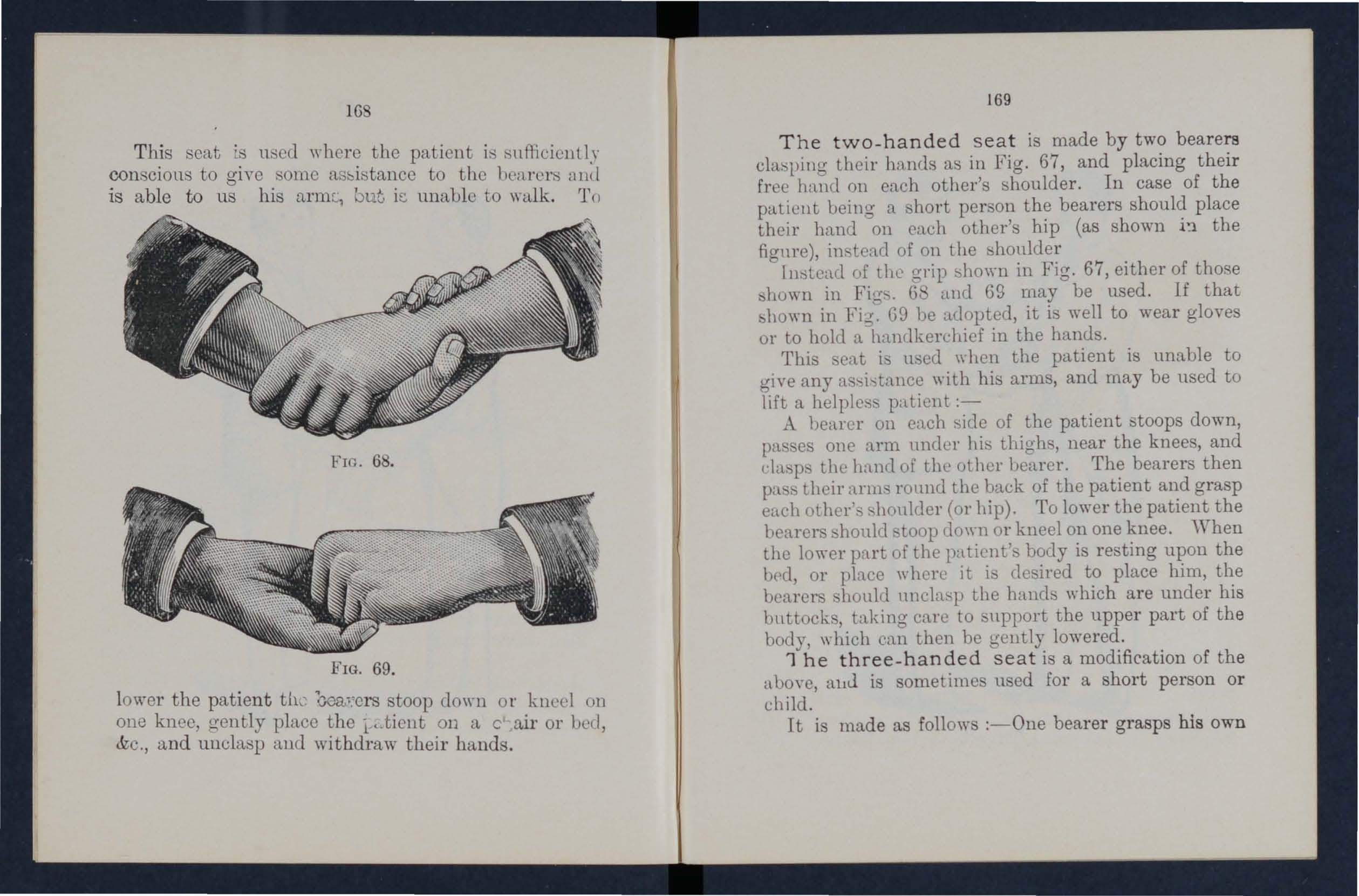
FIG. 69.
lower the patient Gea,Fers stoop clown or kneel on one knee, gently place the i <.ticnt on a c n.u: or bed &c., and uucla. 'p and withdraw their hands. '
The two-handed seat is made by two bearers cla. ping their hands as in l!ig. 67, and placing their free hanel on each other's shoulder. In case of the pa.tient Geing a t:lhort per on the bearers should place their hand on each other's hip (as shown i:l the {laure), in, tC:1d of on the bhonlder
Instead of the grip ::,hown in Fig. 67, either of those hown in G alld GS may be used. If that hO\\'n in Fi;;. G9 be adopted, it is well to wear gloves or to hold a handken.:hicf in the hands.
This eat is u::;ecl \\ hen the pa.tient is unable to gn'e any a . istnnce \\ ith his arms, and may be used to lift a heJple" patient :-
A 1)e,ll'Cr on each side of the patient stoops down, pn.. es one arm under hi thigh " near the knee, and cln , p the hand of the other bearer. The bearers then pa their arms rOllnd the back of the patient and grasp each . houlder (or hip). To lower the patient the bearershould -;toop down or kneel on one knee. ,Vhen the lower Iyut of the body is resting upon the Iwd, or phca where it i::, c1 e ired to place him, the bearers ' bonld the hands which are under his buttock" taking care to upport the upper part of the body, which can then be gent1y lowered.
1 he three-handed seat is a modification of the aboye, awl is sometime u ed for a short person or child.
It is made as follows :-One bearer grasps his own
FIG. -;0.

left the !Jthll' '.!Tll..:1)'-: the' forearm of the l"il'st hcarer \\ ith hi.' left the fir t hearcr grn:"l') the left fureHl'Ill or the ::>oconcl bearer 'with hi, left hauel . the lJearer hi.' right hand Oll the left :-;honldcr of the first 1J ;ucr. The forearm :-;hnulcl in a11 ca:e' l)e !!:n1sped slightly ahoye the \\ri.t (Fi!.!,. 70).
Tu lower thr vatient lhe hearers '})()lllrl .'t()()P rl()\\'n or kneel on ouc knee gently plm·e the p ltient on a ch,lir hoel, &c., anel 1l1ll'1a.·p <mel withcll'<1\\ tlleir hanel..:
Une 11e'll 01 may eany a patient by thc Fireman's lift a:-, folll)\\ S :-
Tu LIj'f flip Patielll -Turn the patient face downward.' wilh hi, lcu:' c"\.tcllcle(l alld arms elo,e to hi' ·ide' ; ynnr-.;elf at hi" hCilcl, stoop rlown, :li!.!,'htly 1'li:-.(" hi.' It ltl and .ho'lldel's, .mel take l.uld of him do:o;c uncleI' his armpit., lnckill!!: your Lnllcl.· OIl hi" 11;lCk. llai:-:e his lJocly <1 high a" it can II" lifted with y()nr hnlllls and arms in thi po itioll : then l' -;tin!! lIi:-; hId:" n-: fal' as ihle on yonI' left knee, ::hirt y()ur ;l!'Ul. and lake him rOlmc1 hi \\"<list. lock ,Oll!' ilillllls n1111 lift him to iln almo t npright pOSItion \Yith hi.' hend rcstin!,! on yom ll,rt 'honlcler, your left thigh "llpportine' as 1ll1lt:h of hi weight ac; po sihle. Boldill!.! the pntil'llt in thi-; with VOllr left arm, gra 'P hi· left \\ l'ist with :-0111' right hano, throw hi. left flnn nycr nlllr head, and at the <-;<l1llC time drop your::,df iuto pn.itioll : let go of the
patient \\' ith yom' left :\,1'111, wh ich then p l ace h twC'en h is t hig h s . T he p a t ie n t'.' body will 110',)" fall tlCro::;::;

,shoulders} and you. ho ul d. uow l'Le to an III ri,..1 t pos lLlOU, 9nd b ala n ce i t cal'eful1 y. T r n.l1!-fl.l' tlle
1i' 3
patient" l eft \\ r i.t to your left hanel, and 0 l eaye your right hand free fo r .teac1yin!.; \yhcll c,lrrying the pnLicnt dU,,"l1.Lt'lir,', or elO\\ n lL Ltclder (. 'ct! ( 1).
1'0 LOlte!' tlie p ((f1"f'lIt.-Tran,fel' the paticnt'.IL ft \\ 1'i t to your band , take your left anu fl'fJl1l Fw. 72,
hd\\'ccn hi and pttl'l' it I"Olll1rl them, thelll to the ri!..dlt-h'llHl. iul' of yom lJucly. ",ink do\\ 11 upun yuur ri!.!'Ilt knl'l" let the icg:-. 1'(' ,t on the ),!l"otlllll \\ hilL' YOU ,'nppul't hi'> lJoc1y 011 your left thigh, place YOllr ldt anll nllll1(l rigllt let go 01 hi. left \\n't, and pllttill!! }fJlll' right arm und -r-
neath his l eft anll ,w,l l'()ullll bi,' hu.;k, place him gently on t h L' grouud (Fig. (2).
e l)ea r en.; \\'110 prefer to GillT\ the wClo'ht of the patient 011 the right 'honlder ':-,hnlllri " left" for "right" and cice the a 11o\'e in tl'lll: tiou:-,.
,The of cauyinu the patient uy the arm ...; anll Zeus Iczth the jace dou;nzcards, commonly called tlte (C (ru r/" never be 1lsed, as death may ell,'ue {ll1s treatment .
\rJ lCre ;'t propel' l->tl'etcher <..:allnot be obt,Lined, a temporal'." 01lL' tua.\" bL' made in either of thc following \\<l,'S :-
(1.) The lee,L':-' of a cuat ma.\ he tUl'llell ill.-iell' ; t\\"lltOUt pule!::> are tlJell pas:-,cd thclll, and the coat buttoncd. Thi:-; wakm; tl good lScat. 7:3), The paticnt lSit· 011 it, amI re, t again,t thL' h:tck ()f the fir, t Loarer,
If a lUllgcr ,tret<.:hcl' il') required, b,'o coat' lllll:st lJC trcate 1 in the .'<lllle \\ay. (Fig, {·t)
(2.) A may l,e taken; a hole i::; lllnc1e ill each <':Ol'l1er of the l)uttOlll, alld two pole' pn ','c d through the 'aek Hwl out of the hule'5. (Fi!!. 7 )
(3) A large pieGc of carpet, tarpaulitl. 01' a hlanket rna." lIe .'pl'cad (Jut, and two stont; PJle:s rolled up ill the bearer!::> thetl st.llH! 011 l'ach Thc·y the llliddle of the p[,ll' wltll 011e bawl, aud !leal' the
17 5
end with the other. To carry the patient they mllst "Yalk sirlew;t Y .
(4.) A lJl'oacl piece of wood, or shutter FIc: . 74.
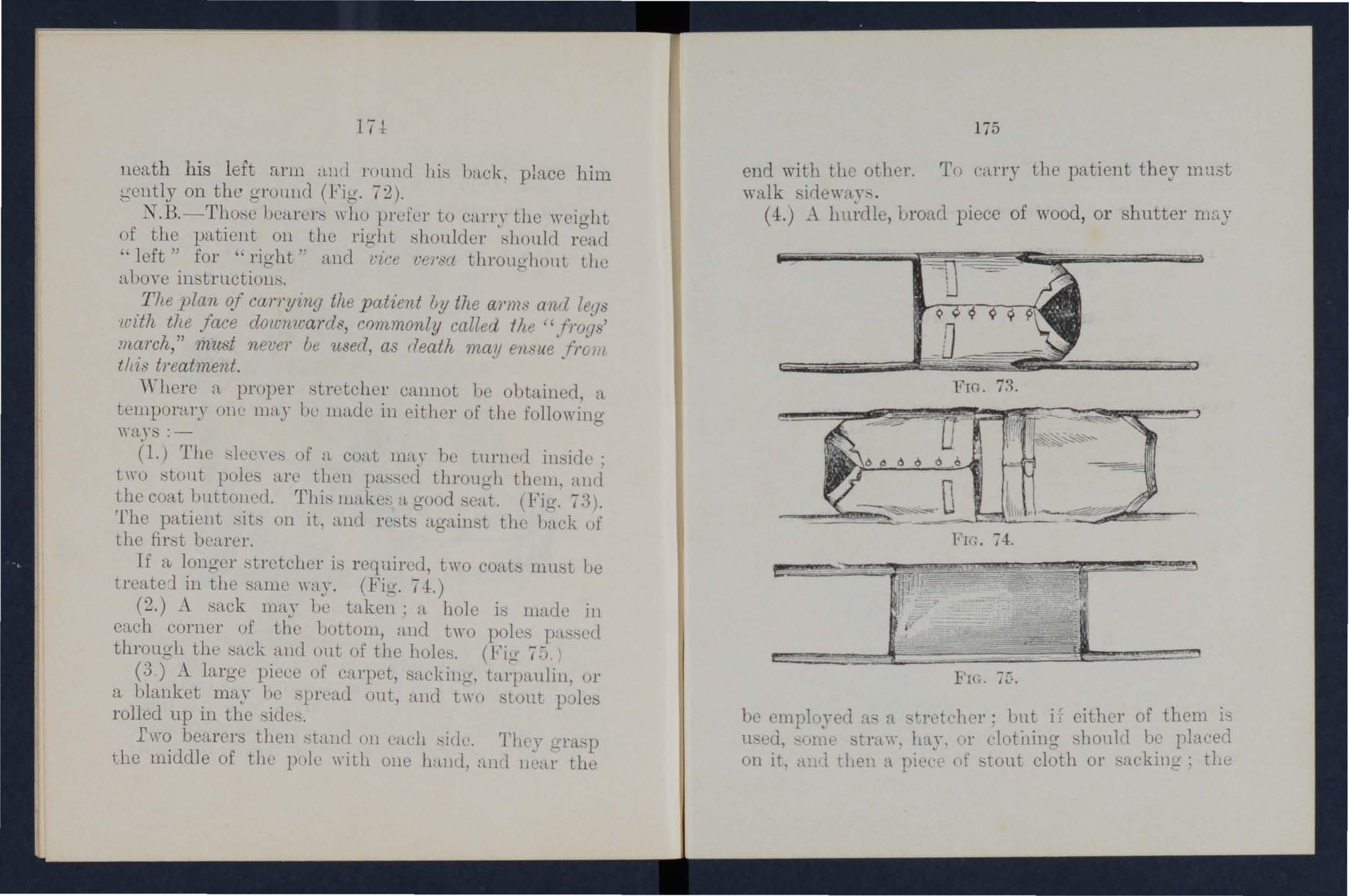
.FIG. iG.
l)e e,mployell [1"; a t]'C ,,11('1': lmt i I eithel' of them i' U'>l'Cl, tra\\, li'n', (11' ' l!onl<l he pbcec1
Ull it. allll t!tCll a pil'L:l\ (I!' tont cloth 01' tIle
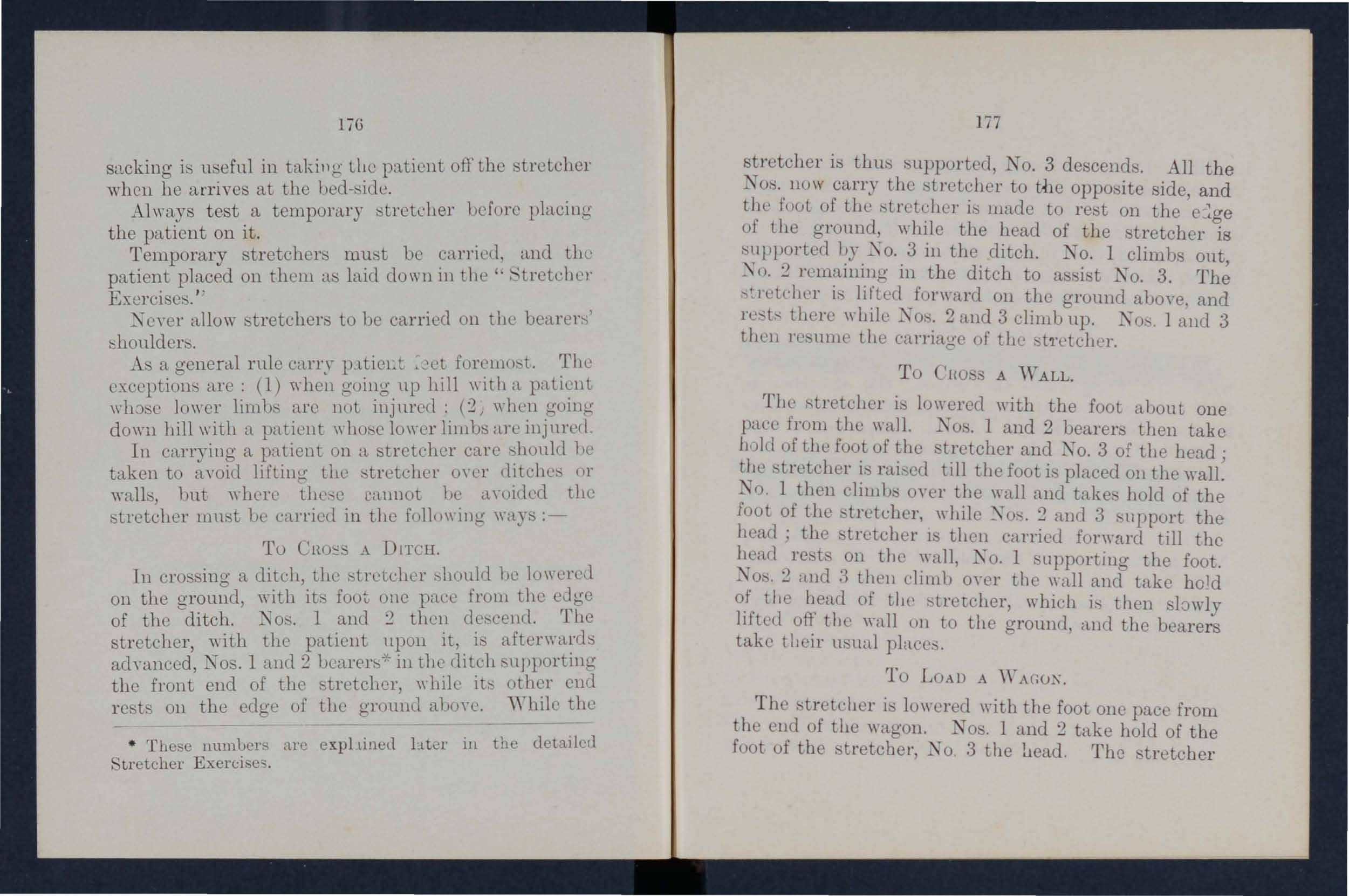
1i G
st1cking it> u 'efnl in tn.king Lllc patient ofr the stretcher when he arrives at the hed- 'ide .
Al ways test a tempora,ry 8tretdler ])cfol'e plncing the patient on it.
'remporary must be cHrriotl, lLnd tlll! patient placed on thelll a' laid down in the c, Exerci 0:, "
cyer ttllow'tretcher8 to ho carried on the uea1'o1'-:; ' ::,houlder '.
As a geneml rule 0a1'1'Y p ttiel:t 'rhe cx.eeptions aro: (l) going up hill" ith <t patient 10\\'01' limbs are nut illjured : (2) WhCll going dowll hill with n paticnt \\ 110 ' 0 10\\"er 1illlUS are illjll1'ed.
III carrying a patient on n. stretcher Ctl.re 'llOUlcl he taken to ayoid lifting the 'Lreteher 0\01' (litche ()r wall', but " 'here tho:-;e Cilnnot be a yoitled the stretcher mn ,t lJC carricd in tho foll()willg \\il)'8 :'10 "\. DlTCH.
In cro 'sing a ditch, the "t1'L,tcher .hon1(1 lIe 10\\'e1'e,1 on the ground, with it.. foot one pnee frOIll the eJge of the ditch. os. 1 and :2 thcll de .. ccml. The tretcher, with the ptl.tient upon it, i, aftenmrds adytlnced, 1 and 2 bearer * in tbe (lill:h. the front end of the stretcher, ",hile it. other end rest. on the edge of the ground a110yo. 'While the
• These llUllluers arc cxpltined L.ltel' ill the dctailell Lretchel' Exerci. C'l. 177
tretcher it> ,Ll ppurted, .N o. 3 de cencl. All the TO,'. nuw carry the ,Lrekher to the opp08ite ide, and the rUut of the it; wade tu 1'e·t on the e'::'ge of the ground, \\'Jllle the head of the ctretchcr is I:>upported 11'y Xo. 3 ill the ditch. :No.1 climlJs out :\ o. :2 )'elllainillg in the ditch to a .. it No. 3.
t I deber i.. liftcd forward 011 the ground al1o"e, and re-;t:-- there ",bile TO,. 2 and 3 clilllb up. XO:-'. 1 nnd 3 thcn l'e ' lll1ll' the carriage of the , t'retcbel'.
To '[W' A ,rALL.
The lowered with the fooL about one pace from the wall. X os. 1 and 2 bearer then take 1I.)J<1 uf tIle foot of the tretcher and X o. 3 of the head' i.. rai.eel till the foot i.. placed 011 the 1. 0, 1 then climb ' oycr the wall and take' hold of the foot of the .:trctchcr, while :\ 0-;. and 3 bllpport the head; the -tretcher I' tllell carried forward till the hTeacl rc ·t .. 011 the wall, To. 1 ' upportinO' the foot. ::\0,. :1 and :3 thell Clilllh oyer the "all and take hold o.f llie b,end of tIll' which is then 'lowly lifted the wall on to the ground, ancl the bearers take t lIelr ll.'ual place.
To LOAD A 'YAU()X.
The ,tretcller i' lowered with the foot one pace from the cud of the ,mUOll. .l: 0'. 1 and 2 take hold of tbe foot uf the ::;tl'etchel', No :3 the !lead. Tbe 'trctcber
17
i then l'ilisec1 nnd earri\.'cl fonntrcl till the front w'heels rest oa tlw floor of tIl wngoll. No. 1 then jlU: ps into the w,tg'Ol1, while T o. goo . to the hl'n(l or the stretcher an 1 helps No.3. The <:;trctcher i' then pll'hefl into the \Yclgon. If the tailbeard G'llln()t Le the stretdlCl' he la')iloc1 firmly to the ')i(le.., of the
To UXLOAD .A \YAGOS.
No. 2 and :1 t:tkc holel of the hend of the while No 1 get':! into tho wagon: tho ..,trelc:hcr is then gndually dmwn out till tll' foot-\\ hecl' l'c .. t Ull the edge of the wagoll. .:\0. 1 out of the wagon and \\ itil J.. TO. 2 take..; holel of the foot of the ·trctcher,' .L-o. :3 thl' helcl. The stl'ctGhcr i' then gentl:- clmwll H\Va,\' une pac:e nwl lowered. The bearer", tllL'u fnll in in their H:mal p};we:. ,Yhen foul' llearel'':! nrc attellrlillg to the patient, Ko .. 1 and 2 woul(l lift the foot of the :-;tl'etchel', ",tile Nos, 3 anrl 4 lift the hp;l!l. This appJie' tu <1 ditdl or wall, <1.' \Yell ,l1'5 to loading anrl nnlo,uling a \\,<16 un .

• 'l'RETCUER TRAN. 'PORT.
'1'lt e "FurlLy." . 'tretc:hcl';' (Model 1 99) are of nz., "Ordinary," "Tele caple-handled," and Pollce. 111 general principle they are alike the component part l)oillL?,' designated' the poles:
;:)TRETCUER-CLO::lED.
Fw. bar:), foot-" heels bed pillow
S.le \. anc 'llll/.!'i. ' ,
The Ordinary, 'tl'ctcher (FiO' 76) is I- f t 9' I . lClwth '11 I If' · 10 . ,.,., I ee 111e 10 - III . ,.., ,c l( (Jot wide. The bed i· 6 fe 11l. lcl1dh, and the hcltlcllc' 10* inches The f t ,} l'aI 'e the .'treteh l' ! l' 1 - ' 00 -" lee tl I I e - llle 10.' from tho ((round At 10 lcac of the t· t.} .', c· pillow -J' I 1e C leI L a canya overlay (the ,< " lIC 1 can he fillod with hay, :" 2
FIG.1 0 clothing, etc., to form a pillow. The jointed traverse bar ' are pro\"ided with joint·, 1';0 arranged as to guard against the possibility of tte bearers catching their fingers in them when opening or clo 'ing the sLr'teher, The pole are rounded on the top, and have an inside bevel to add to the comfort of the patient and prevent ntting the cam'as. The Telecopie-hnl1clled pattern Vig. 77) i veryilllilar lmt i' () arranged that the h .ndle can be lid underneath the poles. thu' rec1uc iug the length to 6 feet, the length of the bed lJeing G feet. This arrangement i' of gr0at yalue ,,·hen ,\"orking in confined pa<.:e, or "hen a pnti<.:Lt ha:5 to be taken up or down a narrow tairca. ·e ,,,ith ,'harp turns. The Police stretcher i imilar to the Ordinary pattern, but is more strongly made, and 11a', in addition, strap for securing a refractory patient.
'When closed, the pole of the stretcher lie clol together, the trayer'e bar l)ein lf 1)U1t inward. the can"a bed 12eatly folded on the top of the pole' and held in position by the sling \\ hi<.:h are laid alollg the canvas, and secured by a :::.trap plaeed tnU18Ycrsely at the end of each sling bein Ct pa ' ed through the large loop of the other, round the pole and bed, and then buckled.
In closing a stretcher carehould he taken to rai8e the centre of the canvas when pu 'hing in the lrayer c bLLr, as it is otherwi e liaule to get caugh t in th joint of the traverse bar.

1 1
To prepare, ,or open, a t-itrctLher, nnlmcklc the transverse ,traps of each. ling; 1'el110ye the from the ,'LrcLc h er' sep;tmt-. the pol,'; take hold of each traver."e h .l.l' (tn(l chaw it forward. The Hlino's will then he follle(l to hnlf their lell:-' 1. one ])I'il?cr laid neatly oyer the !JamUl'. at C,H:11 l! . the A.' a genen:l nlle, the .. \.. be prepared hy .. 1 awl 3 1)eal'e1'-, III E\cn:i .... I. II. and IiI . and 1w :) III Ly 1"" '1'1] ." J •• : .l· l he lc:-;e )earer:-; wtll If rc'plll'ecl assi t the other bearers nttc!lcllllg to the paticnt' injuries, ...\ y.ario\v lIlo\"cmentf) detaile(l in the follOWing ExcrCl es .jllHllrl ])e c<uTicd out teadily the I )cal'c.r'l "orkLng ill uniol1, hurrying hcino- ca ,lllel c:-err attell.tioll 1) -jug pai(l to the he,Hel \\ h0 e lluty It I to gn'e the word. of command.
• 'TRETCHER EXERrrsF. . ,
(11',\ \\ n up hy ,'ir .J uhn Fmlcy and reyisec1 III 190-1: to \\ith the drill' at'loptc(l by the Royal 'JIedlc ,\ 1 Corps :-
EXEHCI E X o. 1.
FOR FueR BEc\ RERS.
1. The Intrudor .eled· the hearer n <111(1 nnmbers ti1cm- 1. 2, :3, ./., at hi one man he tnller awl :5tronger t!t;lll the other', he 'hould be
styled No. a. he " 'ill baso to bea.r tbo hea.vier part of the burden .· All orders a.l'e to be gi \'en hy No, 4-, 2. "Fall In. ''
At the words "Fall in," Nos. 1, :2, anel 3 take pORition on the left ; 1e of a.nd facing the patient. o. 1

FIG. 7 .
places himself a.t the patlCl1t" kneer-, No. 2 at Lhe hips, No.3 at the patient's shoulder. At the same time No. 4 pa ses the prepared .·tretchel' on the ground by the right side of the patient about two
• Bearers should , however, be taught to take any of the positions named in th e following Ex.erci es, whether thltt of .No. 1,2, 3, or 4 bearer.
183
away from hill1, and then takes p"jtiOll oppo.' jte to and f'll·jng :2. " Ready. "
The l)ca rer.· kneel (lo\\'n Oil the ldt knee and take hold of the patient, ,,--0. 1 pal:>l:>ing' hi hawl' and fore
FlO. 79.
nl11l.' henenth the legs, wjrle apart . No.'. :2 and 4- pa.'.· their hand:-; and iorcarlJ1s llcncath the patiCl)t\; hips and loint>, and gm.p each other'.' hands ... To .:1 pnsse.' his ldt hnncl across thl' p<ltient\.; ehc.,t and uncleI' tll· right . boulder, ,Illrl hi. ' right hand lJeneath thc lefL ",hou lder.
4. "Lift."
On the word" Lift, " the bearer raise the patient gently and r e t him on the knees of o. 1, 2, Clnd.3 bearers; as soon as he is sec urely re ted, No. 4: dIsengages hands with No.2, runs round by the head of the stretcher and places it under the patient, clo etotheotber .FIr: .
bearers' feet, being careflll that the pillow i. immediately under the patient" h ead (Fig . 7 ') ; he then kneels down and lock his hand' with tho'e of o. (Fig 79).
5. " Lower. "
The becl.ren; place the patient on the ·tretc..:her (F ig. 80), di engage their hUJlds, and then stand l\p.
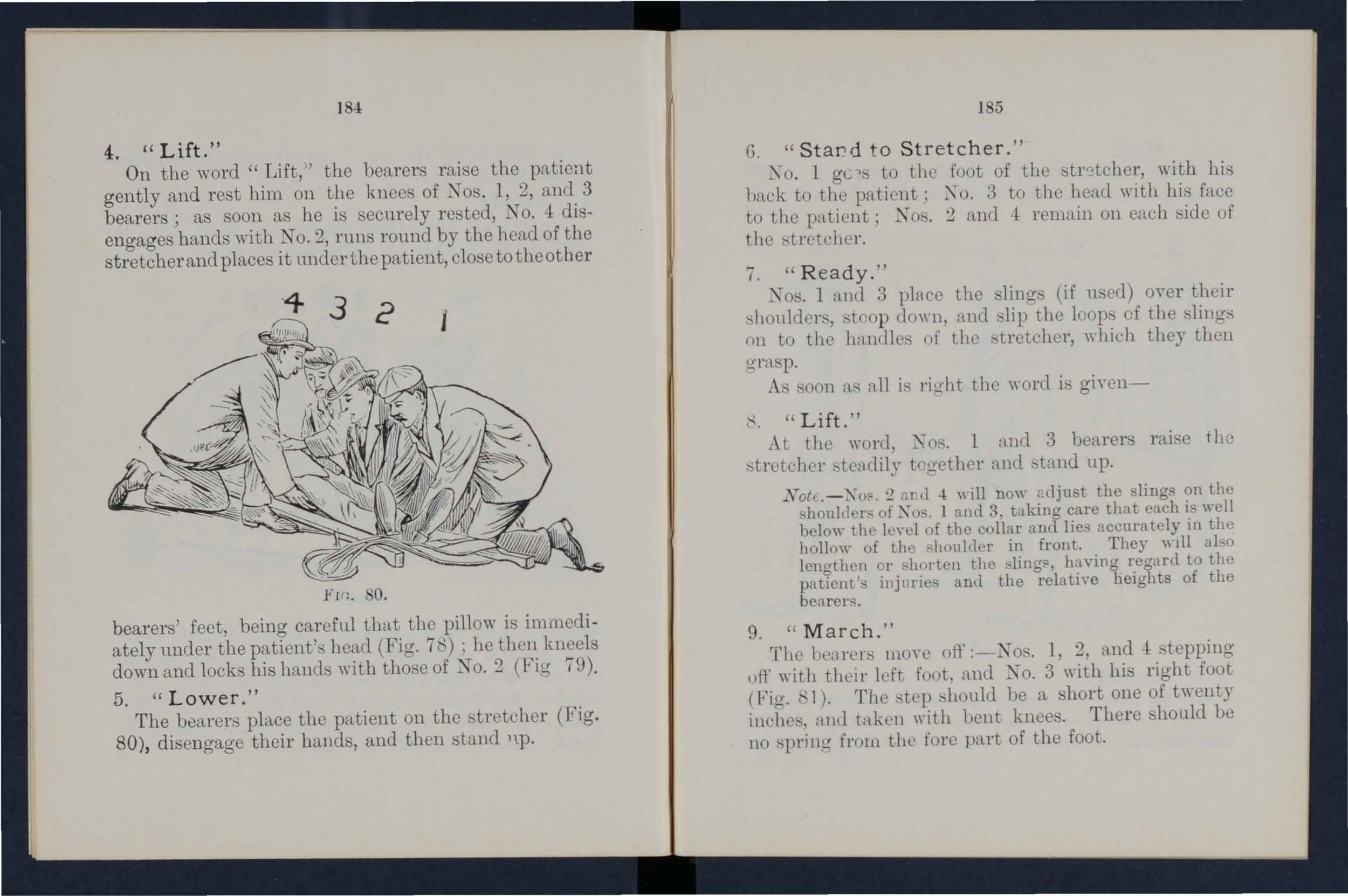
1 5
G. " Star: d to Stretcher. "
X o. 1 gc" t.o the foot of the btr"tcher, with his hack to the pati l1t ; X o. :3 to the head witll hii") face to the patient; N o ' . 2 and ,1 remain on eac..: hid e of the stret(·hel".
7. " Ready. "
-"-TOS. 1 amI 3 plnce the lings (if u . eel) o"er their . toop (l(m 11 , anel 'lip the loop., of the . ling , nil to the of the .'tretcher, whic..:h they then
As .' oon n.' all i.' right the word is giyen-
" Lift. "
AL t.he word, 1 nnd 3 hearers rai 'e the stl'etc..:her .tendily t('gether nndtand up.
2,,1(1..1, "ill now a djust the slings shoulder of Xns. 1 :lilt! 3, taking care that each I' well below the len:l of the collar and lies accurately III the hollow of thl) shoultler in front. They WIll &bo l enuthcn or shorten the having regard to the patient's injuries and the relati\"e heights of the bearerR .
9. " March. "
The moyc ott' os. 1, 2, and 4: .-tepping ufl' with their left font, nml o. 3 with his right foot (Fig. (' 1). Th e ' tcp hOllld be a hort one of twenty illUhc.', and tnkcn with bent knees. Th erehollld be no spring frOtH the fore part of the foot.
) 6

10. " Halt ."
The de tination being reitched, on the \yo1'(l "Halt I) being given, the bea,1'81's 1'e111[1,in in position. Fig . 81.
11. " Lower."
At this order the bearers the stretcher gently on the ground, . lip the loop. ' of the sling,> off the handles of the stretcher, 1'emoye the iron.! the
].7
shoulder.', anel then . tam1 up j CIUC hcilJg taken to let tho patient's J'e('t l'caGh the ,!!l'!llllJd l)cfore his head.
12. " Unloa d StT e tcher - Re a d y."
The hcarcr ' prepare to take the Ihltient off' the .'tJ'ett:b er, a' at Unler.· :2 itucl :3.
1:1, Lift. "
.,. The raise tIle a at Order 4- (Fig. 79) ; i\ u. I III tlJlS t:asL" hands frOlll So. 2, l'elllOye the str'tclJer (Fig:. 7.'), and re. hiij former p.ol'>itioll. If lleces:-.Hl'Y, the hearcl'l'> \\ill thl'll·teac1ily 1'1,'e. to!!,'ethel', anr1 cill'eflllly carry the }latil'llt to the yelude, l)cd, or lither place to ",hi"11 it has bocn to (;Ol1\'C!Y him.
1+. "lower . "
The patient is ('areflllly Im\-el'cc1 .
1. N llm her tIll' bearer.. 1 2 :1
All \\"ill he giyen 1,y' Xo. who will look after tho lllJlll'cd p;ll'L of the patient' 110dy or limbs, to see that no handage.' or splintl'> llecomc (li 'placed, awl abo that N"o. 1 llcnrcl', in lifting or carrying the .. tretch 1', doe. ' not tOUGh the patient'H f et.
2. "Place the Stretcher. "
No. 1 taking the foot of the 8tretcher, and X o. :) the head, place it in n, line with the patient" body, the foot of the, tt'etcher being clm;e to hi::; head.
" Fall In. "
Ko. 1 place him. 'elf on the left of the patieut
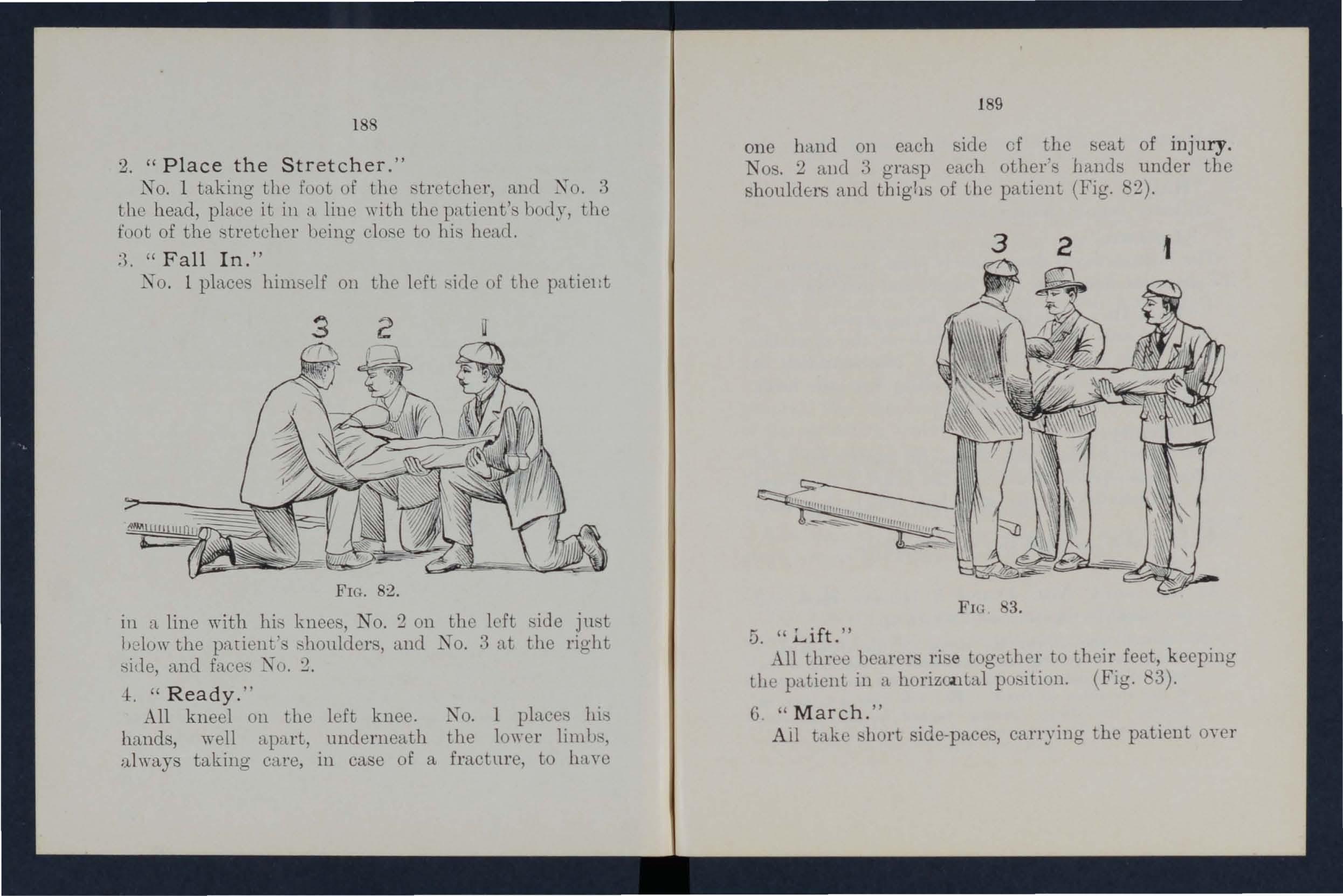
FIG. 8:2.
in a line ,,·ith hi , knee , No. :2 on the left f3iue ju·t
b 210w the pil.tient" , houlder , and No. :3 at the right t-li lle, and face':> K o. 2.
.-1:, " Ready. "
All kneel on the left knee. No. 1 place::; hi::; hands, well ap'1.rt, underneath the lo\ycr limh-, ;:tlways taking care, in ca e of a fracture, to have
189
one h,md on each ide cf the seat of injury. Nos. 2 and gnvp each other' .' bamlf3 under the shouldE-I.· and thigh::; of the patient (Fig. 2).
3 2
3.
U. "Li ft. "
All thrc0 bearers ri'e together to their feet, keeping the patient in a. horizunLal po. ition. (Fig. ' 3) .
G " March. "
All take .. hart ide-pace. , carrying the patient oyer
the tl'etcher until hi' head i.' immcdiately auove the pillow.
7. " Halt. "
All three bearer remain .'Leady. " Lower . "
The bearers ·toop clowu plnc:e the patieut on the stretcher, clisengi.1ge their hand:..;, <lnc1 then stand up.
9. " Fall Ia. " 011 thi' ofder 1)eing
No. 1 place him elf at thc fuot of the :..;trekhl'r "ith hi uael,: to the patient, 1 O. 2 phtcel'5 hilll.'elf at the left ide of the patient, and .Jo. 3 at the head, with face tow<lrcb thc patient.
10. " Ready. "
X os. 1 and 3 place the sling's (if ned) o,cr their Shollldcr:s, stoop dO\nl , and . lip the lo!)p ' of the sling. on to the of t be stretcher, \\ hich they thelJ grasp.
A: .0011 a all i right the wO:'cl i gi \,l'U11. " Lift. "
At thi.. word, X os. 1 and 3 mi:-;e the l'5tretehel"teaclily together clllel .. tall(l IIp.
No. 2 will now aclj llst t lip slings on the Hhonldcr,.; of Nos. 1 and 3, hking care that each i.' "ell below the - level of the colhr, and lies accuratel\' in the hollow of the houlder in front . He will a1,,0 lengthen or shorten the . ling.' , h:n'ing regard to the patient's injurie3 and the relative heights of the bcner::l.
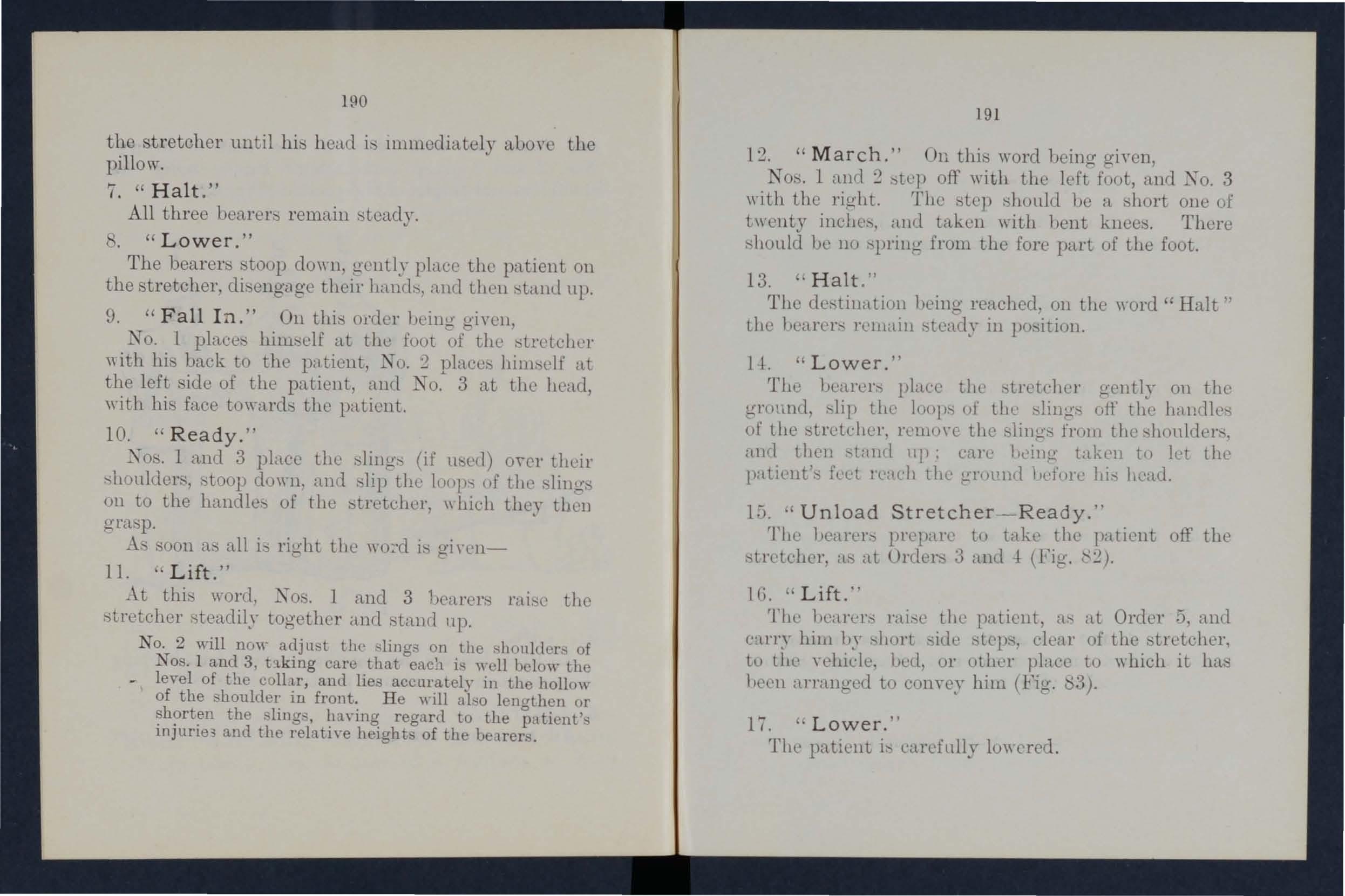
191
1:2. (( March. " Oll this word l)eing giYcn, No... 1 and :step off with the left foot, and 1\0.3 with the rig·ht. The tiLep 1)c ahort one of twenty inches, HllIl taken with hcnt knec!:). There :-;llOllld 1)e 11<, spring from the forc part of the foot.
13. c. Halt. "
The c1c.tilwtion bcing reached, on the ,yord (( Halt " tbe 1)earL'l':-; l'L'lJlaiu ill po.-ition.
l ·t. " Lowe r . "
1'11,· 1)enrer place the :-;lretehcr gently on the grunnc1, slip the luop.. of tbe ·lin;..'.·.. oft' the hllwlles of the .. tretelter, rL'lllO\'C the . ling' frOlll tbe 'hnnlder.·, auc1 thl'll "Lalld IIJl: earL: l'l'illg takl'll to let the patil'ut' · fL' d 1'l';lch thc gTl1l1ucl \,d(Il'c lli ' hC'ad.
13. " Unload Stretcher -Ready."
The 1)earer prepare til take the patient off the ' lrcteher, a ' at Urders :3 and 4 (Fig.
IG. " Lift. "
The 1)earL'l':-; J';li;o;e the patient, ;h at Order :-. nnd earl''\' him 11'\' short .. i(le sleps, clear of the ' tlctl:hel' tu till' bell, ur other jJ1aec tu \\ hich it h<1 ' hel'11 to him (Fig. ' 3).
17. " Lower. "
The piltil'llt i cardully luwered.
EXERCI E X o. Ill.
" THE:\" 0XLY THREE BEARERS ARE AYAILABLE A;\D TilE 'TRETCH ER CAXNOT BE PLACED AS ] I .
1. Tho III tructor number::; the hearer '- 1, 2, 3.
All order' "'ill be giYell 11}' 1\0. 2.
2. " Place the Stretcher ."
.L T O. 1 taking the foot of the ·trct<..:hel' and ..l T o. :3 the head, place it on the ground by the .ide of the patient, and a::; close to him as practicalJle.
3. " Fall In. ''
rrho three bearer::; take the arne po on one side of the patient, a laid down ill .:\ o. 1.
<1. " ReaJy. "
No::; . 1, 2, and 3 kneel d\)\\ n 011 the Idt 1,llee, ptlcing thernselye::; as clo::;e to tbe patient cu; the',)' <':ol1Yenielltly <.:an, and then take hold of hilll n directed in Exerci::;e o. I.
5. ' Lift ."
J 0 1, 2, and 3 rai e the patient a' directed in Exerui'o No. 1., and thon moyo in a klleeling poitioll up to the stretcher (Fig. 4).
6. " Lower. "
The bearers bend forward, carefully lower the IJJ.Lie n t on to t h e str etcher, and di engage hands.
19.3
7. " Stand to Stretcher ,"
At thi::; clircdiOll all the hearers .'tanrl llP; 1 g.oe· to the foot, X o. :2 relltains in po.'ition at tho SIde, al1(l 1\0. :3 goe::; Lo the head of the ·tl' -teber.
" Ready. "
N 1 and 3 plnee the sling'. (if u 'cd ) oYer their

Shoulders, .toop down, ,Iud. lip the loop ' of tho 'ling on to tbl' halldle· of the ::;trl'tcher, which thcy then gm"p.
9.. L i ft . "
o. 1 all( 1 3 hearer: mi 'C the ·tretcher temlily together aml stallll up.
o
]9-1
2 will DOW al1jnst the "lingB on the . houlclol's of Nos. 1 aad 3, takmg care that each is well helow the level of the collar, amI lieB accurately in tho hollow of the shoulder in front. He will also lengthen or shorten the Blings, having regard to the patient's injuries amI the relati\'e height'> of the hearers.
10. "March."
Nos. 1 and :3 tep oft' with the left foot, and ... 0 \",ith the right. 'rhe tephonld h-:- n short one of twenty inche', and takcn "'ith hent knce.. There sl10uld be no pring from t.he fore part of the foot. 11 "Halt."
The destination being rC<tched, on the word" Ralt" the bearers remain tend), in po. ition.
12. " Lower ."
The bearer place the ')tretchcr gently 011 the groHl1ll, lip the loop of the sling. oft' tIte hnlldle:-, of the b'etcher, remo,e the f:;ling" from the ,bon lelen;, and then tund up, care heing taken to let the patient s feet reach the ground heforc his head.
13. " U nload Stretcher Ready. "
No. 1 place.. himi-;c]f on the left side of the patient, and in a line "'ith hi.. knce:-., on the left side just below the patient'..; "ll<lnIc1l' rs. III d ;\0. :3 at th right side, ancl face . X 0.:2. J.J] kn .,,] on the left knee. No.1 places 11i. 11am1.', \\ ell apart, 1111lIerneath the lo\yer limh:l, nhay. takin!! care. in ('ae of a fracture, to haye one hand on ecil'll ir1e ,)f the ·ca1. of
195
iuj llry. NOH. 2 and :3 gra. p e,teh other' hallc1. llncler the shoulders and thigh.' of the patient. ('ol11pare Fig. 2).
U. " Lift. "
The hearer.. ri:-:;e together to their fec>t, ke ping the patient in a horizontal po .. ition, n11(l him In' . hOI t sid step', clear of thetretcIler, to the yehiefl" l)cd, or other pIaee to whieh it bet. l)een to eon Yey him (Fig.
1:">. ' L ower."
The patient is carefully lowered.

EXER('I:-)E Xn. IY.
Fun 1::. E IX :JIrxE. AXD C'UTTIXC, "IlEBE '::"Y(J ME. - OXLY CAX BE EXGA(,ED.
X()s. 1 and 2 \\ ill eareflllly plaee the retcher ill line with the injnrerl man's 11orly, the foot of the lJcing, if po ·ible,;" clo.-e to hi.' head.
Xo. I .. tnHIclle ' the paticnt'. ]egs plneing hi ' right fo()t, " 'itlt the toe turncd ont\\"nrcb, a little below the patient' · knee.-, and \\ ith the tOl' of the left foot tlllwhing the It'd of i\o. :2: he then stoop clown:
• It iq not adyisahle to I, too particular as til the head OJ' foot of a stretcher in a mine , a. it. ,,·ollid probabh- he quite to l'e\"er"e it . . o ?
pas es the left hand uncleI' the patient's thigh' and the righti hand acrOE. and Hntler the patient'.' cahes.
o. :2 places his feet Olle on each side of the patient between his bod V and arms, the too of en,eh foot as near the armpit : it ' po 'sihle. He then stoops (lown and pa ' 'e bi hand ' beLween the ides of Lhe chef:5t

1 . 11 .'10 85. and the arms underneath the shoulder, and 1 )el;:8 the fingers (Fig. 5). If the patient'. ' arm.' he llninjured he may put them round the nCLk of No.2, and by this means greatly cU:if:5i -t him in lif ting.
'When both are reach X o. 1 will gi \'e the oreler " L i ft and m o \ e f or v:ra rd. " The pntient i.' then to be slowly lifted just 'ullicient to clllo\\' hi .' Goel)' to clear
197
the tret<..:her.. Both bearers will slowly and gradually move the o. 2 by very short . teps, No. 1 by bendll1g l)l.' budy fOl ward as much a ' he can leitha/Ii ?novz'ng his feet (Fig. '6). No.1 now uj\,cs the o1':ie1' " H alt" ",herenpon No . 2 remaillS .. and f\o. 1 ;lrh-aUCl'!; hi:-) right foot to his left, and
'6.
agn.in acl"Yance ' his left fuut till tlle toe touches the hccl of No.:2. thcn giyc ' the order '.' A dvance" \\ hen the patient will again be moved IUr\\ard: 'r.he 'e lllo'; elllcnt ' arc to 1)0 rcpeated unW the pabent 1 oycr thc f:5tret<..:her, \rhell be i ' to be gently lowered.
The bearer.' will then ad in the ordinary manner a far a the natl1l'e of the locality will permit.
The Ashford Litt e r i· 1l1f1.de np of either of the Fnrley .. tretchel'· mentioned on 170 <'1.11(1 a ,,-heeled nnder-<:nrriagellmln wate r proof hoocl anel or, if preferrC'd, n light wet-re:::;i::;tillg CcUlya::; cover. 'I hI..'

FIG. 87.
stretcher b kept in po:->ition on tbe by the foot-wheel, whiuh tit into ,lot , III the ::;lclc::; of the under-carriage, and it can ue r?ll1oyed at plea. ·ure. The under-carriage i' fitted with a cranked axle, wh ich allows the bearer::; to pass with the Htretchc r
199
between tbl' \\ heel::) in.'tcncl of liftillg it over them. At l)()tlt end, are two leg fitted with antomatic ,'01£locking \\'llicll allo\\" the leg. to IJe turned up a::; handle.. \\ hOll \\ heeling tbe litter, <tll(l:;ccurely lock them either i.l" or halldle. Tbe hood and apron fit illto .lTC\\ L,(l tu tbe ::>tretcber. In \\ heeling tile littn, C<ll'e ' ltulllcl l)e takeu tu keep the patient ill a. horizontal pu:itioll. .'lwuld it lJe two bearer. can ea::,ily lifl thL' lrtter ancl patient.
The Rea-Edwards Litter, illtrodw:ed ill 1004, IS U::.e<1 ill lWlLln!' lLL , lUllL'l', and one mudel of it i. fitted wilh I'lletullatie tyl'l''''' ',vhich H(ltl itlllllcnsely to the lit' L1le pallellt allli tu the ease of prupubiuu .
200 CIIAFl'EJ. XI.
(Being the F1jch Leclw'e fV1' Females only, in acco,'([rj,lIce witl. • 'yl abns 5 .)
BY E. CO GRAYE, F.R.C.P.I.PHEPAl1ATlOX FOR OF .'...CCIDE:\T CA E
'IYHffiX ne\Y8 of an aC<.:ident comes, pl'cpnmtillllS at once be made , ' 0 n,' to hayc e\'erythill!! ready hefore the inj llred per,'on i lll'ought in. Of Cuun,\(.! thc prepcll'atiollb needflll ,,,ill y,u',\' to the natl1l'e amI extent of the inj my, but the me the chid thing.. which lllay hn.Ye to be dOlle
enOICE AXD PREPARATlOX OF Roo'f.
A room ruut be In a hHl ca . e thi ' lioulcl h e one easil\- reache l1. a,' it i. ditlknll to CHlT." all illj nred per throw,'h llarrO\\' pa ','a"'c. up,- ' tair . L nIcs there is Ollle ,lH.:h rca 'on 1t, the inj nred pel' 'on" o\\'n room i::l be ,t. , ,
The Wo\Y to the raoUl must he c1e<l1'e(1, flll'nitm'e and 100 e mat" in the hall or 111 lu111ne ' , hould be removed. If the injured pl'r::lOll i carricd 011 a door or 'hutter, 01' even on ,"\, ,'tl'eteher, a couple of strong kitchen chain.; should he placed to support it, \\'hc\.'eye1' the uearcr ' \yould uc hkely to require rest
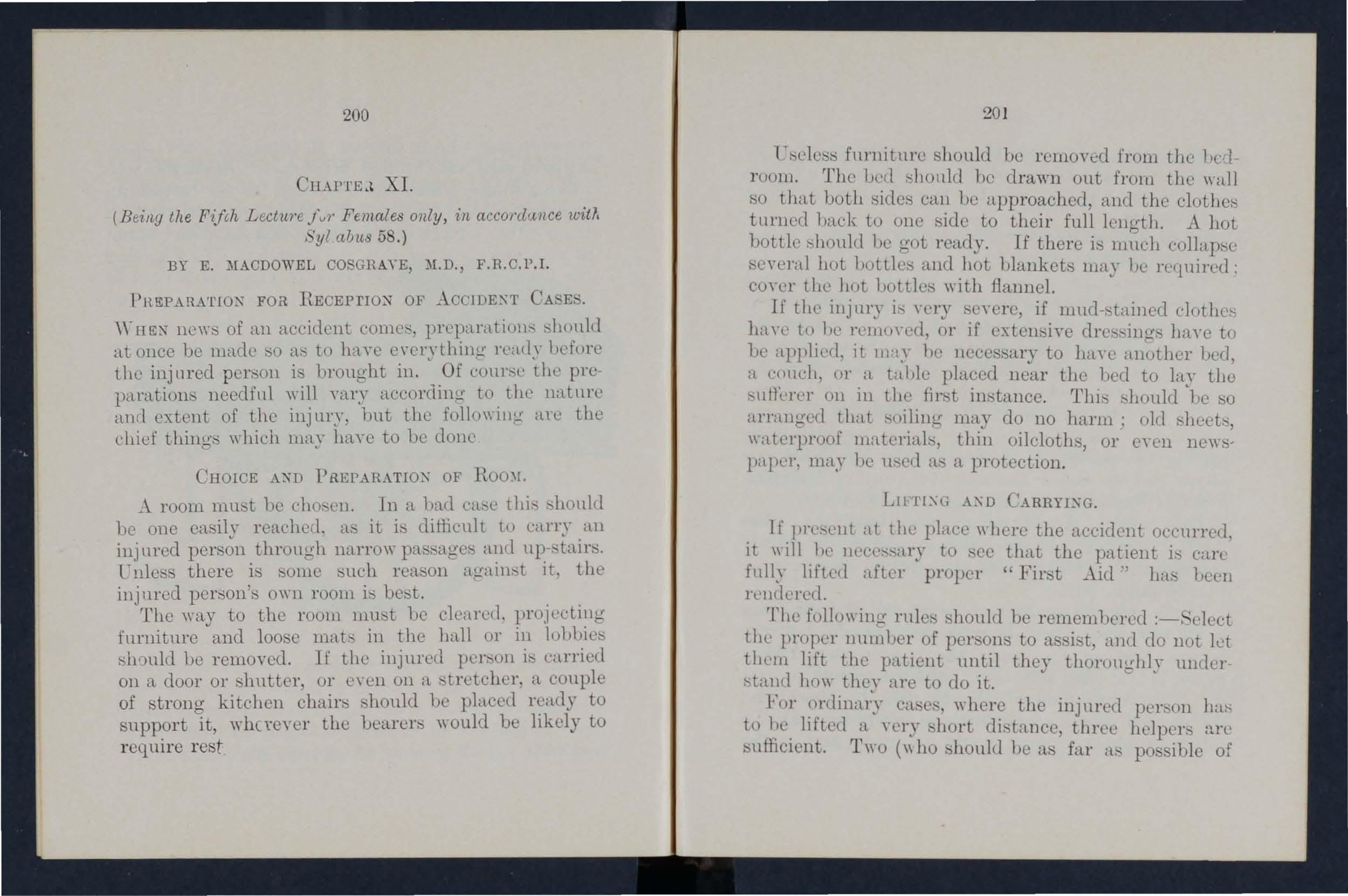
20 1
r de.'!:) fnl'lli tn 1'<,) should 1)<.) rClllOvc:d from the 1Ie 1rOOlll. 'l'he bed . holllrl he drawn out from the \\ all so that uoth sieles Call l)e approached, and the clothes turned 1nwk tu aIle side to their full lcngtlJ. A hot uottll' l)e got l' ady. If there is llllll:h collapbc . eyeral hot bottI,s and hot blankets mny be re1lllirec1 : co\,er tbe hot l)()ttles \\'ith flannel.
If the illj my i ,cry ,'eyere, if llluc1-tainecl clothe ' linn' tn lIe l'Clll{)Ycrl, or if extell 'ive dre . illg.' have to l)c applied. it lil a ,\' 1)(, llecc', ary to have allut.her bcd, a (.'(ll1ch, or a Lallle placed ncar the l)ed to lny tho sufferer 011 ill the fin-it in.'tClnce, TIll,' ,llOUlcl "1 ) c so arrallged that soiling may do no harlll ,: old sheet. , waterproof lllaterials, thin oildoth', or evell ne,\, ' , ptl}ll' l'. ma." lIe H, e(l ,l.' a protection.
L[I A:\D 'ARRYL-G.
If pre . cllt ill the place \\ here the accident occulTed. it will l)e llc<.:c-;sary to .'ee that the pntiellt i care fully lifted after pruper "Fir -t ..Aid J ha lJecl1 l'l'IHlcre(l.
Thc follo\\'illL( rule,' be rememl)cl'cd :-, ' elect t he propel' 111l1; lJcr of per 'on ' to a 'ist amI do not let thelll lift the pntieut until they thoruughly ullcler,taml how they nrc to (10 it,
Fur <:a. ·e,', where the injured pcr"on has tu he lifted a yel'yhorL three helper. n,re :sufficient, Twu (\\ ho 'huuhl he as fell' as pO ' ible of
equal height) are to Leal' the weight, the third to support and tCl.ke cilaro'e of the injured pm'L, rrhi ,' it) be ,t clone by cl, per 'un who ha' Lecll through a <c Aiel" couroe.
1£ the injured per::;on ii:l inscn::;iblc, another helper t)hould 'upport hi head,
The ulle at c.H(;h side, ::;huuld kuccl Oll Olle knee, <md pm;::, their under the paticllt':-; 1)c1Ck at the lower part of the nIHl under tll<.: cia 'ping each hi;:; l'i!!ht hal1cl in the other',' left, The injurecl patient ,'hould, if praetical1k, phce his nnn.' round till.' neckb or the hearers.
'rIle third helper attclld to the scat of injury; if i::, a fradul'ccl lilltl), he sholllcl };llPPOl't it 1)), plm:ing the pallllb of Ilis IHlllll' uurler the liui1J, 011e ahove and one belo\\- the :,.,eat of the injury it firmly uut <lyuiding' Ullneee . ' l11·)' pres ' me,
The helper::, :-should remain tim until tile ()nler , Lift" i ' gi' en, and then theyhonld all lift . 1uwl,Y and stea.dily, avoidillg j'Ll", attempt· to change position of hand::;, etc.
H the injured persall i, ' to Lc plaecd on a ;:;treteher or ::;hutter, thi' should be pr viom;ly placed with the bottom end at hi ' head; the bearers shoulcl then move, Ol:e at each side of it, until the patient i' oyer it. The word (( Lo\\'er" 'hould then be and the injured per un 'huulcl then be ,lowly lowered. A pillow or folded-up cout should Le ready, and a' the
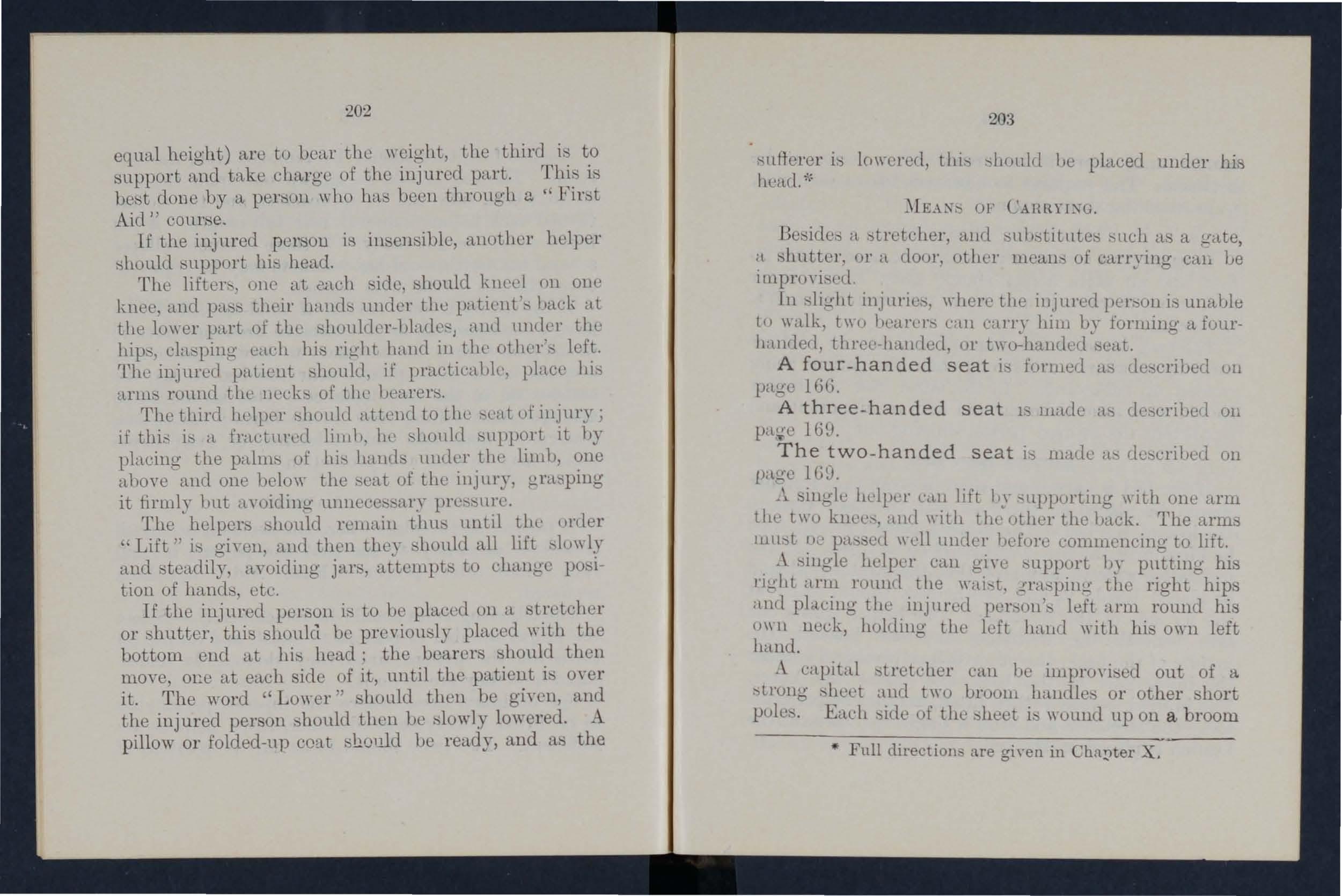
203
snfferer i:-, lo\rcl'ecl, tlli" 1)e placecl uncler his hmcl. -!:, .\1EAS:-:; OF
Be'icle.:; <l stretcher, <ll1cillhtitlltc, ' sncll a ' a uate a ::;hllttcr, or a cloo!', other mean of cC1lT\'in rr improyi, cd " 0
In :lig-Ilt injlll'iu" \rhere the iujurecl per ' 011 b unable to walk, hru hearer.' call earn' llilll Ly fOJ'luiu{J ' a fuurhallded, tltl'l'e handed, 01 eat. .
A four -handed seat i funlled as de::icrilJecl UtI luG.
A three-handed seat 1. lllade Hs (le-, cribed 01.
The two-handed seat is made a ' de . crihucl 011 l)<l!}.·e U;O.
'iude llducl' L'llll lift 1lY:::iupportillg \\' ith one arw tlte two knee, alld witll tlte uther the llaek. The arm lUll til ": pa 'cd \\ dlullclel' beforc cOllllllellCin!! to lift.
.\. , iug-le helper can gi :",upp()rt hy putting hi::; runn(l. tl.le the right hips and pLU:lllg till' lllJIll'ed per-;oll's left anll round his 0\\ 11 neck, hulding the left hawl with hi' own left hand.
.\ capital . trdcher can lIe ill1pruyiec1 out of a "trullg . lleet anrl t,,' o Lruunl handle. 01' otherhort pule. Each side of the ::;heet i wuund up on a broom
204 handle until thero is ju t room for a p to lie between. This requires four oe"l.1'er , tI\,'o at CHell 'ide, to prevent the sheet lipping.
In carrying a stretchcr up ,'ta il" the hC,Hl go fir't and an extra. helper t'lhoulcl at the In\\ cr end, ::;0 a to rai 'e it anel kcep th e stretchcr llcelrly horizontal.
The two, three, or foul' -hnnd ecl Dcnt ma)- 1IC fur carrying up tail'S j or a 'trong c;hail', the pnticnt heing carried up backward " In the latter ca, c uuc h elper should walk after the chair and help to lSUppUl't it, ,mel to pre\'ent the injured per '011 ,'lipping out.
If the bed i narrow <tll(l therc is rO()JJ1 he , h ould be placed on the floor \\-ith thL' hL,Hl clo,'c to the foot of the bed. The inj urcd per,.,oll ,.,11011111 then be lifted over the foot and plac cl on the 1Jell. r r the 1l 2d i' too ,,,,ide to admit of thix, the . bonld be placed beside it, and 1,\\'0 helper::, ,laud nt the far side of the ,tretcher, One helper pa, se, (lne ann beneath the shoulder' and one llencath lhe middle of the back, the other helper placing 11 ', nnder the lower part of the hack and uncleI' tbe knee'. The injured person is then lifted, another helper pn11,' away the stretcher, and after a single forward the burden is placed on the bed.

205
A finn lll;1,ttre llOt a feather bed, should ho ::;olecLcd. i r t here much inj ury, or if clrcfl::;ings lHl,Ye to he applied, n. draw -sheet ought to Le placed 011 the heel. It should he of [our or more thicknese. , extcllcl aero,'s tho 1Jo(1, a.nd reach from the middle of the patient'. h,wk to the knees. A piece of waterproof ,hccting 01' of thin oil-cloth should be placed under the draw-.heet. the draw- heet becomes :)oiled, the ,oile(l portion ,'hould be rolled up and n. clenn part dmWllllloothly under the 1n fracture of the leg 01' thigh, ,prained aukle and .·Ol1lC ?ther ca,'es, <1. "cradle J) (Fig.") ::;houl(l be llllproned. The tve of a "cradle J) i to support the and keep them from pressin tr on the limh .(l"it5'. K0) three-Ieg,red ·tool (Fig. 90), and sllllilar nrtlcl' may he u, ed. .A cork, 'row pa,erl through with it, PO;'lt guarded by a cork, aIHl tied lly ;.;ll'lllg tu the bed or a nail in the wall \\ illl'l'lit'\"L' the pre. nrc of the bed-dothe::; eH'eutually.
HE)WnX G TilE CLOTHE'.
In takin:: l·lnthe uft' au injnred pCI' 'on a fcw rulc::; ·hOllld hc j,urnc III lIliml.
In ,'erio\l;'; Cill' it i' much bettcr to 'acrifice the clotbc:s than tu rull any rd\: of ineroa 'ing the injury.
In rell1()\'ing it cont, de., in a en e of fractured arm till' ullillj me(l ann be drawn out nr::;t.
FIG. 90.
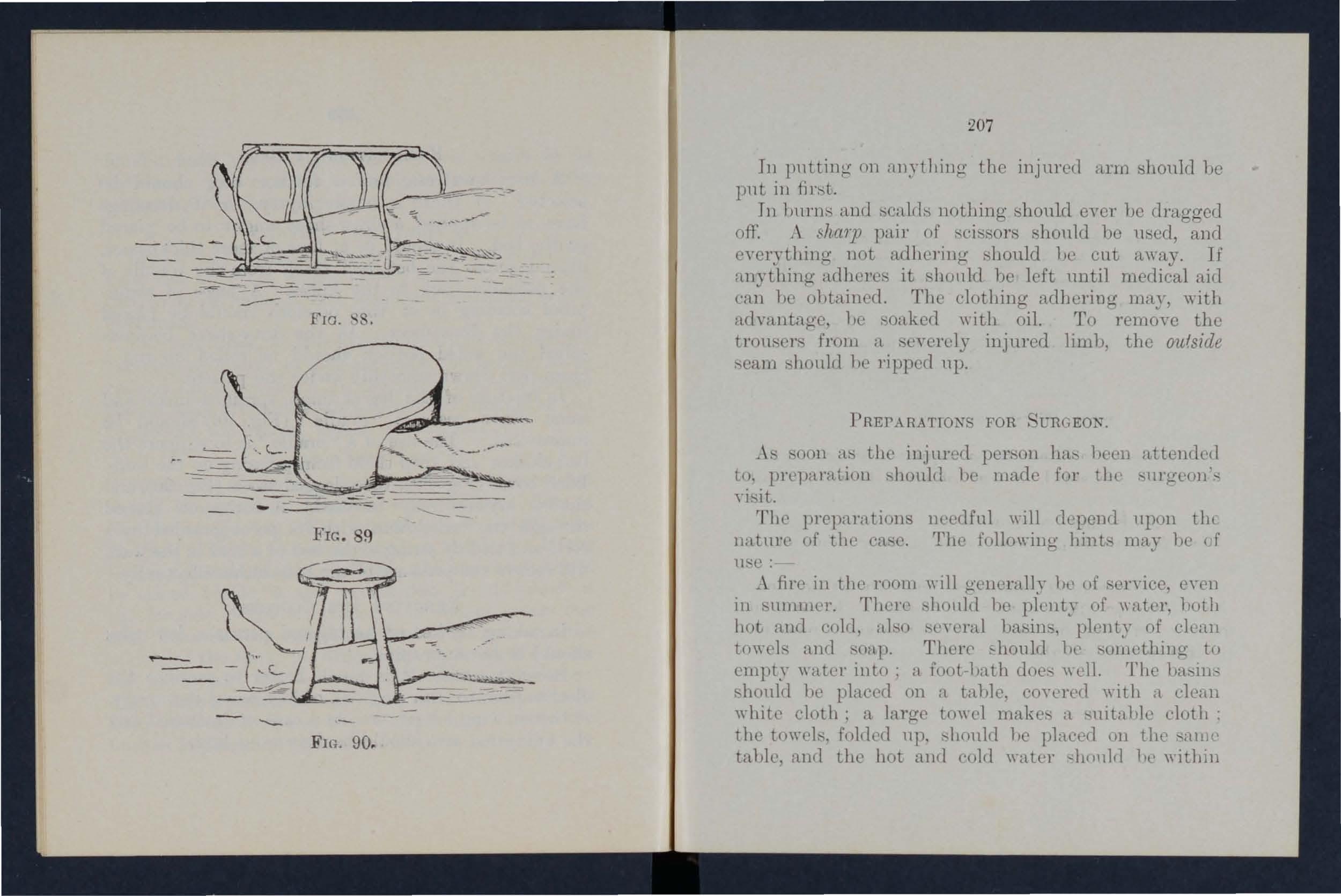
Jll on anything the injul'cd arm shoulc11)e pnt ill
In lJ11l'll.· and ticalr1s nothing should ever lJe (lraggc(1 off. .\ sha1]J pail' of .'cis.'or. ..hon1cl be uscd, and cycrytlling not (\cllwrillg SllOUld he' cut ct\\ ay. If anything ac1h 1'C.' it . hOl1ld hc left nntil mcdical aiel I'm; l)e 'oMainc(l. The dothin a adhering may, witlt ;1(lvantage. l)c with oil. To rernoye the trouser' frolJl n scyeruly injured liUll), the outside :-,eal11 :-;houl(1 l)e ripped 11p.
PREPARATION FOR, ,(;ReEON
.i\s .'oon the injured per.-on 11a to . pn'llaratioll . houle1 he made fur yisit.
The preparation llature of the ca.-c.
l'ecn llLtcndc<1 1](,
Heedful \\'ill <lepenc1 upon thL The fullo\\'ing hint.· may he (f 'be:
A fire ill the 1'00111 ,,,ill 1'L' (If kcnice, e" n ill .nlUllll'r. TII'1'e kbOlllcl 1)e plenty of W<llCl'. l)oth lwL :111(1 cold, al.·o :-,eycral hasin., pll'llty of deall towels and snap. Tl1 'rC' ::-boul(l l,l' sUllwthing to water into: n fU()t-l>:lth does \\ el1. The Inhllls should l)e placed on n tal,lc cOYCl'ec1 with a dean "hite cloth: a largo towel makes a ;..;nit,dlle cluth : the to\yoL. folc1ec1 ,{po shonlcl he pb.c l(1 oll the ;..;alllC' talJlL', all(1 Lhe hot and cole1 water -:h0111d lJl' withill
20
ea y reach, The foot-bath should be under the tahle or close at hanc1.
In the ca e of a burn, cotton wadding, soft cloths, old linen, oil, flour, bread, and bicarbonate or socb (bakin o' soda) should be ready, and shoulcl ue torn up for bandages. 1£ a chemi ·t's shop is within r eac h, carr on oil and plenty of cotton wool h0uld be sent for.
In the ca e of hromorrhage, sponges, plenty of water, and at l ea t two basins should be ready,
In the case of a person rescued from drowning the should be taken off the bed, plcnty of bbllket. should be heated before the fire, and . eycml hot bottles sho uld be ready,
If poultice are likely to be required hoi ling water, lin ccrl-meal, mustard, a loar of stale hrcac1 a slllnll ba in, a large spoon, sweet oil, and tow, fLull1cl or ha,ndkerchiers may be required,
For fomentation, have boiling \Yater, flannel, n. kitchen roller, and two stick, or a large to\\ d, ,Yh en summoning a medical man to an acciclent always l et him know what kind of ca 'C he is reC),llil'ccl to trc:1t, so that he may bring whateycr is needful. By thi. means valuable time may be
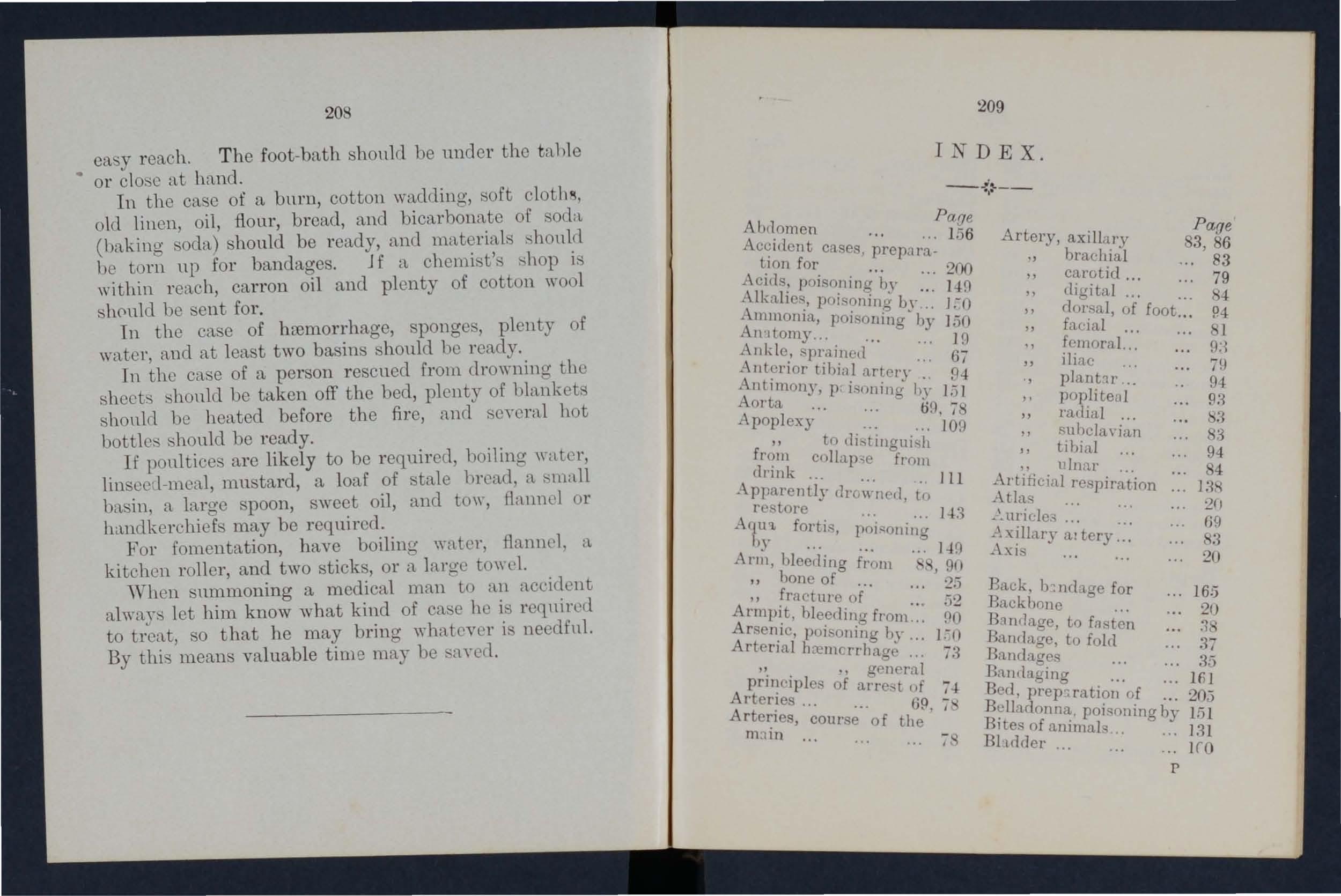
209
---;:---
A ll Page )(omen '" 11- 6 cases, ,)
t,JOJ1 for, ,,' '" 200 ACHl. pOIso,ning hy , 14fl pOls?ning by .. , ]'-0 ,,\mmoma, pOl OIling hy ];')0 .. " '.. .., 10
Ankle, spl'lllJ1C'll 6.l\nl ?rior tihia}
AntImony, p l.oll1!1tr h,· ],')1
Aorta. '" .. , tin 7 .A poplexy ., .. ') Of)
" to distinO'uish from cnll,lp-;e [mill dl'ink J II
Apparcllti;· t'!) restore '" I.U
• qU'l. forti;:;, hy .A 1'111, hone of o " fracture of" ]-1fl \,90 ::?;') .12 no Armpi,t. bleccling from::: AI'. en,lC, poisoning h\ '"
Artcnal bcemcrriJalfe ... 1,-0 7:3
",. " gf'nC'ral of al:l'c-;t ()f 7-1
Artcne '" ... 69 -; > cour e of O1 :11 n
Artery, axillary ., bra(;hial carotid rlicrital
clOt'sal, (X foot'" fa(;ial... ::: femoral illa(; '"
plant1l' popli tell 1 radial
su hela. tlhial " ulnar
Al'tJfil:ial
Atla"l .' ::: '"
..:-', x!llary a! tery --\XIS '" '"
Ba.l:k, for Ba.ckbone 0
B1T1!1:we, 1,0
Bandage, to folel
Banrlacres
Dall!la(tina .. , '80<1, ratio;;' of Belladonna poi . onin a b':
Bi teo of ani;11al 0 j m 'ulder '" ..
Bones, general description of ...

210 Page
Blood Pag6 69 Chlorodyne, poi<loning 148 144 69 69 24 -1
Brachial artery ... " ., digital pressure to Brain compression of • conclHlsion of Breastbone " fracture of .. ,
Breathing, tertorous .,.
Broad bandage .. ,
Broken bones, see Fracture.
Brooch-bone Bruises Burn 20 83 8!)
Capillaries 69
Capillary hremOl rh[lge 7::3, 101
Cuotid arteries... . . . 79 wound of I!)
Carpus
Carrying, means of patiEnts " upstairs
Cartilage ...
Caue::tic (Lunar), poi'<onin& by... .., .. ,
Cereora-spinal s.ys.tem .. ,
Cheek, bleeding from Chest ." ... " bandage for :26 166 29 151 102 Sl 1!'i5 16..J. by .. .
Choking .. .
Cil'tmlation of the blood
Cireu lation, organs of .. ,
Clayicle... ... .., ., fracture of lothes, removal of
Coccyx ... ..,
Collapse from ell'ink injury 128, 21)) :21 110 lIt) " fracture of ...
Comminuted fracture .. ,
Complicated fracturc ...
Compress, graduatc(l .. ,
Compres!;ion of lhe brain ... ompounel fracture
Concussion of the brain .,.
Contu eel wound!:'
Convul. ione:: (infantile) ..
Copper, poisoning h)'
Corrosive poison
Cradle .. .
Cranium .. . " frac ·ure (If
CrepituF; ...
Cyanide of potassium. poisoning hy .. , 24 4' :3-1 :32 7:'1 1;)1
Deep palmar arch 84
Diaphragm 137
Dig't 1 Pa({f' D' \ a l artery wOlll1(l of \1 .a . 19ltallscompreRRion " ... I D' " POlSOlllllll by I-I ,'" 4: violence... ...,'
DIslocation' ... 031
U' 1 ..., 0-1: ItCl, to cross "'itll strctcher
Dorsal artery or' foot ..
Dre8>' WOm'll1'S fi'"
Drink. <. '. on l'C D '. coIl:) PSt; t I'Ol1l rowl1mg ... 176 94 BO JJO l-U
from ' fo'" hleeding
o"f' ,L'll'eman's lift 57 horly in 0 • rClgn
ElasLic .. :.1;')4 (IueL ... 0 OUlnJ-
E Elh()\\-, 7i Ibo,,- bl r ... ]65 hcncl of eet l11g from
Elhow joint ...
Electric shock :30
Emctics ... 117 147
E '? caution as gi"j;)'cr ]30 ",pllepsy... 0
Esmal'ch 'b ... lIZ clage '" 0 1 all-
Expiration :3>
External ea' ('1" ... En' 10]( artery 79 , 1.):3
Face Firc.;ta'l .... 171 F'· lC, lllealllng of :1 h.lwok embedded FlexlOl1 of Ell} h Foot, bandage 78 " bleedina from 164 hones of 95 . . cru:,:>hed .. . 28
Forearm, f .. ' 64 honeR of rom J ,. fracture of Forehea(l, handage for ... 19t , hleading from 80 ForeIgn hody in the ear pa,:sagc ... 1 i m e!gn ho!ly in the nreJgn bOil" in tJ, 110S ' 1 sc,;t' p 2 155 166
'212 Page
Fracture, apparatus for treatment of ... 35
Fracture, causes of 31 definition of... 31 genera'! rules " " " " " " " " " for treatment 41 of arm 5:2 of bones of foot li-! of breastbone 48 of eollar- hone -! of finger bone 57 of forearm 54 of knee cap... 60 of leg 62 of lower jaw 46 of met'lcarpns 56 of 57 of ribs 46 of shoulderblade of kull of spine of thigh-bone signs and symptoms of " varietie3 of .. , :34 32 127 1,')1
Fr0st-hite
Fungi, poisoning by
Ganglia ... 1('3
Graduated compress 75
Green-stick fracture 340
Gunshot wounds 125
Hremorrhage Page 72 74 92 nrrest of .. " internal Ham, bleetling from Hanel, handage for bleeding from " bones of ..
Hanging .. , Haunch bones
Heart " contraction of HeaL a.poplexy ... "stroke ..
Hemlock, poisoning hy Henba.ne, poisoning hy Hernia.
Hip, baTll1a.ge for Howa.rd', method of artificial re.;piration .. Hummus .. , fra.cture of Hysterical fit
Iliac arLery 79
ImpacLed i'racturc 34
Incised wound. .. 124
Indirect eompre'lsion 74
Indirect yiolenc:e 32
Injuries of special orgnns 15:3 In ectR, stings of ... 1:-14
In ensibilitv 104 general trea.tof 104
Inspiration 137
213
Intestines Prqg compresSIOn
In temal alte;·j:
Internal hremorl'huge In tel'vel'tebral
Im:oluntary lrntant poisons ... 74 79 92 21 31 1.')0
l()\\cr, fractllre of 43
.Jolnt, ,ro .. ndetl .. ]:26 .Joillts ...... :29 ... handage for h.lleCC:1p . .. , .. , fracture of KlIot 'l 160 165 2' 6U 37
Ulcthocl of artInclal respiration . HZ
La.lml'llUUl ,.; poisoll. 1tlg I)},... ... .., ]51
Lacera.ted \W liml' . .. 124
Llrge arm-sling .. 39, -if), .10 Larynx '.. ... .. ] :r)
Laudanum, poiHnnintf 1)\- l-l '
Lea.ll, POiS"JIl111g hy 0 • L31
Leg, hlee(hllg from 9.1 " hones uf . . . ,> !' . fracture of... 62 carrying .. 201 mto be,l 204
Llghtlllng, effects of 119
Pag" .Jltne (quick),

.:\It·tac:arpt:s ... ' 26 " fracture of'" 56 .:\Ietatal'sal bones, turc of ... .:\J etatnrsu.' ... G4 :2 ]50 20 .:\llddle line of bod \' :\lonkshcotl, poisomn cr by... ... 0 1.''51 Morphia, I ':\I uscle
X arcnLic: poisons arrow I)andage 1\ eeclle, a broken ?\ erves X crvous 1Tose, hlce'ding from " fureign bOlly 1I1 14 :37 1:25 1(}2 1(}2 1 155 Oil uf vitriol, poi 'oning ... . 149 poisoning by ... HS
:211

Pala.te , bleeding from Palmar n,l'ches fl'om poisoni ng by
Patella, fracture of 14 )
" fracture of .i7
PhalangeR :2!l
Phalanx, fracture of .')7
Pharynx ., . . . ... 1:t')
PhORphol'us, poisolling h.) 1.) 1
Physiology . 19
Plantar a,rtenes... 94
Plants, ,-a t'ious, p )i:'\011ing by... . .. 1.")1
Poisoned wounds 1'26
Poisoning, direction s for treatment of ... . .. 1-16
Poisons and poisoning 1-16
classifica.tioll of 1-1:)
"i th dou bie action ...
Popliteal artery .. .
Posterior tibial artory .. .
Potash, caustic, poisoning by... ..,
Preparation for surgeon
Prussic acid, poisoning 150 207 by
Pubes
Pulse
Punctured wOtrod.:; 1;')1 26 71,105 ." 124
Rahid anim,lls, bites of 1:31
Radial adel'y S3, U3
Pad, to make 1 alfe 73 81 84 84 Pupils Paae ... 106
" >' blee<ling from ,,' 87 :' compression of B6
Rac1iu:'\
" fraeLure of n, artili<:i.ll
Respiralory system
Rib ' " fracture of. ..
Room amI pa,rat ion of Rump-bono
Rupture ... prc · :21 l(jI)
RaCl'Ulll .,' :21
Realtls 1:2.'
I calp, handage fn!' W 1 ,. hIe ng from '() :2-1
" fracture of .'):2
Rats l61)
I'crew tourniquet 77
"hin-bone 2c'
Rhock 106
Ahock electric 117
'houlder ". 24 houlder, handage for". 16:2 hlade :2i)
" fracture of 52
Shoulder joint ", 29
Faffe
'ickl'oom, choice and prepal'a,tion of 20()
Simplc fracturc .. , :3:2
SkelcLon ... 20
I 'kin, wOllllds and in· of 121
Skull 22 )l fraeLure of 44
Slings .. 3!1, -to & .")0
Sma.ll --10
:-;llake-bite ... .., 1:3:3
,_'o,la, eal1stie, POISOllilllf
I,y ,.. .. 0 l.,)()
l')ole, arterial Lleellillg from n.)
Spleen }.1!)
o-:'pinal canlll :20
" cord If 2
I ' pille :20
'pine, fracture of ...
,'pil'iL of saIL, poilSonillg hy .. .., .. , 140
Hplint, angular", ;)-1-
I 'plillb ... ,.. ;3.) to secure 3) ,_'pmins '" 6,
Alet'llulIl ," :24
" fractur e of 4 ,
• 't 'rtoron-.; hrea.thiJl u 10.)
:-Itlllgs of inseets, C';' l:H
:-;lomach .. , }.3, 'train Ii '
l'tn1ll!-"1.1latioll 1-1-4 'trctchet' 1.)1
215 ,'trotcher, FurIey io carry to prL'}.ure
to Ill3 kl a tCIllpOl'al Y , , lrallsporL, , , I pOlsCJIlil1g by I. tlllllllllg... .., '"
• 'tYl1tic I_'ubchwian artery " ",1igital C()1Il1H'CSHiull of '" 'u[focaliUll 1,y ()r gcl.ses... , , ... :-Iutfucatiull I,,· ,'wulluw, ing "ery hot. \\ atcr ... :-Iu ll-'; Lroke ... 'upel'fieial palmar 31'eh yi 'it, preparation fo!' ,., .. ,-ylvester's lIletiw.l of al'lificiall'cHpirntion ... 'ympathetic I 'yncope ...
Tail-bolll' Tarsus ,,' '"
Temple, hlecdillg from ,.. Thi (fil. huIl' o of , ..
Thl'ee-hmlficil Hettt Tibia fraeture of
P((ge
T hroat, b l eeding from inside of 1
Tibial arteries .. , ... 94
Tongue, bleetling from.. c'O
TOll"jls, "blecding flUIll < ' 1
Tourniquet 75
Trut:hea ... 1:3;')
Twu-hamleLl selt lUJ
Ulna .. , :?,-l -,.i fract::;l'C of Uh1ur artery ' 4. U
'£1'0111 blcct1ing
Ulnar artery , siun uf ...
Uucon
Val'icos.:! "ei!lS
Veins C 101 lUO • Y entl'idc Y enligris, poisollillg rertebra .. cen'il:al " tlol'sal Inmhm' culumll "\ i ru1 throwing ,'uice Lox Y aluu tUl'Y !Il n "des
'Vagon, to luad i.Jl'1 Ullload... ... . 117 ,Vull, to cross \I nh stretl.:hcr .. 1Ii ,\Yim1-pipc... }:j,)
'\'\'ou11<l of ,llldolll cll l.i7
'\YuUJl(l uf lung .. J.iU ,\Yullnds .__ . "--

$i. 30bn tl1nbulancc
,
.
This -Price List, ,..-hioh is subject to revifiion frum time to time, has been compiled with a view to assist members of the Asoeiation and others in the pLU'eha'e of the necessary eq uipment fur curps and divisions of the Brigade, ambulance stations, cla. ses, anel fil' t aid and nllrsing work generally.
A cumplete ancl reliable Ambulance Equipment IS an actual necessity, and experience has proved that employers of labour awl uthers interested in the district readily ubscribe for the purcha. e of such appliances. Collecting card ' , stating the :pnrpose for which subscriptions are required, will be 'llpplied gratuitously on applicatlOn to the Heael Otlice of the Association, where also any information ,,-ith regarel t o it. work can b e obtained .
•'tores of the value of lOs. or upwards will be ent c arriag e paid to any part of the United Kingdom.
Ol\ing to fluctuations in market p rices it is impo sible. to guarantee that the q uotation herein can be adhered to .
Quotations "ill be furnished for articles relating to Amb ulance Nursing and H ygiene, not mentioneel in this list.
Orders and correspondence should be adclre sed to the t. John Amb u lance A ssociation, t. John's Gate, Clerkenwell , L ondon, E. C.
Remittances shou ld be made pay.tble to the t. John .ci.mb llk'l,llCe A ssoCIation and crossed "London anel ,,1estminstel B ank, L othbury ." .
HORSE AMBULANCE CARRIAGES & WAGONS.
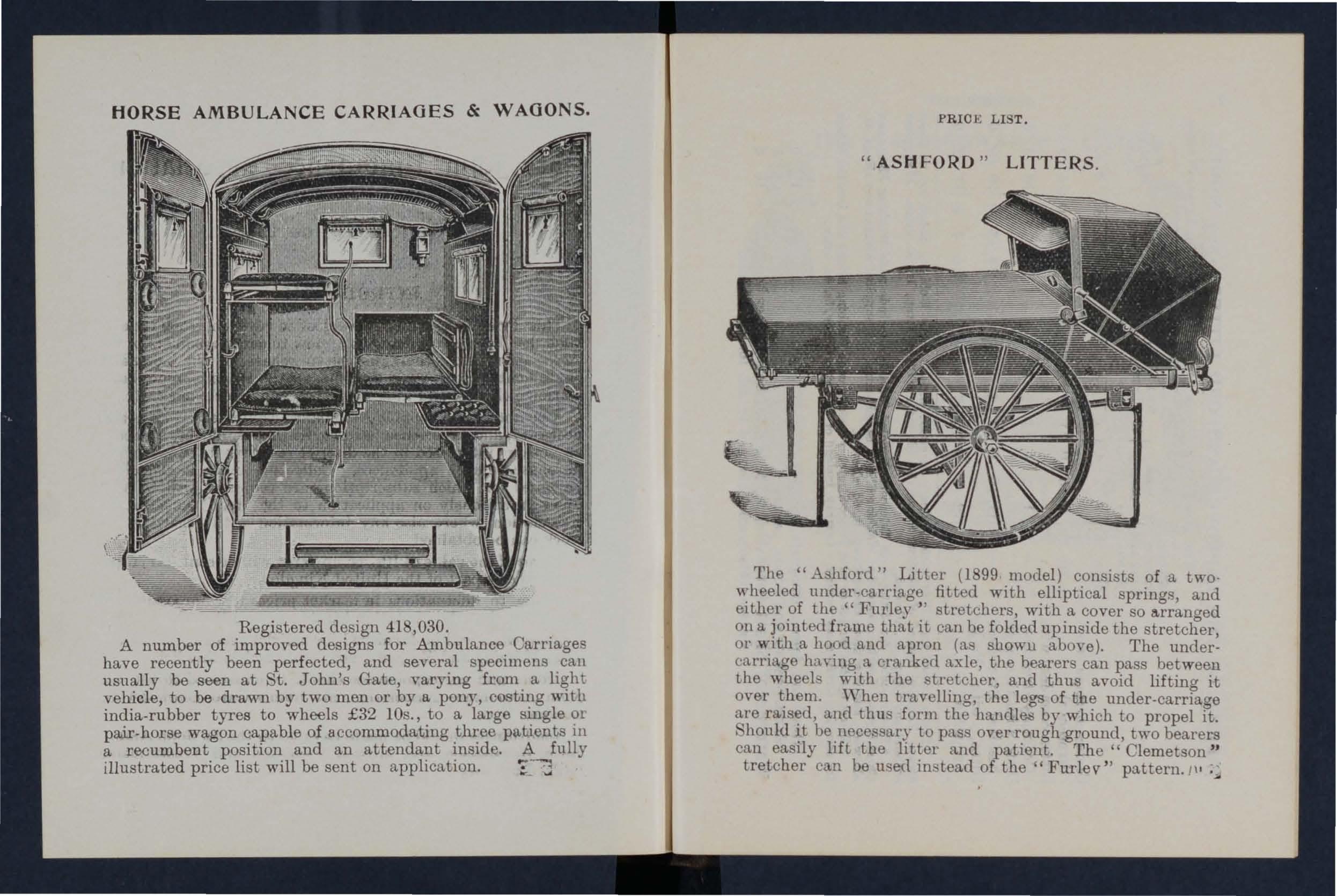
A number of improved designs for Ambulance Carriages have recently been perfected, and several specimens can usually be seen at St. John's Gate, varying from a light vehicle, to be drawn by two men or by a pony, costing with india-rubber tyres to wheels £32 lOs., to a large single or pa.i.r-horse wagon capable of accommodating three patients in a recumbent position and an attendant inside. A fully illustrated price list will be sent on application.
PRICE LIST.
The (C Ashford" Litter (1 99 mOlleI) consists of a twowheeled under-carriage fitted with elliptical springs and either of the « Furle.)' " stretchers, with a cover so on a jointed frame that it can be folded up inside the stretcher Ot' with a 1100u and apron (as showll aboye)_ The carriage a cranked axle, the bearers can pass between the wheel' wIth the b'etcher, and thus avoid liftino it over \Vhen tr,welling, the legs of the under-carriage are raIsed, and thus form the ha.ndles by which to propel it. houkl be .nece to pass over rough ground, two bearers can eaSIly hft the htter and patient. The « Clemetson " tretcher can be used in 'lead of the ('Furlev" pattern. III ;",
(PRICES OF TH E IM PRO VED AS H F OR D LITTE R, 1899 MODEL.

Under-carriage (no
Litter complete with With Iron Tyres to Wheels. Without Oover or Hood and Apron J:; s. d. With Oover. £ s. d. With Hood and Apron £ s. d. With Inctia Ruhber Tyres to Wheels Without Oover or Hood and Apron.
Ditto 'with Telescopic
handled Stretched
Ditto, with Police Stretcher:):............
Prices quoted for Litter with Ordinary Stretcher include Wide Webbing" Slings but no Cheat ;l Strap. Leather, instead of W ebbing Slings, 55. 6d. extTa; Ohest Strap, 15. 6d. extra. If su pplied wi th out any Slings, 45. allowed.
t PriceR quoted for Litter with Telescopic.handled Stretcner include wide Slings a nd Ohest Strap. Lentner, instead of Webbing Slings, 5s. 6d. extra. If snpplied without any slings, 4s. ; a nd if without Ohest Strap, Is. 6d. allowed.
t Prices quoted for Litter with Police Stret<'her include wide W ebbing Slings and L eather Strap s fOt" securing a refractory "atieDt. Leather, instead of Vi" ebbmg SJingfl, 511. 6d. extra.
Hood ana Apron, complete Extra Sockets and Stuus, per Ret Waterp r oof She et (washabJe) to be laid on the stretcher bed Crates (returnabJe ) charged 4s. 6d. for each Litter.
ctCDctPl°cTPl
g- g-;:: r-3 5' p--o..g :: g;- (JQ
PRICE LIST.
over them, and the cranked axle has, therefo re, been replaced by a straight one constructed of tubular steel.
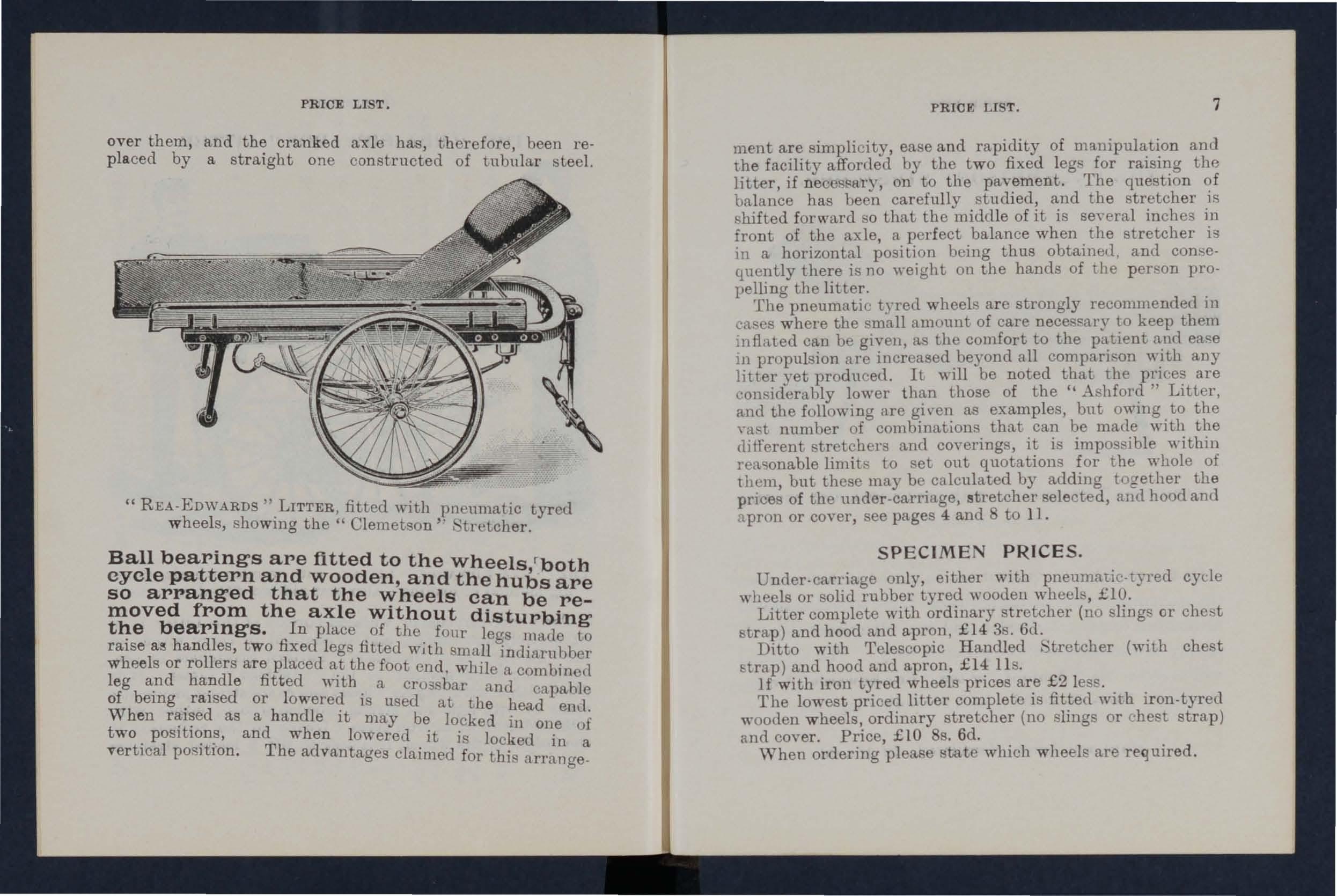
"REA-EDWARDS ".LITTER , fitted with pneumatic tyred w heels, sho wmg the" Clemetson" tl'etcher.
Ball bearings are fitted to the wheels/both cycle pattern and wooden, and the hubs are so arranged that the wheels can be removed the axle without disturbing bearIngs. In place of the. fOllr legs made Lo raIse al!l handles, two fixed legs fitted wJth small indiarubber wheels or rollers are placed at the foot end, while a comhin d leg apd ha?dle fitted ,..,-ith a crossbar and capable of bemg raIsed or lowered is used at the head e 1 When as a handle it may be locked in one two . and when lowered it is locked in a vertical posItIon. The advantages claimed for this arrange.
PRICE LIST. 7
ment are simplicity, ea e and rapidity of and the facility afforrled uy the two fixed leg s for the litter, if neces!:lary, on to the pavement. The questIOn balance has been carefully studied, and the stretcher lS fo;hifted forward so that the middle of it is seYeral inches in front of the axle, a perfect balance when the stretcher is in a horizontal position heing thus obtained, and consequently there is no weight on the hands of the per 'wn pro· pelling the litter. .
The pneumatit: tyred wheels are strongly recommencleclll1 cues where the small amount of care necessary 1.0 keep them inflated can be given, as the comfort to the a.nel ease in propulsion are incrcased .beyond all comparIson w:th any litter yet produced. It wIll be noted that the pl'lces are lower than those of the " Litter, and the following are gi \'en as examples, bn t owmg. to the \'a, t number of combinations that can be made WIth the different stretchers and coverings, it is impossible within rea onable limits to set out quotations for the whole of them, but these may be calculated by adding te'gether the prices of the under-carriage, stretcher selected, and hood and a pron or coyer, see pages 4 and to 11.
Under· carriage only, either with pneumati c.tyred cycle 'wheels or solid rubber tyred wooueu wheel, £10.
Litter complete with ordinary stretcher (no sling!: or chetit strap) and hood and apron, £14 3s. 6cl. .
Ditto with Telescopic Handled I tretcher (WIth chest strap) and hooel and apron, lI s.
If with iron tyred wheels prlCes ar,e £2 less.. .
The lowest pri ced litter complete lS fitted WIth lron-tyred wooden wheels, ordinary stretcher (no sling or ( hest strap) and coyer. Price, £10 s.6d.
When ordering please state which wheels are required .
PRICE LTST.
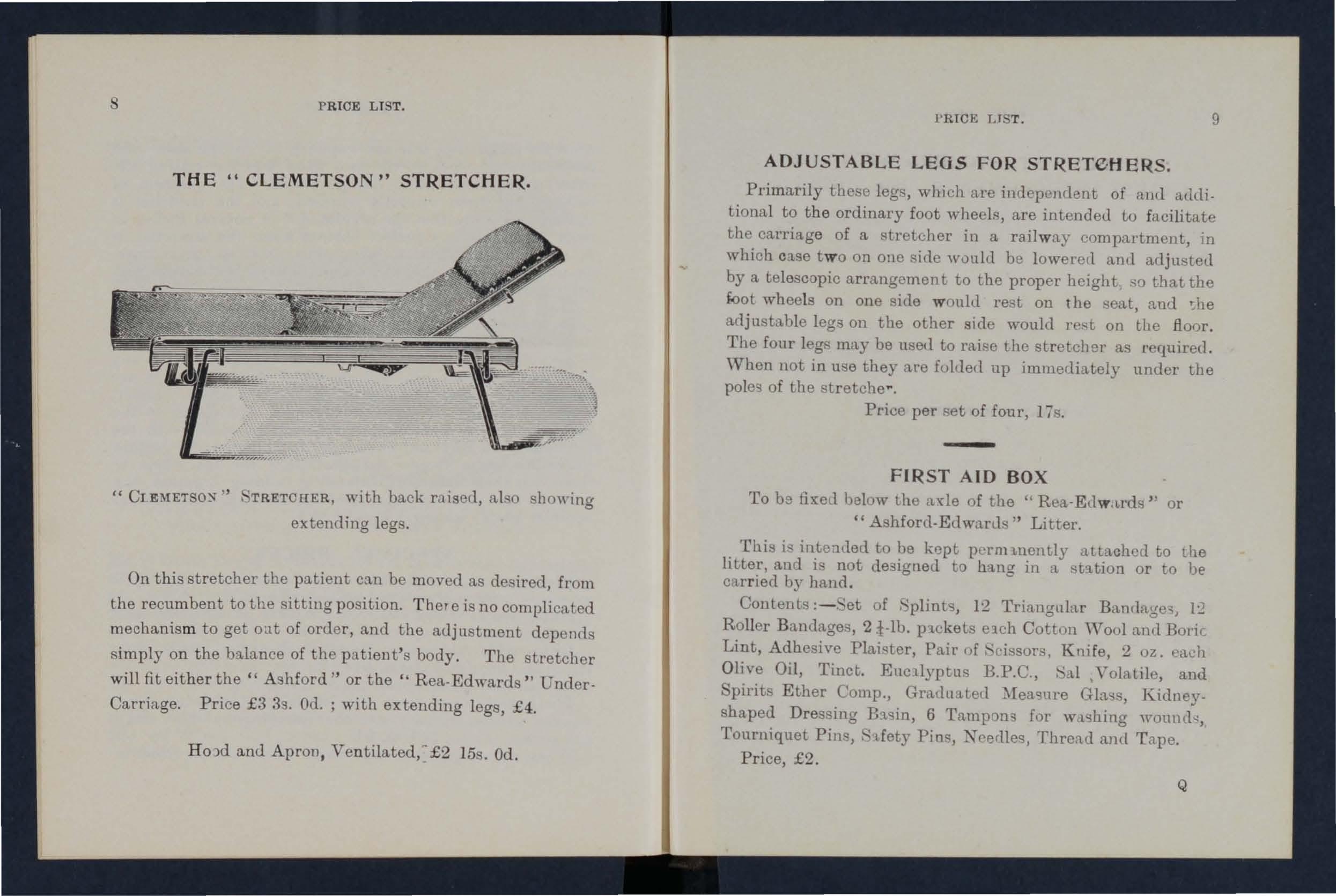
" Cr
THE" CLEMETSON" STRETCHER.
Primarily these legs, which are independent of and atltlitional to the ordinary foot wheels, are intended to facilitate the carriage of a streLcher in a railway compartment, in which cJ.se t w o on oue side would be low-ere(l anll adjusted by a telescopic arrangcmen t to the proper height, :;0 that the £.oot whee ls on one siele would rest on the 'ea,L, and adjustable legs on the other side would rest on the fioor. The four legs may be use(1 to raise the stretcher as required. \Vhen not in use they are foltled up immediately under the pole'! of the stretche".
Price per set of four, 17s.
• 'TRETCHER, with back raised, a1. 0 showing extending legs.
On this stretcher the patient can be moved as de ired, from the recumbent to the sitting position. Th ere is no complicated mechanism to get oat of order, and the adjustment depemls simply on the balance of the patient's body. The stretcher will fit either the" Ashford" or the " Rea·Edwards" UnderCarriage. Price £3 33. Od. ; with extending legs, £4.
Ho )d and Apron, £2 15 . Od.
To be fixed below the axle of the or " Ashford-Etlwanls" Litter.
This is intended to be kp,pt pcrnnnently attached to the litter, and i not designed to hang in a st'l.tion or to be carried by hand.
Contents:- 'et of 1:2 Trianguhtr Ban(liLge-;J 1:2 Roller Bandages, 2 i-lb. p1.ckeLs e1ch Cotton ,Vool and Boric Lint, Adhesive Plai"lter, Pair of "l'issors, Knife, 2 02:. eaeh Olive Oil, Tinct. EllCllyptllS B.P.C., . 'al Volatile, and pil'its Ether Comp., GradU'l.tell Mea'3ure Gla', Kidneyshaped Dressing B:t'3in, 6 Tampons for wl'3hing WOUllll;::, Tourniquet Pins, Pins, Nee(11es, Thref1.d and Tape. Price, £2.

'fELESCOPIC STRETCHER- OPEN.
ORDINARY STRETCHER-OLOSED .
The improvements in all patterns of the "Furley" , tretcher, 1899 lodel, are numerous. The comiort to the patient is increased; the stretcher is stronger, more rigid, amI lighter, it folds up more closely, and its handles are more comfortable to hold and l1fford greater protection to the hands of the bearers in passing through na.rrow doorways or passages. ,hould it be necessary to reduce the width of a loaded stretcher in order, for example, to carry it into a cal riage, this can be done, either when it is resting on the ground or supported by the bearers, without trouble and without the slightest jar to the patient. The price of the stretchers is lowered . All minor points ha.ve b een most carefully considered , and th e stretchers are confidently recommended as thorough l y tfficient in every way . These are adapted for use alone or as part of the " Ashford" or " Rea-Ellwards " Litter, and the cover, hood and apron , army rug, and waterproof sheet described in this list arc suitable for use '\\ it.h them .
PRIOE LIST.
THE EQUIPOISE BED. INVALUABLE FOR INVALIDS, CON"VALESC]<:NTS, AKD TilE GENERAL PUBLIC.

The movement of the bed to any position i!'l so"-easily effected that the pe rso n lying on it can regu late thc'moyement of the bed to any angle without assi tance. It can be locked in seven different positioJ1<l. Price frcm £5 ]5!'l. (1(1.
(FOLDIl':O CAMP BEDS.
This can be folded in a very small" ss and can e readily up to form a comfortahle bed. Price 25!'l. : for when f()lded, fitted with carrying strap, 5!'l. _ 6el.
Pocket Cork Line and Drag, with SO feet of line, in case. For recovering a drowning person from"the water. Price complete, with instructions for use, 6f1. Gd.
Pocket Reel and Ice L ine for U!'le in ic accidents, with 80 feet of line,'in case. Pr i" e complete, with tions for use, 65. 6d.
Fur use in mines, ships' holds, &c., to secure it patient on a stretcher (see illustration) which can then be placed in an npright position. Price £1 I5s. WATER BOTTLE.
ICopper tinned, with carrying strap
Price 68. 6d.
Enamellecllron Water Bottle, covered, with Strap 45 .
Thi(islfiUed with a socket by which to it to a Litter, or it, can be convemently carried by hanel, or attached to a belt or the clothing.
Price- complete, 5s. 6d.
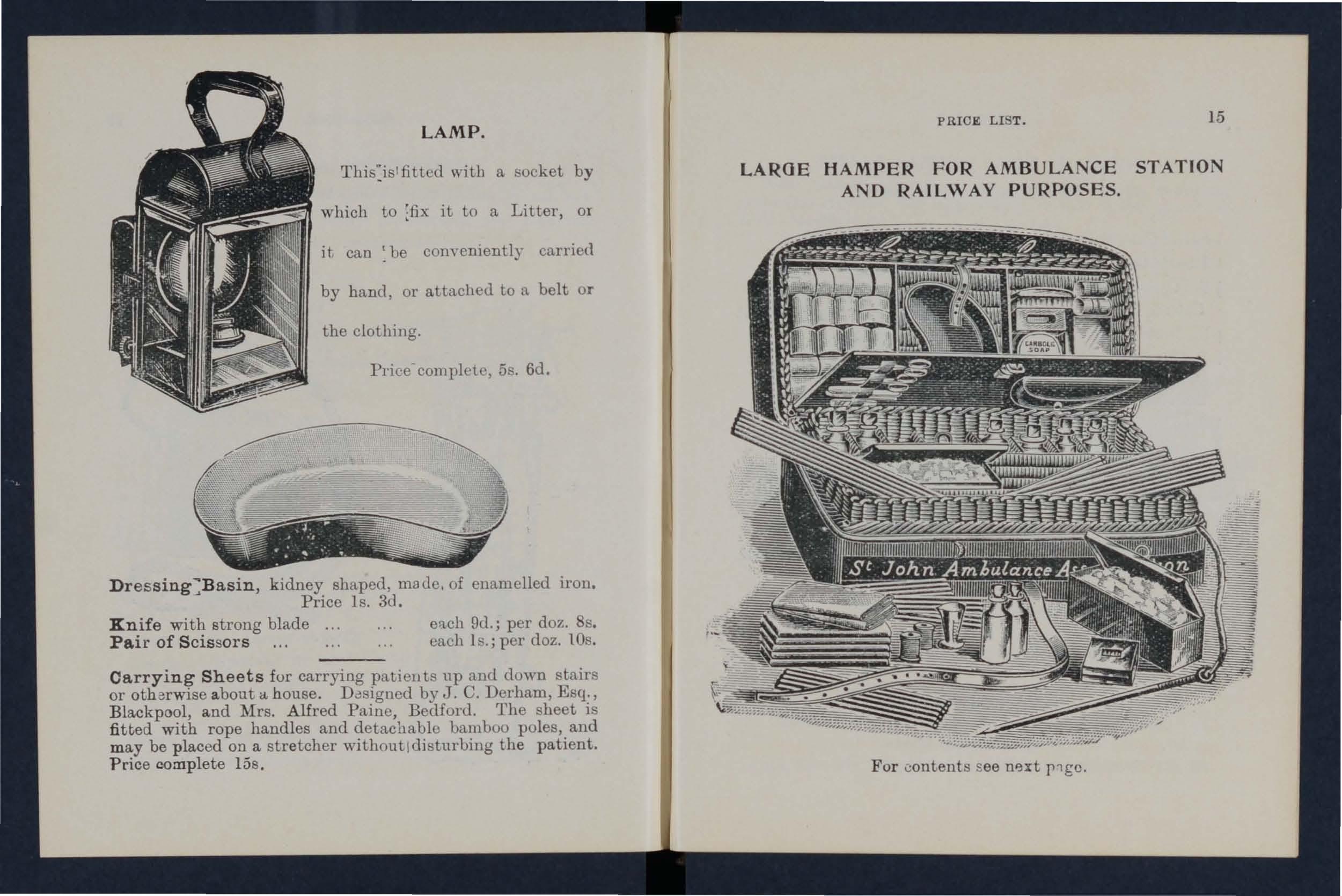
Dressing:Basin, kidney shaped, ma dc, of enamelled iron.
Price Is. 3d.
Knife with strong blade ... Pair of Scissors el1ch 9d.; per doz. 8s. each Is.; per doz. lOs.
Carrying Sheets fur carrying patieu ts up and down stairs or otherwise a.bout a house. DClsigncd by J. C. Derham, Esq., Blackpool, and Mrs. Alfred Paine, Bedford. The sheet is fitt ed with rope handles and detachable bamboo poles, and may be placed on a stretcher withoutldisturhing the patient.
Price complete 15s.
LAROE HAMPER FOR AMBULANCE STATION AND RAILWAY PURPOSES.
For ..;ontents see nlOlxt p1gC.
I , et of Cane p lints.
HAMl'liR CONTA1NS
1 pair 'cissors.
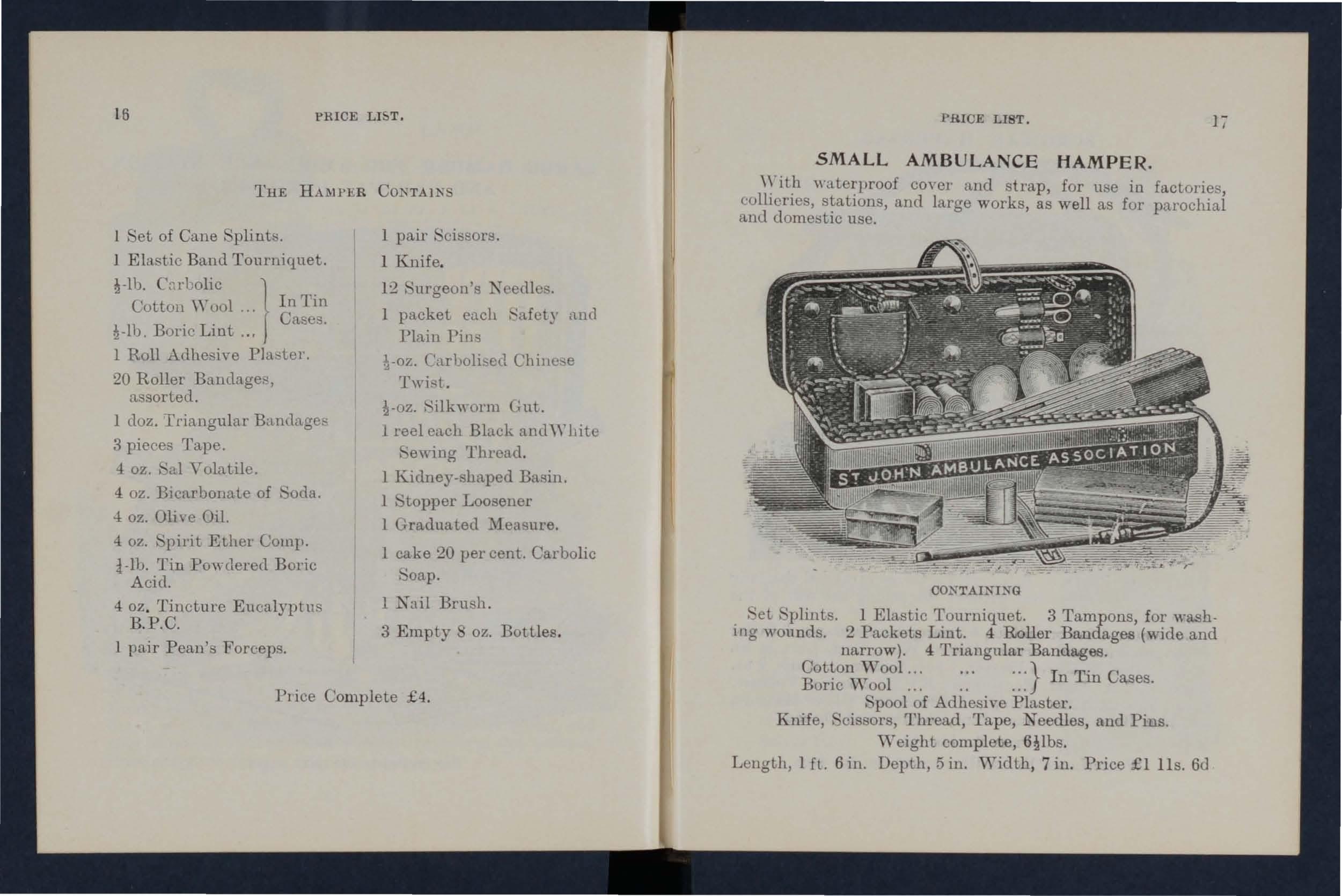
SMALL AMBULANCE HAMPER.
\\ 'ith ,mterl'roof coyer and strap, for use in factories, collieries, stations, and large works, as w ell as for parochial and domes Lie use.
I Elastic Band Tourniquet.
CottOll \Y 001 ,.. In Tin 1 Cases. Boric Lint .. ,
1 Roll Adhesive Plaster.
20 Roller Bandagel:1, assorted.
1 doz. Triangular Rtntlage;;
3 pieces Tape.
4: oz. I 'al Y olatile.
<1 oz. Bicarbonate of ,"oda.
4: oz. O1i ve Oil.
4 oz. 'pirit Ethel' Comp.
i -lb. Tin Powdered Boric Acid.
4 oz . Tinct u re Eucalyptus
B.P.C.
1 pair P ean's Forceps.
1 Knife.
12 , 'urgeon's TcecHes .
1 packeL c<.lch ,'afcty and Plain Pins
Carholised Chinc:;e Twist.
Silkworm Gut.
1 reel each Black 3.nc1White , ewing Thread,
1 Kidney- haped Basin.
1 Stopper Loosener
1 Graduated Measure.
1 cake 20 pel' cent. Carbolic . 'oap.
1 Nail Brush .
3 Empty oz. Bottles . Price Com plete £ 4.
. eL , 'plints. 1 Elastic Tourniquet. 3 Tampons, for washIng wounds . 2 Packets Lint . 4 Roller Bandages (wide and narrow). 4 Triangular Bandages.
\ Y 001 ... .. .} I n Tin Cases. Bone ' Yool... .. ... pool of Adhesiye Plaster.
Knife, ' ci SOl'S, Thread, Tap e, Needles, and Pius.
W eight complete, Length, 1 fl. 6 in. Depth, 5 in. W idth , 7 in. Price £1 lIs. 6cJ
PRICE LI5T.
SURGICAL HAYERSAC.

IMPROVED PATTERX, fitted with a tin, so arranged thatlany article can be taken out without disturbing the rest of the contents .
Contents: 1 Set of Splints, 6 Triangular Bandages, 6 Roller Bandages, wide and narrow; (Jotton Wool, Boric Lint, in tin cases; 1 Roll Adhesi ve Plaster, 1 pall' Scissors, 1 Knife, 2 oz. Olive oil, 2 oz . Tinct. Eucalyptus, B.P .C., 2 oz. a1 Volatile, 2 oz . Spirits Ether Comp., 1 Graduated Glass Measure, 1 Elastic Band 'rourniquet, Pins, Needles and Thread.
Price £1 lIe. 6d.
White \Linen' Ration each.
I'RICE LIST.
NU RS E S' WALL E TS.
ORDIN ARY PADLOCK HAPE.
'Vilhout instruments, 4 .3u.
Fitted complete, containing Bow
Dressing :Forceps, 'patula, Probe, :2 pairs . cissors (round aIHI sharp pointed), Clinical Thermometer, and Knife.
Price 8s. gt1.
'T. Jou:s's PATTERN, a . illustrated, lmt improyed by the addi· tion of flaps to pl'OtecL the lllstrml1Cnts.
\\Tithout instrull1cnt.,:, 'is. 9d.
Fitted complete, containing Bow
Dressing Forceps, Artery Forceps (also useful for dressing), 1-'patula, Probe, Director with Ear coop, 2 pairs 't;issor::; (round and sharp pointed),
Clinical Thermometer (minute, rounel), Kuife, Pencil, and Safety Pins.
Price
FIRST AID BOX FOR" ASHFORD" LI fTER lOR AMBULANCE STATION.
This is primarily designed to be placed on the " Ashiord " LitLer (1899 Model), but it is further adapted to be hung up on a wall. A detachable leather handle is also fitted for carrying • I 'II
For contents see next page.
CONTENT.' OF FIR. T AID BOX. (Illustrated on previoTls page)
Set of Woollen Splints; 1 Elastic B:Iond Tourniqnet; C.l.rbllic Wool, Borio Lint, in tin oases; 1 Roll Adhesive Plaster; 12 &11er B l.udages, assorteu; 6 Ban(iages; 3 Pieoes of Tape; 1 Pair Scissors; 1 Knife; 1 Kidney.Sllaped Basiu 1 Graduated Measure; 2 oz. Olive Oil ; 2 oz. Tinct. Eucalyptus B. P.O. ; 2 oz. Sal Volatile; 2 oz. Spirits Ethel' (Jomp.; 8 oz. C'l.rron Oil; Pin9, Safety Pins, Needle-, Threa.d.
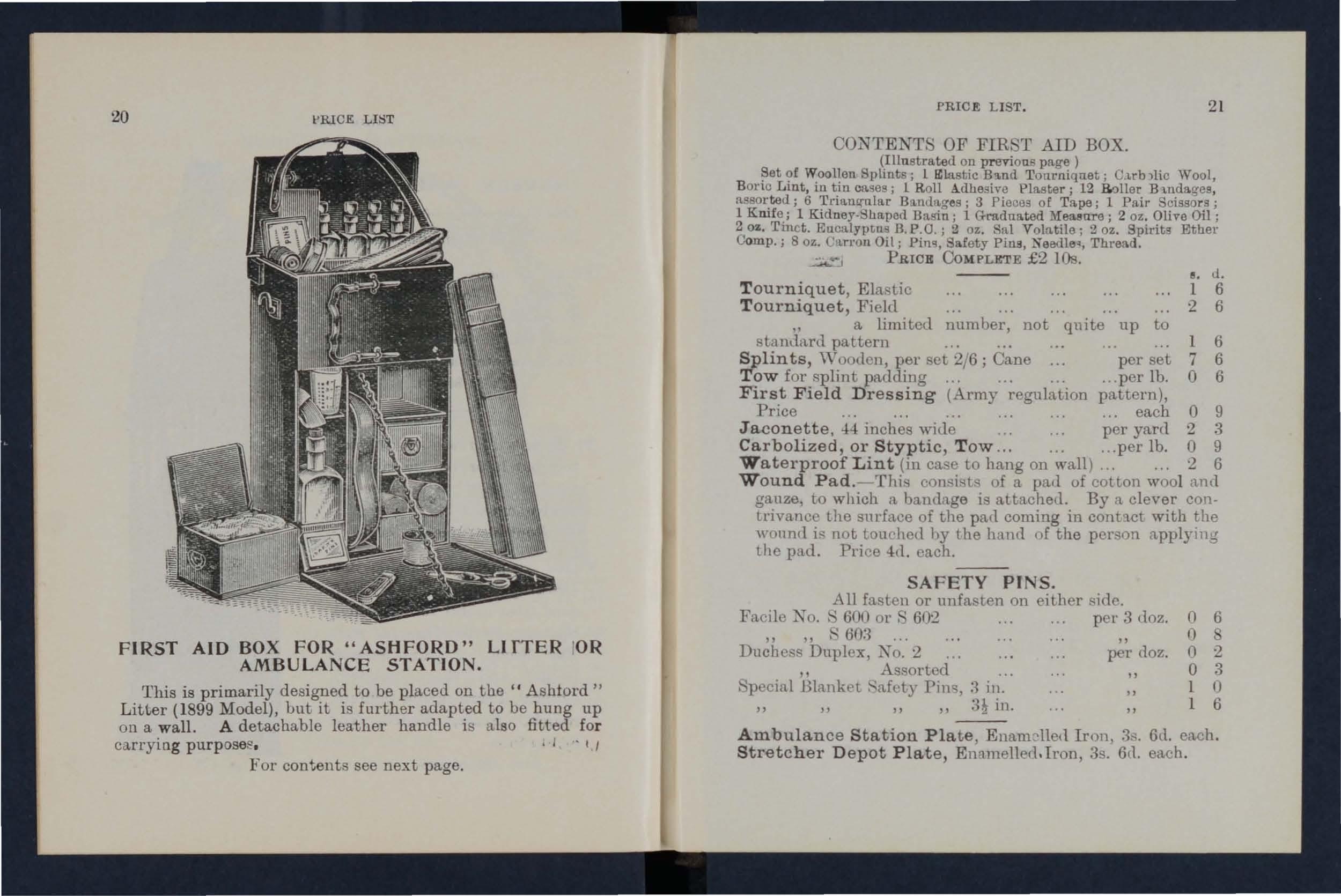
Wound Pad. -Thi consists of a pad of cotton wool [I,n d gauze, to which a bandage is attachetl. By a clever con· trivance the surface of the pall coming in contact with wouml i>; not touched by t..he haml of the person apply111g the pad. Pri ce 4(1. each.
All fasten or unfasten on either side. Faci le No •' 60001' S 60:2 " ".' GO:3 Duchess Duplex, Xo. :2 " Assorted :'pecial Blanket .'afcty Pins, m.
Ambulance Station Pla te, Enam:-lle(l Iron, 3s. Gd. ea.ch . Stretcher Depot Plate, En'lmelled.Iron, 3s. Gel. each.
P RJCE L I ST.
Nursing Chart, designed by Miss I nderwl.:: k , each. Temperature Chart , each.
Registers. Class Attendance and Certificate (two to set) , 6s . . Case Report I s.
Large Physiological Diagrams. F or Lecturers' use. Com p rising : The Hum an S k eleton, the Muscular, Arterial and Venous y slems, the Heart and Circulation of the Blood, imp le F racture, Compound F racture, Dislocations. P rice, per set of six, 15s. These may be hired for a. course of "First A id " lectures, given under the auspices of the Association, for a fee of 5s. , or with the addition of Sp lints, Tourniquet, and plain Triangular Bantlages, for a fee of l Os .
Boxes of Stationery for the use of Class ecretaries and oth er s connected w i t h the Association, containing twelve sh eets of high-class·p ape r , su itably beaded, and twelve envelop eR bearing the device of the Association . Price Bll., by post 9d. Twice t h at quantity, price Is., b y post Is. 3d. Meda llions , i sued in accordance with special regulations, for which see leaflet N o. to be had on upplicl,tion.
Coinage Bronze , 2s . ; ilver , 6el.; Gold, £2 Ills.; including engra,ing name and number on back. Morcccil vel,et-lined case, 2s.
Labels , to be placed above Medallions for each . ubsequent year's examination issued in ac cordance with regulation, as per paper Coinage Bronzp, Cel . ; Bilvcr, l s. Cd. ; Gold, l Os. 6d.
Bow Dressing Forceps , full size, I s. 3d.; small, extra well finished, Is. 6d.
Scissors , round-pointed, Is. 3d. ; sharp-pointed, for delicate work , Is. 3d. ; small round-pointed, blades Lake apart for cleaning, Is. 9d.
Spatula,9d. Probe,9 d. Director, with Ear Scoop, I s. 9d . Artery Forceps , 2s. 4d . Knife , very thin, ivory hanel!e, two bla d es, I s. 9d.

Round . Onlinary , I s. 6d. ; minute, 2s. ; half-minute, 2s. 6d.
Flat. trong:y recommended as bhey will not r oll. 2s.; rapid (specially selectecl and reserved for the ASSOCIation), with very open scale, 3s . 6d.
Lense Front e d. 'When held in the proper l-osition th e colum n of mercury is magnified , and so easily read . A little practice is required to ascertain the correct position in wbieh to hold the instrument . Price, ordinary, 2s . ; minute, '2s. 9d . ; half-minute, 4s.
Rew Cert.ificate (to order ), Is. 3d. each. N.B.-These certificates either state that the instrument is correct or point out itDy slight error there may be; they a,re not u sually considered necessary . N.B.-1limlte and half-minute instruments will only register in the time stated untler favourable cirCtull tances.
To Dr. Forbes' specificaLion. Japanned, with zinc scale 2s. :3d.; Clinical The:rmomcter size, in case, Is. 6el . S o liability i, lak e?1 Jar breal.aye (J Thermomfler c in tran. it.
" FlR T AID TO TEE I NJURED." By James Cantlie, M .B. F.R.C. '. The authorised Text-book of the Firsl Aid Course . Is . ; by post, Is. 2d .
" CATECHI III OF FIRST AID ." Compiled from Dr. C:1ntlie's Manual. By J. Brown, L .RC.P. , L.R.C . . , and J. M. Can-ell, l\l.R.C .. , L . . A. Price 6d.; by post, 'I cl.
" AND H ELl'S FOR H OME K URSING
By E. Cosgrave, M.D., illustrated, with on the a pp ' ication of the r oller bandage, b y R. J . CollIe, M.D. The authorized Text-book for the Tnr ing Course . I s., by posl, Is . 20.
24 PRICE LIST.
TEXT BOOKS, &c.-( continue,l).
"HOME By John F. J . ...:ykes, D. 'c. (Public Health), M. D., &c. Illustrated. The authoriRcd Text. Book for the Home Hygiene Course, Is., by post, Is. 20.
"CATECHISM ON HOME NURSlliGt (based on Dr. Cosgra.\e's Text book). By J. Brown, L.RC.P., L.RC.• '., and .J. M. Carvell, M.RC.. , L.S.A. Price 6d., by post 'id. AND ANSWERS AMBULANCE "VORK." By John W. Martin, M.D, of ,heffield, and .John }Iartin, F.RC.S. Ed., of Huddersfield. Is., by post 1. Id.
"QUESTIONS .A....--ID ANSWERS UPON NURSING." By John \V. Martin, M.D. Is. 6d., by post Is. 3d.
"FIRST AID TO THE INJURED (. ix Ambulance
By Professor Frederich Esmarch. Translated from the German by H.RR. Princess Christian. 2s., by post 21;\. :2<1.
"ELEMENTARY B.A....'<DAGING AND SURGIOAL By Walter Pye, F.RC.S. 28., by post 28. 2d.
DR. G. H. DARWIN'S "FIRST AIDS," being a card to hang up, giving treatment of various accidents. 2tl., by post 5d.
"To RESTORE THE ApPAREXTLY DROWNED, " printed in large Type with Two Diagrams. Unmounted, each 2d. :\Ioullted, with red border, and varnished. to hang up, 611., post frl c, packed, Is.
"How TO ACT WHEN CLOTHING TAKES FIRE." By J. E. H. Mackinlay, M.RC .• '. Unmounted 2<1., by po t ;3(1 Mounted on card and yarnished, 4cl.; by post, packed, 'id.
I' FIRST AID PRINCIPLES." Card of concise directions for wn.istcoat pocket, each 4d. per dozen. pecial quotations for large quantiti es.
"SPEOIMEN EXAMINATION PAPERS, First Aitl anel J. T urtiing Course." 3d., by post 4d.
SMALL ANATOMICAL DIAGRAM. • howing the human skeleton, main arteries, and point'> where pressure should he applied to arrest bleeding. 2d., by post 3d.
PRICI': LIST. 25
TEXT BOOKS, &c,- (,·ontinller/).
AS TO TIlE RESTOR\TTO:\, OF PERSONS SUFFERING FRO,[ ELECTRIC •'noCl\:. Large print, poster size. 3d. each or :2s. 6d. per clOZ3ll
AIDE :\IEMOIRE. On cardboard, in lil1cn-linc.l eJwelope, for the pocket. By the late P .• 'hephertl. Containing useful hints for First Aiel to the Injured. 3d.; by p!lst 4d.
GE\ERAL NOTES ON FfR'T AID TO liE IX CASE OF Por->oxIXG. By :\Iilnes Hey, .. '., L.RC.P. Price :2(1. ; hy po't :3cl.
BOOK," for instantaneous reference, giving concise instructions, Lo hang on wall. •'ize ahout one foot square. Price 28. Gel.; hy post :3s.
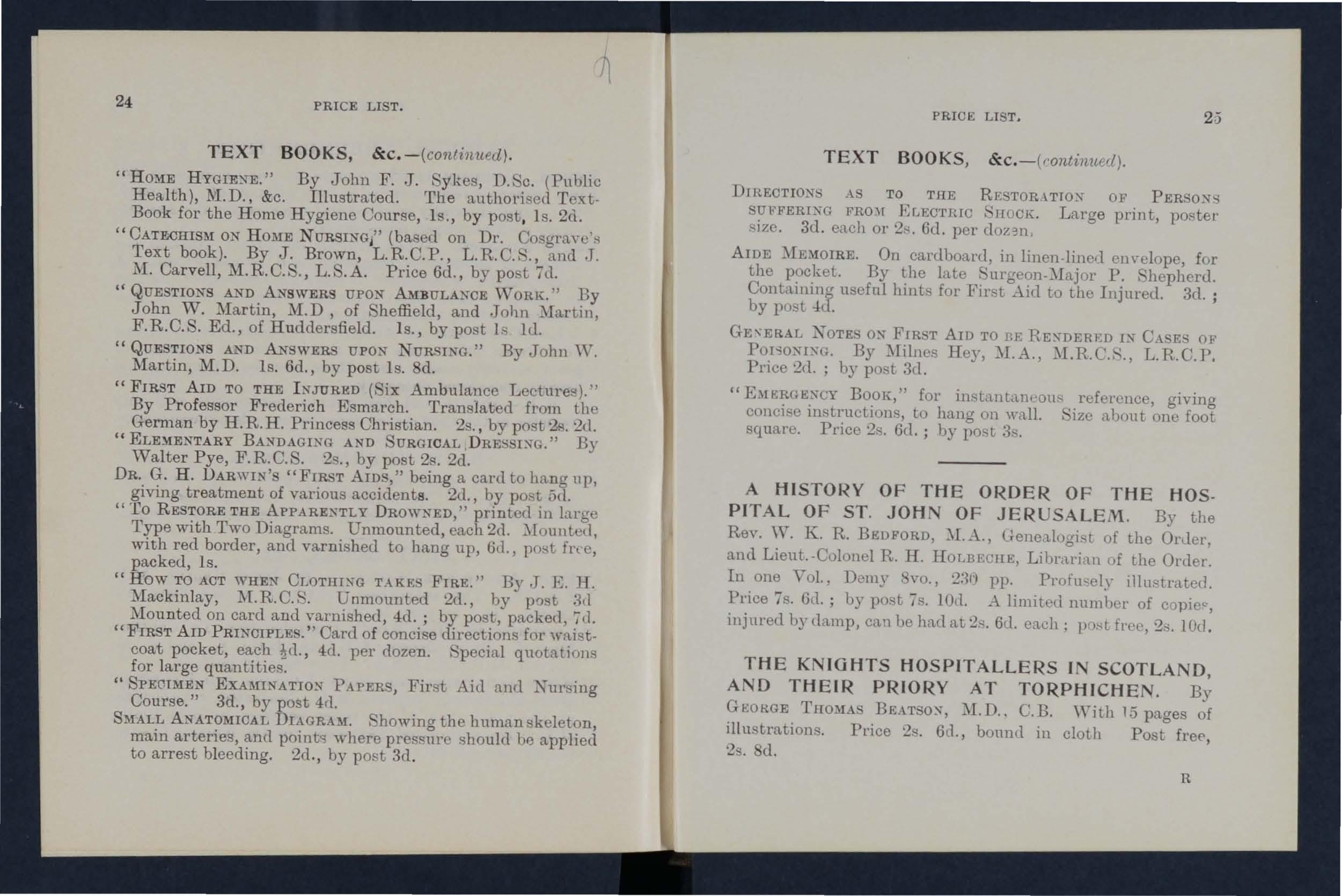
A HISTORY OF THE ORDER OF THE HOSPITAL OF ST. JOHN OF JERUSALEM. By the Rey. \Y. K. R. BEDFORD, :\LA., ltenc.1.lodist of the Order, and Lieut.-Colonel R. H. IIOLBLClIE, Libmrian of the Order. In one Yol., Demy ·'Yo., pp. Profu,;;ely illustrated. Price 7s. 6l1.; by po. t IS. lOll. A limitell numher of injlll'ecl by <lamp, can ue haclat2s. Gd. eaeh: post free, 2,;. IOd.
THE KNIGHTS HOSPITALLERS IN SCOTLAND, AND THEIR PRIORY AT TORPHICHEN. By GWRGE TflO)IAS BEATSON, 1I.D.. C.B. With 15 pages of illustration. Price :2s. 6l1., bound in cloth Post fref', '2'. d.
i in., per doz.
1 in.
Ii in.
2 in. in.
3 in.
4 in.
6 in.

PRICE LIST.
ROLLER BANDAGES. (6 yard long). Open Wnye Grey. s. d. 0 9 3
Fine Gre, C:tlico, or Snill:'l'iol' 'WlJitc Open Wove.
ROLLER BANDAGES in Assortment.
Each packet contains 6 bandagcs a follows:-
6 y ards l ong-one G-inch, two 3-inch, one I-inch; 4 yard long- two
..l!'ine Grey Calico ... per packet
Plain Triangular Bandages per tloz.
Illustrated Triangular Bandages (aJter Esmarch), showing 21 applications of the Triangu lar Bandage,
with printed instructions
PRICE LIaT. 27 ROLLER BANDAGE MACHINE. Designed b} Dr. A. C. Tunstall. Price :2s. 6d. COTTON WOOL.
White ah'orl)('nt. gOIHl, 1 oz. packet, :2{1.; :2 oz. packet, 3(1. ; -! oz. pac1{et, -4-11. ; 1h., id. ; 1 lb., Is. EPTICBoracic, pel' 1h, Is. (kl. i Carbolic, per lb., Is. d . ; Alem· hroth, per Ih., Is. ou. i DOll ble Cyanide, per lb., 2s. 6u.
LINT.
quality, 1 oz. packet, 2d.; 2 oz. packet, 3d. i 4: oz. l?acket, 6tl. ; lb. packet, lOcI. ; lIb. packet. Is. 6el. ; BoraCIC, 1 lb. packet, 1s. 6Ll. ; 4 oz. packet, 6el.
GAUZES .
These are inches. .. llpplicIl in 6 yard lengths,
Unmcclicatcd whilc ... Alembroth
Double Y[I,nicle Boracic ...
GAUZE TISSUE. width about 36
A layer of [l,l)Oo1'h nt cotton \rool between two sheets of gauze, gOJ 1 qU'11iLr, per lb., Is. 6tl. ; superior, per lb., 2s.
PRICE LIST. PLASTERS.
Manufactured by i\Ies.l:; d. De. 'to Dalmas &. Co.
Leicester Adhesive Plaster 011 Cambric, in tins of 8. d. yard, 6 inches wide 0 6
The Leice ter Adhesive
Ril)uonc;, in tin boxes, 6 :ranls long. inch \"ide ... 6d. 1 illch "ille ... ed.
National Rubber Plaster (Antiseptic). on spools. 5 yds. inch wide 9ll. Is Is. Is.6d.
2 " Is. 9el. 28. 3d.
Ditto in card box, in. wide, 51 yds. long tin 1 1<1. :3d 3d. 6d. rd. ;3 5 ,,! " 5 " COURT PLASTER. TRICOLOUR.
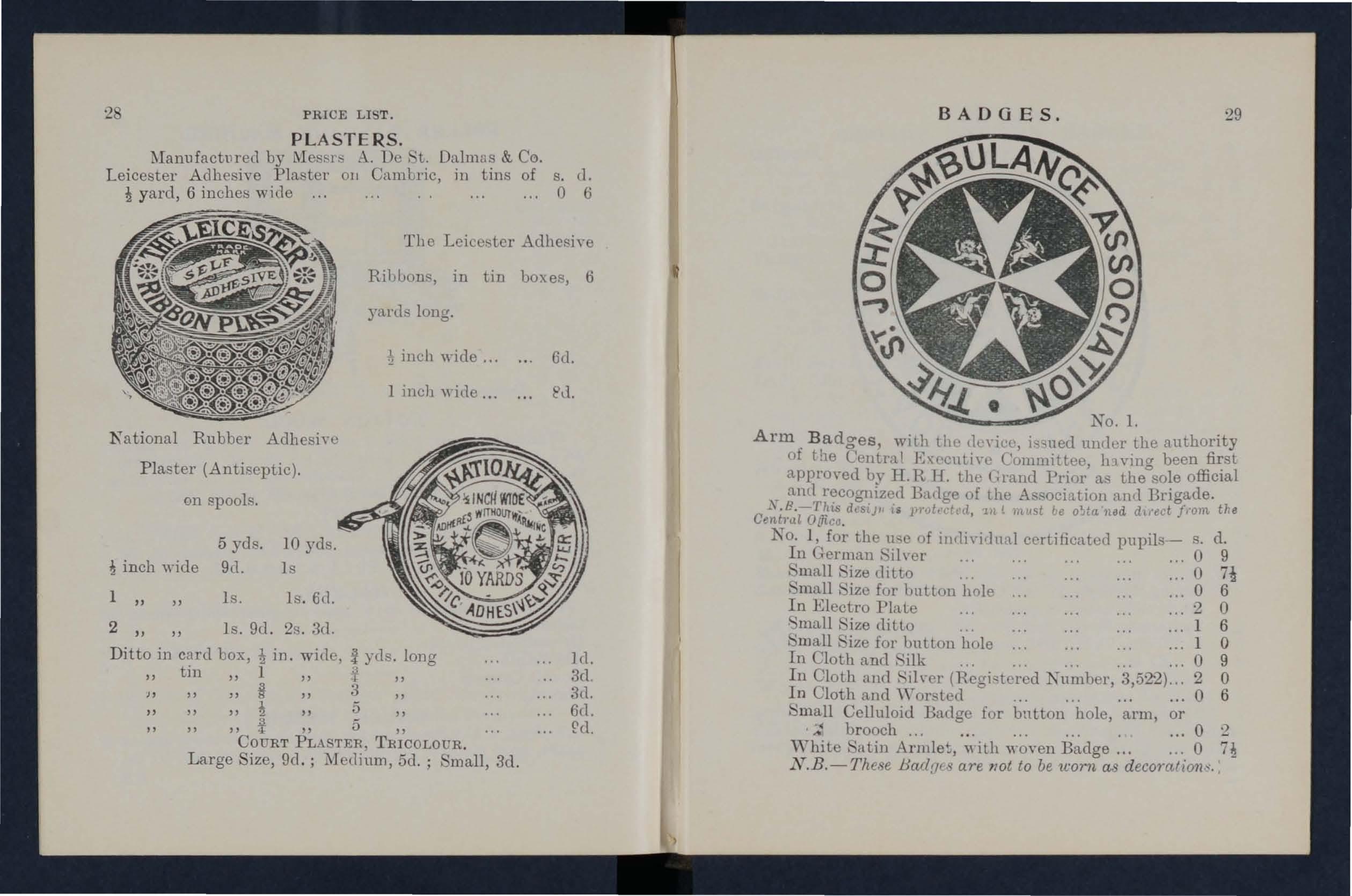
Arm. Badges, with the ,lu\'iet', muler the authority of the Central COlllmittee, h'lYing been approved bv H. R H. the (:!'alld Prior as the sole offiClal . aml B,ulgc of the As. ocifltioll al1l1 B.-Tills
Oentral o[/'i ca. No.1, for the U'lC of in,1i\'idnal certificated pupil:; - 8. d.
Large Size, 9el .; Medium, 5d.; mall, 3d. BADGES. 29
Cloth and. 'Ih'er (Rcgio:;tered Tumber, 3,52'2) ...
In Cloth and \\Torslcll ... 0 6 'mall Celluloid Badge for bntton hole, arm, or , '" brooch.. . 0 :2 'White •'atin \I ith woven Badge ... 0 lY.E.-The. e .Harl!f!. are not to be leorn as deco1'CUio?l:< ..
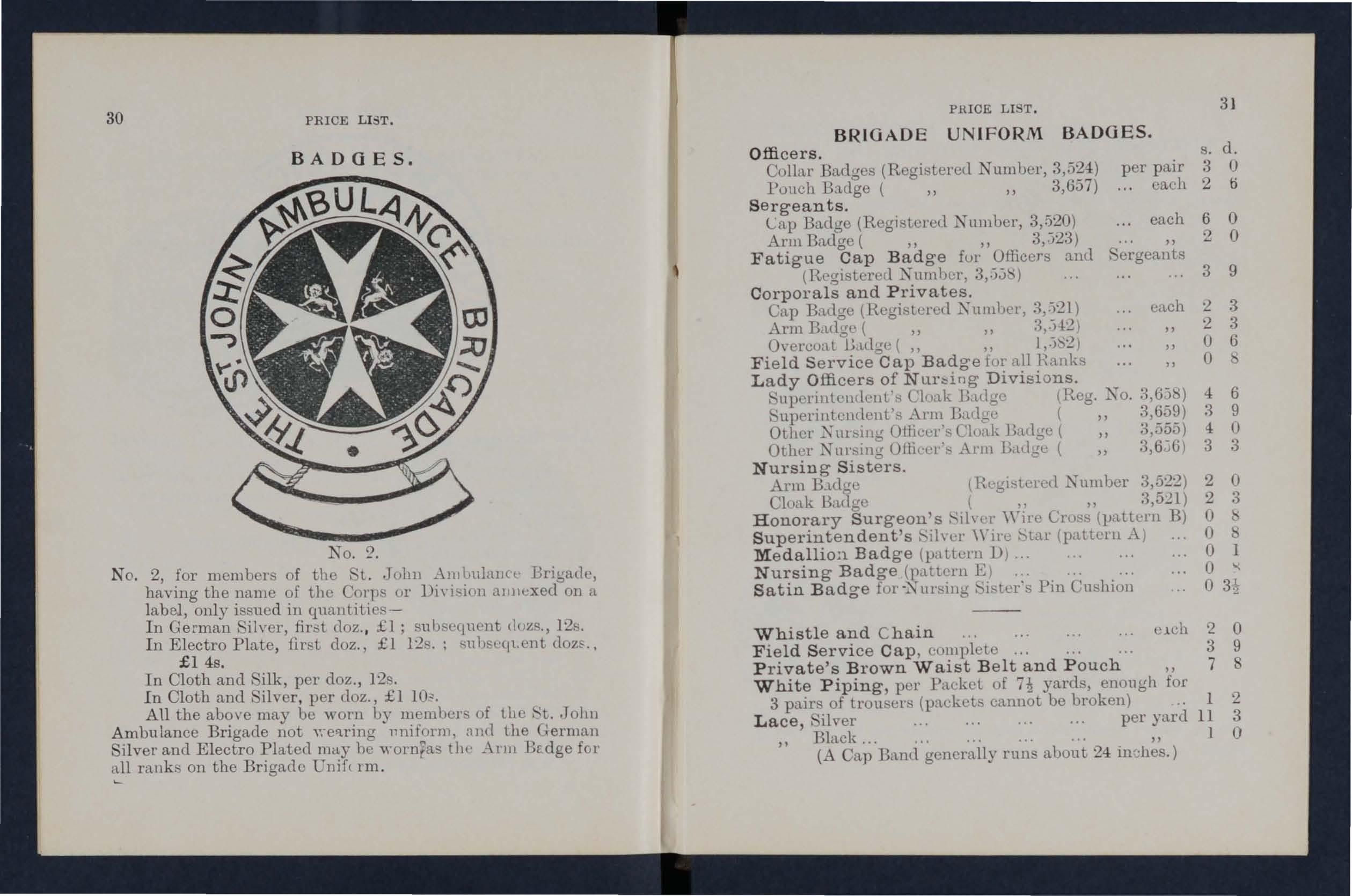
No . 2.
No.2, .for members of the • t. John .-\ni1m lnlJc P Brigade, havmg the name of the Ol"p. or Di"isioJl alllll'xed on a label, only issued in quantities-
I n German ilver, first doz. , £1; subsequent duzs., 12s.
I n E l ectro Plate , first doz., £1 1:21'.; sul)sL"(jl.ent £1 48 . '
In Cloth and. ilk, per doz., 12s.
I n Cloth and ilver , per doz., £1 102.
AU the above may be worn by members of the ,-'to .J ohn
A mbulance B r igade not ,,;e'tring 1ll1ifnrm, and the German ilver and E lectro Plated may he WOl'Dras the A11t1 13E.dge for ranks on the Brigade Unif( 1 m .
BRIGADE UNIFORM BADGES. Officers.
Collar Badges (Registeretl Number, 3,524) per pair
Pouch B:l.Clge ( 3,657) each 2 ti
S e r g eants. each 6
Lap Badge (Registered Tumber, 3,520)
Arm Badge ( " ,,3,.323) 2
Fa tigue C a p B a d ge fur Officers and •
(Registered Numh er, 3,.).) ')
Corporal s an d P rivates .
Cap Badge (Registered Arm B;uIg (" :3,.)12)
O"ereoal IbtIge ( " " l,.)s:2) each
F ield Service Cap Badge for all Rank'
L ady Officers of Nur:::ing Divisions. ,'uperintencll'llL's Cluak Rul.je (Reg . No. :3,6;)t))
'upel'inlen(lellt's Arm Uaclge ( H,(59)
Other X nn.illg OillcL'l"s Clual' BlHIge (
Other NUl'::;lllg Oilicel"s Arlll Ihtlge ( 3,6;:;6 )
N ursing S isters.
Arm Rldge tRegistt!l'cll ... Tumbcr 3,52:2)
Clonk 13a(lge (""
H ono rary S urgeon's :-;lh er Cruss (pattern B)
S uperintendent's :-;il\ el' \\'Il'l (pattern A) ...
M e d a llioa Badge (pntlel'll D) ... ... .. .
N ur s ing Badge (pattern E)... ... .. .
S atin B adge £or-J. Turt-;illg ,it:'ter's Pin Cushion
White P i ping, per PackeL of yards, enough
3 pair of trouser (packets
(A Cap Band generally runs about 24 111 ·hes.)
BUTTONS FOR THE UNIFORM OF THE ST. JOHN AMBULANCE BRIGADE.
I ssue(l only for the use of OfficeI'R aml Memuers of Corps and Divisions "'caring the prescribed lilliform.
Electro Plate, large small
German 'ilYer, brge .. small ...
Black Horn, large small

ELECTROTYPES OF THE JOHN AMBULANCE DEVICE.
Series A S('nes B for for Bngaue use. use.
No. 1. For Cards, Tid,ets, &<: .
2. For Note Parer, ' mall Circulars, &c. 1 0 3 I, 3. For Quarto aml Foolscap Letter. }J<Lper, Circulan3, &c.
4. For Small Posters (j ., 5. For Large Posters
Prints of the above electrotypes, with the exception of No.4, which is EhoW'n Oil page 29, appear on the follu\\ iug pages.
ELECTROTYPES.
No. D. For prices tee page :32.

NC'.5 A. ) For prices see .:> Pa 'e 3:....
Flags bearinti Assoc ia,tion d evice -12 teet by 6 feeL 5 feeL by 3 feeL BRIGADE
.
For marking the pe>;'ition of Amuu lance , tat ions at Fetes, Exhibitions, &c . , .J. ft. 1 in . by :3 ft. l'rice 1:2.' .
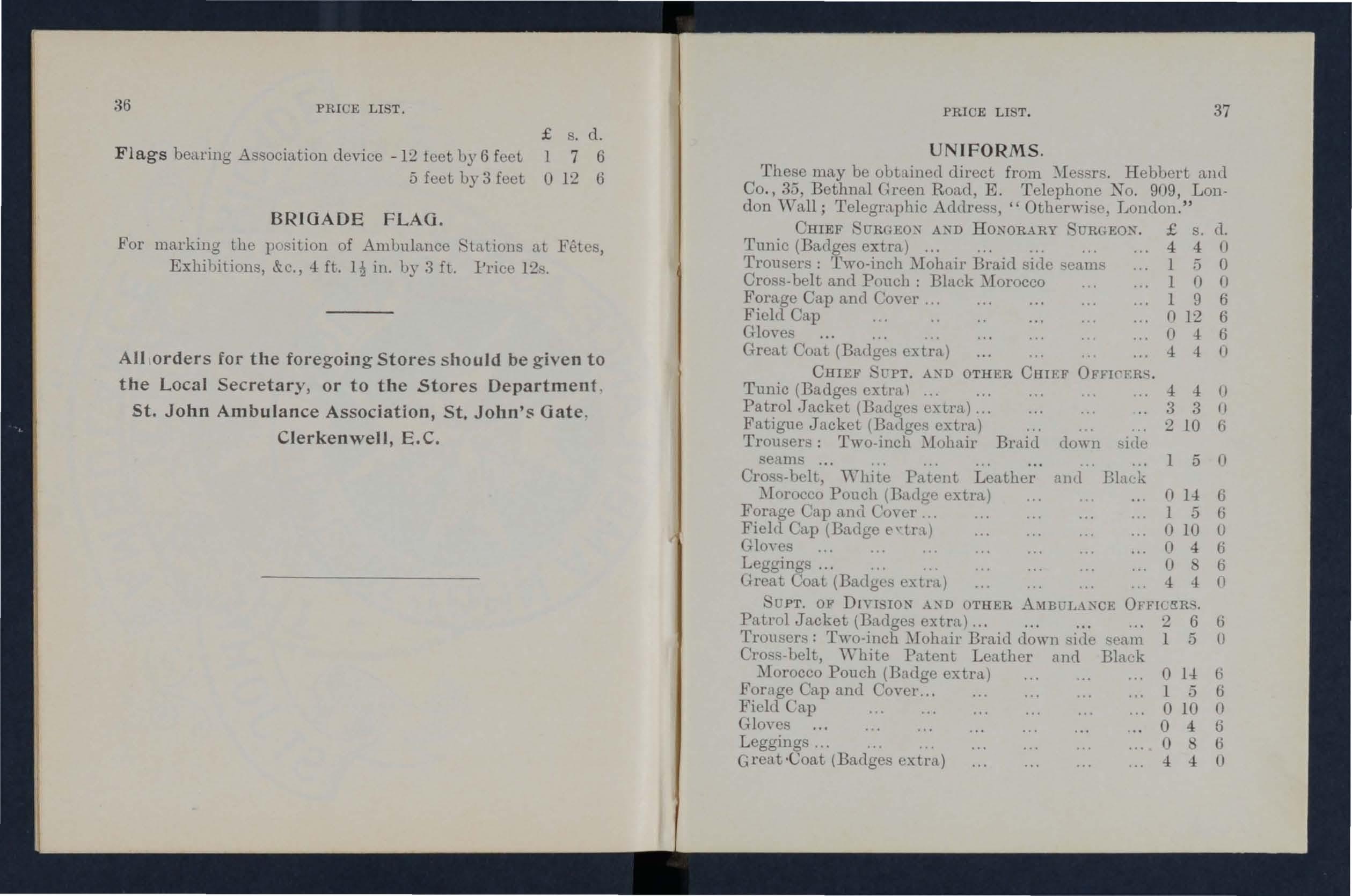
All orders fo r the fore g oing Stores s hould be g iven t o the Local Se c retary , or to the stores Departmen t.
St. John Ambulance Association, S1. John's Gate . Clerkenwell, E.C .
.
T hese may be ouL'linetl direct f rom Hebhert allll Co . , 3;5, B ethnal Green R oad, E . T elephone N o. 909 , L ond on "'Va ll ; Telegr,lphic Achlress, "Otherwise, Loudon ."
CIllE F UR(iEO,\, AND H ONORARY URGEON.
Tunic (Badges extra)
Trou. ers: Two-inch Braid si<1e scams
Cross-be l t and Pnueb: Black
Forage Cap and Cover ...
ld Cap
Great Cnat (Badges extra)
CHIEF ·LTPT . OTHER CaIr F OFFH'FRS .
Tunic (Badges extra)
Patrol ,Jacket (BtHIges extra)
Jacket (Ba(lges extra)
: Two-inch Bmid
",Yhite Patent L eather 1111,1
Cross-bel t, , Yhite Patent Leather an(1 mack
;\l orocco Pouch (Badge extra)
Forage Cap and Coyer. .. ...
Ficl(l Cap
0 10\'es
L
:B PRICE LIST.

1ST CLAS SERGEANT.
(Badge extra)
SERGEANTS, CORPORALS, AND RANK AND FILE. Patrol Jacket, Black Tartan (Badges extra)
PRICE LIST.
CYCLIST'-RA::q\: AND FILE.
.Jacket (Ba(lges extra) ... Cap (Badge extra)
Breeches: nre)' Serge ... ,'boulder BelL
Woves (per pair)
Gaiters (per pair)
All Badges to he obtained by the Corps or Di'vision from t. John's Gate.
If the Corps 01' Division is out of London, measurements to be supplied to contractors free of charge.
Carriage out of LOl1<1on extra.
'ergeant's Chevron,:.l hal'S, Silver, '2 .6(1. , \\Tors te(l n 1
Corporal's 2 bars, ilver,l>;. 'd., \\'orstel
CYCLISTS-SUPERINTE;\'0 I<::\T.
Patrol Jack et (Badges extr.l) Cap (Badge extra) Breeches : Grey erge houlder Belt and Pouch

Ambulance Hampel's ... 15, 17 .. Stn.tion Plate ...
Badges ... ... 29, 3l
Bandage Rolling Machine ... '27
Bandages 20
Basin, Dressing 14
Bed, Equipoitie U Camp 1:1
Books... . .. ::. 25
Bottles (Water) 1:>
Buttons...
Oarriag'es (Horee Ambul&nce) .. , 2
Oarrying Sheet 14
Ootton Wool.. ... 27
Oover for Stretcher or Litter ... 12
Dia.grams, Large 22
Dressing Basin 1
Drowning Tackle 1'2
Electrotypes ... ... il2, il5
Emergency Book .. 25
First Aid Box ... ... 10, 20, 21
First Field Dressings 21
Flags '" 30
Gauzes _.. ... 27
Gauze Tissues... 27
Hampers (Ambulance) ... 15, 17
Haversaes .. . .. . .. . 1
Hood and Aproll for Litter.. 4
J aoonette 21
Knife 14
Lace ... 31
Lamp ... U
Lint ... ... 25
Litter (Ashford) 3, 4
Litter
Lowmoor Jacket
Medallions .
Xurees' Wallets
Xursing Oharts InstrnmentR
PIIi,;ws
Plasters .. ReEtisters
Roller Bandage Machine
Rug ... Safety Pius
'lings, Stretcher
Scissors .. ... 5, i 13 HI 22 27 2L U 12
Splint Padding'
Splints ...
Stationery...
Stretcher Depot Plate
Stretchers .. . " II .Adjustablo Legs for.. 10
Temperature Cbart ... 22
Text Books '2J
Thermometers (Otillical and Bath) ...
Tourniqnets '21
Tow, carbolized :.?l .. plain :.?l
Uniform Sundries . 2!l, :1
Uniforms ... ... ... 37, 39
Wagons (Horse Ambulauce) 2
Water Bottles 13
Waterproof Lint 21
Waterproof Sheet 4
Whistle and Ohain 31
Wool (Ootton) ... 27
Wound Pad ::1

